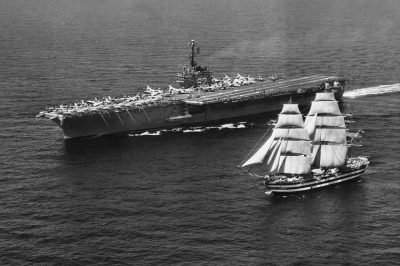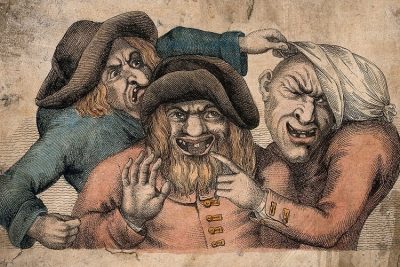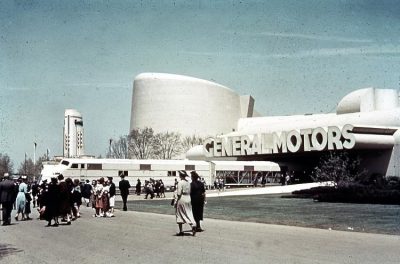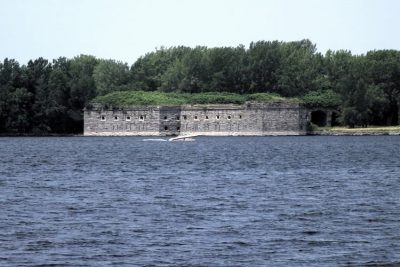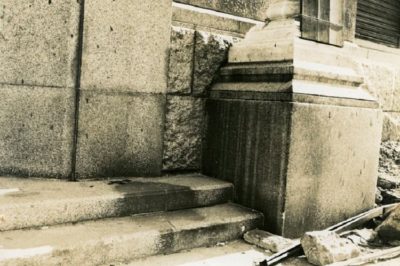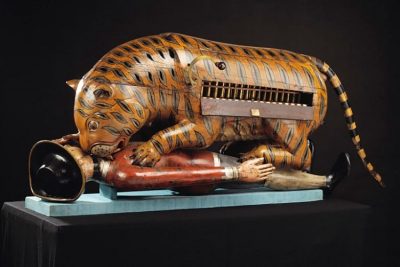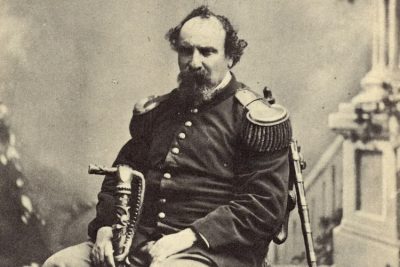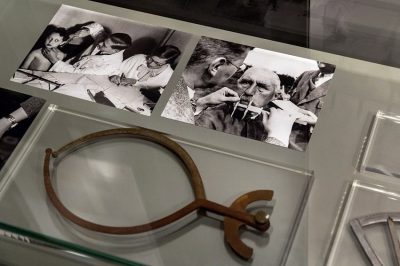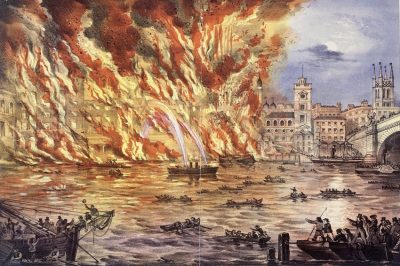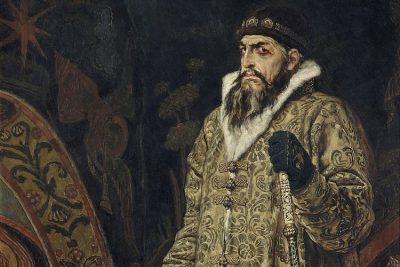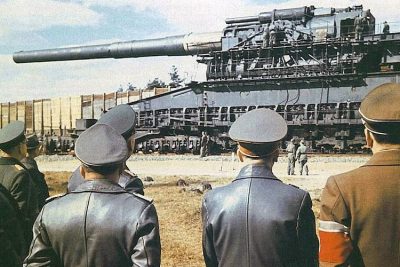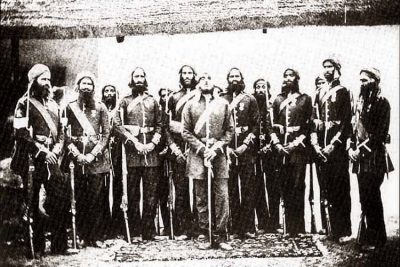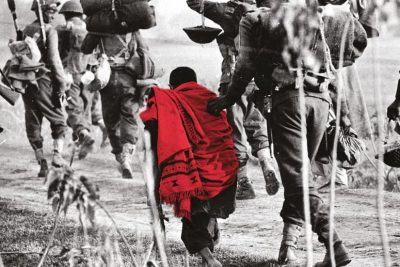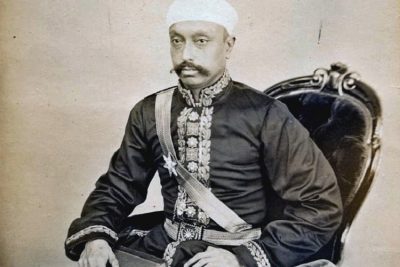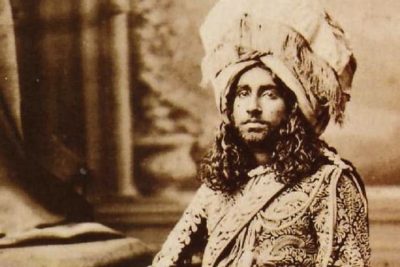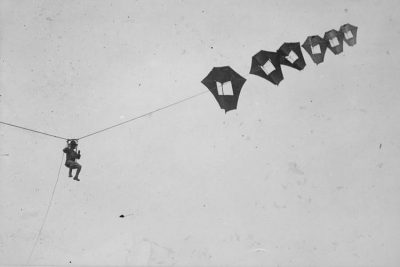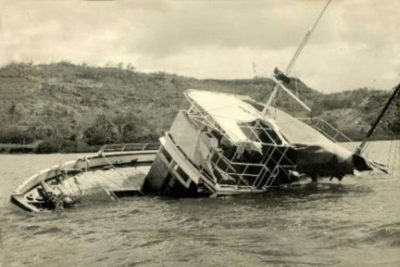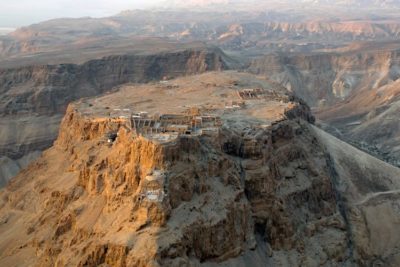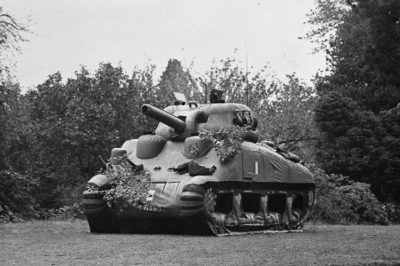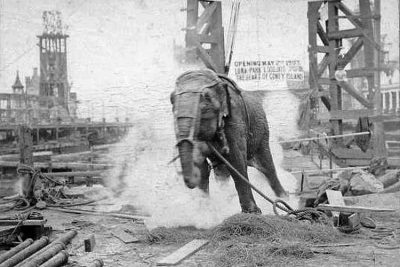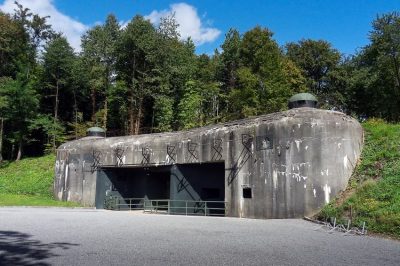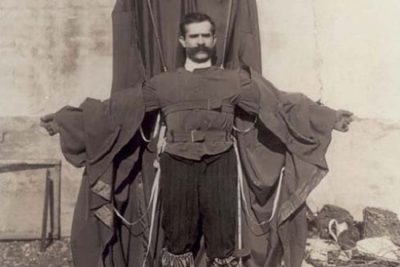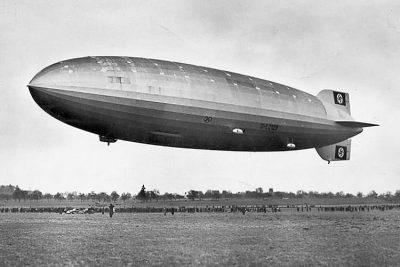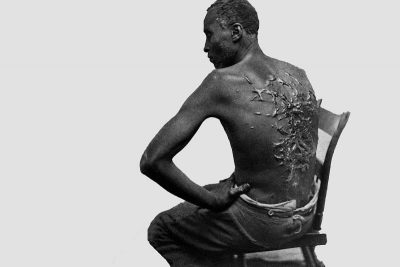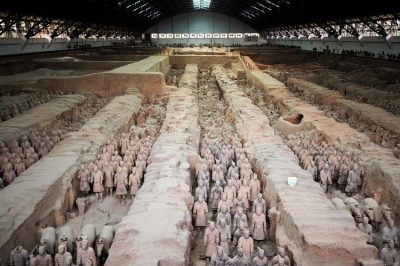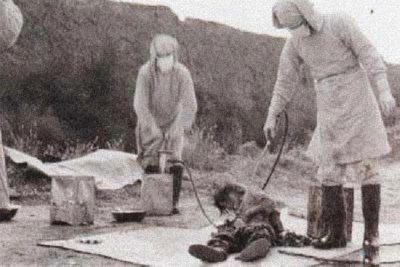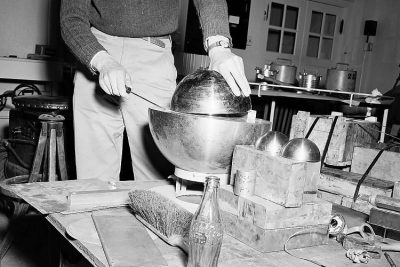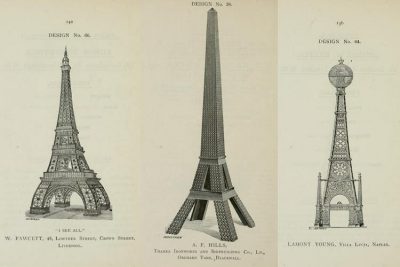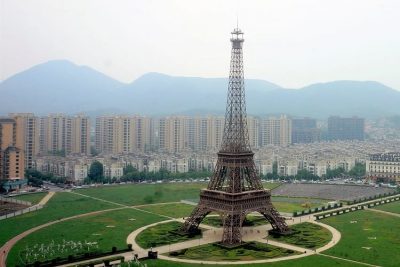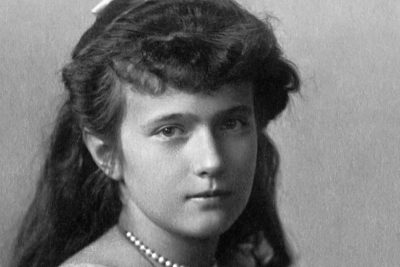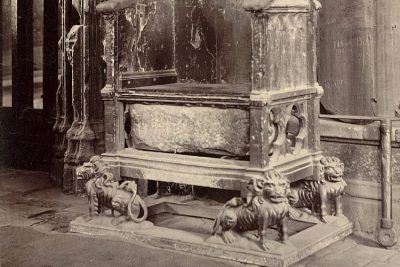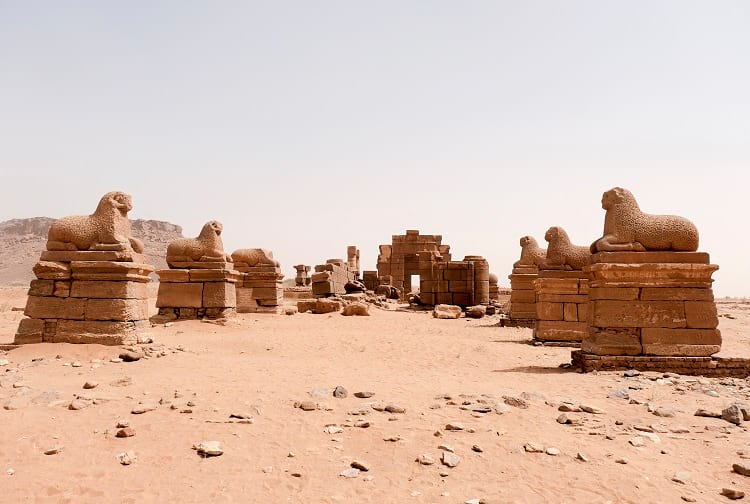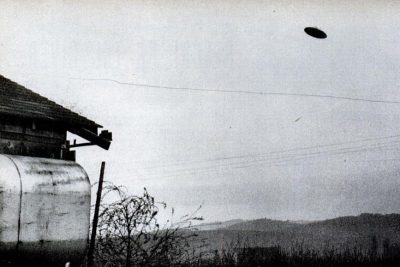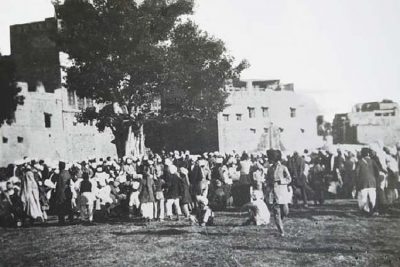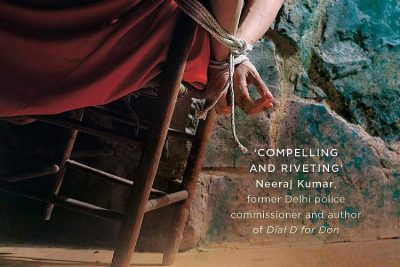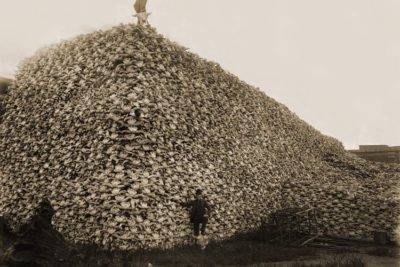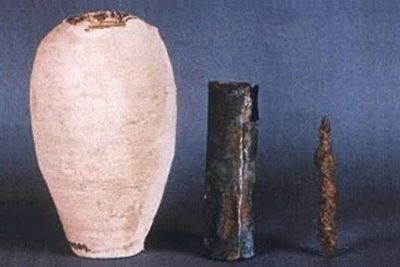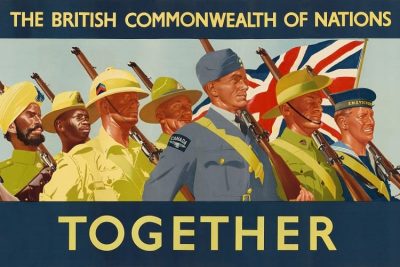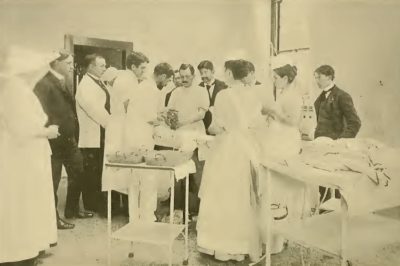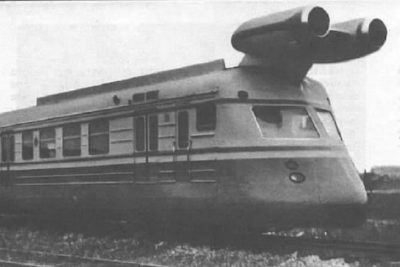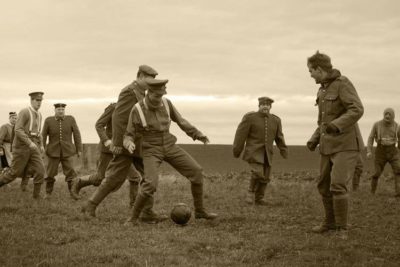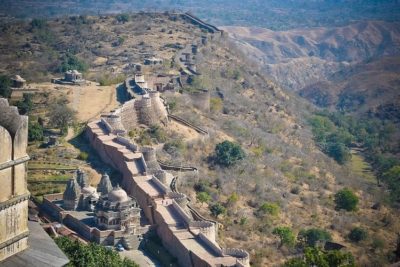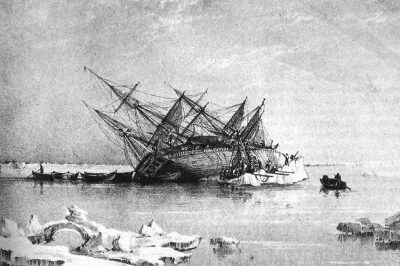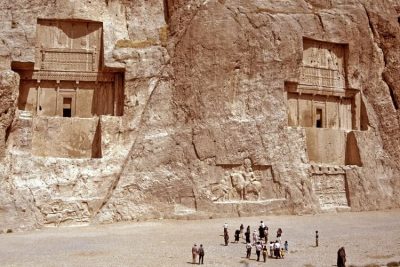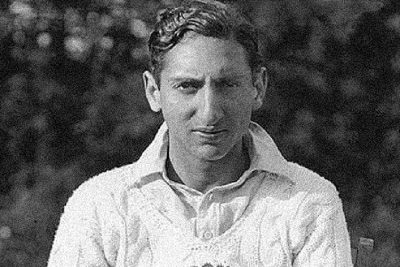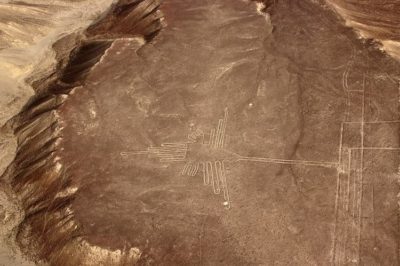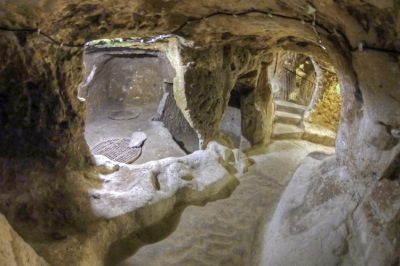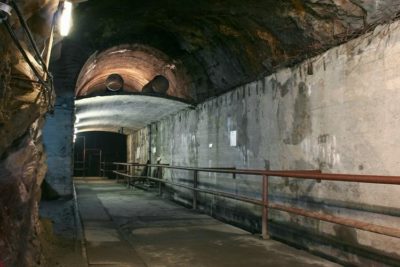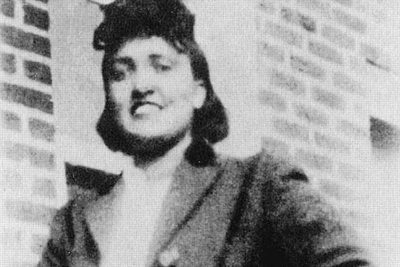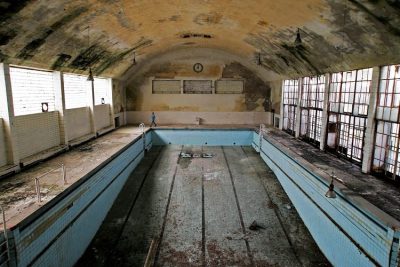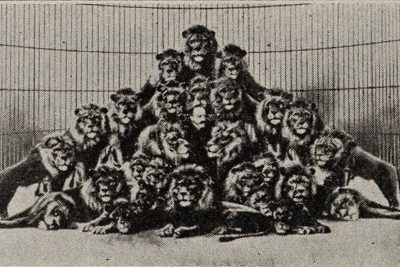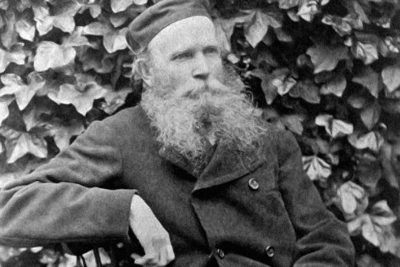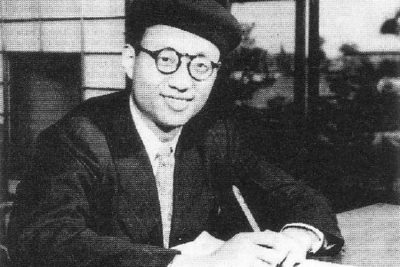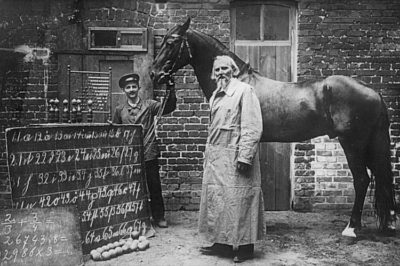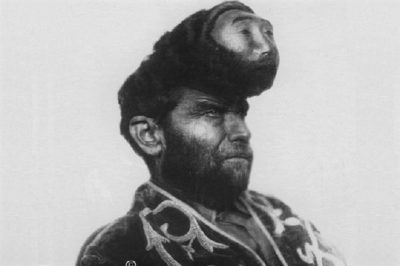The post Mammoth Camera: When George Lawrence Built an Enormous Camera for One Particular Picture appeared first on .
]]>
A very large camera called Mammoth Camera designed by George R. Lawrence. (George Raymond Lawrence/Wikimedia Commons)
Ever wondered how photographers managed to get wide-angle shots long before modern-day mobile phones came equipped with panorama picture options? Turns out, George Raymond Lawrence had figured it out way back in the 1900s. A professional photographer and an innovator, Lawrence is credited with designing the world’s largest camera, which weighed more than 1,400 pounds. Called Mammoth Camera, he designed it at the behest of Chicago & Alton Railroad Company to shoot the world’s most beautiful train ever built.
Life of George Raymond Lawrence
Born in Ottawa, Illinois, in February 1868, George Lawrence was the eldest of six children. After completing his education, he moved to Chicago in 1889, where he worked for a carriage manufacturing unit called Abbott Buggy Company. At the factory, Lawrence invented a method to fix iron rims on wooden wheels of carriages, making it easier for trains to run smoothly.
After a brief innovating stint at Abbot Buggy Company, Lawrence looked for other options. He opened up a photo studio with a friend where he began working on crayon enlargements, which were quite a rage amongst the rich during the late 1800s. These photographs were usually retouched monochromatic portraits done in charcoal or pastel, which Lawrence enhanced and enlarged with the help of the new equipment he had purchased.
When in the year 1893, his partner left the studio and Chicago for good, Lawrence learnt the art of developing negatives from a local photographer. Putting this knowledge to good use, he focused his attention solely on photography and its techniques. He perfected the flash photography technique, which until the mid-1890s wasn’t even the trend, thus earning the nickname ‘Flashlight’ Lawrence.
Photography and Other Innovations in the Field
George Lawrence was quite a researcher and trendsetter when it came to photography. He worked hard to come up with newer techniques to shoot the world from a fresh perspective. Before he designed the Mammoth Camera, Lawrence worked on novel ways to click aerial pictures that gave one a surreal feeling. Aerial photography soon became his forte, and he designed large-format cameras to click aerial shots. Lawrence experimented more in this field further. He used telescoping towers to click the bird’s eye view of parks and racetracks, which unfortunately did not turn out the way he wished.
In the year 1901, he designed a customized gas-filled hot-air balloon, to which he attached a fragile cage underneath. He would climb into the cage with his camera for an aerial shot of the city’s urban scenes. Once, while ascending a little over two hundred feet, his cage detached from the balloon, hurling him and his camera towards the ground. A few telephone lines broke his fall, and he survived miraculously. This led him to improvise further. He continued using balloons for a brief period, before bringing in unmanned kites with cameras attached to them to do the job for him.
The arrival of Mammoth Camera
In 1899, the Chicago and Alton Railroad Company decided to run an express service from Chicago in Illinois to St. Louis in Missouri, for which they had built a specially-designed train. Calling it the Alton Limited, this train was considered to be the largest and the finest train in existence. With six Pullman parlour cars extraordinarily customised, the Alton Limited was a train to be looked at both from the outside and the inside, according to the Railway Magazine. Each coach of the train was identical with perfect symmetry and uniformity. All the six cars were of the same height; had the same length and even had every single window looking just the same with the same size, shape and style. Even the coal tender that followed the engine was the same height as that of the cars and the hood of the steam locomotive, too, rose perfectly to a height that matched the coaches.
The railroad company wanted a picture clicked of their prized possession in its entirety, all in one frame. That is when George Raymond Lawrence was asked to step in. The company wanted an eight-feet-long photograph of the Alton Limited, which George Lawrence thought was a mean feat to achieve. He suggested that the train be clicked in sections, which would then be joined together during the printing process. But the company directors wanted a flawless picture of their flawless train. And so Lawrence went on to build the world’s largest photographic device – the Mammoth Camera – only to click a perfect picture of the perfect train.
Specifications of the Mammoth Camera
Built in a record time of two-and-a-half months by camera manufacturer J. A. Anderson, George Lawrence oversaw the camera’s production and design. Costing 5000 USD then (approximately 154,000 USD in today’s times, adjusted for inflation), the Mammoth Camera was finished throughout in natural cherry wood. It weighed around 1400 pounds in total, with the camera weighing 900 pounds and its plate holder weighing 500 pounds. Its lenses were of the Carl Zeiss patent, with one wide-angle lens and one telescopic rectilinear lens. The former lens format gave a five and a half feet equivalent focus and the latter gave a ten-feet equivalent focus, which was also the lens used to click the Alton Limited. The Mammoth had a single 8’x 4.5’ single glass negative, which was almost three times larger than the size of an average plate ever exposed.
At the back of the Mammoth was a small track which was employed to run two focus screens. The bellows had a rubber covering and a quarter-inch thick veneered wooden piece stiffened each of its folds. Approximately forty gallons of glue was used in the construction of the large bellows, which was doubly light-proofed by a heavy, black canvas lining on the inside. The bellows were huge enough to hold six men inside it for its working, while an additional 15 men were required to operate the camera on the outside. A specially designed isochromatic plate was used to conserve the original colour of the Alton Limited in all its glory.
Since Mammoth could not afford to snap-shoot due to its sheer size, an exposure time of two-and-a-half minutes was maintained between shots. While cameras are prone to accumulate dust particles, an ingenious method was used to keep that in check too. The plate holder was put in position and an operator would enter the front board. When the door closed behind him, he would cover the lens with a ruby glass cap and draw a curtain slide to avoid dust entering inside further. He would then clean off the big plate with a camel’s hairbrush in the darkroom and later the slide would close and the operator would come out the same way he went in.
Clicking the Alton Limited with the Mammoth
On a clear morning in 1900, a padded van drove down to Chicago railroad station, from which emerged George Lawrence’s Mammoth Camera. It was then painstakingly transferred on to a flat rail coach and taken down to Brighton Park. There it was positioned in an open field at a vantage point of the Alton Limited, which was stationed further away on the tracks. Operators began assembling the giant camera and after setting the two-and-a-half minutes exposure time, a perfect negative was locked, which finally resulted in the ultimate photograph of the most stunning train to have ever been made.

Alton Railway’s Alton Limited locomotive photographed by George Raymond Lawrence. (George Raymond Lawrence)
Three copies of the huge photograph were later sent as an entry to the 1900 Paris Exposition. But despite George Lawrence winning the prize for World Photographic Excellence, the picture came under the microscope for its authenticity. When Lawrence and the railroad company submitted affidavits to verify the same, the exhibition officials had to believe that the large picture clicked was indeed the work of a single camera.
Built for a specific purpose, George Lawrence did not let Mammoth go so easily and used it occasionally. It was once used to click a very large group photograph, where the expressions of each individual were captured perfectly in one shot. Although towards the late 1910s, George Raymond Lawrence left photography and turned to aviation designing, his craftsmanship and masterpiece still remain legendary.
For more unusual stories & intriguing news follow STSTW Media on Instagram and Facebook. Also, join our live chat discussion on Twitter.
Do you have a story/photo for us?
We welcome your contribution at [email protected]. Please include your name, city, state, and country.
Fact Analysis:
STSTW Media strives to deliver accurate information through careful research. However, things can go wrong. If you find the above article inaccurate or biased, please let us know at [email protected].
RELATED
The post Mammoth Camera: When George Lawrence Built an Enormous Camera for One Particular Picture appeared first on .
]]>The post Nixon’s Pyramid: The $6 Billion Safeguard Program Which Lasted One Day appeared first on .
]]>
The Pyramid of North Dakota. (Library of Congress)
In the United States, on the border of North Dakota, in a small village called Nekoma (a village that holds around 50 people) near Canada is a $6 Billion construction which was more or less abandoned. This an anti-ballistic missile system (ABM) in the shape of a pyramid, known as the Stanley R. Mickelsen Safeguard Complex, was built as a defence system for US missile silos to protect mainly against the Soviet Empire during the Cold War. They would protect America’s missiles by intercepting any threat which entered Earth’s orbit. There were twelve buildings planned in the 1960s all across the States, but construction did not start until the 1970s.
In 1972, however, President Nixon and Soviet leader Leonid Brezhnev signed the Anti-Ballistic Missile treaty. It meant each country could have two anti-missile centres, but by 1974 another treaty was reached for each country to only have one. This stopped construction of the other eleven before they even started laying bricks. The remaining complex in North Dakota was operational for a mere 24 hours before being the program was cut, the government citing it was too costly to run.

Part of the Stanley R. Mickelsen Safeguard Complex. (Terry Robinson/Flickr)
The workings of the Safeguard Program
Missiles are guided and powered by explosives driven by engines with fuel. They use ‘contact fuses’ to explode on impact. Missiles are classified depending on their range, anything greater than 5,500 km is an intercontinental missile. Most of these missiles are lost by the time it reaches outer space with only the ‘post-boost vehicle’ or ‘re-entry vehicle’ containing a nuclear warhead coming back to the ground.
The Safeguard Program was to protect missile silos holding missiles called LGM-30G Minuteman III. The program was evolved from Nike Zeus, Nike-X & Sentinel anti-ballistic missile systems, yet all were deemed not good enough and so Safeguard was initiated. The missiles in the Safeguard Program included thirty Spartan and sixteen Sprint missiles. There are two types of ballistic missiles–ones that follow a suborbital trajectory and those that travel a distance above the Earth. The Spartan missiles would target those incoming from outside the Earth’s atmosphere and the Sprint missiles–with a smaller range–would operate within. Out with the missiles, the system had a Perimeter Acquisition Radar and Missile Site Radar to detect any threats.
It became operational on the 1st of October 1975, only to be decommissioned the very next day by the House Appropriations Committee and Senate.
War’s an expensive game
The cost breakdown was confusing to say the least. An archived report illustrates this with breakdowns on cryptic deductions. There was $112 million spent in materials, $481 in ‘lost effort’–such as excess equipment and materials, restoration of the site – and $697 in ‘schedule changes’ – noting research and development, procurement and construction. The report makes interesting reading and automatically relates to the idiom ‘more money than sense’ however the minds running this project must have been highly intelligent. It is a staggering amount of money and leaves a lot of unanswered questions.
It is easy to say that allowing the building of this site was madness, but war–needless to say–is a difficult time for the governments involved. It would be nice to say the world is a different place now and maybe it has moved on a bit, but the money spent on fighting is still a staggeringly unjustifiable amount from a pacifist point of view. Yet, just how many programs like Safeguard have been commissioned and decommissioned over the years.
The Stanley R. Mickelsen Safeguard Complex still stands proud today, similar in look at least to the Great Pyramids of Egypt but without the lengthy history.
Enjoyed this article? Also, check out “Project MKUltra: CIA’s Cold War Conspiracy to Secretly Control Human Mind Goes Wrong“.
For more unusual stories & intriguing news follow STSTW Media on Instagram and Facebook. Also, join our live chat discussion on Twitter.
We welcome your contribution at [email protected]. Please include your name, city, state, and country.
Fact Analysis:
STSTW Media strives to deliver accurate information through careful research. However, things can go wrong. If you find the above article inaccurate or biased, please let us know at [email protected].
RELATED
The post Nixon’s Pyramid: The $6 Billion Safeguard Program Which Lasted One Day appeared first on .
]]>The post Noor Inayat Khan: Britain’s First Muslim War Heroine appeared first on .
]]>
Noor Inayat Khan. (Imperial War Museums)
In her short lifetime of thirty years, Noor Inayat had many achievements. She was awarded the George Cross, posthumously, for her commendable service in the Special Operations Executive (SOE). The George Cross is said to be the ‘second highest award’ within the United Kingdom honours system.
Early life of Noor Inayat Khan
Noor Inayat Khan was the eldest child, and had three siblings – Vilayat (1916-2004), Hidayat (1917-2016), and Khair-un-Nisa (1919-2011), all of whom were born in London unlike Noor herself. Her parents were often thought to be an unlikely couple. Her father, Inayat Khan, belonged to a noble Indian Muslim family who descended from the lineage of Tipu Sultan, the ruler of Mysore in the 18th century. Inayat Khan lived in Europe as a Sufi teacher and musician. Her mother, Ora Baker was born in Albuquerque and had a half-brother, Pierre Bernard, who was an American yogi. She met Noor’s father in San Francisco via her brother when she attended one of the lectures during Inayat Khan’s visit to the United States. Their son Vilayat later became the leader of the Sufi Order International (founded by Hazrat Inayat Khan).
During the World War I, the family moved to Bloomsbury in London, where Noor Inayat’s siblings were born and she attended nursery in Notting Hill. In 1920 they relocated to France, and began to live in their house ‘Fazal Manzil’, which was located in Suresnes, Paris. However, tragedy struck the family in 1927 with the death of Inayat Khan while he was away on a pilgrimage to India. Noor was only 13 when her father passed away, and she had to shoulder the responsibility of the entire household – her three young siblings, and her mother who was paralysed with sorrow.

Fazal Manzil. (Celette / Wikimedia Commons)
An accomplished young woman
Noor was a highly accomplished young woman, and was described as quiet, shy, dreamy and sensitive as a young girl. From a tender age, she enjoyed writing poems and short stories, and had a flair for music. She pursued a course at the Sorbonne in Child Psychology, and also attended Ecole Normale de Musique de Paris, where she began composing for instruments like the harp and the piano. She began writing stories for children and poems for several magazines and Radio Paris. Noor published her first book in 1939 in London, called ‘Twenty Jataka Tales’ when she was only 25 years old. It was the traditional Buddhist Jataka Tales that inspired her to write this book.
However, in 1940 after the outbreak of the Second World War, the peaceful routine of Noor’s life was disrupted. She lost her family home when the German troops invaded France and the Khan family was forced to flee and escape to London.
Service at the Women’s Auxiliary Air Force (WAAF)
Even though Khan had been greatly influenced by her father’s philosophical teachings and had been brought up on Mahatma Gandhi’s principles of non-violence, she was determined to help defeat the raging Nazism. Her brother Vilayat’s support encouraged her to join the Allied Forces, and she volunteered for the Women’s Auxiliary Air Force (WAAF) in November 1940. Noor qualified as an Aircraftwoman 2nd class, and she was sent to be trained as a wireless operator. Subsequently in June 1941, she was trained at bomber training school. However, she was dissatisfied with the work she was doing and wanted to contribute more to the war efforts. This led her to apply for a transfer within the British forces in a field that would allow her to assist in a more dynamic manner.
Noor’s training at special operations executive (SOE)
In 1942, Noor had been recruited by the Special Operations Executive, which was an ‘underground espionage and sabotage task force’ that had been set up by Winston Churchill, who was the Prime Minister of Britain at the time. In February 1943, Khan was appointed at the Air Ministry, Directorate of Air Intelligence first, and then reassigned to First Aid Nursing Yeomanry (FANY). She was eventually transferred to Wanborough Manor in Surrey near Guildford. Later, she was sent to be trained to be a wireless operator in enemy territory, to Aylesbury, which is the county town of Buckinghamshire.
Previously, female agents had been sent only as couriers, and Khan was the first to be sent as a wireless operator. She had an advantage over the others who had just begun their training as she had received wireless telegraphy training before. Later, she was sent to Beaulieu, for further training with other agents.
Even though she was a quick learner and very precise, her physique and meek manners were considered to be unsuitable for the extremely difficult SOE training. Her trainers mentioned that she was clumsy and very scared of weapons. Her seniors believed that due to her spiritual beliefs she was unable to make quick decisions that were necessary in her field of work. Her trainers also noticed that she often left codebooks lying around and her ‘fist’ (style of tapping keys) was quite heavy as a result of her bloated fingers. During her mock Gestapo interrogation training sessions, Khan would get terrified and often give away personal information. She would get extremely scared and would lose her voice. She would continue to shake and would turn white with fear even after training was over.
Khan’s mission in Paris
Khan worked hard to try and ameliorate her physical fitness, Morse code skills, and she successfully conquered her fear of weapons. Very soon she was selected to go to Paris on her first mission as a covert wireless radio operator. The mission was believed to be highly dangerous as she was supposed to send and receive messages regarding the operations of the enemy while keeping her cover intact from the Gestapo.
The risk of being captured was very high but that did not deter Khan. She was flown into France in 1943 where she posed as a children’s nurse. Her codename was ‘Madeleine’. However, the mission had been sabotaged from the very beginning, and within a week of her arrival, the Gestapo had managed to capture nearly all the SOE operators who were in Paris. Noor was brave and refused to be extracted and continued her mission, and performed the work of six radio operators on her own.
Capture and imprisonment
While it remains uncertain what actually led to the capture, the conjecture is that Khan was betrayed by a double agent named Henri Dericourt, or perhaps Renee Garry, who was the sister of an SOE-F network leader and had been working for the Sicherheitsdienst. They captured her in October 1943, but she put up a lot of resistance. Mere hours after her capture, she attempted to escape from her cell in Paris but she was unsuccessful. During the interrogation sessions, Khan did not reveal any information to the Gestapo. However, they recovered her notebooks in which she had a meticulous record of all the messages that she had sent as an SOE operative. They then used this to send fake messages that led to the deaths of many other SOE agents.
A few weeks later, Noor attempted to escape again and refused to sign a declaration that stated that she would make no further attempts to run away again. She was taken to Germany and placed under solitary confinement, where she was brutally beaten and hardly fed. They kept her shackled and continued to torture her, but Khan refused to give away any information.
Death of Noor Inayat Khan
Khan was transferred to the infamous Dachau concentration camp, along with three other agents, on 13th September 1944. While the other prisoners were immediately killed upon arrival, Noor Inayat Khan was beaten and tortured before finally being shot in the head.
Remembering Noor Inayat Khan
In 1949, she was posthumously awarded both the prestigious George Cross by the British government and the Croix de Guerre by the French government. Her name can also be found on an SOE memorial plaque at Dachau. In February 2019, Noor also became the first woman to be accorded the rare honour of her wartime home in London being given a ‘Blue Plaque’. An unsung hero no more, her bravery and efforts during the war will always be remembered by people all around the world.
Enjoyed this article? Also, check out “A Cross-Dressing Explorer, Isabelle Eberhardt Crossed Geographic and Social Boundaries to Follow Her Heart“.
For more unusual stories & intriguing news follow STSTW Media on Instagram and Facebook. Also, join our live chat discussion on Twitter.
Do you have a story/photo for us?
We welcome your contribution at [email protected]. Please include your name, city, state, and country.
Fact Analysis:
STSTW Media strives to deliver accurate information through careful research. However, things can go wrong. If you find the above article inaccurate or biased, please let us know at [email protected].
RELATED
The post Noor Inayat Khan: Britain’s First Muslim War Heroine appeared first on .
]]>The post Bathing Machine: Popular Beachside Devices from the 18th Century appeared first on .
]]>
Early 20th century bathing machines in Sestroretsk, Russia. (Wikimedia Commons)
Nowadays, liberation is taken for granted in parts of the world. Places where men and women can openly bathe together on beaches, even sections exist which are permitted for both sexes to bathe nude. Take Spain, for example. In places like this, the fact that single men and women once had to be separated at the beach in the past is hard to imagine, and contractions like a bathing machine likewise. This was the case in the 18th and 19th Century in countries like the United Kingdom during a far more conservative time. For females, to be nude, half-naked, or wearing revealing clothes in public was frowned upon and even illegal in some cases, so a device was created to allow women to change clothes and bathe in complete privacy.

Horsemen moving bathing machine. (Wikimedia Commons)
How did bathing machines work?
During a trip to the beach, people with some money to their names, wishing to have a swim, would consider the use of a bathing machine. Predominantly, bathing machines were wooden cabins on large wheels which would be wheeled into shallow waters either by horses or people, some holiday resorts had rails to assist the vessels. Others could be roped in and out by steam engines. This was from a time when many people could not swim, or many people would be uncomfortable about changing clothes in public, or both. So they would venture to a place to a book a time for a bathing machine, like a doctor’s waiting room with tea and magazines.

A woman leaving the bathing machine. (Wilhelm Dreesen)
And upon their chance to swim, they would enter the cabin on the beach in their day-to-day clothes and change into their bathing attire or less. The cabin would then roll towards the water and submerge. Steps would help the person out of the cabin and into the water, and curtains further gave them privacy. People were employed, called dippers (of the same sex) – to assist the men and women in and out of the cabins or teach them how to swim. A flag would give signals to the dipper and beach. The point of the machine is to give people less chance of being seen naked or in revealing clothing by members of the opposite sex.

Bathing machines in Llandudno, Wales. (National Science and Media Museum)
History of the bathing machine
The origins of the bathing machine can be traced back to the 1750s probably due to the increase of holidaymakers to beaches. This followed many reforms conducive of the Great Bubonic Plague which started to dismantle the European Feudal System. Benjamin Beale is claimed to be the inventor of the machine in 1753. They became popular in the United Kingdom and countries of the British Empire mainly, adhering to conservative British culture with Queen Victoria was a famous user. By the 1900’s, segregation had near enough ended on beaches, people became better swimmers and did not want nor need to queue for bathing cabins. Mobile bathing machines started to simply become stationary changing rooms, some of which can still be seen today.
Enjoyed this article? Also, check out “Yellow Concrete Arrows Are the Last Reminders of Transcontinental Airway System“.
For more unusual stories & intriguing news follow STSTW Media on Instagram and Facebook. Also, join our live chat discussion on Twitter.
Do you have a story/photo for us?
We welcome your contribution at [email protected]. Please include your name, city, state, and country.
Fact Analysis:
STSTW Media strives to deliver accurate information through careful research. However, things can go wrong. If you find the above article inaccurate or biased, please let us know at [email protected].
RELATED
The post Bathing Machine: Popular Beachside Devices from the 18th Century appeared first on .
]]>The post The Killing of George Floyd and the History of Racial Segregation in America appeared first on .
]]>
George Floyd mural in Mauerpark, Berlin. (Leonhard Lenz/Wikimedia Commons)
On 25th May in Minneapolis, George Floyd was killed after a white police officer pressed a knee into his neck. The video was recorded and circulated on social media, forcing people out of their homes in resistance against the systemic oppression of the black population in the USA. People defied COVID lockdown and quarantine measures demanding an end to racial profiling by the police.
As the protests around the country and the world gained momentum, the man who knelt on Floyd’s neck was arrested on murder charges.
George Floyd’s killing refreshed the memories of police brutality in the past, the killing of Michael Ferguson and Eric Garner in 2014 and the shooting of Ahmaud Arbery, a 25-year-old black man out on a jog in February 2020. These are not a few isolated cases, American history is stained with racial killings rooted in white supremacy.
How it all began
Racism in the USA finds its roots in the 17th century when people from Africa were kidnapped and brought over to the British colonies in America by the Englishmen. They served as cheap and plentiful labour and around 6-7 million Africans were enslaved in America during the 18th century. And thus began the black slavery and degradation of a minority community by the majority.

Slave market in Atlanta Georgia, 1864. (Library of Congress)
People of the Black community were employed as labourers in tobacco, rice, indigo and cotton plantations. They were prohibited from reading, writing lest they opt for careers built for the white community. Their movements and interactions were restricted, and they were circumscribed to certain areas of the town. These areas remained impoverished, depriving them of basic amenities like healthcare, education, etc.
Slavery
After the American Revolution, the colonists in North America felt their oppression was linked to the oppression of the Black population. Their views and opinions were in conflict with those in South America, who heavily relied on Black men and women for heavy labour. This conflicted over enslavement led to the Civil War between North America and South America in 1861, and ended in 1865 leading to the abolishment of slavery.

Scars of a whipped Mississippi slave, photo taken on April 2, 1863. (Mathew Brady)
Civil War
After the Civil War ended,—Jim Crow laws enforced and enacted racial segregation. These laws and black codes, restricted movement of people from the African-American community, forbade them from living in white neighbourhoods. These not only held them from integrating into the community as equals but also marginalized in public schools, hospitals, etc. They weren’t granted the right to vote, and the children of the community were often taken away for slavery.

Halifax County Courthouse in North Carolina. (Library of Congress)

A segregated entrance of movie house in Mississippi Delta, Mississippi. (Library of Congress)

Theatre for colored people. (Dorothea Lange/LOC)
Those who defied these laws were subjected to violence, arrested and even faced death penalties. Crime against the minority increased as a result. It was during this period, a secret society—Ku Klux Klan terrorized and vandalized areas inhabited by the black population.

A sign on a restaurant: “We Cater to White Trade only.” in Lancaster, Ohio, circa 1938. (Ben Shahn/LOC)
Racial segregation was outlawed in 1964 after the landmark Civil Rights Act was passed. Complete integration and acceptance of the black population with the majority was and is still far from reality. Black people are still treated as second-class citizens and even though slave patrol was outlawed, police officers do not hesitate to pull a trigger on a man, woman or even a kid of black community. According to a report, police violence based on racial profiling is one of the leading causes of death for black men in the United States.

Ruby Bridges being escorted from William Frantz Elementary School in New Orleans by U. S. Marshals after a Federal court ordered the desegregation of schools, 1960. (DOJ photographer)
A global organization by the name Black Lives Matter was founded in 2013 to fight the systemic oppression, lynchings and to seek equality, justice and peace for the Black community and to eradicate white supremacy.
Today, protests continue for the seventeenth day after George Floyd’s murder, with many Hollywood celebrities coming out to support the black community.
For more unusual stories & intriguing news follow STSTW Media on Instagram and Facebook. Also, join our live chat discussion on Twitter.
Do you have a story/photo for us?
We welcome your contribution at [email protected]. Please include your name, city, state, and country.
Fact Analysis:
STSTW Media strives to deliver accurate information through careful research. However, things can go wrong. If you find the above article inaccurate or biased, please let us know at [email protected].
RELATED
The post The Killing of George Floyd and the History of Racial Segregation in America appeared first on .
]]>The post The Unknown Fate of Grand Duchess Anastasia of Russia appeared first on .
]]>
Nicholas II of Russia with the family (left to right): Olga, Maria, Nicholas II, Alexandra Fyodorovna, Anastasia, Alexei, and Tatiana. Livadiya, Crimea, 1913. (Boasson and Eggler St. Petersburg Nevsky 24)
In recent years science has become proficient in the field of genetics and can dispel such claimants. However, in past years many famous people who died in peculiar circumstances would likely have people claiming to be them–seeking fortune or fame. This was the case for the Grand Duchess Anastasia Romanov, who went missing at the age of seventeen. She had at least ten women claiming to be her and therefore the beneficiary of the Tsar’s estate.
The situation in Russia
Russia began as a nation as early as 882 ACE during the foundation of the Kievan Rus Empire—a federation of Slavic tribes. A dynastic family called the Romanovs took control in the 1700s and did so until the Russian Revolution in 1917 which brought about a call for communism in the Russian Empire. The last Tsar of Russia—Nicholas II—abdicated to bring an end to the Romanov dynastic rule. This event brought about intense periods of civil war between an aspiring political party called the Bolsheviks and anti-Bolshevik factions, many of whom still favoured the Tsar. The Communist Bolsheviks won, illustrating their victory by killing the Romanov family on the orders of Vladimir Lenin–it is assumed.
The Romanov Dynasty
This family had links all over Europe and married internally to keep the bloodlines strong. Since the time of Michael–the first Romanov Tsar (1596–1645), they transformed Russia into a global power, meaning the age of prosperity for many of its citizens. Anastasia’s father and descendant of Michael–Nicholas II–had a family tree branching the length of Europe. His father was the Tsar of Russia and his mother a Danish princess.
His aunts and uncles included: King Frederick VIII of Denmark, George I of Greece and Queen Alexandra of the United Kingdom. For cousins: German Emperor Wilhelm II, King George V of the UK, the King and Queen of Norway, King Christian X of Denmark and Constantine I of Greece.
Despite this influence and power, by the time of World War One, many citizens of Russia became displeased by the Tsar’s efforts. Some of this stemmed from his wife Alexandra–granddaughter to Queen Victoria of Great Britain. She was born a princess of Hesse and Rhine–a part of Germany, but after several proposals and spouses Alexandra married the Tsar of Russia to become the Empress–or Tsarina–of Russia. She had five children: Anastasia, Olga, Tatiana and Maria, and Alexei. Like Queen Victoria, Alexandra and her son Alexei had haemophilia; an inherited blood disorder, wherein blood doesn’t clot normally. This would contribute to their downfall. And with World War One against Germany, the Russians did not trust Alexandra as Germany was her birthplace.
Tsar Nicholas II left the royal palace in St. Petersburg in 1917 (at the time Petrograd to sound less German) after the Bolshevik forces pressurized the family and regime. They sought to install a communist regime. Nicholas II and his family were arrested and exiled to the Urals by pro-Bolshevik forces under their leader Vladimir Lenin, though it was the decision of the Supreme Council of Russia. Into a town called Yekaterinburg, the Romanovs were transported towards the vast, desolate stretch of Siberia. The Bolsheviks had taken over many government buildings around Russia, as well as a residential mansion–Ipatiev and transformed it into a prison. On the night of July 16, 1918, the whole family was taken to the basement of the aforementioned mansion to be shot.

The basement of the Ipatiev house—the site of execution. (Wikimedia Commons)
The mystery of Anastasia Romanov

Photo of Princess Anastasia Nikolaevna of Russia, with her signature. (Galerie Bassenge/Wikimedia Commons)
Anastasia was born in 1901 near St. Petersburg–at the time the capital of Russia. She was said to have been murdered in the Ipatiev Mansion, but several people came forth claiming to be her years after the event. As not all bodies were found there was much speculation and many conspiracy theories that few members of the royal family escaped. A plausible theory is that because they had sewn jewels into their clothes before the assassination, it protected them. The jewels had deflected the bullets and bayonets from the would-be assassins. When World War One had finished and civil unrest had quietened, several people claimed to be Romanovs. A big reason was the unclaimed inheritance.
Anna Anderson
The most famous of these came to be known as Anna Anderson, who emerged in 1920. She had tried to commit suicide in Berlin, jumping off a bridge into a canal, but her attempt was futile. She was checked in to a mental hospital called the Dalldorf Asylum. The girl had no identity, only occasionally using the names Anderson and Tchaikovsky, yet she spoke very little. She had a foreign accent when she spoke German—presumed as Russian and was called Miss Unknown.

Anna Anderson. (Wikimedia Commons)
Rumours passed in the asylum of her being one of the lost Romanov girls–one of the biggest world stories at the time. For this reason, she was taken in by a Russian emigre called Baron Von Kleist who believed her to be of Romanov descent. After some time, she spoke more and explained that a Bolshevik soldier helped her escape after finding the bodies outside the Ipatiev Mansion. A Colonel who was acting as a communications officer in Budapest confirmed this, establishing that Anastasia had arrived with a man called Alexander Tchaikovsky. They sold her royal jewellery to stay alive in Budapest, but after Tchaikovsky was killed she fled to Berlin in fear. Many would come to visit her, some recognised her as the tsarina, and others did not. She met enough people who had faith in her to survive, the kindness of strangers, or perhaps the agenda of strangers gave her bread and board in many places. For instance, the famous Russian composer Sergei Rachmaninov paid for her hotel stay in the US during one period. The Romanovs had a family doctor who was also executed at the Ipatiev Mansion, but his son survived. His name was Gleb Botkin and he would vouch for Anna as Anastasia for all of his days. He recalled meeting her when they were both children.
It would be her behaviour which made the people who took her in lose patience, alas. She displayed many signs of madness at different times, such as throwing tantrums or running around naked.
When she ran out of supporters in Europe, she moved to the US and stayed with another Russian émigré and supposed cousin–Princess Xenia. She had similar success here as some emigres believed her enough to house her, but most eventually let her go. Her tantrums always led her back to insane asylums. Anna eventually settled with an eccentric American professor and friend of Gleb Botkin called Manahan, where she lived out her days in squalor–even though they were said to have a minor fortune. Botkin was the best man at the wedding in which Anna legally became Anastasia Manahan. It would not settle her down however as she ended up in asylum again. On one occasion Manahan helped her break out, but the police caught them and she was admitted once more. In 1984, she died of falling health.
The truth
There was little transparency during the Soviet Union, so it was not until the dissolution of the Empire neared–the falling of the Iron Curtain–which cleared up matters such as these. A DNA test in 1991 proved that Prince Philip of the UK (grandson of Queen Victoria) was not related to Anna Anderson and therefore she could not be related to the Romanovs. In 1927, a private investigation found her to be Franziska Schanzkowska of Poland, but it could not be proved until a similar DNA match in 1991.
Other imposters included Nadezhda Vasilyeva and Eugenia Smith, but none led as extraordinary life as Franziska Schanzkowska. A film was even made to showcase Schanzkowska’s exploits starring Ingrid Bergman. The life of this woman is hard to wrap one’s head around. It is more eventful than the lives of many thousands of people combined. As with the story, modern science brings the dissolution of much mystery in the world. There is a certain sadness to that, but if justice prevails, then we cannot lament.
The missing Romanovs
On 17th July 1998—the 80th anniversary of their deaths, the remains of Nicholas II, his family and entourage were reinterred in St. Catherine’s Chapel.

The final resting place of the Romanov family at Chapel of St.Catherine The Martyr in St.Petersburg. (Ninara/Flickr)
However, the remains of two Romanovs were never found. But in 2007, archaeologists discovered the remains of two individuals believed to be of Alexei Nikolaevich and the missing daughter—either Anastasia or her older sister Maria. A DNA test was carried out whose results remain inconclusive.
Enjoyed this article? Also, check out “Ivan the Terrible: The First Tsar of Russia and His Reign of Terror“.
For more unusual stories & intriguing news follow STSTW Media on Instagram and Facebook. Also, join our live chat discussion on Twitter.
Do you have a story for us?
We welcome your contribution at [email protected]. Please include your name, city, state, and country.
Fact Analysis:
STSTW Media strives to deliver accurate information through careful research. However, things can go wrong. If you find the above article inaccurate or biased, please let us know at [email protected].
RELATED
The post The Unknown Fate of Grand Duchess Anastasia of Russia appeared first on .
]]>The post An Interior Design Masterpiece That Bears Testimony to an Artist’s Strife for Perfection appeared first on .
]]>
The peacock room. (Smithsonian’s Freer and Sackler Galleries / Flickr)
Located in the Freer Gallery of Art in Washington DC, one can visit the Harmony in Blue and Gold: The Peacock Room (commonly referred asThe Peacock Room). Created by James McNeill Whistler and Thomas Jeckyll, The Peacock Room is considered to be one of the most decorative masterpieces. This room is considered to have one of the most richly decorated interiors and is one of the greatest surviving examples of the Anglo-Japanese style. Painted sometime around 1866-77, Whistler used a rich palette of blue-greens with white over-glazing, as well as a metallic gold leaf for the room.
What is ‘The Peacock Room’?
Owned by Frederick Richards Leyland, a British shipping magnate, The Peacock Room was originally designed as a dining room for Leyland’s townhouse located at Kensington, London. Leyland employed the services of the British architect, Richard Norman Shaw, to remodel and redecorate his home. Shaw assigned Thomas Jeckyll, another British architect, to remodel the dining room. Jeckyll specialized in the Anglo-Japanese style, and perceived the dining room as a ‘porcelain room’.
An aesthetic marvel
This room’s intended use was to display Leyland’s collection of exquisite blue-and-white Chinese porcelain, most of which belonged to the Qing dynasty of the Kangxi era. Jeckyll created spindled walnut shelves with very intricate latticework to hold these porcelain pieces on display.

Shelving in The Peacock Room. (Sarah Stierch / CC BY 4.0)
Jeckyll decorated the room with wall hangings from the 16th century of Cuir de Cordoue, which arrived in England as a part of the dowry belonging to Catherine of Aragon. The painted hangings symbolised her union with Henry VIII, and comprised of an open pomegranate and red Tudor roses. For centuries, the hangings could be found on the walls of a house in Norfolk, till Leyland bought them for £1,000.
To the north of the room, the expat artist Whistler’s painting hung, which was the focal point of the room. The subject of the famed painting was Christina Spartali, an Anglo-Greek beauty, whom every artist hoped to have as a muse in her lifetime. The painting is one of Whistler’s greatest works and is aptly titled “The Princess from the Land of Porcelain” while it enjoys its position of honour amidst Leyland’s porcelain collection.

The Princess from the Land of Porcelain by James Abbott McNeill Whistler. (National Endowment for the Humanities / Wikimedia Commons)
A Spontaneous Artistic Marvel

Portrait of Thomas Jeckyll. (Wikimedia Commons)
Jeckyll had nearly completed his work when he suddenly fell ill, and was forced to abandon the project. At the time, Whistler, who was working on the decorations for the entrance hall at Leyland’s house, said he could lend a hand in finishing the work at the dining room. Whistler was concerned that the red roses on the leather hangings were clashing with his painting of ‘The Princess’.
Whistler suggested a minor alteration to the room and wanted to retouch the leather with yellow paint, to which Leyland agreed. He also gave Whistler permission to decorate the wainscoting and the cornice with a “wave pattern” which was derived from Jeckyll’s design of the leaded glass door. After authorising Whistler to make these minor alterations to the dining room, Leyland left for Liverpool for some work.
Instead of making minor alterations like he said he would, Whistler painted the room in vivid colours of blue, green and gold. Whistler said,
“… I just painted on. I went on ―without design or sketch― it grew as I painted. And toward the end I reached such a point of perfection ―putting in every touch with such freedom― … And the harmony in blue and gold developing, you know, I forgot everything in my joy in it.”
Whistler wrote a letter to Leyland, in which he told him that he had a “gorgeous surprise” for him. Leyland was not only surprised, but also shocked at Whistler’s expenditure on embellishments which was approximately $200,000 more than what he expected. Leyland admonished Whistler, and the two had a huge argument until Leyland agreed to pay half the amount.

James McNeill Whistler. (The Metropolitan Museum of Art)
After this, Whistler did some more work on the room. He painted two peacocks on the wall opposite his painting of ‘The Princess’. In the mural, the two birds are seen facing each other, as if they are about to start fighting, and there are silver shillings strewn on the ground around them. Whistler named the mural ‘Art and Money; or, the Story of the Room’. He also went ahead and painted a leather wall which was very expensive, with a coat of Prussian blue paint.

The Peacock Room by Whistler. (Smithsonian’s Freer and Sackler Galleries / Flickr)
‘The Peacock Room’ changing hands
According to Lee Glazer, a curator of American art, after Whistler finished his work in 1877, Leyland threatened him with a horse-whipping if he was seen near the house ever again. However, Leyland kept Whistler’s work.

Frederick Richards Leyland. (John Parsons / Wikimedia Commons)
Leyland passed away in 1892, and a few years later, Charles Lang Freer, a railroad-car manufacturer who was a dedicated collector of Whistler’s works, acquired the ‘Peacock Room’, after having bought ‘The Princess’ earlier.
He had the ‘Peacock Room’ installed in his mansion in Detroit, which provided a setting for Freer’s own vast collection of Asian pottery and stoneware. In 1906, thirteen years prior to his death, Freer left his Whistler collection, including the ‘Peacock Room,’ to the Smithsonian.
“The Peacock Room’ today
After the death of Charles Lang Freer in 1919, the ‘Peacock Room’ was permanently installed in the Freer Gallery of Art in Washington DC, at the Smithsonian. The gallery was first opened to the public in 1923. In 2011, several curators spent months looking through archival photographs of the original installation of the ceramics in Leyland’s home, carrying forward research that a legacy such as this entails. They intended to reinstate it to the original aesthetics it might have presented back in Leyland’s dining room.

The Peacock Room, ca. 1890. (Linda Merrill / Wikimedia Commons)
In January 2016, the ‘Peacock Room’, along with some parts of the gallery, was closed for renovation. It was reopened to the public in the summer of 2017, with its walls lined with 177 quintessential Chinese porcelain pieces in an effort to have it resemble its glory in the 1870s.
Now, the shutters to the ‘Peacock Room’ are only opened once a month, which allows visitors to see the room through a very specific perspective, and makes the sighting that much more exclusive and close to how the artist envisioned it 200 years ago. When the shutters are opened, the room is flooded with natural light which highlights and accentuates the striking blue, green and gold tones in the room. The shutters of the Peacock Room are kept open exclusively on “the third Thursday of each month” from 12 noon to 5:30 pm.

Another side of the wall inside The Peacock Room. (Smithsonian)
Lee Glazer, the Curator of American Art at Smithsonian Institution said,
“The shadows and subtle colours proved a huge problem for the camera… Whistler would have been pleased.”
The wry remark points to the exclusivity of the experience of witnessing the ‘Peacock Room’ in person, and also at the subversive art of its great painter who lost himself in a passionate frenzy while completing room till it matched his ideals of perfection.
Enjoyed this article? Also, check out “The Fascinating ‘Amber Room’: The Fabled ‘Eighth Wonder’ of the World“.
Fact Analysis:
STSTW Media strives to deliver accurate information through careful research. However, things can go wrong. If you find the above article inaccurate or biased, please let us know at [email protected].
RELATED
The post An Interior Design Masterpiece That Bears Testimony to an Artist’s Strife for Perfection appeared first on .
]]>The post Tipu Sultan: The Pioneer of Rocket Artillery appeared first on .
]]>
A painting of the battle of Guntur depicting the British confrontation with the Mysorean rockets. (Charles H. Hubbel / Wikimedia Commons)
The 18th Century ruler Tipu Sultan—the Tiger of Mysore or Sher e Mysore is known and admired for his bravery and heroic resistance against the British imperial forces.
The image of Tipu’s Tiger, a wooden toy tiger pinning down an English officer, comes to mind when one thinks of Tipu Sultan. Tiger epitomizes Tipu Sultan and his rule; his throne, weapons and armour were decorated and embellished with tiger figures, while live tigers guarded his palace.
Born in 1750 as Sultan Fateh Ali Sahab Tipu to Hyder Ali—the Sultan of Mysore, he succeeded his father in 1782. Both of them known for nearly bringing the East India Company to ruins made the British empire quaver with fear. Riding on his father’s legacy, and strongly opposing the involvement of foreign rule and rulers, Tipu Sultan arrested the influence of the colonizers in his state.
Along with being a fierce and valiant warrior, Tipu Sultan is also known for the technological and administrative reforms he brought to the Kingdom before and after ascending the throne. Of the many reforms is his expansion of Hyder Ali’s use of rocketry, this led to the invention of early Mysorean rockets, that served as templates for present-day rockets.
Transformation of traditional rockets
Rockets have been used for a long time in wars; the earliest records show the Chinese using rockets to fight the Mongol invaders in 1232 CE, followed by the Arabs, Mughals and even some European rulers. But these rockets were made of bamboos or cardboard and wood. The modernization of rockets was carried out by Hyder Ali and his son Tipu Sultan for fighting the colonial forces.
The Sultan of Mysore, Hyder Ali, innovated the gunpowder rockets to transform basic rockets into lethal weapons. This gunpowder gave the rockets a fierce bursting, a distinct odour and colour, and a terrifying noise.
These rockets were further enhanced by Tipu Sultan’s expertise and ingenuity and were encased in metal with the best mechanical structure. The deployment of rockets shook the British military and paralyzed them with fear in the Battle of Pollilur, during the First Anglo-Mysore War of 1780. Terrified and horrified British labelled the rockets “Flying Plagues”. We see a Mural depicting the victory scene of Mysore in the summer palace of Tipu Sultan at Darya Daulat Bagh in Srirangapatna.
Mysorean rockets were a major shift from Chinese rockets that used bamboos for support. These rockets were the first weaponised metal rockets to be used in war. The iron casing allowed greater compression to the rockets with higher thrust and a larger range of 2.4 km, the farthest at that time. They were then fastened onto swords or poles for stability and better accuracy. The rockets had twin side sharpened blades mounted on them, and when fired in a group, spun and wreaked significant damage against a large army.
Operating the Mysorean rockets
On the military ground were specially trained rocket men or jauk as they were known in the royal court. These rocket men were part of the military since Hyder Ali’s regime and their strength only increased in Tipu Sultan’s time, from 1500 to 5000.

A soldier of Tipu Sultan’s army using his rocket as a flagstaff. (Robert Home / Wikimedia Commons)
The presence of the rocket men in the troops is recorded in Tipu Sultan’s military manual—Fathul Mujahidin. Written under Tipu Sultan’s supervision it outlines the strategies to be employed in the war ground. One of the many important aspects covered in the manual is the usage of rockets in military campaigns. According to the manual, each regiment was to have 200 rocket men. They were assigned the task of operating and launching the rockets at an angle calculated from the diameter of the cylinder and the distance of the target.

Indian soldier of Tipu Sultan’s army igniting the rocket with one hand while lifting the head of it with the other. (Robert Home / Wikimedia Commons)
In addition to the rocketeers, wheeled rocket launchers capable of launching five to ten to rockets simultaneously were used also used.
To further enhance the rocket artillery, Tipu Sultan had set up research facilities—Taramandal Pet at Srirangapatna, Bangalore, Chitraguda and Bidanur. Here, men were trained in calculating the launching angles and distances and experiments were conducted to improve rocket technology.
From Mysore to England
After the defeat and death of Tipu Sultan in the last Anglo-Mysore war of 1799, the British took over his capital at Srirangapatna and seized their armoury. After seizing the armoury, the British studied the rockets and sent many rockets as samples to England. Two of these rockets now displayed in the Royal Museum of Artillery in London.
In England, William Congreve analysed these rockets and employing the techniques of reverse engineering, he studied the details of what made the Mysorean rockets deadly weapons. Studying the recoiling, launching and stability of the rockets, he made a few changes to them and released them as Congreve rockets. These rockets were then used by the British in the Napoleonic wars.
Rocket finds in Shimoga
In 2018, archaeologists excavated a dry well at Nagara Fort in Shimoga—part of the Kingdom of Mysore, to unearth about 1000 corroded rockets of 23-26 cm in size. Archaeologists believe these belong to the 18th Century and must have been stored there during Tipu Sultan’s rule. On digging up the dry wells, the excavators said, the mud smelled of dry ammunition and gunpowder. Each of the rockets and shells discovered was filled with potassium nitrate, charcoal, and magnesium powder said the State Archaeology Department Assistant Director R. Shejeshwara Nayaka.
While there may be contradictory views and debates on the nature of his rule and kingdom, one cannot deny Tipu Sultan the stature of being the pioneer of rocket artillery.
Enjoyed this article? Also, check out “Jack Parsons: The Sex Occultist Who Was Key in Sending America to Space“.
Fact Analysis:
STSTW Media strives to deliver accurate information through careful research. However, things can go wrong. If you find the above article inaccurate or biased, please let us know at [email protected].
RELATED
The post Tipu Sultan: The Pioneer of Rocket Artillery appeared first on .
]]>The post The Ancient Multistory Underground Cities of Turkey Housed Thousands of People appeared first on .
]]>
Derinkuyu Underground City in Cappadocia, Turkey. (Nevit Dilmen / Wikimedia Commons)
Located in the Nevşehir Province, in the Derinkuyu district of Turkey, exists one of the oldest underground cities in the world. Extending to a depth of approximately 200 ft, this ancient underground city is believed to have housed upwards of 20,000 people, along with their domestic animals and food storage. Derinkuyu also happens to be one of the largest excavated underground cities in Turkey, amongst the several other complexes that were found underground scattered throughout Cappadocia.
Location
Among the 36 cities that were discovered in Cappadocia, in Central Anatolia, the deepest city is Derinkuyu underground city, while the widest one discovered is the Kaymakli underground city. Derinkuyu is a troglodyte cave city and is located 40 km away from Goreme at an approximate depth of 85 metres. It is considered as one of the many subterranean cities that were carved out of ‘tuff’, a volcanic ash rock.

Kaymakli Underground City in Cappadocia, Turkey. (Nevit Dilmen / Wikimedia Commons)
Who built Derinkuyu?
While it is unanimously accepted that the Hittites were the predominant settlers of the Anatolia region from 1600 BCE to 1200 BCE, archaeologists could not verify precisely when Derinkuyu was built, and by whom. Over time, the Hittite group had scattered to form smaller groups due to several invasions and wars. As a result, the Phrygians were believed to have migrated into and settled in that area from the Balkans.
According to several scholars, if it were to be hypothesized that the Hittites built Derinkuyu, it must have been well before 1200 BCE. The other strand of research has led scholars to believe that the subterranean city of Derinkuyu was built by the Phrygians between 1200 BCE and 800 BCE. These are the only two conjectures to have stood the test of time. This is primarily because all the other groups who dwelled in Cappadocia, including the Persians, Greeks, Macedonians and Syrians, had migrated to the region much later than the estimated period of construction of the underground city. The tunnel system, along with the chapels and churches, may have undergone expansion in the hands of later settlers.
Considering the Cappadocians were a Christian minority, they often faced religious persecution alongside invasions, and had resorted to the underground-city as their haven. Later, during the Byzantine period, when the Arab-Byzantine wars occurred, Derinkuyu was popularly used by the Muslim Arabs for shelter.
One of the earliest written records of underground cities in Cappadocia belongs to a Greek soldier-historian named Xenophon, from 370 BCE. In his work, ‘Anabasis’, he says,
“The houses here were underground, with a mouth like that of a well, but spacious below; and while entrances were tunnelled down for the beasts of burden, the human inhabitants descended by a ladder. In the houses were goats, sheep, cattle, fowls, and their young; and all the animals were reared and took their fodder there in the houses.”
The stunning urban planning of the underground-city
While the underground cities were not built feasibly for long-term underground dwelling, they were capable of withstanding any kind of attack and could house a large number of citizens along with their livestock for a sufficiently long span of time.

Cross section of the underground city. (Wikimedia Commons)
The underground city of Derinkuyu is believed to have over 600 doors that lead into it, some of which have been found hidden within courtyards and residences on the surface. The area primarily comprises of the usual rooms that could be found in an underground city, such as refectories, churches, cellars, wineries, storage rooms and stables, among others. Apart from these typical rooms, the second floor is believed to have had a missionary school housed within a rather large room and had a “barrel vaulted ceiling”. To the left of this missionary school, the city probably had study rooms for the students.

School inside the underground city. (Martijn Munneke / Wikimedia Commons)
The descent from the third and fourth floors was by means of a vertical staircase, which ultimately led into a “cruciform plan church” which was housed on the lowest floor. The underground city also had a 55-metre deep ventilation shaft which perhaps also functioned as a well. In order to protect the city-dwellers from poisoning in case of a raid, not every floor was provided with a water well that went up all the way to the surface. Supposedly, Derinkuyu also has 15,000 other ventilation shafts that were used to provide fresh and clean air in the depths of the underground city.
The city-planning of Derinkuyu was urban in style, and quite possibly, very complex. They had a vast network of passages and tunnels, as well as stepped pits and inclined corridors, which were used to link family rooms and other communal spaces. People were believed to have gathered in these communal spaces to pray, socialise, and work. The underground city did not lack any necessity and had ample provisions for chimneys, wells, stables, water tanks, stores, as well as niches for oil lamps. In fact, the underground city even had isolated designated areas for the dead to be housed, until they could be buried properly according to the prevalent customs.
The underground city was very meticulously planned and had accurately balanced moving stones that looked like ordinary millstones, which were used to block corridors in case the settlement was under attack.

Stones were rolled over to close entrances in case of an attack. (Nevit Dilmen / Wikimedia Commons)
Derinkuyu rediscovered
For a very long time, the underground city of Derinkuyu has remained hidden under rubble. It is only recently, in 1963, when this astounding city was rediscovered and brought to light. During the renovations of his house in Cappadocia, a Turkish man decided to take out a wall in his basement. However, he was surprised to find a secret room behind it. On continuing his digging, he found what seemed to be a labyrinth of thousands of rooms. This led to the discovery of one of the largest underground cities in central Turkey.
Derinkuyu is a hotbed of tourism
Six years after the underground city of Derinkuyu was discovered, it was first opened to the public. Even though approximately only 10 per cent of the entire city is available for public viewing, it is definitely worth a visit.
While visiting Cappadocia, several tourists also take this opportunity to visit two of the largest open-air museums there, as well as the most renowned underground cities- the Goreme Open-Air Museum, the Zelve Open-Air Museum, as well as the Kaymakli underground city, the Ihlara Valley, and the Uchisar.

Steps inside Kaymakli underground city leading different level. (Nevit Dilmen / Wikimedia Commons)
Some of the other tourist attractions around Derinkuyu include Ortahisar, Avanos, Pasabag, Devrent, Hsibektas and Gulsehir. These places are primarily rock-cut castles, valleys, and settlements, whereas Avanos is believed to be the centre of pottery since the age of the Hittites. Cappadocia also has some ancient cave churches in the, as well as Caravanserais, which are 13th-century hotels on the silk road.
Özkonak Underground City: A Sister City
Derinkuyu, however, is not the sole underground city in the Cappadocia region. The Kaymakli and Özkonak are two other sister megalopolis’ that stretches through the depths of this area.
Özkonak Underground City is located under a small village by the same name near Avanos. Akin to Derinkuyu, the Özkonak too was hidden beneath the ravages of time until as recent as 1972, when a farmer accidentally chanced upon it. He was trying to find the cause behind the water for his crops draining underground too soon when he stumbled upon this megalopolis with ten underground levels. Similar to Derinkuyu and Kaymakli, Özkonak too has a labyrinth of underground chambers and an unusually well-engineered water system and network for ventilation. It even had a primitive communication system built across the levels. However, Özkonak differs from the other underground cities due to the ingenious addition of oil holes above all the city entrances. These holes functioned as a defence mechanism by allowing the city-dwellers to pour hot oil over invaders.
Though significantly smaller and less impressive as a structure than Derinkuyu or Kaymakli, Özkonak Underground City still has some amount of tourism centred around it sustained by the overall interest in the Cappadocia region and Derinkuyu.
Enjoyed this article? Also, check out “Photos: Underground Town of Australia, Coober Pedy“.
Fact Analysis:
STSTW Media strives to deliver accurate information through careful research. However, things can go wrong. If you find the above article inaccurate or biased, please let us know at [email protected].
RELATED
The post The Ancient Multistory Underground Cities of Turkey Housed Thousands of People appeared first on .
]]>The post A Peek Into The Dark Times That Befell Assam and Its Effect on the Modern-Day State appeared first on .
]]>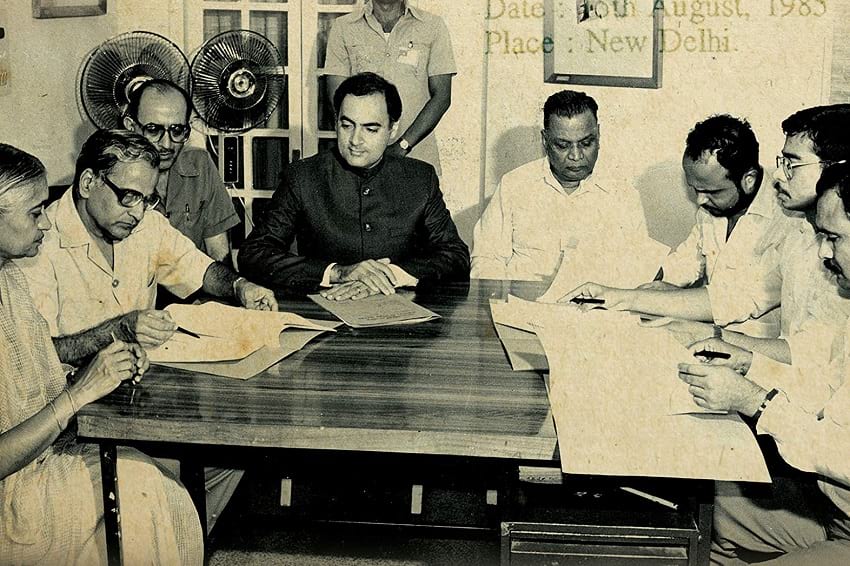
Assam- The Accord, The Discord. (© Penguin Random House India)
Assam-born Sangeeta Barooah Pisharoty became the first ever female journalist from the Northeast to work on the forefront in covering news from the North-eastern states. Having won several awards for her in-depth reportage over the years on matters related to the states, Sangeeta Barooah Pisharoty turned her attention to penning a book. Assam – The Accord, The Discord is a first-hand account of her own experiences and memories of the signing of the Assam Accord of 1985, which as per her narration, came with its own fair share of negatives.
In her debut book, she mentions how the signing of the Assam Accord left the state in terrible times. The insurgency was at its peak, streets witnessed bloody wars, the political scenario was in disarray. And common people had no choice but to flee Assam in search of a better future. In conversation with Biraj Sarma, one of the key players of the Assam Accord, the author gives a detailed account of the past – the signing of the Memorandum of Settlement (MoS) and how it affected the present – updating of the National Register of Citizens (NRC) and the controversial amendment to the Citizenship Amendment Act.
The Beginning
In the year 1985, when the author was in school, the Punjab Accord had just been signed in July. It was only a matter of time before Assam got its share of the limelight, for which student bodies and local parishads were quite stirred up in the state. Although none knew what the Accord would entail or how it would assure the Assamese regarding preservation and protection of their culture and identity.
When the author met Biraj Sarma, one of the three key signatories of the Assam Accord of August 1985, she realized all the efforts of the students’ agitation – the Assam Movement – were not very easy to come by.

Students rally during the Assam Movement, 1985. (Wikimedia Commons)
A picture on the wall of Sarma’s home, which has now come to be associated with the signing of the MoS, took both the author and Biraj Sarma back in time.
While the then Indian Prime Minister Rajiv Gandhi looked excitedly at the All Assam Students’ Union (AASU) general secretary, receiving the signed copy of the Accord from the Union Home Secretary, members of the All Assam Gana Sangram Parishad (AAGSP), seemingly looked confounded.
Special Indian Air Force planes had picked up members of the AASU and AAGSP from Guwahati a few hours before the Accord was to be signed. Another IAF flight brought in executive members of the student body late in the evening of August 14, 1985.
“On 13 August, all the executive members of AASU and AAGSP were hurriedly summoned to Delhi by the Union home ministry to hold ‘a detailed and broad based discussion on the Assam problem.”
The Disagreement
After the Accord was signed and the signatories returned to the guest house with the final draft, not everything went well between the AASU and AAGSP members. Some disagreed with a particular clause mentioned in the draft. The clause read, in an exclusive provision for the state, it would segregate foreign nationals from Indians living in Assam before March 24, 1971. Although their original demand was 1951, as per the NRC that would determine who the citizens of Assam actually were. Heated argument also ensued amongst the group regarding no clear promise from the central government on scrapping of the Illegal Migrants (Determination Tribunal) (IMDT) Act. However, key AASU members made sure there was no more scope for negotiation.
“[Union home secretary] R.D. Pradhan told us that the government couldn’t scrap an Act passed by Parliament just like that, but it will try to create a political consensus for its removal…”
While deliberations went on and some of the members opposed the final draft. It was said that the central government had agreed to provide an Indian Institute of Technology (IIT) in Guwahati, along with a central university.
“Did we agitate for six years for an IIT and a central university?”
Much later, amidst games of hide and seek, the group went to the Prime Minister’s residence settling for the fact that it was the best possible deal and that there was no more time to waste on this matter.
“…Officials, ‘kept putting pressure’ on them throughout the day on 14 August to somehow arrive at an agreement since Prime Minister Gandhi had decided to announce the Accord in his Independence Day speech at the Red Fort the next morning.”
A Dent in the State
After the Assam Accord was signed and PM addressed the nation the next day, the Assamese felt liberated as the old dream of autonomy and civil liberties over their homeland was achieved. But while many cheered the decision, minority groups rose up in shock and anger.
“…What particularly infuriated them was the Centre’s approval of 1966 as the base year for citizenship enumeration in the state. As per Clause 5 (2) of the Accord, the names of those foreigners who entered Assam after 1 January 1966 and up to 24 March 1971, ‘shall be deleted in accordance with the provisions of the Foreigners’ Act, 1946…”
Seed of Dissent
As minority groups kept protesting, AASU demanded the revaluation of the electoral rolls, which had names of thousands of foreign nationals (of Bangladeshi origin), that they originally wanted to weed out in their demand for revision before the General Elections of 1980. In one of his speeches, the then Chief Election Commissioner (CEC) S. L. Shakhder mentioned how foreign nationals were largely and improperly included in the electoral rolls, particularly in the North East, thereby enraging the people.
“…People of East Bengal lineage – both Hindu and Muslim –they intended to make Assam a part of their extended Bengali homeland by negating local language and culture…”
Another reason for Assam‘s rage was that, while the hill tribes of other north-eastern states were protected under the Constitution, the people of Assam were overlooked. Also, the non-Congress leaders were under the impression—Congress took calculated risks to have a voter base constituting illegal immigrants from the other side of Assam’s border. This led to further issues in the state and discord crept up in the parties.
As the book progresses further, the author narrates Prafulla Kumar Mahanta ‘s journey to becoming the youngest and the most controversial Chief Minister of Assam and how his two tenures resulted in some of the toughest times in the state. Assam – The Accord, The Discord also looks at the six-year-long agitation against illegal immigrants that gave rise to the recent uproar on the NRC in Assam, the essence of which was the deportation of people, who failed to prove their Indian citizenship.
Sangeeta Barooah Pisharoty’s book is a detailed account of what made Assam the state it is today and is a perfect page-turner.
More about the book:
 Assam- The Accord, The Discord | By Sangeeta Barooah Pisharoty
Assam- The Accord, The Discord | By Sangeeta Barooah Pisharoty
RELATED
The post A Peek Into The Dark Times That Befell Assam and Its Effect on the Modern-Day State appeared first on .
]]>The post Sixteen Stormy Days- The Story of the First Amendment to the Constitution of India by Tripurdaman Singh appeared first on .
]]> Amendment to the Constitution of a newly built democracy could be a stride towards advancement or deterioration, depending on the nature of the reform. One such reform was the Land Reform, promised by the freshly formed Government of India to its people. And this is the core issue discussed by Tripurdaman Singh, in his book ‘Sixteen Stormy Days’.
Amendment to the Constitution of a newly built democracy could be a stride towards advancement or deterioration, depending on the nature of the reform. One such reform was the Land Reform, promised by the freshly formed Government of India to its people. And this is the core issue discussed by Tripurdaman Singh, in his book ‘Sixteen Stormy Days’.
“The amount of freedom of expression that is allowed or indulged in by the press can hardly be exceeded in any country in the world. I shall be quite frank with you. Much that appears because of that freedom seems to me exceedingly dangerous from many points of view. Nevertheless, I have no doubt in my mind that the freedom of the press from the larger point of view, is an essential attribute of the democratic process.” ― Jawaharlal Nehru
Initial hurdle in the implementation of the reform was the delaying of Bihar Land Reforms Act by the judiciary, and another trouble was brewing up. The Zamindari Abolition and Land Reforms Bill were placed in the UP Legislative Assembly on 10 January 1950. It was opposed tooth and nail by the Democratic Party – the splinter group of congress. The Bill was hastily revised and got approved by the President, Dr. Rajendra Prasad, on 24th Jan’ 1950. Congress projected it as a victory for the farming community. But, more than 4000 Zamindars took the matter to court, calling it an infringement on Fundamental Rights.
“The new republican government, much like its colonial predecessor, was finding it excruciatingly difficult to function within constitutional bounds”
The Maharaja of Balrampur and Kapurthala, P R Das, deposed that the ‘state policy’ couldn’t be treated as ‘public purpose’. Nor could the assent of the President change ‘unconstitutional’ to ‘constitutional’. The Allahabad Court ruled that the properties couldn’t be vested in state till disposal of all petitions put up against the ‘Act’. This was a huge setback for the Congress. A meeting of Congress working committee was held on 25th Jan’ 1950 in New Delhi.
“Sardar Patel had interpreted Nehru’s conception of his own role as prime minister to be ‘wholly opposed to a democratic and cabinet system of government’.”
Nehru said that parliament represented the will of people and must have a way unbridled by the press and the Judiciary. Ironically, ‘constitutional validity’ of the proposed law was never challenged by the court. It only pressed for legal procedures to run their course. But Nehru’s view, the slow-moving procedures were a drag on democracy, prevailed. And the task of amending constitution began in right earnest.
“In this way, Mukherjee concluded, the government would be able to both draw up legislation imposing restrictions on fundamental rights, and preclude the need to justify the reasonableness of such legislation before the courts.”
A 14th Feb 1951 press release described it a benign exploratory exercise. Press was playing on falsehood and indecency, Nehru said. Some issues of national importance, he added, aught to be immunized to judicial view. So, Article 13 on fundamental rights, and article 14 on equality before the law, must be fine-tuned in line with social reforms.
“Instead, on 26 January 1951, India awoke to the headline ‘Zamindari Abolition in UP Stayed: Allahabad High Court Issues Injunctions.”
On 12 March 1951, the Patna high court declared Bihar Land Reforms Act as unconstitutional. The Bihar government’s argument that it had the president’s approval, was rejected.
This was another setback that would delay the manifestation of the reform. Ambedkar sympathized with Nehru and felt that amendment could be carried out for speedy execution of state policy. Constitution, finally, would bend to peoples’ will.
“Nehru had been told by several members in no uncertain terms that to attract more people to the Congress, it was imperative that the government implemented the party’s social and economic programmes. Zamindari abolition and land reform were a critical part of this programme, the central pillar of its social and economic agenda.”
The Calcutta high court in the meanwhile ruled that the government must pay for the acquired property as per the existing market rates, and not arbitrarily. Retaining the word ‘reasonable’ in Article 19 was mooted. The word ‘reasonable’, attached to liberties, felt Congress, would be a hurdle as judiciary may have a different view of what is ‘reasonable’.
The book is racy without missing on significant details of the story. Now that India has had a total of 103 amendments to its constitution, it is fascinating to know how the ball was set rolling. Tripurdaman Singh with Sixteen Stormy Days makes the early days of Indian Republic come alive with deep insight. A must-read for intellectuals, as well as the common man.
RELATED
The post Sixteen Stormy Days- The Story of the First Amendment to the Constitution of India by Tripurdaman Singh appeared first on .
]]>The post Anabel Loyd’s New Book ‘Bahawalpur’ Documents the ‘Rise and Fall of a Glorious British India Princely State appeared first on .
]]>Conversing with Salahuddin Abbasi, grandson of Bahawalpur’s last ruler, the author brings forth the legends and stories associated with the prosperous kingdom.
Initial setbacks for newly-formed Pakistan
In her book, the author mentions the troubling times that fell on Pakistan, post its traumatic separation from India in 1947. Its coffers ran dry and not enough cash was available to pay the new employees that took positions in offices.
“When the new finance minister arrived in his new office in Karachi, the capital of his new country, on 15 August 1947, he found nothing there except one table. The treasury was almost as bare.”
Although Pakistan was to receive Rs 750 million from New Delhi, it ran into immediate debt with no money to pay its army for months. In desperate times, Muhammad Ali Jinnah turned to the Nizam of Hyderabad for help, who had already loaned him Rs 200 million. Jinnah’s close connection with the Nawab of Bahawalpur further yielded Rs 70 million, as a gift to the new State.
“All the salaries of government departments for one month were also met by Bahawalpur. Given Penderel Moon’s concerns about the Bahawalpur state finances, it seems likely that much of the funding was supplied from the Nawab’s personal wealth, or from the confluence that had been of such concern to the British authorities in the past, where state and royal treasuries merged. For a brief period of independence, Bahawalpur was the gift that kept on giving, until it disappeared.”
Prosperous times during Bahawalpur’s reign
When Jinnah set up the States and Frontier Regions Ministry in 1948, most of the officers serving in bureaucratic positions prior to partition became governors and commissioners of the princely states. But the accession of these feudatory states into new Pakistan and appointing prime ministers was not an easy task.
“The British, we know, had latterly been particularly keen to have a hand on, if not a hand in, appointments in Bahawalpur, to safeguard their financial interest in the state. The Pakistan government equally wished to exercise a level of control over any state.”
There was a tussle between the British and Pakistan to govern over Bahawalpur as it was the proverbial goose that laid golden eggs. When the princely state finally merged into the country, its wealth was spent on good causes. Either Bahawalpur’s treasury or the Nawab himself funded free education, healthcare and scholarships. During Bahawalpur’s blossoming existence, the literacy rate in Pakistan was the highest.

Nawab Mohammad Bahawal Khan Abbasi V Bahadur, the 11th Nawab of Bahawalpur. (Wikimedia Commons)
Tougher times ahead
When the chief secretary to the Government of North-West Frontier Province, Sir John Dring was appointed as prime minister of Bahawalpur, it gave way to chaos. Permanent Secretary at SAFRON, Lt. Shah, expressed his displeasure at Dring’s working in a letter addressed to the Prime Minister of Pakistan, Liaquat Ali Khan. He complained,
“Unfortunately he has still not reconciled himself completely to the fact that the British rule has gone and that we meant to do our work in our own way.”
While Dring was closely attached to the Nawab’s cause, Lt. Shah had his own plans. He wanted the people of Bahawalpur to support the government and thus render the Nawab to a puppet carrying out constitutional duties. State assembly elections in May 1949 in Bahawalpur further pushed the Nawab in the pits. The Muslim League had a clean sweep, which gave the central government easy access to implement reforms in 1951.
“In addition to reiterating the nawab’s role as ruler, the four articles of the agreement limited the money the nawab could withdraw from the state treasury for personal use, required him to provide an inventory of his property to the government, and allowed the royal family to retain their titles in exchange for a government guarantee ‘that the method of appointing the heir to the throne shall be in accordance of the laid down rules and traditions of the State.”
As the book progresses further, Loyd explores Bahawalpur through the standpoint of Sadiq Mohammad Abbasi’s grandson Salahuddin Abbasi, who reminisces the good times he spent with his brother during his formative years.

Sadeq Mohammad Khan V at the age of 15. He became the Nawab of Bahawalpur State at the age of three after his father’s death. (IWM Collections)
“They had their own private room with bathroom and two servants in adjacent accommodation. They were close enough to the swimming pool to sneak out for a cooling swim in the hot weather, and there were Saturday afternoon bicycle excursions to the cinema in Lahore. They enjoyed themselves…”
Salahuddin also narrates the harsh times that befell the kingdom after the last ruler’s demise. And how the government of Pakistan began meddling with its heritage.
“He had grown up the dutiful son of one strong man, later to be used by others whom he had little power to resist. On the contrary, it appeared imperative to work with and for the leaders of his country if he was to save what he could of the Bahawalpur heritage…”
The author also comments how the kingdom was eventually torn between the new ruling forces at the centre,
“Between President Ayub Khan and President Asif Zardari, a lot of the hopes of the people of Pakistan as well as the lifeblood of the former state of Bahawalpur had drained away.”
Anabel Loyd’s ‘Bahawalpur – The Kingdom That Vanished’ gives a detailed account of downfall of a flourishing princely state. She paints a clearer picture of the stressful times in Bahawalpur and Pakistan’s efforts to keep the state’s rich legacy under wraps. Loyd’s thorough research and Abbasi’s personal touch make it an interesting read.
More about the book:

Bahawalpur- The Kingdom that Vanished | By Anabel Loyd
RELATED
The post Anabel Loyd’s New Book ‘Bahawalpur’ Documents the ‘Rise and Fall of a Glorious British India Princely State appeared first on .
]]>The post World War 2– Direct and Indirect Intervention in World War Two by the United States of America appeared first on .
]]>The United States of America was a major force in the war but did not join until late in proceedings following a strong non-aggression pact after the devastation of World War I. Their citizens did not want to meddle in European affairs. Expansionism from Japan and Germany changed this however bringing about a need to act but it wasn’t until the Japanese attacked the US Naval fleet on home soil (Pearl Harbour) that the President retaliated. Germany – allies of Japan – declared on the US which meant American soldiers would directly join the fight in Europe also.
Land lease
Before the US even joined the fighting, they intervened. Having strong ties with the Allied Forces (UK, France and Russia) they passed an act which stated,
“… that the U.S. government could lend or lease (rather than sell) war supplies to any nation deemed “vital to the defense of the United States.” Under this policy, the United States was able to supply military aid to its foreign allies during World War II while still remaining officially neutral in the conflict.”
They gave much of this to one of their allies in World War One. At a time when Nazi Germany had overthrown much of France and had almost surrounded the British Isles the US kept the British people fighting. It meant they could keep competing against Germany until the Americans joined the fight.
The Logistics of War
Here are a selection of public domain photographs which show the aid which the US was able to send to the Allied Forces and of course use themselves. The 40’s brought about an economic boom with a wealth of manpower, natural resources and industrial strength.

Assembling the North American B-25 Mitchell at Kansas City, Kansas (USA). (LOC)

Part of the cowling for one of the motors for a B-25 bomber being assembled. (LOC)
The B-25 Bomber (The North American B-25 Mitchel) became one of the most famous aircraft of World War II due to its effectiveness and flexibility. Most notably it was used by the US in retaliation for the Pearl Harbour attacks by Japan but they were also sold to the British and Soviet Air Forces. It was the precursor to the B-29 which would transport and drop the Atom Bombs on Nagasaki and Hiroshima which would effectively signal the end of World War Two.
“It [the B-25] required 8,500 original drawings and 195,000 engineering man-hours to produce the first one, but nearly 10,000 were produced from late 1939, when the contract was awarded to North American Aviation, through 1945.”

Gunnery practice on USS Biloxi (CL-80). (U.S. Navy)
As important as aircraft in World War Two were naval craft. The USS Biloxi – named after a city in Mississippi – was a light cruiser type of battleship. It was built in Virginia by Newport News Shipbuilding and Dry Dock Company. Biloxi was awarded nine Battle Stars for services in the Pacific Campaign during World War II (Between the US and Japan) including the famous battle of Iwo Jima – a small yet important atoll near the Japanese mainland. Despite all of its service, Biloxi never lost a single crew member and only received small damages during a Japanese kamikaze bombardment towards the end of the war. The kamikaze fighter actually hit the deck of the ship but the bomb on board failed to explode.

Launch of USS Lexington (CV-16), 1942. (U.S. Navy)
The USS Lexington was one of the first-ever aircraft carriers built. During the attack on Pearl Harbour the Lexington was further away in the Pacific which was a major mistake on the part of the Japanese army. Lexington would go on to have success in the war including sinking a famous Japanese aircraft carrier called Shoho and raiding several others. After being hit by torpedoes and aircraft bombs the USS Lexington was scuttled – sunk deliberately by its own crew. Its remains are still on the ocean floor not far off the coast of Australia.

Halftrack infantryman with Garand rifle. (Alfred T. Palmer / LOC)
Half-Tracks – as the name suggests – are hybrid tanks with tank tracks at the back and wheels at the front. They make it possible to traverse various terrains at high speeds yet unlike tanks, they provided easier accessibility for transporting troops, if having to make a quick disembarkation for instance.
Alfred Palmer was a famous American photographer, most notably active during the Second World War. While rightly so, the allied soldiers, generals and world leaders gain most of the plaudits for their contributions to the war effort, photographers and videographers played an important role in making sure that the time was chronicled and while never be forgotten.
 Here is a staged photograph of an infantry man with an M1 Garand, a famous semi-automatic rifle at the time of the Second World War. It is immortalised in many video games such as Call of Duty and historic movies. Its bolt-action sound is instantly recognisable and brilliant for dramatic cinematography. The US Army started using it in 1936 after being developed in Springfield, Massachusetts.
Here is a staged photograph of an infantry man with an M1 Garand, a famous semi-automatic rifle at the time of the Second World War. It is immortalised in many video games such as Call of Duty and historic movies. Its bolt-action sound is instantly recognisable and brilliant for dramatic cinematography. The US Army started using it in 1936 after being developed in Springfield, Massachusetts.

Woman workers at the Douglas Aircraft Company Long Beach plant, California. (Alfred T. Palmer / LOC)
While most of the acclaim goes to males in World War Two, the massive contribution made by females largely goes unnoticed. However, 350,000 women served in the Armed Forces alone including pilots, navy and medics. By the end of World War Two, the percentage of female workers in the US rose to 37% and provided a great jump towards equality.

“We Can Do It!” by J. Howard Miller was made as an inspirational image. (National Archives)
For constructing planes alone (a massive factor in winning the war) women took up 65% of these positions compared to 1% before WW2. First Lady at the time, Eleanor Roosevelt encouraged women to sign up, largely inspired by British women doing the same in previous years. Propaganda such as a character called ‘Rosie the Riveter’ illustrated the effect a women could have in the war effort, not just on the front lines. A female Uncle Sam if you will.

An African American mechanic working on motor maintenance section, Ft. Knox, KY. (LOC)
African Americans also had a vital part to play in World War 2. Similar to women, in previous years they were deemed by many sections of society as second-class-citizens but by the 1940s their positions had improved. Again, the war broke more segregation barriers, at least internally. 2.5 million African Americans registered for the war draft and achieved tremendous acclaim for their efforts. For example, Private Ernest A. Jenkins who was awarded the Silver Star for his part in the Liberation of Chateaudun in France. The star was awarded by famous General George S. Patton.

This photo in New Orleans shows an Aviation Machinist, Signalman and two pharmacists at the finale of the Second World War. (U.S. Navy)
Author’s Opinion
These photographs show the incredible logistics behind a war as huge as World War Two. The amount of time, resources and manpower needed as a starting point is absolutely massive in order to keep the armed forces stocked and ready to fight. Even before the US enters World War Two the fact they were supplying the allies such as Britain, France and Russia was an essential assistance. If they did not, perhaps Germany would have broken British resistance and been able to concentrate on the Soviet Union. Similarly, if they did not go to war with Japan, perhaps Japan would have gave the Soviets a bigger fight, which would in turn help Germany.
What these photos do not show is the abhorrent suffering which comes with war. It is a horrible thing. There are a few silver linings however such as the progression in terms of Racial and Sexual equality due to the war effort. This happened in many countries involved. And of course, the many unions created after the war in order to stop the same thing happening again. But it must be repeated that war is a crippling thing.
These photos, but more so photographs which show the sufferings of the war must be displayed to all. Such as the Nazi death camps, the starvation, separation and animalistic instinct which fighting brings. For as writer George Santayana states,
“Those who cannot remember the past are deemed to repeat it.”
Enjoyed this article? Also, check out “Dazzle Camouflage: The Wonder That Worked in World War I“.
Fact Analysis:
STSTW Media strives to deliver accurate information through careful research. However, things can go wrong. If you find the above article inaccurate or biased, please let us know at [email protected].
RELATED
The post World War 2– Direct and Indirect Intervention in World War Two by the United States of America appeared first on .
]]>The post The Magnificent Diwan- Life Story of the Most Powerful Indian Statesman of the 19th Century by Bakhtiyar K. Dadabhoy appeared first on .
]]>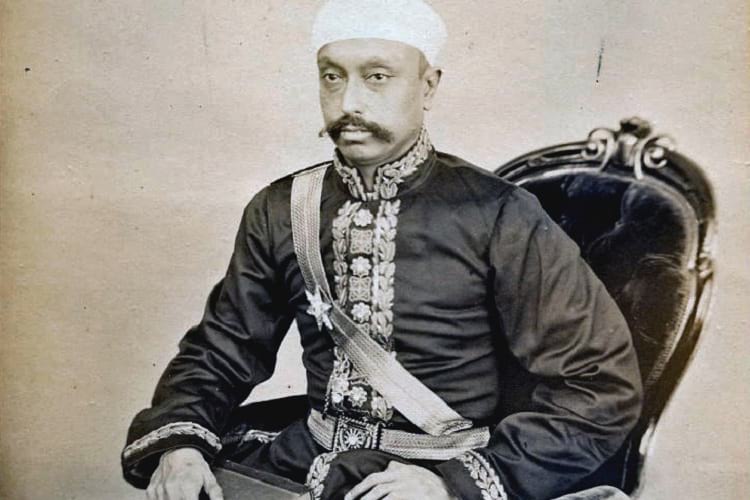
Sir Salar Jung. (Wikimedia Commons)
“The Magnificent Diwan” is a story of Mir Turab Ali Khan Bahadur Sir Salar Jung Shuja-ad-Daula Mukhtar-ul-Mulk, widely known as Salar Jung I, Diwan of the Nizam of Hyderabad from 1853-1883. The Biography is authored by Bakhtiyar K. Dadabhoy, as an attempt to interweave Diwan’s political legacy with his personal anecdotes. Salar Jung I played an important role in reforming and rebuilding the Hyderabad state. Thus, he is rightly known as the founder of Hyderabad.
Two of the important events, biographer Dadabhoy discussed in the book, are of the politically ambitious Nizam’s State Railway and the controversy surrounding the visit of Prince Wales to India. Making it an entertaining and interesting read about political manoeuvring and deviousness.
The Nizam’s State Railway
Dadabhoy, writes about Governor of Bombay Sir Bartle Frere’s idea of linking the Great Indian Peninsular Railway via Hyderabad. Thus connecting Hyderabad to Bombay and Madras, and rendering it more accessible in times of need. Although, his ideas were well received by the Secretary of State- Sir Charles Wood; the Governor of Madras- Sir William Denison had his apprehensions.
Meanwhile, The British resident in Hyderabad, Sir George Yule with support from Salar Jung, tried to coerce the viceroy, Lord Elgin, into accepting the proposal of having railway pass through Hyderabad. It would make it easier for the British to move troops and stores from Secunderabad to Madras, Bombay, Poona and Bangalore, he argued. The writer then discusses the nature of apprehensions and what led the Governor of Madras to cave in.
“Wood, for all his reservations, had recognized the value of a line connecting Hyderabad and conceded that such a line would ultimately have to be made. The motivation was almost entirely military, though the economic advantages of connecting Hyderabad with Bombay may have also contributed to the decision.”
As much as Sir John Lawrence, who replaced Lord Elgin as viceroy, agreed to the scheme, the Nizam, Afzal ud Daula, had his doubts. Not so much about the financial aspect—the British wanted him to bear half the cost of building the railway—as the social and political impact the railway line would have on his subjects.
“At first, the nizam was completely opposed to the plan, regarding the railway as the forerunner of undefined evil in spite of Salar Jung’s eloquent championing of the cause.”
He gave permission only after the British government agreed to let him have jurisdiction over the railway in his territory.
The writer then describes how the next few sets of events lead to the foundation of Hyderabad State Railway. And how Nizam was smoothly deceived to bear the complete cost of construction of the railway line.
“Salar Jung watched helplessly as the nizam’s money was used to serve the interests of the British. It would be wrong to say that he cooperated; he merely yielded when left with no choice”
A Storm in an Indian Tea Cup
A little after the muddled proposals for Hyderabad Railways was accept, there brew “A Storm in an Indian Tea Cup” writes Dadabhoy. In 1875, Prince of Wales visit to India stirred up controversy in Hyderabad. The British wanted the young Nizam, Asaf Jah VI, to travel to Bombay to pay his respects to the royal visitor at a planned gathering of Indian princes. Salar Jung staunchly opposed this on grounds of the eight-year-old Nizam’s delicate constitution.
“While the delicate health of the Nizam was a fact, Salar Jung would, in all probability, have opposed the visit in any case because he did not want the Nizam to pay public homage to the Prince of Wales as his suzerain.”
Resenting this defiance, the British resident, Saunders, hinted at forcing the Nizam to attend the Prince of Wales’ gathering in Bombay. Salar Jung then took the unprecedented step of printing and circulating copies of their correspondence. He even sent them to the Prince of Wales to acquaint him with the situation. Fair-minded Englishmen were outraged by the resident’s bullying tactics.
“The Times of India wrote: ‘To threaten a native sovereign with future mischief if he elects for good reason—or even for no reason at all—to remain away, is a coarse and clumsy way of promoting loyalty and affection amongst those who should be the pillars of our Empire of the East.’”
The British government became alarmed that the Prince of Wales might undermine their prestige by visiting Hyderabad and that he would come under the Diwan’s influence.
“Lord Salisbury observed, ‘Nothing is more remarkable than the influence which Salar Jung acquires over Englishmen with whom he came in contact and the fidelity with which they serve him after they have come home.’”
The whole affair turned out to be a diplomatic victory for Salar Jung, as the Bombay Gazette duly noted, comments Dadabhoy.
“He had managed to show both Aitchison and Saunders in a poor light and had the ‘satisfaction of placing the Nizam before the British public in the now familiar character of the persecuted Indian Prince.”
Today, the name Salar Jung is associated with the Salar Jung Museum that houses artefacts and relics collected by Salar Jung III, the last prime minister from the noble family. Not much is known about his predecessor but the state of Hyderabad is as a magnum opus of Salar Jung I. In The Magnificent Diwan, Bakhtiyar K. Dadabhoy elucidates on his excellent administrative skills that lead to rebirth of the glorious kingdom that we have read and heard about.
More about the book:
 The Magnificent Diwan- The Life and Times of Sir Salar Jung I By Bakhtiar K. Dadabhoy
The Magnificent Diwan- The Life and Times of Sir Salar Jung I By Bakhtiar K. Dadabhoy
“This book is not merely a chronicle of Salar Jung’s life but also a history of Hyderabad—both social and governmental—and gives the reader an encompassing view of the man and his world, using his life and work to illumine the period.”
RELATED
The post The Magnificent Diwan- Life Story of the Most Powerful Indian Statesman of the 19th Century by Bakhtiyar K. Dadabhoy appeared first on .
]]>The post Horrors of 1971 Bangladesh Genocide Chronicled by Anam Zakaria Through a More Personal Lens appeared first on .
]]> The year 1971 is of great importance not just for Bangladesh and Pakistan, but also for India. It changed the political climate in the subcontinent for years to come. We have enough political accounts that serve the state narrative of the three nations involved, but very few to document the horrors experienced by civilians. In her book, 1971: A People’s History from Bangladesh, Pakistan and India, Anam Zakaria, oral historian and author explores what it means to belong, drawing on harrowing accounts of lives tangled in the struggle for freedom.
The year 1971 is of great importance not just for Bangladesh and Pakistan, but also for India. It changed the political climate in the subcontinent for years to come. We have enough political accounts that serve the state narrative of the three nations involved, but very few to document the horrors experienced by civilians. In her book, 1971: A People’s History from Bangladesh, Pakistan and India, Anam Zakaria, oral historian and author explores what it means to belong, drawing on harrowing accounts of lives tangled in the struggle for freedom.
By examining the social narrative, Zakaria creates a kaleidoscopic collage of memories that are haunting, personal and sincere.
Bangladesh didn’t gain Independence at the stroke of midnight like its neighbours; India and Pakistan under the Indian Independence Act of 1947. Partition didn’t give birth to Bangladesh rather it was the war of 1971. The Liberation War as known in Bangladesh, between the two wings of Pakistan; East Pakistan and West Pakistan culminated into dismemberment of the former wing into a new state- Bangladesh; The Country of Bengal.
The fight for liberation officially began in March 1971 as a response to the Operation Searchlight carried out by the military regime of West Pakistan to curb the voices of nationalist Bengali intelligentsia. But the seeds for the movement were sown soon after Partition as the Language Movement. This movement was headed by the intellectuals of the erstwhile East Pakistan rallying against the repression of the cultural and social identity by an authoritarian government.
“The language issue was a catalyst indeed and, in hindsight, is popularly understood to be a major source of rupture.”
In Chapter 5 of the book, Zakaria interviews Bangladeshi academics and historians who lived through the massacre.
“Through the following interviews, this chapter seeks to explore the more personal impact these events had on the lives of East Pakistanis, and the nuanced ways in which they transformed from Pakistanis to Bangladeshis before the latter even took birth.”
One of the interviewees is a historian and writer, Professor Muntassir Mamoon of Dhaka University. Mamoon as a young man in the 1960s closely observed the political shift of powers in the years leading to the war. He talks about incidents that yielded his transformation from a patriotic Pakistani to a supporter and member of the Bangladesh movement. Along with the other writers, Mamoon helped foreign journalists document the carnage as it took place.
“Mamoon had dedicated his life to archiving, writing and teaching about 1971, while also advocating for war crimes trials in Bangladesh. He was committed to ensuring that the memory of 1971 was not forgotten.”
In his efforts to not let the memories of the genocide be erased from the public mind, he founded the genocide and torture archive and museum in Khulna district of Bangladesh. In Mamoon’s museum, one of its kinds in South Asia, are rare collections of photographs, paintings and relics showcasing the horrific realities of the ninth month-long butchery.
“Before we left, Mamoon gave us a tour of the museum, showing us photographs of vultures picking on the bodies of Bengali men and women, images of dead children, their eyes popping out, their legs bitten off by animals.“
Of her tour around the museum, Zakaria comments on drawings by young school students depicting their understanding of the war and the Bengal armed resistance. These drawings evoke strong feelings of loss, pride and victory. Observing this she says Mamoon’s mission to keep the flame of memories burning has been accomplished.
“These were the vivid memories, the photographs, the clothes, the rooms and the spaces, which kept 1971 alive. These were the expressions of the war, the living memory of 1971. There would be no letting go.”
Anam Zakaria as an oral historian undertook great efforts to understand and document the personal narratives and sentiments of the subjects of the 1971 movement. All her efforts helped her deliver a perspective in 1971: A People’s History from Bangladesh, Pakistan and India that is often overshadowed by the state interests.
 1971- A People’s History from Bangladesh, Pakistan and India | By Anam Zakaria
1971- A People’s History from Bangladesh, Pakistan and India | By Anam Zakaria
“Through a personal journey, she juxtaposes state narratives with people’s history on the ground, bringing forth the nuanced experiences of those who lived through the war. Using intergenerational interviews, textbook analyses, visits to schools and travels to museums and sites commemorating 1971, Zakaria explores the ways in which 1971 is remembered and forgotten across countries, generations and communities.”
RELATED
The post Horrors of 1971 Bangladesh Genocide Chronicled by Anam Zakaria Through a More Personal Lens appeared first on .
]]>The post Sailing Ships: A Brief History Into the Beginning and End of Plain Sailing of the Ancient Boats appeared first on .
]]>
The U.S. Navy aircraft carrier underway with the Italian Marina Militare training ship Amerigo Vespucci on 12 July 1962. (U.S. Navy)
Man has used wooden rafts to cross rivers since times immemorial. In time, the rafts got upgraded to boats. Then came gigantic sea ships, powered by winds skilfully trapped in fabrics called sails, and the oars operated by human hands. Machines took over later in the 19th century. But, the sails and the oars, remain in reckoning even today. For commerce, adventure sports and the training of defence forces.
Boats evolved hand in hand with human civilization
Existence of water vessels, the boats can be traced as far back in history as 4000 BCE. Herodotus (484-425 BC), the Greek historian wrote about a 2-year sea voyage undertaken by an Egyptian king in 600 BCE. Boats were designed according to their use (business, travel, or battle). Both were rowed, i.e. propelled by human hands, but differed in the way their bodies were constructed. These remained in use for long till cyclonic storms forced the man to trap and use wind power, and ‘sails’ arrived on the scene.

An artistic depiction of a ship using both sail & oar propulsion. (Internet Archive Book Image / Flickr)
Sail and mast were the first improvisations
The sails were pieces of cloth tied to poles in a spread out. These came in the way of winds, and the wind power was used to propel the boat. One combination of cloth and the poles hoisting it made one ‘mast’. The mast generated wind power for propulsion of the ship/boat. Some ships used both sails and oars for propulsion. Hostile winds did intercept the journey, but sails could be moved and rotated to cheat winds and remain going. Merchant ships were better off on sails alone, as space otherwise used to house the rowing crew, was made available for more payload. This ushered an era of the pure ‘sailing’ ships in a big way.
The rig was next development
In time, sails were no more plain sheets of cloth to catch the wind, but skilfully arranged traps which could be used synergistically by trained men. The sails could be manoeuvred to move the boat even against the wind currents. A change in their relative positions ensured tapping the power of flowing air as well as the fierce winds, into the desired direction. Masts attached to ropes and rotating wheels, in an ensemble called rig, made it possible.
Number of masts and shape of sail added to the efficiency
Speed remained a challenge in pure sails. In oared boats, increasing the number of rowing hands was the logical answer for more power and more speed. Could the same be achieved with more number of sails and masts? Yes, by increasing the number of masts, speed of the ship could be increased significantly. Till 1400 BCE, all ships were using a single mast.
In the beginning, the principal sail was square-shaped. It had to be rotated for change in the direction of the journey. Such rotation naturally demanded some free space on the deck. It also demanded a number of men to rotate a large rig manually. So in 1200 BCE, 2 masts were put into use. The front mast was larger and triangular (lateen) and the second – smaller (generally square-shaped), behind the front mast. By 5th century AD, ships had several masts. And sails were oriented in myriad ways for desired travel. The masts were so oriented that winds could be harvested on both sides, front, as well as the backside.
 Oared ships evolved in parallel
Oared ships evolved in parallel
Simultaneously with pure sail, oared ships were also evolving. Like, Chinese putting a watertight box long the length of the boat where men could sit comfortably and move oar with more efficiency. Oar-cum-sail models were also in vogue. In these ships, sails could be wrapped to avoid sharp frontal winds and move on pure rowing.
Carvel and clinker constructions were the earliest 2 designs
The reign of Richard I (1189-99) saw 2 kinds of ships: the fighting ship, called galley and propelled by oars. And, merchant ship – the pure sail. The Mediterranean carrack of France was one of the 2 landmark ships of 14th century. It had 3 large masts, hull (boat’s body) made in carvel construction, wooden planks butting against each other to give a smooth surface. And used both square as well as the lateen (triangular) sails. The other ship was double-ended clinker construction (hull made by overlapping wooden planks) with similar sails.
Compass facilitated global travel
By the beginning of the 15th century, ships were using a compass for navigation. Ships, all decked up with sails (3 masts and 6 sails), became common. By the end of this century, Vasco Da Gama and Columbus made their mark in oceanic navigation, and trading became global. By 1425, the payload on a large ship had gone up from 300 tons to 1425 tons.
Ships catered to trade as well as battlefield
Merchant ships had their own armed security to face possible threats in the course of the journey. A ship used for trade during usual days could double up as fighting ship in wartime. In time, trade became a flashpoint for war. The 17th century war between Dutch and English resulted from a trade rivalry. Ship designs were spruced up to for the twin challenge of battle and business. The trading ships were escorted by the well-armed naval ships to protect them from enemies.
Britain became the naval superpower
As the Europeans explored east, they engaged the natives of the coastal region as their business partners. Thus, in places like Calcutta (Kolkata), Madras (Chennai) and Bombay (Mumbai), European settlements were established. The arrangement paid rich dividends to Europeans, churning out profits to the tune of 100% and even more. The 17th century was Holland’s ‘golden century’ and during this very time, England superseded France as ‘Europe’s seat of industry’. As the trade of English grew by leaps and bounds, professional shipbuilders were roped in to upgrade the sea boats. By the 18th century, Britain became the topmost naval power, a status it lost to America in the middle of the 19th century.
American navy became the next superpower
When America became independent in 1783, the British colonies established in America lost business. The American traders geared up to compete with the British East India Company, and the first thing they required was strong and efficient ships. They studied the existing ship models and managed to build better ships at low cost. A number of sails were put up to increase the speed. Thus, they could ferry perishable goods well in time and beat the competition. In the year 1815, the American ships were radially improvised. By the year 1840, the total body weight of ships increased from 500 to 1,200 tons. Ship’s body (hull), earlier, used to be 4 times longer than the size of beam (width of the ship at the widest point). The ratio increased to 51/2 times. The longer ships could travel at a faster speed and returned its cost-prize to the owner in 2 to 3 years. In 1620, the British ship ‘Mayflower’ took 66 days to travel from England to America. The American ship (from Black Ball Lines’ series), covered this distance in just 23 days in 1825. In 1845, the distance was covered in just 14 days.
American ships laid benchmark in sea navigation
The ship ‘Rainbow‘ built in 1845, a clipper ship (synonym for merchant ship), was a milestone in American shipping. It had a slim body sporting a large stretch of sails on 3 masts. Multiple arcs held sails flutter high in the air, some extending well beyond the hull. This enabled the ship to tap wind power for faster speed. More of these ships were built in the following years. Notably, the ‘Witch of Waves‘. Another, ‘Lightening’, covered 436 miles in a day at the speed of 181/2 knots.
Motorised boats didn’t shadow the sail glory
As the era of machine propelled ships began with steamships in the early 1800s; the number of pure sails, pure rowers, and their combos, came down. But their utility has persisted, as exemplified by following two ships.

The ship “Preussen” in full sail. (Allan C. Green)
Preussen: It was a fully rigged (endowed with sails, masts and related operating tool) ship having 5 masts (combo of cloth canvass and hoisting poles) on a 133 meter long steel body and. Built in 1902 by German F. Laeisz shipping company, it was incredibly elegant and smooth sailing, hence called ‘Queen of the Queens of the Seas‘. It was the largest ship of the Flying P-liners group, a genre of ships renowned for cruising speed and reliability. Being fully rigged, it required a trained crew for navigation. With a top speed of 18.5 knots, it travelled from Germany to Chile in 53 days. Unfortunately, it was hit by a British steamer in 1910, and couldn’t be salvaged.

INS Tarangini. (Cruadin / Wikimedia Commons)
INS Tarangini (A75): It is a 3-mast boat built by Goa Shipyard Ltd., and designed by Colin Muddie of UK. The boat carries 20 sails. The name Tarangi is a Hindi word which means ‘wave’. Commissioned in Indian Navy in 1997, it is used mainly for the training of cadets for Indian Navy. It is ideally suited for interface with sea environment, which is a basic drill for a career in Navy.
There are a total of 30 sail ships for naval training all over the world. Tarangini is one of them. It is a hands-on lesson in seamanship and character building for budding mariners. A floating classroom to study wind, weather and choppy sea waves. Apart from the navy, Tarangini also imparts short term courses to cadets from army and air force. From its base port at Kochi, it has sailed around the world, travelling 33,000 nautical miles in the Arabian Sea. The voyage, that touched 18 countries, was undertaken in 2003-04. Apart from that, Tarangini has successfully participated in the global competition of `Tall Ship Races’, in the year 2007, 2011, 2015 and 2018.
Acknowledging the role of Tarangini in manpower development, the Department of Posts had released a postage stamp in on it in 2004.
If old is gold, nothing says it better than sail ships.
Enjoyed this article? Also, check out “History of Lamborghini: Clash Over a 10 Lire Clutch Led to the Birth of Lamborghini Super Sports Car“.
Fact Analysis:
STSTW Media strives to deliver accurate information through careful research. However, things can go wrong. If you find the above article inaccurate or biased, please let us know at [email protected].
RELATED
The post Sailing Ships: A Brief History Into the Beginning and End of Plain Sailing of the Ancient Boats appeared first on .
]]>The post Brief History of Cricket: From a Suburban Pastime to a Gentleman’s Game appeared first on .
]]>
A match being played in Sydney Cricket Ground, 1892. (Charles Bayliss / National Library of Australia)
Cricket may be regarded as one of the most favoured team sports in the world. It is a bat-and-ball game played between two teams of eleven players each on a field with a pitch at its centre. The dimensions of the pitch are very specific – it is 22 yards (20.12m) long and 10 feet (3.05m) wide. At each end of the pitch, there is a wicket. A wicket is a set of three wooden stumps and two bails balanced on top of the stumps. The batting side tries to score runs by hitting the balls delivered by the fielding side. The fielding side tries to dismiss the batsmen at the pitch by hitting the stumps or catching the ball. The team which manages to score more runs is the winner of the match. In most official games of cricket, matches are officiated by two field officials known as umpires. It is the umpire’s job to settle all on-field disputes regarding dismissals, runs scored etc.
In recent international matches, the games are also adjudicated by a third umpire and a match referee. There are various formats in the game of cricket, the oldest being Test cricket. In recent years, One Day International (ODI) formats and Twenty20 formats have gained immense popularity.
History of cricket
Cricket is a game with disputed origins. However, most historians and researchers have reached a consensus that cricket was probably created during Saxon or Norman times. According to experts, cricket was invented by children living in the Weald region, an area of South-Eastern England filled with dense woods and clearings. Until the 17th century, cricket was mainly treated as a children’s game. An increasing number of adults started taking up cricket during the early 17th century. The first reference to cricket being played by adults was 1611. In the same year, an old published dictionary defined cricket as a boys’ game. It is also believed that cricket was probably derived from the ancient game of bowls. Interestingly, the 1611 reference to cricket was actually a court case against two men who were prosecuted for playing cricket instead of going to church.

History of the cricket bat. (Wikimedia Commons)
The seventeenth-century
A number of recorded references to cricket continue to appear right until the English Civil War in 1642. These references indicate that cricket had become a popular adult sport and it was being contested by parish teams. It was a popular pastime and was mainly played by villages and church parishes. After the Civil War ended in 1648, the new Puritan government outlawed “unlawful assemblies”, thus effectively banning raucous games such as football and rugby. This new government also forced citizens to undergo a stricter observance of the Sabbath. Since the Sabbath was the only free time available to commoners, the interest and activity in cricket waned during the mid-17th century.
However, the popularity of cricket increased enormously in the exclusive “public schools” such as Winchester School and St Paul’s School. The noble classes started to participate in cricket and adopted it as their own. In 1660, after the Restoration, cricket regained its mass popularity among the common people. It started attracting gamblers and by the end of the 17th century, it had become a significant gambling sport. When Freedom of the Press was granted in 1696, cricket matches started being reported in newspapers. However, until the mid-18th century, press reports focused on the betting rather than the play.
The eighteenth-century
The first county teams were formed after the Restoration and introduced the concept of patronage. Gamblers started to form their own teams in an attempt to strengthen their bets. Members of the nobility started employing “local experts” from villages to strengthen the teams they supported and were patrons of. Some of the notable patrons included the 2nd Duke of Richmond, Sir William Gage and Viscount Alan Brodrick. This was also the time period in which cricket started moving out of England into the colonies of Britain. It was introduced to North America, Canada, West Indies, India and Australia by English colonists. However, cricket never became popular in Canada, where it was only played by the rich British-Canadian elite.
Given the growing influence of gambling, many of the patrons decided to lay down strict and clear rules regarding cricket. This led to the development of many of the basic laws of cricket. This included pitch dimensions, bat and ball, dismissals, boundaries etc. In 1727, the Duke of Richmond and Sir Alan Brodrick drew up the Articles of Agreement to determine the code of practice of each particular game. In 1744, the Laws of Cricket were officially codified and the Laws were updated in 1774 to include new laws such as leg before wicket (lbw), middle stump and maximum bat width. These laws were codified by the “Star and Garter Club” who would eventually go on to establish the Marylebone Cricket Club (MCC) at Lord’s in London.
The nineteenth-century
Cricket underwent a massive reorganisation in the 19th century. The modern-day county clubs were formed, starting with Sussex in 1839. The first “international squad”, called the England-Eleven was created by William Clarke, an English cricketer and team manager. Through a commercial venture, cricket was popularised in districts where the nobility never introduced cricket. This growth in the popularity of cricket was bolstered by the development of a connecting railway network. Cricket spread to the colonies and was instantly popular over there. In 1864, Wisden Cricketers’ Almanack was first published.
The first international matches also started in the 19th century, with the first match being played between the United States and Canada in 1844. In 1877, an England touring team played against two Australian teams. These are now regarded as the original test matches. The tense competition between Australia and England gave rise to The Ashes.
The twentieth century
More and more nations started becoming Test nations, including South Africa, India, West Indies and New Zealand. The Imperial Cricket Conference (ICC) was founded in 1909 by representatives from England, Australia and South Africa. This was eventually renamed to the International Cricket Council in 1989. The first limited-overs match took place in Melbourne in 1971 and was incredibly popular. Following this, the ICC established the Cricket World Cup and the first World Cup was organised in England in 1975.
Cricket today
Cricket is now a massively popular game and evokes strong feelings among spectators and players alike. There is a passionate cricket rivalry that is shared between many countries – the most notable example being the subcontinental nations of India and Pakistan. Countries like Ireland, Afghanistan and Kenya have also started to participate in the Cricket World Cup in earnest. There is also a steep rise in the popularity of Women’s Cricket.
All in all, cricket is a very influential game with a rich history. A good match of cricket is one of the most exciting sights in the world.
Enjoyed this article? Also, check out “Iftikhar Ali Khan Pataudi – The Only Cricketer Who Played for Both England and India“.
Fact Analysis:
STSTW Media strives to deliver accurate information through careful research. However, things can go wrong. If you find the above article inaccurate or biased, please let us know at [email protected].
RELATED
The post Brief History of Cricket: From a Suburban Pastime to a Gentleman’s Game appeared first on .
]]>The post Anti Tank Dog: The Soviet ‘Masterplan’ that Backfired to Disastrous Effects appeared first on .
]]>
Anti Tank Dog: A war dog approaching a tank. (♪_Lisa_♪ / Flickr)
During the Second World War, the Soviet Union came up with the novel concept of ‘Anti Tank Dog’ or ‘Hundminen’, also commonly known as ‘Dog Mines’. They used dogs, particularly German Shepherds, and attached explosives to their backs. These dogs had been specifically trained to look for food under the German tanks- however; they inadvertently proved to become one of Germany’s greatest weapons during the First World War.
Background
When dogs first began to be employed during the First World War, their tasks were fairly basic. They were deployed primarily for conducting searches, and to warn soldiers about any incoming dangers- such as gas or artillery attacks. It was the Soviets, who first began the use of animal weaponry during the war.
From the 1920s, more emphasis began to be put on dogs, and they began to aid the military. In 1924, a ‘dog training school’ was established in Moscow, as the dogs were intended to be used in a multitude of fields in the war efforts, including communication, search, as well as rescue missions. In order to be able to carry out these nuanced tasks, the dogs needed to be trained by experts. The preferred breed amongst those enrolled in these do training schools, was the German Shepherd.

Soviet military dog training school, 1931. (Wikimedia Commons)
The military also hired police dog trainers, circus trainers, animal scientists, and hunters, to train the dogs already at the training camps that had been set up.
Training the dogs & initial set-backs
The dogs were initially trained to do simple tasks like carrying supplies, tracking mines and rescue missions, which they seemed to have a natural affinity towards. In the early 1930s, the idea to use dogs to behave as anti-tank weapons took shape, and the dogs at training camps subsequently began to be instructed for these new missions.
The initial idea behind the ‘Anti Tank Dog’ was that the dogs would run up to the tanks, with a bomb strapped to them. On reaching the tanks, they were supposed to pull on a belt with their teeth in order to release the bomb, and then quickly return to their handler. The handler would then either detonate the bomb with a remote, or a timer would be set and the bomb would go off at the set time.
Anti tank dog: A novel idea
However, this idea did not work out very well as quite often the dogs would be unable to release the bomb with their teeth. The task proved to be quite harrowing for the poor animals and they would return to their handlers without having released the bomb, and would be severely reprimanded as such a mistake could prove fatal on the battlefield. Another problem the dogs faced that soon became a detriment to the program, was the fact that they had been trained to go under a single tank. When they saw multiple tanks, the dogs would get confused and return to their controllers with the explosives still attached to their backs.
In order to simplify things and combat the shortcomings of the program, the Soviets came up with a new idea. The dogs were trained to find an enemy tank, but this time around, the bombs would explode once they came in contact with their target. The hapless dogs were taught to dive under the tanks of the enemy, while a wooden lever would be sticking out of their harnesses- which on coming in contact with the tank would trigger the explosives and blow up the tank, as well as the carrier-dog to ashes.
The training procedure was inhumane and brutal, with the dogs kept starving, and food was kept under the practice tanks for them, thus conditioning them to believe that all tanks had food under them. To take their training one step forward, typical sounds associated with battle, such as gunfire, were added to the background during their training so that the dogs would get acclimatised, and not get scared in the battlefield.
The backfire of the anti tank dog
By 1941, the dogs began to be used quite commonly during the war, and around 30 canines were deployed at the frontlines of the Eastern Front, when the Germans attacked. However, the masterplan of the Soviets to employ dogs as anti tank weapons backfired miserably due to multiple reasons.
On the battlefield, the animals were being physically shot at and they were definitely not equipped to execute the mission under such circumstances. They refused to dive under the tanks out of fear, and would retreat to the trenches- often detonating the bomb there, inadvertently killing or grievously injuring many of the Soviet soldiers themselves.
Another reason for the failure of Anti Tank Dog was that these animals had been trained with Soviet tanks, whose engines emitted a diesel smell, which the dogs got familiarised with. Instead of diving under German tanks that used petrol, these dogs would often dive under the familiar Soviet tanks in search of ‘food’, once again setting off the bomb, and leading to the death of many Soviets.
Some of the dogs, however, persisted and continued to run beside the tanks until they stopped, but were shot fatally in the process. Out of the 30 dogs from the original pack, only four of them had been able to actually detonate their bombs near German tanks. Six dogs had retreated to the trenches of the Soviets and exploded, and three of them had been shot and were taken away by the Germans.
Some debatable success of the anti tank dogs
The Anti Tank Dogs did, however, have some degree of success during the war. At the Battle of Kursk, sixteen dogs had been deployed, and twelve German tanks were consequently destroyed. This mission by the Anti Tank Dogs is reportedly one of the most successful ‘anti tank’ ventures. The Soviets also said that the Anti Tank Dogs had destroyed a total of 13 tanks at Stalingrad.
According to the Soviet government’s reports, the Anti Tank Dogs had supposedly destroyed approximately 300 tanks. However, this hardly seems believable and was probably fabricated by the Soviets, who were clearly trying to justify the merciless sacrifice of these animals.
The end of the anti tank dog
Even though the use of Anti Tank Dogs had decreased significantly 1942 onwards, dogs were continued to be trained for the purpose up until 1996. Although the Soviets have used Anti Tank Dogs more than any other nation, some other countries like Japan and the United States trained them for use as well.
Even in recent times, around 2007, bombs were attached to dogs, when rebels had tried to use them in a similar manner to the Soviet Anti Tank Dogs, and deploy them during the Iraq War. However, only one incident was reported about a bomb exploding while being attached to a dog. Protests rose all over the world, and many Muslims too expressed their outrage.
Enjoyed this article? Also, check out “Ghost Army of 23rd Headquarters Special Troops Dodged Enemy by Fooling and Scooting“.
Fact Analysis:
STSTW Media strives to deliver accurate information through careful research. However, things can go wrong. If you find the above article inaccurate or biased, please let us know at [email protected].
RELATED
The post Anti Tank Dog: The Soviet ‘Masterplan’ that Backfired to Disastrous Effects appeared first on .
]]>The post Rejected for Paris, Project Plan Voisin is Accepted Part of World Architecture appeared first on .
]]>
Model of Plan Voisin. (SiefkinDR / Wikimedia Commons)
Towns and cities of the past have given way to today’s better planned metropolitan cities. But the change doesn’t come easy. The resistance to change is as tenacious as a desire for change. The transition of Paris – the capital of France, from the 18th century to the present day, is a good example. Napoleon Bonaparte began the process of change. His nephew, Louis-Napoleon Bonaparte carried it forward. Come the year 1920s, and it was time for a Swiss-French Architect, Le Corbusier, to propose Project Plan Voisin. The Plan was opposed tooth and nail and had to be dropped. But the spirit of the project survived and got adopted worldwide. Chandigarh, the wonderfully planned city of India, is one such adoption.

Swiss-born French architect Le Corbusier in Chandigarh, India, 1955. (IISG / Flickr)
Eighteenth-century Paris reeked in filth and foul air
Voltaire (1694-1778) complained that the city roads were narrow and dirty. Houses, he said, were unfit for healthy living. He lamented that public money was wasted on showbiz rather than used for creating civic amenities. Napoleon Bonaparte (1769- 1821) began a major restructuring of Paris, with the construction of a canal for the supply of clean water to the city. His exile to Elba came in the way and he deeply regretted his inability to rebuild Paris. His nephew, Napoleon III wanted Paris to be updated into a beautiful and integrated capital city. For this, he appointed an Administrator named Haussmann in the year 1853. The city must flush with fresh air and open spaces, Napoleon III decreed. Two phases of the job were completed successfully. In the 3rd phase, serious doubts were raised on the working of Haussmann, and he was sacked in 1870. The pending work continued till 1927, by which time, Project Plan Voisin was public.
Plan Voisin was deemed too radical for adoption
Brian child of the prodigal architect, Le Corbusier, Plan Voisin was a revolutionary idea in urban planning. Clearly, ahead of time, the plan met with severe opposition. Tabled in 1925, it envisaged the total replacement of buildings in Central Paris with 18 look alike skyscrapers. Corbusier wanted a radical departure from the norms of the past. This was not granted and the plan was rejected. Subsequently though, it got worldwide acclaim and recognition. A cluster of skyscrapers at La Defence, a business hub in Paris built in 1958, is inspired by Plan Voisin. Ditto for the housing estates in suburbs of Paris, except that it invited contempt for reasons unrelated to the original Plan Voisin.
Dream of a modern city remained unfulfilled
Le Corbusier envisioned 60-story towers in a spread of green, people snacking on terraces in a high-rise, and aeroplanes flying in the background. Height facilitated more light and air into human habitation. Back then, the idea seemed outlandish. But today’s trend for tall buildings all over the world proves Le Corbusier right.
Sceptics argue that dropping the plan was a good idea as today’s most beautiful part of Paris, on the right bank of River Seine, would have been destroyed by the plan. But Marybeth Shaw spoke in favour of the Plan. In the thesis titled “Promoting an Urban Vision: Le Corbusier and the Plan Voisin”, he writes that Central Paris was filthy, overcrowded and disease-prone. Hence, demolishing it was necessary for sanitation and liveability. Le Corbusier’s proposed grid iron construction of 18 glass Towers coupled with green lawns and multi-tiered parks was the perfect answer to this problem. The plan included low rise apartments, roads and airport as well. It was a blueprint of Corbusier’s dream of a modern city.
The momentum of past perceptions weighed heavy on the plan
Expressing surprise over the rejection of Plan Voisin, Nicholas Fox Weber, author of Le Corbusier’s biography, said that the architect was misunderstood. Fears against his plan were imaginary. Rightly so, for the destruction of Paris, which the plan entailed was creative destruction. The old must necessarily give way to the new. Paris of Corbusier’s vision was a city with clean air and ample living space. It was devoid of noise and clutter normally linked with city living. The skyscrapers, tall and lean, looked like standing in the air, detached from the ground below. With vertical housing, huge space was set free for streets, roads and public utilities. That would make Paris a trendsetter in housing for the future. Corbusier argued hard that signature establishments of Paris would be saved and lesser installation relocated, but his plan wasn’t approved.
Plan’s core philosophy equating city to a human body found buyers
Nevertheless, the idea caught the world’s attention. Corbusier’s belief that a city was an equivalent of a living human body and hence should be similarly endowed, found takers. India’s Prime Minister, Jawaharlal Nehru invited him to build the city of Chandigarh. Project Plan Voisin reflects in buildings all over London, Shanghai, Melbourne and Manhattan and in modern cities all over the world.
Plan Voisin was a way out of filthy and polluted living
Le Corbusier saw glaring bankruptcy in civic amenities and living conditions of urbanites and proposed a solution to it. The solution was Project Plan Voisin, named after the carmaker he would partner with if the plan was approved. Modern city buildings subscribe to mixed use, whereas Corbusier advocated strict separation. This difference apart, the impact of Plan Voisin on modern architecture is significant.
If failures are road maps of success, Plan Voisin stands out as a sterling example of it.
Enjoyed this article? Also, check out “The Sewers of Paris: The Massive Underground Sewers That Keep Paris Clean“.
Fact Analysis:
STSTW Media strives to deliver accurate information through careful research. However, things can go wrong. If you find the above article inaccurate or biased, please let us know at [email protected].
RELATED
The post Rejected for Paris, Project Plan Voisin is Accepted Part of World Architecture appeared first on .
]]>The post Maginot Line: The Mark of French Tenacity and Resilience appeared first on .
]]>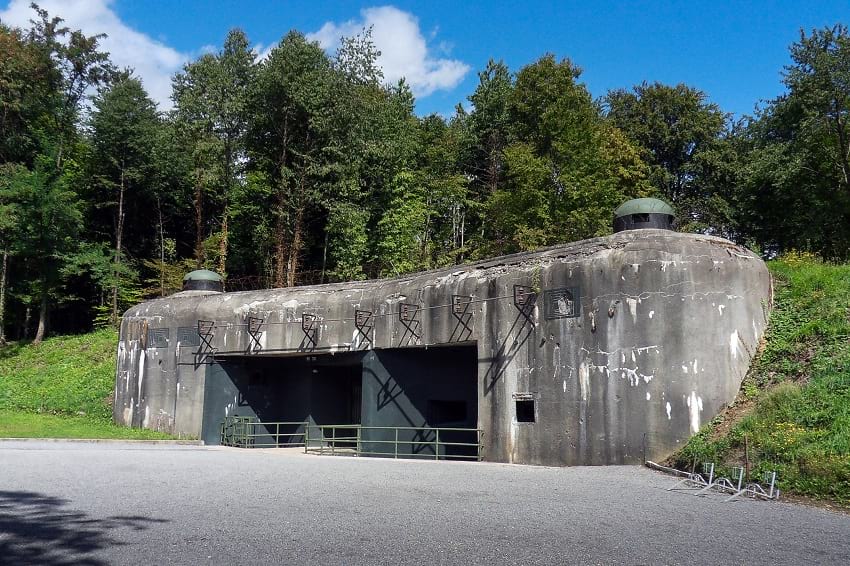
Maginot line in Alsace region, France. (Thilo Parg / Wikimedia Commons / CC BY-SA 3.0)
In great attempts it is glorious even to fail, said Cassius Longinus. The phrase best describes the predicament of France in World War 2. Defeated by Germans in a tooth and nail fight of epic proportions, France surrendered to Nazi forces of Adolf Hitler in 1940. Subjugation lasted till allied forces liberated it from German occupation in 1944. It was a long haul for a militarily deficient France, in which, a defensive wall – Maginot line, constructed along the border, played a key role. It was a saga of astute planning, unflinching courage and exemplary valour. Here is how it unfolded.

André Maginot. (George Grantham Bain collection / Library of Congress)
Similar to the Great Wall of China
Circa 1930. The world was passing through a phase of severe economic depression. Andre’ Maginot, Minister of war, and a disabled veteran of the First World War had a huge responsibility on his shoulders. The responsibility of saving France from Germany – the sworn enemy of France.
A defensive wall, like the great wall of china, was proposed. Wall won’t’s be as long as of china, but it would be fortified with concrete and iron, and would be strategically sited along the border. It would have an underbelly of a military base with all facilities of housing, training and fighting the enemy. The border along the friend countries would be sparsely shielded to project friendly vibes.

A map showing the Maginot line fortification. (Niels Bosboom / Wikimedia Commons)
Security of army personnel was the prime objective
Fortification on the border was a tenable answer to huge loss of life and property suffered on account of repeated invasions of France since ancient times. It was time tested strategy to force the enemy to sideways where it would be trapped and neutralized. Fighting the enemy from permanent trenches, flush with all facilities to thrive, was seen by many as an overly defensive-approach inconsistent with hi-tech warfare of the future. Yet, the proposal was passed. The main reason being the safety of soldiers.
The First World War had claimed the lives of almost 1.4 million in the French army. This was a severe jolt to the French demography and implied huge shortage of future soldiers. Fixed fortification of iron and concrete, it was hoped, would instil a sense of security in soldiers and keep their morale high. Experts warned that in the highly mobile battle scenarios of future, forts would be a drag. But the Government of the day took cognizance of the alarming drop in the human population. Required number of soldiers to defend France would take more than a decade as an entire generation of youth was wiped out in the first World War. Hence the limited size of the army that existed in France had to be guarded zealously and uncompromisingly.
Borrowed name from the chief patron, Andre’ Maginot
The budget required for a continuous, strategically porous defence, was huge. Grossly, the wall would extend from the Mediterranean Sea to the English Channel. It would cost close to 3 billion francs. Andre’ Maginot, the disabled veteran of first world War, then serving as Minister of War, got the proposal passed in the Chamber of Deputies. Hence the protective wall was named the Maginot line. Violation of French territory by the enemy, he argued, would not be allowed at any cost. And the nation, already bankrupt, okayed huge capital for defence fortification, even as the global economic recession made waves.
The wall of concrete fortification was built on the border of France with Luxembourg, Germany, Switzerland and Italy. Border with Belgium was discounted as it was a friendly nation who would call France for help if Germany invaded and the two then would fight the invader together. This, ironically, didn’t happen.
The line was dotted with armoured infantry units
By 1933, construction for the Maginot line was in full swing. Conceived as a defence-in-depth, it was a medley of subways, bunkers, munition hedges, soldier hideouts and shelters. Army pickets were so arranged that the enemy approach could be blocked at multiple levels. Many armoured kiosks could pop-up over the ground, and disappear into the basement on the command of inmate soldiers.


47 mm AC model 1934 cannon, a French anti-tank gun equipped at the Maginot line. (German Federal Archives)

A soldier looking through a periscope in the Fort de Sainghain on the Maginot line, 1939. (Imperial War Museum)
Facilities inside the Maginot line
Behind the primary and secondary rows of defence, was a vibrant underground military base with boarding, lodging, entertainment and training facilities. Community kitchens, Mess halls, hospitals, canteens, mortuary and almost every facility available to civilians over the ground, was made available to the soldiers underground. Electric train, diesel generators, storage for food and ammunition, air conditioning and ventilation systems added to the grandeur of the underground zone. No wonder, adequate provisions and impenetrable security of iron and concrete bunkers boosted the morale of the French army in a big way.

Electrical panels and diesel generators inside Ouvrage Rochonvillers, one of the largest fort of the Maginot line. (Les Bergers des Pierres – Moselle Association)

Internal rail line inside the Maginot line. (© Pascal dihe / https://www.dihe.eu / CC BY-SA 4.0)

Kitchen inside Ouvrage Rochonvillers, Maginot line. (The Shepherds of Stones – Moselle Association)
Some calculations did go wrong
Come 1935 and it was clear that Germany would attack France any day. To the disadvantage of France, regions in the vicinity of two European rivers, Rhine and Saar, became part of Germany. This was not anticipated by France in its fortification drive on borders. Faith in Belgium was another mistake. It was rightly anticipated that Germany would invade France through the Belgium route. It was also hoped that Belgium then, would approach France for a counterattack. But it didn’t happen this way as Belgium declared itself a neutral state. In a damage control exercise, France made frantic efforts to extend Maginot line defences to plug the emerging loopholes. Even Italy became an irritant, and the border with it had to be put on vigil.
German attack overwhelmed France
As France braced up its borders, and stretched the Maginot line in tandem with emerging threats, Germany attacked Poland in 1939. France and Great Britain, going by their treaty obligations to Poland, declared war on Hitler. But the actual war would still take 8 long months. During this time, the two sides remained on red alert, waiting for the other side to attack first. And then, Germany struck all of a sudden as the French procrastinated in their cosy trenches. German Air Force had moved in for a kill. A bomb was dropped on Nancy, the French city. Hit hard, the French army and the British Expediency Force (BEF) were forced to retreat. Holland surrendered to Germany. French and British forces were clearly on the back foot. A small fortification on Maginot line, close to the Sedan town, fell to a determined attack of the German Infantry. Soldiers housed in fortress fought valiantly but lost, and their bunker became their graveyard. The Germans then systematically went about demolishing 6 more targets on the Maginot line.
Some units defied the order to surrender
Reacting to the consistent defeat, the concerned French General – Maxime Weygandordered his troops to withdraw immediately. On the other side, the British army (BEF) too was pushed back by the Germans. The stage was now set for the conquest of Paris. On way, a unit of French soldiers fought bravely. Their concrete fortress was badly damaged in German fire.

The concrete fortification after suffering damage due to enemy attack. (German Federal Archives)
In the night time the damage was repaired and the holed in soldiers readied for another German assault. They refused to lay down arms, even after Paris was taken over by the German army. Enraged Germans surrounded the fortress from all sides and bombed it hard for two hours. Presuming men inside dead or disoriented, Germans neared the target for the final capture. To their horror, soldiers inside the bunker fired with precision, killing or wounding 80 Germans. They came out only upon getting written orders from their superiors, proudly carrying the French Tricolour flag even as they marched to surrender.
Clinching victory was hard for Germans
The remaining French Army along the Maginot line still had a finger on gun-trigger and refused to quit. Their surrender would still take Germans a long haul of artillery shelling. Jules Pelletier, the Commanding Officer of a fort at Hackenberg, announced that he would fight to-the-end. Germans Shelled non-stop for two days but failed to deter him. Disgusted, they moved on to other targets, where too, they faced reverses. It was only when the ceasefire was officially announced that the French defenders came out and walked into the German captivity.
Thus, the Maginot line gave real nightmares to Hitler’s men. If France had not surrendered and commanded its defence forces to lay down arms, the battle would have continued. The French defenders had enough food and ammunition to keep fighting for 3 months. Grit and determination shown by the French army entrenched along the Maginot line was iconic. Their valour was all the more sanguine as it came at a time when the nation’s polity had meekly surrendered to Hitler’s onslaught.
A true memorabilia of French fortitude
Today the Maginot line is a war-ravaged relic keeping alive the memory of French defenders who lived and died for the honour of France in the worst of circumstances. Iron and concrete bunkers damaged in the enemy fire stand as mute testimony to the heroic fight of French soldiers during the Second World War. Many of the battered fortresses have been repaired and renovated for tourist attraction. Visitors are taken on a guided tour of the underground cantonment where the French defenders lived and fought to the hilt for the honour of their motherland. Some fortifications are still being used by the French army. Those that are decrepit and lost to elements still serve to remind us of the men in uniform who in spite of losing a battle, kept their nerve, morale and patriotism intact.
Enjoyed this article? Also, check out “Schwerer Gustav: The Largest Artillery Gun” That Was Built to Destroy the Maginot Line.
Fact Analysis:
STSTW Media strives to deliver accurate information through careful research. However, things can go wrong. If you find the above article inaccurate or biased, please let us know at [email protected].
RELATED
The post Maginot Line: The Mark of French Tenacity and Resilience appeared first on .
]]>The post Development of the Eugenics Movement in the United States appeared first on .
]]>
A tool to measure the skull. (Ilya Varlamov / Wikimedia Commons)
Eugenics is about preserving and improving the genetic stock of dominant groups of human beings. It has played a significant role in the history of the United States, causing people to be ill-treated, ostracized, sterilized, and even put to death. The set of beliefs that gave rise to eugenics are still prevalent, although they are now known by other names to give them a more socially acceptable and politically correct veneer.
The origin of eugenics
The idea of eugenics came to the USA from the UK and Europe.

Portrait of Sir Francis Galton. (National Portrait Gallery)
In the 19th century, Charles Darwin’s theory of evolution caused a huge stir around the world. Influenced by this theory, the geneticist Sir Francis Galton—who was Darwin’s cousin—began to consider the Darwinian concept of ‘survival of the fittest’ in the context of human beings. He studied the British upper classes and surmised that they retained their high social positions due to their superior genetic makeup.
It was proof that if mentally and physically superior human beings intermarried with other mentally and physically superior human beings, their progeny would be at an advantage. And, in the long term, it would lead to a race of superior human beings and, thus, fuel the evolution of the human race.
The proponents of such selective breeding had the Anglo-Saxon, Nordic, and Germanic people as their ideal of genetically superior humans. According to them, only such people had the right to breed and multiply and inherit the Earth.
Eugenics movement in the United States
The US American eugenics movement developed from Sir Francis Galton’s notions of biological determination, and it received wide support from the US government, the US corporations, the US academics, and the US public.

A health certificate issued by Kansas state board of health, certifying that the family has passed the fitter families examination and is entitled to be classified in A grade. December 18, 1920. (Chronicling America: Historic American Newspapers. Lib. of Congress)
The Carnegie Institution, the Rockefeller Foundation, the Harriman railroad fortune, and other well-known corporate foundations were at the forefront of supporting the eugenics movement. They funded research and organizations concerned with eugenics.
The immigration restriction league
The Immigration Restriction League was established in 1884 with the aim of barring inferior races from immigrating to the United States and threatening the superior Anglo-Saxon stock. They wanted to establish a literacy test to determine the intelligence levels of potential immigrants, but US Presidents vetoed such literacy immigration bills in 1898, 1913, and 1915. In 1917, however, the US Congress overruled President Wilson’s veto on the bill.
Eugenics associations

A poster advocating Eugenics. (Wikimedia Commons)
The American Breeder’s Association was established under the direction of the biologist Charles B. Davenport in 1906. Their mission stated that they intended to investigate human heredity traits and stress on promoting superior blood and informing the public about the social menace of inferior blood. The inventor Alexander Graham Bell, Stanford president David Starr Jordan, and the botanist Luther Burbank were some of the notable members of the American Breeder’s Association. The Association paired up with the Immigration Restriction League and established a Committee on Eugenics in 1909.
The same year, with funds provided by J. H. Kellogg, the eugenicists established the Race Betterment Foundation in Battle Creek in Michigan in 1906. Five years later, in 1911, Charles B. Davenport and the American Breeder’s Association established the Eugenics Record Office in Cold Spring Harbour with funds provided by the Harriman railroad fortune and the Carnegie Institution. Along with Davenport, leading US Americans like the psychologist Henry H. Goddard, the conservationist Madison Grant, and the sociologist Harry H. Laughlin were involved with the project.
The Eugenics Record Office set about collecting and recording the family pedigree information of US American citizens. They analyzed the data and drew the conclusion that people from socially and economically backward classes produced unfit specimens. To resolve the social problem of these unfit individuals, the leading intellectuals lobbied to the government for various solutions such as restricting immigration, deporting the unfit, sterilizing the unfit, segregating the unfit, and even exterminating the unfit.
The eugenicists thought such drastic methods were perfectly justifiable for the greater good.
Marriage and sterilization laws
In 1896, Connecticut enacted marriage laws that prohibited epileptics, imbeciles, and feeble-minded people from getting married. The following year, in 1897, Michigan attempted to pass a bill proposing compulsory sterilization for the unfit. However, most of the Michigan legislators refused to vote the bill into law. Eight years later, the state legislators of Pennsylvania passed a sterilization law, but the governor vetoed it.
In 1907, the sterilization bill was first passed in Indiana and became law. Legislators enacted the sterilization legislation next in California and Washington. Other US states soon passed similar laws. These laws were supported by the eugenicists for preventing the unfit from procreating.
It wasn’t until 1924 that the Indiana Supreme Court overturned the sterilization bill. However, in that same year, the US Supreme Court declared that the Virginia Sterilization Act of 1924 was constitutional in the Buck v. Bell case; this was a case concerning the forcible sterilization of a young, mentally slow woman. It was in regard to this case that the jurist Oliver Wendell Holmes infamously remarked that three generations of imbeciles were more than enough. The judgment for Buck V. Bell still stands, and Virginia did away with the compulsory sterilization law only in 1974.
Between 1907 and 1963, over 64000 men and women were forcibly sterilized in the United States. Aside from the mentally defective, many of these belonged to colored, Native American, Asian, and other ethnic groups. Most of these were either not told they were being sterilized or were threatened with the loss of welfare benefits if they didn’t submit to being sterilized. In more recent times, there have been instances of forced sterilization in US prisons.
Euthanasia
The Carnegie Institute recommended euthanasia in a report from 1912 for ridding society of its unfit members. They cited the ancient Spartan method of drowning weak children or letting them die of exposure. Some eugenicists like the New York urologist William Robinson suggested gassing people. From the 1930s and onwards, the eugenicists tried to popularize euthanasia by describing it as mercy killing and portraying it in films, magazines, books, and newspapers. The Illinois Homeopathic Medicine Association supported euthanasia and lobbied to make it legal in 1931, and the eugenicists formed the Euthanasia Society of America in 1938.
Various doctors practised euthanasia by medical neglect, by denial of treatment, or by deliberate harm.
In 1915, in Chicago, Dr. Harry Haiselden, who was the chief of the German-American Hospital’s medical staff, decided that a deformed newborn baby boy was not worth saving and refused to perform the operation that might have saved him. At an enquiry held later, Dr. Haiselden insisted he had made the right decision by letting the baby die. He said: “I should have been guilty of a graver crime if I had saved this child’s life. My crime would have been keeping in existence one of nature’s cruellest blunders.”
At the Illinois Institution for the Feebleminded in Lincoln in Illinois, the staff gave the patients tuberculosis-infected milk and around 40% of the patients died as a result.
Unlike sterilization, incarceration, and marriage prohibition, however, the idea of euthanasia did not catch on with the US public.
Public participation in eugenics
Far from scandalizing the public, the idea of eugenics picked up speed. From 1908, state fairs around the United States organized Better Baby contests and, from 1920, Fitter Family contests. Here, doctors examined the contestants and judged them according to standardized physical and intelligence measurements. The winners were held up as ideal examples of the human race.
The Immigration Act passed in 1924, mostly due to the efforts of the eugenicists who were determined to keep out the inferior stock from eastern and southern Europe, China, and Japan. Eugenics also became part of the curriculum in the leading colleges in the United States. There were around 376 courses on eugenics by 1928.
There were very few critics, like the Mendelian scientist Thomas Hunt Morgan, but their criticism was mostly directed towards the methodology followed by the eugenicists rather than the idea of eugenics itself. Fortune magazine conducted a poll in 1937 and discovered that two-thirds of the respondents thought it was okay to sterilize mentally defective people and 63% agreed with the sterilization of criminals. Only about 15% disagreed with these measures.
In modern times, eugenics has reinvented itself. Since it is no longer acceptable to talk about improving the human race, the focus is now on saving the planet by conserving environmental resources and employing various population control methods.
Enjoyed this article? Also, check out “Ugly Law: When the US Banned Unsightly Individuals from Coming Out in Public“.
Fact Analysis:
STSTW Media strives to deliver accurate information through careful research. However, things can go wrong. If you find the above article inaccurate or biased, please let us know at [email protected].
 Recommended Read:
Recommended Read:
War Against the Weak: Eugenics and America’s Campaign to Create a Master Race | By Edwin Black
Genre:
Non-fiction > History
RELATED
The post Development of the Eugenics Movement in the United States appeared first on .
]]>The post The Great Fire of London: The Blaze That Destroyed 80% of England’s Capital appeared first on .
]]>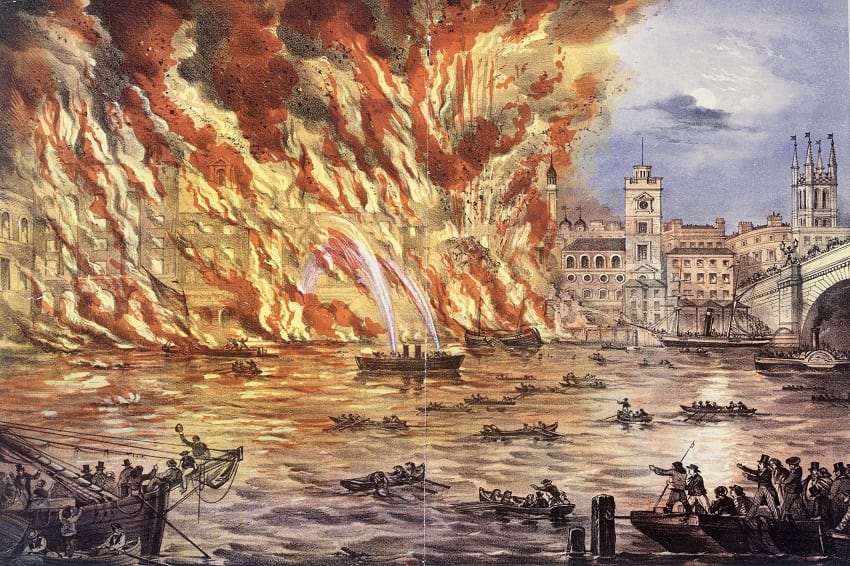
A lithographic print of the great fire of London. (Museum of London)
The infamous Black Death or Bubonic Plague of 1346 transformed the social outlook in England so much that by 1665 more and more people inhabited towns and cities, fueled by the industrial revolution sweeping their nations. When another strain of the plague – the Great Plague – struck London in 1665 it did not kill the millions that the plague of 1346 did due to advances in medicine and hygiene, but estimates conclude that at least 100,000 Londoners perished from the disease. Another tragedy would strike only a year later. The Great Fire of London ravaged the city, feeding on vastly wooden constructs which acted as a tinderbox of destruction within a panicking city. A country at war with the Dutch, the French and the Catholics, several theories and conspiracies arose on who was to blame.
Flammable abodes
Safety standards in England at that time were nowhere near as stringent as they are now. In a society so reliant on fire for industry, lighting and insulation among others, cramped wooden houses were a massive safety issue even though most fires were extinguished quickly before spreading. This was warned by many leading figures alas, there were few alternatives as cheap. These mostly residential buildings were primarily made of oak, separated by straw floors and thatched roofs. There was not much open space between buildings in most parts of the city; narrow streets meant that some roofs even touched across streets.
Sunday, 2nd September 1666
September 1666 was an especially warm, dry month. In the east of the city, near London Tower was a bakery which supplied the Royal Navy biscuits. It was located in Fish Yard, just off Pudding Lane. Shortly after midnight on the 2nd of September, the blaze started and spread quickly due to the warm weather making the wood and straw extremely dry.

Samuel Pepys. (National Portrait Gallery)
One of the best accounts of the terror came from famous writer Samuel Pepys, a Member of Parliament and British Navy administrator. His diary is one of the most famous works in English literature, totalling over 1 million words. Pepys climbed to the top of the Tower of London to which he saw his city burning. He spent much of the next week sailing on the River Thames detailing the path of the fire. The Lord Mayor Thomas Bloodworth was called to the district where the fire started. He would not allow the experience firefighters to destroy buildings in the path of the conflagration because he could not find the owners. He feared reparations from the landlords no doubt.
The fire spread with thousands of people trying to escape the vicinity including via the river Thames. Stores of oil and gunpowder on the banks of the river meant this could be perilous also, and when the blaze hit them it turned into chaos.
People lost hope of putting out the fire as gale-force winds gave oxygen to the blaze. Refugees lined the streets making it difficult for fire-fighting carriages to get through. The destruction was so intense that King Charles II sailed into the city and demanded that buildings be torn down to create a fire break.
Monday, 3rd September 1666
The financial district was hit on Monday, destroying the homes of bankers and the Royal Exchange – the city’s center of commerce. Paranoia and blame set in by this point and with the wind starting setting seemingly random buildings alight, foul-play was suspected. Reports came of foreigners whose nations were at war with England feeding the fire. Eyewitness accounts of grenades thrown into buildings. Many French and Dutch nationals living in England were lynched or their stores looted by the blood-hungry mob. In an effort to stop the xenophobic mobs and quench the fire, King Charles gave the command to his experienced brother the Duke of York. He took the army as well as teams of mercenaries to destroy more buildings – creating a break way. They were said to have rescued many foreigners from the mobs.
Tuesday to Sunday
These methods continued on Tuesday but it was also the day of greatest devastation raising the likes of St. Paul’s Cathedral to the ground. Decreased winds and more fire-breaks meant that finally the blaze looked set to quell. By Wednesday the majority of the damage had been done and the blaze was controlled although it took until rainfall on Sunday before the fire was extinguished and until March the following year until no embers reignited.

Model of a 17th-century fire engine. (Steven G. Johnson / Wikimedia Commons)

Illustration of the 17th-century fire engine in use. (Wikipedia Commons)
Great Fire of London: Arson or accident?
Most believe Thomas Farriner, a local baker accidentally started the blaze, or rather, his maid who cleaned the kitchen. He always denied this, stating that the embers in his bakery were safely cleared from the oven as always. Everyone in the house escaped except for the maid who was the first victim. While Thomas Farriner’s household is believed to be behind the accidental fire there have also been a number of theories, some labelled conspiracy theories for their extremity. Not only after the fire but during it did these theories come to light. The main motives being that England was at war with the Dutch and the French.

A plaque in Pudding Lane commemorating the Great Fire. (Ivory / Wikimedia Commons)
A French watchmaker actually admitted to the crime but it was later found out that he wasn’t even in London at the time. The man was considered mentally handicapped but he was hanged before he could be cleared. Nostradamus, a French soothsayer, predicted that a fire would kill many in London in the year 66.
“The blood of the just will be lacking in London,
Burnt up in the fire of ’66:
The ancient Lady will topple from her high place,
Many of the same sect will be killed.”
The Dutch had a reason for revenge also as the English navy burned a Dutch town to the ground in recent years.
More far-fetched beliefs exist such as a group called the Freemasons – a fraternal organisation–wanting to create a new city. Christopher Wren– a highly acclaimed architect -who rebuilt London was a Freemason after all. Others feel it was a strategy from those in high powers to finally rid London of the bubonic plague. The general belief in London at that period was religious of course, with God punishing Londoners for their greed. The church promoted this reasoning by highlighting that the blaze started in Pudding Lane and ended in Pye corner.
The aftermath
Whoever caused the catastrophe, the end of the destruction claimed no less than 13,000 houses. Less than ten deaths were recorded but experts believe thousands perished as the fire reached temperatures as hot as 1,250 degrees Celsius, enough to burn skeletons. Samuel Pepys described a local park called Moorfield, a site where many of the survivors had gathered (80% of London had been made homeless). It was a heartbreaking sight with swathes of suffering and now homeless people. Temporary accommodations were built but many were not adequate meaning even more would perish in the winter. 25% who left the city for new lives would never return.

This painting shows survivors with their cattle near the Old London Bridge. (Museum of London / Wikimedia Commons)
Christopher Wren was in charge of the city’s permanent restoration which provided the blueprints for the foundations of modern London including a new and improved St. Paul’s Cathedral.
If there is a silver lining to be taken from this tragedy is that although the Great Fire was a catastrophe, it did cleanse the city somewhat. A safer London would be built on the ashes and improvements to the squalor living conditions were made. The remnants of the bubonic plague were wiped out but would return – albeit in lesser numbers – in the not-too-distant future. A cure has since been found. A monument to the Great Fire of London still stands near Pudding Lane, close to where the blaze started.

Monument to the Great Fire of London. (Eluveitie / Wikimedia Commons)
While safety standards have improved considerably, a recent blaze in London (2017) killed 72 people in Grenfell Tower, West London, warning that constant precautions have to be taken when constructing and maintaining buildings. Even then, fires can still spark and spread.

Grenfell Tower fire, 14 June 2017. (Natalie Oxford / Wikimedia Commons)
For more detailed information the Telegraph has a timeline of events on the Great Fire of London.
Enjoyed this article? Also, check out “The Black Death: When Tens of Millions of Europe’s Population Was Killed by the Bubonic Plague“.
Fact Analysis:
STSTW Media strives to deliver accurate information through careful research. However, things can go wrong. If you find the above article inaccurate or biased, please let us know at [email protected].
 Recommended Read:
Recommended Read:
The Ghost Map: The Story of London’s Most Terrifying Epidemic – and How It Changed Science, Cities, and the Modern World | By Steven Johnson
Genre:
Non-fiction > History
RELATED
The post The Great Fire of London: The Blaze That Destroyed 80% of England’s Capital appeared first on .
]]>The post Mansa Musa: The ‘Golden’ Emperor of Mali Who Was Reputedly the Richest Man Ever appeared first on .
]]>
Artistic impression of Mansa Musa and his army. (HistoryNmoor / Wikimedia Commons)
Imagine being so rich in today’s times that the tokens of appreciation and gifts you gave to a country for their generosity could cause an economic meltdown in that nation! Such is the tale of an African king, who lived during the Middle Ages and had so much wealth in gold that none of the richest tech giants, affluent business magnates or monarchs of the modern world could outdo him even today. Mansa Musa I of Mali unarguably remains the richest man of all time to ever live in human history.
Story of Mansa Musa’s life
Although not much is known about his birth, the earliest records state that Musa was born in the year 1280 into a family of emperors. Related to the first muezzin in Islam, Bilal ibn Rabah, Musa was the great grand-nephew and a direct descendant of Sundiata Keita, the founder of the Mali Empire.
He became the tenth king of the present-day West African country of Mali through regency, and his ascension to the throne was not easy. Musa narrated the account of his coronation to a 14th-century Syrian historian Shihab al-Umari, who mentioned it in one of his documents. It is said that when the king before Musa – Mansa Abu Bakr II – renounced his claim to the throne to explore what was west of the Atlantic Ocean in the year 1312, he took along a large fleet of ships and an entourage of slaves with him to satisfy his wanderlust.
But little did anyone know that his second expedition to the edge of the Atlantic would become the last he would ever undertake. He went missing, never to return. Before his voyage, Abu Bakr II had conferred the regency on Musa to make decisions in his stead, until he returned, in the best interest of their kingdom. So when the sultan did not come back from his voyage after a long period of waiting, an urgent need for a Mansa (ethnic West African tribe of Mandinka used the word mansa, which translates to emperor) arose. That is when Musa decided to take over the reins of the Malian kingdom and was coronated as Mansa Musa I.
The flourishing Mali Kingdom under Mansa Musa’s rule
During the mid-1300s, Europe had become cash strapped and impoverished with civil wars breaking out frequently. But the continent of Africa was flourishing and Mansa Musa left no stone unturned to expand the boundaries of his kingdom. Before Mansa Musa came into power, the realm of Mali was already rich in gold supplies. And when he took over in 1312, he became even more powerful and began to conquer the neighbouring territories on the west of the African continent. His kingdom spread a little over than three thousand kilometers and stretched all the way to the coast of the Atlantic Ocean. He seized control over as many as twenty-four African regions, which include the modern-day countries of Mauritania, Niger, Chad Republic, Senegal, Gambia, Burkina Faso and Nigeria and parts of Guinea-Bissau. Documented records state that the Malian Kingdom under Mansa Musa’s rule stood second in size after the great Mongolian Empire.
There was plenty of natural resources in the kingdom and commodities like salt and gold were in high demand worldwide during those days. Renowned Moroccan explorer and scholar Ibn Battuta mentioned in his accounts that only a year of production could yield a tonne of gold in Mali and that is how the empire kept prospering under the reign of Mansa Musa. During Musa’s rule, Mali alone accounted for almost half of the world’s gold. Trade flourished and the historical city of Timbuktu became the most important hub of business during his reign.
Mansa Musa’s historic pilgrimage to Mecca
Mansa Musa was a devout Muslim and in the year 1324, he undertook a trip of over six thousand kilometers to the holy land of Mecca to perform his Hajj and that was when the world came to know of an African king, who was so rich that he made other kings look like paupers. His travel did not come cheap. Mansa Musa travelled for his pilgrimage, spanning the length of the Sahara Desert with a large convoy and a herd of animals that was a sight for the onlookers to behold. Most documents say that he travelled with as many as two hundred thousand men, but the exact numbers have been varying in some accounts.
His retinue included forty thousand soldiers, courtiers, royal officials, entertainers, heralds, twelve thousand slaves and hundreds of camels and horses, along with several flocks of sheep and goats to provide meat on the journey. As many as five hundred servants were in attendance to his senior-most wife. It appeared as if an entire city was on the way to the pilgrimage through the desert. All of Mansa Musa’s courtiers were dressed in fine Persian silks and gold brocade. His slaves wielded gold staffs that weighed approximately 2.7 kilograms each and every single out of the hundreds of camels is said to carry roughly 135 kilograms of pure gold on it.
When Mansa Musa passed through Egypt
While Mansa Musa’s vast caravan was on the way to Mecca, it passed through Egypt’s capital city of Cairo, where such a rare grandeur was on display for the first time ever. It caused mass hysteria, which as per the documents of Shihab al-Umari, eventually led the ruler, al-Malik al-Nasir to summon Mansa Musa. It was mandatory for a visitor to greet the Egyptian sultan by kissing his hands and feet but Musa refused saying he was on his way to perform his Hajj and in no way would he bow down before anybody else but his God. This made the sultan to finally greet him with respect and admiration and the two kings exchanged pleasantries for a while. The Egyptian sultan played the perfect host to Mansa Musa’s entire retinue for a three-month stay.
As the entourage began on their onward journey, Mansa Musa, in a gesture of his humility, gave away gold to people as gifts. He even flooded the markets with gold dinars purchasing local and foreign commodities. Although gold was in short supply in Cairo in those days, Musa’s generous gifts in gold led to the value of bullion dropping very drastically. His well-intentioned donations led to a cash catastrophe. The depreciation of the precious metal caused a massive financial crunch and the gold market crashed. When Mansa Musa returned from his pilgrimage and passed through Cairo again, he tried to help Egypt recover from the meltdown. He took away some of the gold from circulation by borrowing it for an exorbitant interest rate, yet it took a little more than a decade for the desert country to get back on its feet.
Mansa Musa’s significant contribution to Mali
A generous man, offering to charity at every opportunity, Mansa Musa, on his return trip to Mali from Mecca, purchased lands for his men to stay. He acquired lands in Gao, a territory in the Songhai kingdom, where he commissioned the building of mosques, palaces and audience chambers. Apart from wealth and power, he sought knowledge and brought back Islamic scholars and poets to spread the word of God in his kingdom. Mansa Musa also allowed individuals to practice their own faith and never forced his religion on his people nor was he in favour of conversions. As his empire kept expanding with time, he separated all the territories under his rule and divided them into provinces, appointing governors to oversee them, who reported back to him.
From his travel, he also brought back an Andalusian architect named Abu Ishaq Ibrahim Al-Sahili to build study centres and mosques in Timbuktu. This architect from Granada in Spain went on to construct the iconic Djinguereber Mosque in 1327, which is still standing tall and serving its purpose for a little close to seven hundred years. For this masterpiece, Mansa Musa is said to have paid 200 kilograms in gold to Abu Ishaq, which in today’s times would be approximately equal to 8.2 million US dollars.

Djinguereber Mosque. (JM / Flickr)
Mansa Musa urbanized Timbuktu and commissioned construction work of libraries, schools and art centres. He is also credited as the first person to encourage traditional education in West Africa. Timbuktu became an educational center and students from all over the world came to study at Mali during its golden period.
Mansa Musa I of Mali reigned for about 25 years and died in the year 1337, leaving its reins to his son Mansa Maghan I. But the stories of his great fortune still come as a surprise.
Enjoyed this article? Also, check out “Hetty Green: The Richest American Woman Who Was Known for Her Extreme Miserliness“.
Fact Analysis:
STSTW Media strives to deliver accurate information through careful research. However, things can go wrong. If you find the above article inaccurate or biased, please let us know at [email protected].
RELATED
The post Mansa Musa: The ‘Golden’ Emperor of Mali Who Was Reputedly the Richest Man Ever appeared first on .
]]>The post The Manhattan Project: The Making of the First Atomic Bomb appeared first on .
]]>
“Fat Man” atomic bomb on a trailer, produce as part of the Manhattan Project. (War Department)
The Manhattan Project was a joint effort between the U.S government and the industrial and scientific organizations during World War II to develop a fully functional atomic weapon. Unlike the region of New York on which the project was named, this controversial creation was actually developed in Los Alamos, New Mexico.
One of the most prominent reasons for the evolution of this project was the fear that German scientists had been working on the development of nuclear technology since the 1930s and Adolf Hitler was in favour of using it.
The declaration of war

Franklin D. Roosevelt, 32nd U.S. President. (FDR Presidential Library & Museum / Flickr)
In the year 1938, the discovery of the nuclear fission by the German chemists Otto Han and Fritz Strassman made an atomic bomb a possibility, at least theoretically.
When the U.S intelligence reported that the scientists working for Hitler were on their way of developing a nuclear weapon, President Franklin. D. Roosevelt set up the agencies that led to the Manhattan Project in the year 1939.
First, Roosevelt formed an Advisory Committee on Uranium, where a highly skilled team of scientists and military officials took it upon themselves to thoroughly research the potential of Uranium as a weapon.
Once the research was concluded, the U.S Navy gave $6000 to Columbia University for research, and a substantial sum was spent by Enrico Fermi and Leo Szilard on the purchase of graphite, which is used as a neutron moderator in nuclear reactors. A team of Columbia professors, including Fermi and Szilard, then created their first nuclear fission reactions.
Later in 1940, the name of the Advisory Committee was changed to the National Defense Research Committee, which in 1941 was renamed to Office of Scientific Research and Development (OSRD), and Fermi was part of it.
The same year, the Pearl Harbour was attacked by the Japanese force, which led to U.S joining the World War II with Great Britain, France, and Russia to fight against the Germans and the Japanese troops.
The birth of the Manhattan Project
In 1942, the OSRD came up with the Manhattan Engineer District in New York City, which was led by U.S Army Colonel Leslie R. Groves.

Enrico Fermi (left) and Leo Szilard (right). (Wikimedia Commons)
At this time, Fermi and Szilard were still very much involved in the research and were concentrating on the nuclear chain reactions. However, instead of Columbia, now the research had shifted to the University of Chicago where the were able to produce Uranium-235 successfully by enriching Uranium.
During the same time, scientists like Glenn Seaborg were able to isolate minute samples of pure plutonium. Plutonium is a radioactive chemical element, which was first produced in 1940 at the University of California, Berkeley. Meanwhile, the Canadian government and its military were conduction nuclear research at various sites in Canada.
Finally, on December 28, 1942, President Roosevelt put all the forces together, naming them the Manhattan Project and their sole purpose was to create nuclear power. Several facilities were set up in remote locations, such as New Mexico, Tennessee, Washington, and even Canada.
Los Alamos Laboratory
In 1943, theoretical physicist J. Robert Oppenheimer was named the director of the Los Alamos laboratory, which was located in New Mexico. At the time, Oppenheimer was already working on the concept of nuclear fission. The inception of the Los Alamos laboratory was called Project Y, and this is where the Manhattan Project bombs were developed and tested.

Seconds after the explosion of ‘Gadget’ over Trinity. (United States Department of Energy)
On July 16, 1945, the scientists from the Los Alamos laboratory detonated a plutonium bomb at their test site in New Mexico. The place was named Trinity by Oppenheimer, and when the bomb finally exploded, it was enveloped by a humongous mushroom cloud, which was almost 40,000 feet wide. The power was equal to 21,000 tons of TNT, and this bomb completely erased the steel tower on which it was placed. This marked the beginning of the atomic age.
The scientists developed two different versions of the bomb. One was a Uranium-based design known as “The Little Boy” and the other a plutonium-based weapon called “The Fat Man.” These bombs played a significant role in ending World War II.
The Potsdam Conference
In 1945, the Germans had undergone significant losses, prompting their surrender. But, the U.S Military was under the impression that the Japanese would fight a bitter fight and not give up so easily.
This called for The Potsdam Conference on July 26, 1945, in Allied-occupied city of Potsdam in Germany. This is where the U.S gave their ultimatum to Japan, asking them to surrender, agreeing to the terms of the or face the consequences.

Prime Minister Winston Churchill, President Harry S. Truman, and Soviet leader Josef Stalin at the Potsdam Conference. (National Archives and Records Administration)
And, one of the clauses of the agreement was for the Japanese to form a new democratic and a “peace-loving government”. However, the ruler of Japan was not in favour of the agreement as there was no role for him in the future.
Hiroshima and Nagasaki
During the same time, the leaders of the Manhattan Project concluded that Hiroshima in Japan was an optimal target as the area was an important military base and also because of its size.
They decided that to ensure that the Japanese surrendered, the technology tested by the Los Alamos scientists in New Mexico was essential here. Although they had no surrender agreement, on August 6, 1945, the Enola Gay bomber plane dropped their untested “Little Boy” approximately 1900 feet above the city.
This led to utter destruction and death. Three days after the first bomb, with still no surrender, “Fat Man” was dropped above Nagasaki on August 9th. On August 14th, 1945, the Japanese finally surrendered.
Enjoyed this article? Also, check out “Demon Core: The Deadly Plutonium Core That Killed Two Physicists at Los Alamos National Laboratory“.
Fact Analysis:
STSTW Media strives to deliver accurate information through careful research. However, things can go wrong. If you find the above article inaccurate or biased, please let us know at [email protected].
 Recommended Read:
Recommended Read:
The Making of the Atomic Bomb Paperback | By Richard Rhodes
Genre:
Non-fiction > History
RELATED
The post The Manhattan Project: The Making of the First Atomic Bomb appeared first on .
]]>The post Franz Reichelt: Dressmaker Who Jumped off the Eiffel Tower Experimenting with Self-Designed Parachute-Suit appeared first on .
]]>
Franz Reichelt with his designed suit. (Wikimedia Commons)
Franz Reichelt was an Austrian born tailor who owned a successful dressmaking business in the middle of Paris. He was born in Austria in 1879 and moved to France in 1899, eventually obtained French citizenship in 1909. At some point, he got obsessed with the idea of human flight, particularly with the idea of a wearable parachute for pilots.
He started experimenting with several designs of parachute-suit around 1910. The available parachutes at that time were parachutes with a fixed canopy meaning they were designed on rigid frames to stay open even before the jump. Thus, he took it upon himself to develop a suit that pilots could wear that would double as a parachute.
It was supposed to help them get out of crashes uninjured as no such lifeline was available for aeronauts at that time. Reichelt had a few successful trials with dummies that he threw from the 5th floor of his apartment building. Some of these dummies didn’t fall but touched the ground lightly. The task of converting the prototype from these trials into a working and wearable parachute turned out to be a herculean task for him.
The initial design weighed a massive 70 kilograms and was made from 6 square meters of material. He was firm he was on the right path, and he once presented his design to La Ligue Aérienne at the Aéro-Club de France. Unconvinced with the viability of the design of his parachute (citing the weakness of the canopy and the massive size) the club rejected even any possible testings of the suit. The club even tried discouraging Reichelt from spending any more time on his design. Undeterred by the rejection, he kept tinkering with his design and did not give up.

Franz Reichelt posing for a photo with his parachute. (Agence De Presse Meurisse / Wikimedia Commons)
Trials and improvements
A series of unsuccessful experiments employing dummies followed. He was eventually able to reduce the weight of the suit even after doubling the surface area of the material bringing it down to around 25 kilograms.
He is said to have jumped wearing the suit himself from heights of about 8 to 10 meters. One of those trials even led to a fractured leg. After many unsuccessful attempts, Reichelt still refused to see any fault in the design. He was convinced that if the experiments were conducted from higher elevations they definitely would have been successful.
In a bid to try to conduct the trials from a higher elevation, Reichelt started petitioning the authorities for permission to conduct them from the Eiffel Tower. He was granted permission to do so in early February 1912.
The deadly gamble
On the day of the jump viz. February 4, 1912, Franz Reichelt arrived at the Eiffel Tower already dressed in his suit strutting about for cameras of the press. The press wrote about the suit that it was “… only a little more voluminous than ordinary clothing …” (“… un peu plus volumineuse qu’un vêtement ordinaire …”) The extended parachute was described as “a sort of cloak fitted with a vast hood of silk” (“une sorte de manteau, muni d’un très vaste capuchon de soie”). He himself had invited the press to demonstrate his experiment. Little did he know he was giving them an even more compelling story to write.
Before climbing on to the Eiffel Tower, the tailor went around inspecting the arrangements at the site of his experiment, in order to avoid any mishaps. Without anyone’s knowledge, he prepared to make the jump himself. When he stepped on the ledge, friends who accompanied him tried convincing him to first throw a dummy to see if the suit actually works. He wouldn’t hear it. The people representing the city authorities were confused because they were not expecting Reichelt to make the jump himself. Everybody was anxious about this going badly. Even the weather seemed to be giving a warning as the winds started to pick up the pace that cold morning.

Franz falling from the Eiffel Tower. (Agence De Presse Meurisse / Wikimedia Commons)
Death of Franz Reichelt
Franz Reichelt finally stepped off the ledge and just kept plummeting through the air crashing into the frozen ground within a matter of seconds. The parachute never opened. The newsreel from that day showed people looking in horror and shock as the lifeless tailor is carried out of there. The police can be seen measuring the dent he had made on the ground for investigative purposes.

The aftermath of the fatal jump. Police recover the damaged parachute. (Wikimedia Commons)
Had he lived in our day and age where information travels faster than light, he would have known his death was in vain. Just two days prior to Reichelt’s jump, an American parachute enthusiast, by the name Fredrick R. Law, had made a successful jump from the Statue of Liberty with a wearable parachute.
Enjoyed this article? Also, check out “Thomas Midgley Jr. – The Scientist Who Almost Destroyed the Planet without Knowing“.
Fact Analysis:
STSTW Media strives to deliver accurate information through careful research. However, things can go wrong. If you find the above article inaccurate or biased, please let us know at [email protected].
 Recommended Read:
Recommended Read:
How to Fly a Horse: The Secret History of Creation, Invention, and Discovery | By Kevin Ashton
Genre:
Non-fiction > Science & History
RELATED
The post Franz Reichelt: Dressmaker Who Jumped off the Eiffel Tower Experimenting with Self-Designed Parachute-Suit appeared first on .
]]>The post Schwerer Gustav: Why the Largest Artillery Gun Turned Out to Be a Flop During World War II? appeared first on .
]]>
Adolf Hitler (second from right) and generals watching the Schwerer Gustav. (Nazi Germany official press photograph)
Once bitten, twice shy. This was true of Hitler, the infamous dictator of Germany. He served in the army of Bavaria (which became part of Germany in 1919) in World War 1 (1914-1918). When the Allied forces (France, Great Britain, Russia, Japan, Italy, Russia and the United States) defeated Axis powers (Germany, Austria-Hungary, and Turkey), Hitler felt devastated. World War II (1939-45) happened as a natural consequence of World War I. Hitler, by then, became the dictator of Germany, and longed for revenge. He conceived the idea of a really big cannon, Schwerer Gustav. One, that could demolish the Maginot line – a concrete fortification built in France. But the destiny unfolded otherwise. Hitler, and the big gun, both met a tragic end.
Behemoth of a gun
Schwerer Gustav, the Artillery, was a huge cannon designed by the Krupp company, a German steel and arms manufacturer. Work for the fabrication of the big gun began in 1930. The gunfire, ordained Hitler, must have the capacity to rip through 1- meter thick layer of steel, or 7-meters of reinforced concrete. The artillery, when finally commissioned, weighed 1344 tons and fired a 4.8 metric ton projectile at a distance of 48km, with a speed of 820 meters per second. The design of the cannon was approved in 1937. The spring of 1940 was set as the deadline for the rollout. But the deadline couldn’t be kept. In Hitler’s scheme of things, this gun, named Schwerer Gustav, would be the be-all and end-all of his victory in World War II.
Designed and produced by arms manufacturer Gustav Krupp
Hitler invaded Poland in September 1939, this triggered the start of second world war. Schwerer Gustav, the giant cannon couldn’t be delivered on expected time, the spring of 1940. Luckily, the delay was no handicap, because, the war plan was altered in a big way. Maginot Line, which was the reason behind the big gun concept, was ignored. In the changed plan, the Germans invaded France through a different route, i.e. Belgium. By the end of 1940, the cannon was ready. It was test-fired in 1941 in the presence of Hitler. Seen as a gift from Gustav Krupp, the arms manufacturer, the cannon was named Schwerer Gustav. Schwerer in German means ‘heavy/great’. Another gun produced along with it was named Dora.
Schwerer Gustav was used in the war in 1942, with satisfactory results
The big cannon was deployed for action in the siege of Sevastopol, Ukraine, on July 1942. A men-force of 1420 took 3 weeks to assemble the big gun. In ready-to-fire mode, the artillery was 43 meters long and 7 meters wide. The inside diameter of the gun barrel was 80 cm. The axis of the barrel was positioned well over 7.5 meters above the ground base of 4 railway tracks (hence the name railway gun). The gun fired 300 shells on the city of Sevastopol, causing significant damage in the enemy camp. Another remarkable hit was at the undersea ammunition magazine of Soviet Naval base in Severnaya Bay. The ammunition magazine was kept 100 feet below the seafloor and topped over with 30 feet of concrete. Gustav’s 9 fires not only devastated this difficult target but also sank a ship that strayed into the firing range.

The Schwerer Gustav railway gun in the Soviet Union, 1941. (Nazi Germany)
Dora, the sister cannon was deployed against the Stalingrad city in Southern Russia. But as the Russian force closed in, it was hastily withdrawn and wrecked to prevent its use by the enemy.
Massive frame of the cannon was hard to move and operate
The Germans realized soon enough that the mammoth size of artillery made it an easy target for aircraft of the Allied forces. Dedicated railway tracks had to be put up for the movement of the heavyweight Schwerer Gustav. The tracks had to be laid in advance at strategic places in the battle zone. A good length of supplementary track was also required to position the gun for the kill. From the firing position, the cannon could fire only in up and down directions, not sideways. For firing sideways, to the left and the right, a curved extension was mandatory. To operate the gun, a team of 2000 men was required. Most members of the team were engaged in giving air cover to the cannon.

The Schwerer Gustav canon in position to fire. (Nazi Germany)
Assembling the gun into functional form was an arduous task. It took 4 days to assemble the 5 principal components of the artillery, and fit them into working posture. Calibrating the gun also took several hours to complete. Thus, the gun could fire only 14 rounds in a day. The delivery on the battlefield was little compared to the huge operating expenses of the weapon. No wonder, Germans abandoned the Gustav Gun within a year of using it. The gun, verily the largest ever in the history of mankind, was destroyed before the world war ended in the year 1945. This was done to prevent it from falling into enemy hands. Some sources say Russians seized the cannon and disassembled it. Some say Russians took away remnants of the gun already trashed by the Germans.

Men loading shell in Schwerer Gustav. (Nazi Germany)
So, did the big gun make a difference to the outcome of World War II?
Surely not. Built at a whopping cost of 10 million German Reichsmarks, its output, in the overall war scenario, was lacklustre. All it did was to demolish a slew of Polish and Soviet defences. It may have been a psychological boost to Axis forces for some time, and a possibly a fear factor for the Allied forces. But at the end of the day, Gustav gun was more of a liability than an asset. The amount of money spent on its production and operation was too huge for its constrained application and performance.
Hitler, obviously, was so seized by the idea of the mega gun that he thought little about alternatives. Perhaps a more manoeuvrable and manageable weapon system would have been a better choice. Experts believe that the adoption of jet-engine aircraft, rocket technology and nuclear weapons would have stood Germany in better stead. The giant gun was no match to the speedier and more accurate fighter aircraft of the Allied forces. Aircraft could carry bombs and explosives much heavier than Gustav gun could fire.
What if Hitler had planned better, and won World War II? The hypothetical question Keeps doing round time and again. But the fact remains that fate of war rests on tactical planning and easy-to-use weapons. Hitler, seemingly, lost on both these counts. Warfare technology had changed significantly in the decade that fell between the 2 World Wars. Schwerer Gustav, though unique and powerful, was behind the contemporary technology in many ways and hence failed.
Enjoyed this article? Also, check out “Hindenburg: The Tragic Death of World’s Biggest Commercial Airships“.
Fact Analysis:
STSTW Media strives to deliver accurate information through careful research. However, things can go wrong. If you find the above article inaccurate or biased, please let us know at [email protected].
 Recommended Read:
Recommended Read:
Superguns 1854-1991: Extreme artillery from the Paris Gun and the V-3 to Iraq’s Project Babylon | By by Steven J. Zaloga (Author), Jim Laurier (Illustrator)
Genre:
Non-fiction > History > Military
RELATED
The post Schwerer Gustav: Why the Largest Artillery Gun Turned Out to Be a Flop During World War II? appeared first on .
]]>The post Ivan the Terrible: The First Tsar of Russia and His Reign of Terror appeared first on .
]]>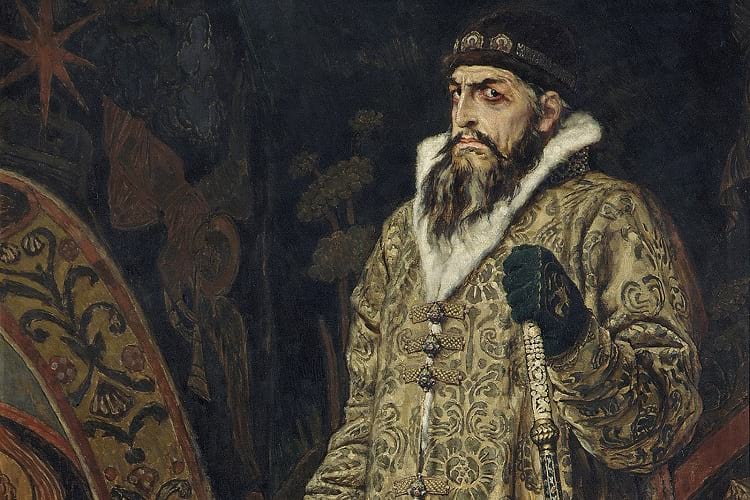
Painting of Ivan IV Vasilyevich more commonly known as Ivan the Terrible. (Tretyakov Gallery / Wikimedia Commons)
Russia has a fascinating history, akin to the likes of book and television series Game of Thrones in terms of many ruthless families vying for power and promoting their right to rule. One such family was that of Tsar Ivan IV, more commonly known as Ivan the Terrible. To continue the Game of Thrones comparison, he would represent the Mad King, or rather vice versa. Needless to say, it would not be a surprise if Ivan inspired the Mad King character. It must be noted that the moniker Terrible follows a more archaic meaning, as in to evoke terror. As opposed to the more modern meaning, of defective or bad. For Ivan the Terrible evoked terror in many people.
Background
By many accounts, Russian history began in 882 ACE, with the historical state of Kievan Rus initiated in Kiev – the capital of Ukraine – as it still stands today. This is a major reason why political and civil unrest persists between Ukraine and Russia. The Ukrainian governments have even insisted recently that the capital be Latinized and known worldwide as Kyiv (the Ukrainian way) as opposed to Kiev (the Russian translation.) Border disputes and protests still persevere with some Ukrainians wanting to be part of Russia, and some wanting to stay. Not to mention the matter of being a member state of the European Union.
The most accepted theory today is that Rus was created by Vikings, or the Varangians as the Slavic people call them. Widely recognized to be tribes from Sweden were commissioned to sail down the countless rivers snaking from the Baltic Sea into Rus. With the Slavic lands in disarray a Viking king called Oleg came to restore order, taking over and uniting many Slavic and Finnish tribes under one banner. He became ruler of Novgorod (a nearby city) in 879 ACE, succeeding a prince called Rurik, another Viking who had already established control of many regions including Novgorod which he ruled since 862. Oleg seized Kiev three years later in 882 ACE. The seeds had been planted for the Rurik Dynasty to dominate by this point which would last until 1598, compromising Kievan Rus and Muscovy (later named Moscow). It would have many famous and infamous rulers such as Alexander Nevsky, Ivan the Great alongside his cursed grandson Ivan the Terrible.
The early life of Ivan the terrible
Ivan Vasilyevich had a tumultuous early life which could be common for royal children of that time if they did not have strong family connections or if disaster struck. This was the case for young Ivan whose father died of an infected abscess when Ivan was three, and his mother died when he reached eight (many believe she was poisoned by ambitious family members).
Here began accounts and hearsay of Ivan as a disturbed and torturous individual. There are many sources for these but none are confirmed meaning much of it is still conjecture. Alas, based on his future acts there is perhaps a hint of truth in these horrors. He was said to torture animals, throwing them out the windows of the Kremlin. Later in life, there are reports that he used to beat, rape and hunt people. Even gouge out the eyes of talented architects who made beautiful structures for him so they would not be repeated again.
When his father passed Ivan was made the Grand Prince of Moscow yet his mother acted as regent during this time, controlling the nation on behalf of young Ivan. After her death, many Boyars (an elite class of families in high positions) strived for power, reportedly with many of their own interests at heart. At sixteen, in January 1547, Ivan was crowned the Tsar of Russia. He would be the first to hold this position as he created it. Taking the word from the Roman Caesar, the ambitious Ivan IV maintained that Russia would be the Third Rome.
To find a suitor for the young Tsar, at this time it was common to conduct a bride show, with up to 1500 daughters of noble families brought to court for the ruler to choose. Ivan IV chose Anastasia Romanovna – a famous name (Romanov) which would become more famous as it brought an already wealthy and powerful family, into more power and wealth. She held the title of the first Tsarina.
Early tests
In the summer of 1547, months after his coronation a fire would spread through the Russian Capital of Muscovy. In those times most buildings were made from wood which proved highly flammable when such an accident or arson attack occurred. The cause was never established but a political rival of the Tsar’s family – Yuri Glinsky – was accused of starting the blaze to cause upheaval in the Tsar’s kingdom. He was stoned to death. His family would later be removed from the government three years later by the spiritual leader of Russia – St. Macarius Metropolitan, further strengthening the position of Ivan. The Metropolitan is the head bishop, having authority over all bishops of an area such as Muscovy (mostly in Christian, and Orthodox churches) – he was very close to Ivan IV. The church and state continue to operate closely in many countries nowadays, arguably none more so than the Russian Federation.
Ivan set up his own council of advisors from the high-class families of Moscow. His advisors would consort with him regarding policy changes, the main ones being self-government in rural regions, improvements to tax collections and reforms in church and state. He improved the Sudebnik in 1550, a code of nationwide laws first founded by his grandfather. He also enlisted the first Streltsy – a permanent, standing army – who are still employed in the present day. The Moscow Print Yard was set up by Ivan in 1553 which seems an incredible endeavour and advancement. But tell that to the scribes of Moscow who were losing work fast. They tried to burn down the building and extort Russian printers, forcing some to flee the capital.
In terms of Foreign Policy, the Mongol Hordes were the biggest threat to Russia and Europe, made famous by the likes of Attila the Hun. Even after the decline and break-up of the Golden Horse their former lands were split into Khanates which proved rivalrous to Russia. They ruled the lands of Kazan and Astrakhan until Ivan defeated them in battle. One of the most famous structures in the world, let alone Russian, was commissioned with St. Basils Cathedral, to signal these victories and the conquering of the city of Kazan. He would not have the same success against another main rival in Lithuania to the west. Access to the Baltic Sea was demanded but they could not break through the federation of nations protecting it. In terms of trade, Ivan was happy to do business with England, opening up the White Sea port of Arkhangelsk to them. They would persistently maintain a close relationship with Great Britain in the centuries to come.
Ivan’s thirst to conquer the lands of Siberia turned successful when a rich family called the Stroganovs funded the expedition. They hired Yermak Timofeyevich – a Cossack (Eastern Slav) – who brought the stretching steppe under the red of Russia. Of course, much of Siberia was and still is uninhabited; the imperialism was simply in name, with tribes such as the Nogai Horde (a Turkic and Mongol diaspora) pledging allegiance.
Ivan’s secret police
When things started to go wrong for Ivan politically he abdicated in 1564. This was after several pitfalls which when combined plunged Russia into economic disparity. Drought and famine ensued because of defeats in war, invasions by the revenge-seeking Mongols, not to mention sea blockades by rival nations. Even the Ottoman Empire in the south became another thorn in the wilting rose, who would raid Russia for slaves as did the Crimean Khanate. The boyars pleaded for the Tsar to return to Moscow and he did so only after being granted absolute power of the Moscow region, the right to do so becoming known as the Oprichnina. This allowed him to create a secret police-come-bodyguard division known as the Oprichniki to keep the peace and protect his family.
Dressed in all black, riding jet-black horses they terrified the residents of Russia particularly when Ivan started to exhibit signs of madness. His dear wife, Anastasia Romanova was presumed poisoned in 1560 which is said to have been a driving force in the degeneration of the Tsar. Forensic autopsy uncovered a high level of Mercury in her bones (more so than common cures of the time would leave) to possibly prove this. Defection to Lithuania by many of his advisors led to more paranoia and distrust.
A thousand strong at its onset the Opichniki were based in Novgorod. They were headed by a ruthless character called Malyuta Skuratov who even killed a Metropolitan named Phillip on orders from his Tsar. Their wages were more than handsome as they looked to battle corruption and treason among the elite families which Ivan suspected of usurping him. He deliberately picked members from the low classes of Russia and even from other nations meaning they had no links to the Boyars and were loyal to him only. Their banners displayed a severed dog’s head.
A famous text written in Old Russian (used between the 15-20th Century) describes the massacre of Novgorod on orders from Ivan IV who led the battalions with his heir apparent Ivan. He believed conspirators to be rotting the core of the historic city. A plague had already struck the land with hundreds dying daily but more tragedy would arrive. Theorists blame the Oprichniki for taking too much from the peasants, as well as Russia’s doomed wars, including the Livonian War with their old enemy Lithuania among others.
Up to 60,000 people were executed in Novgorod; many tied to carts and wheeled into the Volkhov River for alleging to conspire against the Tsar. Many others were deported. With more research, it seems the numbers were significantly lower but the extermination and even pogroms did occur meaning Ivan’s madness was spiralling out of control.
Ivan the terrible and his son Ivan
By the end of Ivan’s reign, Russia was struggling economically. It would be a prelude to the Time of Troubles which plunged the Rurik Dynasty into disarray by the time Ivan’s son Feodor ascended the throne. Ivan started having vicious outbursts in court. He would imprison and torture countless people he believed to be traitorous, mostly Boyars. This sustained in his private life as accounts tell that he beat-up his daughter-in-law, due to a clothing disagreement. He then killed his son and heir Ivan when confronted about the attack, hitting him with as sceptre yet showing remorse immediately after. But these accounts may be exaggerated again, possibly lies from the elite looking to displace the Tsar. On the other side, Ivan was a devout follower of Orthodoxy, a representative of God – to the point that the punishments he administered were considered just to him if his victims had sinned.

Ivan after he killed his son; painting by Ilya Repin. (Tretyakov Gallery)
Whether true or not, it plunged Russia into uncertainty and jeopardised the Rurik Dynasty. It was said Ivan’s namesake Ivan Ivanovich was the only viable heir as his other son Feodor had mental and physical problems. A regent ruled for Feodor until he passed childless to finally end the Rurik Dynasty in 1598.
The death of the Tsar
On March 18, 1584, Tsar Ivan IV met his end due to a stroke while playing chess. Rumours heightened that a murder was behind it but Soviet scientists who excavated the grave found that Ivan IV died of natural causes.
While Ivan IV had obvious success with political reform and transformed Russia in many ways his psychotic methods (however exaggerated)– even for the time – is why he will never shed the moniker of Ivan the Terrible.
Enjoyed this article? Also, check out “Rasputin, Faith Healer? Or Lustful Charlatan?“.
Fact Analysis:
STSTW Media strives to deliver accurate information through careful research. However, things can go wrong. If you find the above article inaccurate or biased, please let us know at [email protected].
 Recommended Read:
Recommended Read:
Ivan the Terrible: A Captivating Guide to the First Tsar of Russia and His Impact on Russian History | By Captivating History
Genre:
Non-fiction > History
RELATED
The post Ivan the Terrible: The First Tsar of Russia and His Reign of Terror appeared first on .
]]>The post Ancient Pyramids of Sudan from the Nubian Empire appeared first on .
]]>
Nubian pyramids, Meroë. (Christopher Michel / Flickr)
In modern Sudan, Africa lies the remnants of a powerful, ancient civilisation known as Nubia or the Nubian Empire. They are still represented in a series of pyramids known as the Nubian Pyramids of Sudan. Nubia is the oldest known civilization in Africa dating as far back as 2500 BC, home to several empires, the most famous of which being that of the Kingdom of Kush.
Another dominant civilisation in Africa – the Egyptian Empire – lasted for a longer time however and this is a major reason why less is known about the Nubians. There are not as many artefacts nor archaeological sites which have been uncovered. An example of this is in the famous pyramids in Egypt, for example the Great Pyramid of Giza. While Nubia have their own monuments they are not as famous nor as well visited as their neighbours.

The pyramids from a distant. (Valerian Guillot / Flickr)
The Kingdom of Kush
Not to be mistaken with the mountains of Pakistan or Afghanistan, these pyramids are in the ancient city of Meroe, 200km from Khartoum, Sudan. Meroe was the capital of Kush at the time of the construction of the pyramids. They were able to flourish as a civilization especially in times when they were independent from Egypt’s rule and living in relative peace. Economy boomed when this was the case as the Nubians lived off the land and mined many different types of ore, most notably gold. It allowed them to oversee over 200 pyramids alongside palaces with grand, exuberant designs. A prominent feature of the Nubian way of life was their legendary female rulers. This was different to many male-driven, patriarchal societies of the time. It was common for these female rulers to be buried with their bow and arrows, along with intricate stone rings which helped when drawing back the bow.
Kush became so strong that it eventually turned the tables and conquered Egypt under a king called Piye, around 730 BCE. This would start Egypt’s 25th Dynasty of rulers and unlock the mystery of there being Black Pharaohs – as in the colour of their skin – which was shown in many artefacts and writings. This dynasty lasted between c. 770 – 656 BCE and King Piye would be entombed within one of the Nubian Pyramids as tradition dictated. Yet the dynasty was put to an end when assaulted by Assyrians and later Kush was driven into the southern lands to a city called Napata by the time the 26th Dynasty of Egypt occured.
The Pyramids of Sudan

Aerial photo of the pyramids of Sudan. (B N Chagny / Wikimedia Commons)
Over 8,000 miles from the pyramids of Giza in Egypt stands another masterpiece of construction and architecture. Although a UNESCO World Heritage Site they are not so well known compared to other wonders of the world due to their geographical location mainly. The biggest pyramid of Giza is 756 feet while the tallest in Sudan are no more than 90 feet. There are over 350 pyramids in Sudan and most were built anywhere from 720-300 BCE to 350 ACE, over 2,000 years after the miracles in Egypt. The Nubians adopted many aspects of Egyptian life such as language and religion as well as the style of pyramids.
Nubia’s pyramids are different to the iconic ones of Egypt. They more resemble those built in the New Kingdom Period of Egypt (1539-1075 BCE) which was when the Nubians began to strongly assimilate Egyptian culture. The most famous ones are present at the ancient site of Meroe. Every pyramid has steps to the east which lead to the sealed entrances. This is different to the Egyptian temples where the doors face north but the reason why is still to be ascertained.
Egypt’s temples are almost perfectly aligned to the four cardinal points – North, South, East and West. There are several theories existing which believe the Egyptians used the sun and moon to do so, based on the Fall Equinox. This is where the sun lines with the Equator, with the length of day and night being the same for one day. It is not known the reasoning for the positioning of Nubia’s monuments but it is likely something more than meets the eye. Website Live Science explains the theory behind Giza’s positioning.
“The builders of the Great Pyramid of Khufu aligned the great monument to the cardinal points with an accuracy of better than four minutes of arc, or one-fifteenth of one degree,”
But as explained by Live Science, there are not any concrete explanations.
“The Egyptians, unfortunately, left us few clues. No engineering documents or architectural plans have been found that give technical explanations demonstrating how the ancient Egyptians aligned any of their temples or pyramids,”
Inside the sealed entrances are the riches of the deceased as well as the deceased themselves. They rest beneath the pyramids in sepulchral chambers some of which in mummified forms. Many have a wooden coffin with their face painted upon to let visitors in this realm or the next know who lies beneath. Sacrificed animals and slaves lay nearby to assist them in their passage to the afterlife as stated in Egyptian and Nubian religion. Their belongings such as the stone rings mentioned before are with them, many items from trade with the Greek Empire also exist showing that interspersion with Empires outside Africa was flourishing even at this time. Many quotes and images from a famous Egyptian funerary text called The Book of the Dead decorate the insides. Statues have been unearthed, most commonly that of Ba – a human head with the body of the bird who represents the human soul’s mobility after death. Outside, the exterior stones would be set in plaster and painted bright colours, plaster which has since worn away.

The ruins of Temple of Amun in Nubia. (Christopher Michel / Flickr)
The decline of Nubia
The Nubian Empire remained prevalent with the Kingdom of Kush until the infamous Queen Cleopatra’s death in 30 BC – the Queen who had dalliances with Emperors Julius Caesar and Mark Antony – as the Roman Empire took over. This mighty empire would suppress the Nubians as far south as Aswan, in southern Egypt. Meroe would become uninhabited by the 4th century AD but was brought to the attention of archaeologists when an Italian grave robber called Giuseppe Ferlini brought back some artefacts from his missions to steal gold from the tombs. During these raids, he inflicted a massive amount of damage in setting off explosives in 40 of the tombs to gain access. He believed it would not have a lasting effect on the potential historical data or perhaps he did it regardless. Much of his lout was sold to King Ludwig I of Bavaria, Germany; a procurer of riches.
Despite this destruction there is still a massive amount of history buried within the magnificent Nubian Pyramids of Sudan. While many of which are considered too dangerous to examine due to flood waters and fragile foundations, some organisations such as National Geographic have donated money to learn more, and continue to do so.
Below is a brief timeline by National Geographic on the Nubian culture from the period of the Meroe Pyramids.
8th Century B.C.
Construction of the south and west cemeteries [pyramids] begins in Meroë, then the second city of the Kingdom of Kush, whose capital was at Napata.
3rd Century B.C.
As space in Meroë’s south cemetery runs out, expansion begins in the north cemetery of the city’s growing necropolis.
250 B.C.
King Arakamani relocates the royal necropolis from near Napata to Meroë, which becomes the kingdom’s spiritual and political capital.
1st Century A.D.
Queen Amanirenas leads her troops against the Romans. Her successor, Amanishakheto, is buried with costly grave goods.
2nd Century A.D.
Building methods change. The Meroë pyramids are faced with brick instead of stone, and then a layer of plaster, which is painted.
A.D. 350
An invasion by the kingdom of Axum brings Meroë’s dominance to an end. The city and royal necropolis are eventually abandoned.
Enjoyed this article? Also, check out “Important New Discovery May Provide Insights into the Construction of the Pyramid of Giza“.
Fact Analysis:
STSTW Media strives to deliver accurate information through careful research. However, things can go wrong. If you find the above article inaccurate or biased, please let us know at [email protected].
RELATED
The post Ancient Pyramids of Sudan from the Nubian Empire appeared first on .
]]>The post Communism in Indonesia: The Destruction of the PKI appeared first on .
]]>
Mao Zedong, a Chinese communist revolutionary that inspired Maoism on a red flag. (Wikimedia Commons)
Julia Lowell’s book ‘Maoism – A Global History‘, released by Bodley Head, gives us an interesting and impartial look into the legacy of Chairman Mao.

General Suharto in his office. (Presidential Library)
In Chapter 5 ‘The Indonesian Connection’, we take a walk back into one of Indonesia’s most tumultuous years. It was in 1965 that the Indonesian Army, under General Suharto, seized power from President Sukarno and annihilated the PKI, the communist party of Indonesia. Around one million people died in the purge and the incident remains a gaping wound in Indonesian society. Even over 50 years later, Indonesian cannot question the official version of what happened without repercussions.
At the start, we follow an American filmmaker, Joshua Oppenheimer, who is making a film on the event and is interviewing both the perpetrators and the victims. We hear from Inong, an elderly village headman, who speaks openly about his role in the paramilitary death squads and how they tortured and mutilated the victims before killing them. In the course of this monologue, he describes drinking the blood of the people he killed in order to keep from going crazy:
“There’s only one way to avoid it: drink your victims’ blood or go crazy. But if you drink blood you can do anything! Both salty and sweet. Human blood. I know from experience.”
This bloody chapter in Indonesian history resulted from a combination of domestic power struggles, personal vendettas, a conflict between traditional religious beliefs and communist beliefs, and the nefarious interference of the usual suspects in such matters – the US and the UK.
However, let us first take a look at the role of the Communists in the matter.
The PartaiKomuns Indonesia (PKI)
Here are some pertinent points about the PKI:

President Sukarno. (Onbekend / Wikimedia Commons)
• It came into existence in 1920.
• The Soviet Comintern helped bring it into existence.
• It was “the first Communist party in Asia”. It formed a year prior to China’s communist party.
• It participated in the anti-colonial movement against the Dutch occupation of Indonesia and, as a result, was forced to go underground.
• It tried to seize power in East Java in 1948 and was brutally foiled, with tens of thousands of its members and leaders summarily killed.
• Dipa Nusantara Aidit took over the PKI leadership in the 1950s and began to take a more Maoist approach.
• Under Sukarno’s ‘Guided Democracy’ in the 1950s and early 1960s, the PKI flourished. It carried out a large-scale grassroots campaign during this period and gained a strong following in Indonesia. The communists managed to mobilize “tens of millions of Indonesians” in the various social welfare and upliftment schemes and programs that they launched.
• The PKI’s public popularity was why Sukarno allied with it and shielded it from its detractors. He said:
“Can we create unity while bunging twenty per cent, sixteen millions, the Communists, down a mouse-hole? They want me to ride a horse, but insist that they must first chop off one foot of the horse. I cannot and will not ride a three-footed horse.”
• Like Sukarno, the PKI was staunchly against the imperialist meddling of the Western powers in Asia.‘Colonialism and imperialism are living realities in our world,’ he(Sukarno) told a South East Asian audience in 1963. They ‘manipulate conditions in order that our nations can be kept eternally subservient to their selfish interests.’
The Lead-up to the Coup
Encouraged by their grassroots success and inspired by Mao’s much-touted achievements in China, the PKI began to envision a power takeover in Indonesia. However, the Indonesian Military had no liking for the PKI and presented a huge roadblock.
“It reviled PKI not only for its alleged attempt in 1948 to split the nascent Indonesian nation, but also for its imputed atheism, for its subscription to a foreign ideology and purported sponsorship by foreign powers (the Soviet Union and China), and for the challenge that it posed to elites in power since the revolution. Above all, the PKI was a hated competitor because, in its organisation and discipline, it threateningly rivalled the army itself.”
However, the Indonesian Army was guilty itself of what it accused the PKI of. It too received covert assistance from foreign powers. In its case, it was both the USA and the Soviet Union.
To challenge the power of the Army, the PKI decided to form a Fifth Force. That is, a PKI militia made up of workers and peasants. They wanted to, as DN Aidit put it, “‘Ignite the spirit of the wild buffalo!”
As the rift between the PKI and the Indonesian Army widened, there was polarization between the civilian population too.
‘The nation is at boiling point,’ Aidit told his party. ‘Therefore intensify the revolutionary struggle at all points.’
Two events pushed matters towards catastrophe:
• In May 1965, the Indonesian foreign minister, Subandrio, publicized a draft telegram that was supposedly written by the British ambassador, Andrew Gilchrist, and which “alluded to a planned British and American attack on Indonesia assisted by ‘our local army friends’. At a PKI mass rally later, Subhandrio said there were ‘documentary proofs’ of an imminent counter-revolution plotted against Sukarno.
•In August 1965, Sukarno passed out thrice and it was very likely that, with his death, the PKI would lose its shield against the Indonesian Army. The alarmed PKI decided to act first.
The 30 September coup attempt
“On 1 October 1965, Indonesians woke up to an unnerving ten-minute broadcast. It told, in the third person, of a sudden action by the ‘September 30th Movement’. This mysterious organisation had arrested ‘a number of generals’ plotting a CIA-sponsored ‘counterrevolutionary coup’ for the upcoming Armed Forces Day on 5 October.”
Under the PKI’s directions, the following took place:
• Seven teams of soldiers arrested seven anti-PKI army generals—the seventh team bungled and captured an adjutant instead—and executed them at a place called Lubang Buaya.
• The murdered generals were thrown down a well and covered with dirt and vegetation.
The PKI, however, had not considered that there would be a definite lack of support for their coup from Sukarno. They had also not counted on the decisive actions that General Suharto took to put down the coup. Unfortunately for them, they made it easier for him by their utter lack of even the most basic planning and preparations.
“Cutting decisively through the confusion and curious lack of planning and communications displayed by the conspirators, Suharto quickly took control of the situation and appointed himself army commander, sidelining Sukarno. Within twelve hours, he had cleared Merdeka Square of the movement’s forces, before removing the remainder of the conspirators from Halim base. By the early hours of 2 October, the coup’s leaders and their troops, some 4,000 in total, had scattered in many directions. Suharto ordered loyal troops to track them down, but also to capitalise on the failed coup to purge anyone suspected of ‘Communist’ sympathies. The PKI was to be ‘smashed’, ‘crushed’, ‘buried’, ‘annihilated’, ‘wiped out’, ‘exterminated’ and ‘destroyed down to the very roots’.”
As you will read in the book, General Suharto proved to be a man of his words.
For more details, read the book:

Maoism: A Global History | By Julia Lovell
RELATED
The post Communism in Indonesia: The Destruction of the PKI appeared first on .
]]>The post Commonwealth of Nations Comprises One-Fourth of the World’s Population appeared first on .
]]>
A 1941 Poster depicting seven representatives from the Commonwealth Armed Forces. (Library and Archives Canada, Acc. No. 1983-28-1523)
The Commonwealth of Nations, or simply the Commonwealth, is a political association of 53 member nations that focuses on inter-governmental issues. It has a Secretariat that focuses on non-governmental relations between the different member nations. India is one of the independent member nations of the Commonwealth.
The Commonwealth came into existence in 1949 and since then various independent nations from Africa (19), the Americas (13), Asia (7), Europe (3) and the Pacific (11) have joined the association.
The roots of the Commonwealth
The roots of the Commonwealth, one of the oldest political associations in the world, go back to the British Empire. At one time or the other, some of these nations became self-governing but retained Britain’s monarch as Head of State. For example, Australia and Canada.
However, two of the independent nation members of the Commonwealth, Rwanda and Mozambique, never had any historical ties with the British Empire. Therefore, membership today is based on free and equal voluntary co-operation and nothing else.
The Commonwealth of Nations is 70 years old today. It came into existence following the signing of the London Declaration on 26 April 1949. And as such, various organizations of the Commonwealth are celebrating the 70th Anniversary with a series of events.
To know more on the formation of the Commonwealth of Nations and its impact over the last seven decades, let’s take a peek into its colonial legacy.
Commonwealth of Nations purpose
a. To provide economic assistance among the member countries.
b. To strengthen and promote democracy in the member countries.
c. To safeguard and ensure that human rights are being embraced in the member countries.
The Balfour Declaration in 1926
The origins of the association go back to the signing of the Balfour Declaration in 1926. The Imperial Conference of British Empire leaders had signed and announced the declaration in 1926.
Arthur Balfour had drafted the declaration and it was approved by the other members of the first Inter-Imperial Relations Committee. As Arthur Balfour was the former Prime Minister of the United Kingdom, the declaration was named after him.

Arthur Balfour. (George Grantham Bain)
Other member nations of the committee include the then South Africa Prime Minister J. B. M. Hertzog, Canadian PM William Lyon Mackenzie King, Walter Stanley Monroe of Newfoundland, Joseph Gordon Coates MC* PC of New Zealand, Stanley Melbourne Bruce of Australia, William Thomas Cosgrave of Irish Fine Gael, and Stanley Baldwin of the UK.
As per the declaration, the United Kingdom and its Dominions will be autonomous communities within the British Empire. They will be equal in status with respect to their domestic or external affairs. But they would be united by a common allegiance to the Crown.
In 1931, the Balfour Declaration was adopted into law with the 1931 Statue of Westminster.
The London Declaration in 1949
Later in 1949, the London Declaration was adopted after deliberation for six days in London by the heads of the governments from India, Pakistan, Australia, Ceylon (now Sri Lanka), Britain, New Zealand, South Africa and Canada.
The London Declaration was bold and innovative for the first time. It said the British Crown would be ‘the symbol’ of the Commonwealth. However, India could remove the Crown as their head of state, but recognise it as the head of the Commonwealth.
The Declaration stress on equality and freedom of its member nations in all respects and in the process the prefix British was removed from the title.
Nehru’s role in India joining the Commonwealth
In an article titled ‘India’s membership of the Commonwealth – Nehru’s role’, writer Y Rafeek Ahmed said a political storm arose in India at that time after India decided to join the Commonwealth even after proclaiming itself a republic.
The political storm was expected as the decision came after leading nationalists before independence had denounced and rejected the idea of a Commonwealth, Rafeek Ahmed said. That included Indian National Congress leader Jawaharlal Nehru.
During the 1930s and early 40s, Nehru was one of those leaders who had slammed the British Commonwealth. It was, therefore, simply presumed that Nehru as the first prime minister of an independent India would keep the nation away from the British Commonwealth.
However, thanks to India, the London Declaration once for all ended the British Commonwealth of Nations as the association had to accommodate the constitutional changes in India. Nehru’s India informed to all governments in the Commonwealth that under the new constitution the country would become a sovereign independent republic.
However, the Indian government affirmed its desire to continue its full membership of the Commonwealth. It also said the Crown of England can remain the symbol of the free association of independent countries.
In the 1960s, India pulled away from the Commonwealth of Nations
But, in the 1960s, India started to pull away from the Commonwealth of Nations. At the same time, the whole character of the whole organization transformed due to major developments. During that time, several African countries joined the Commonwealth. At the same time, issues pertaining to South Africa and Rhodesia plagued the Commonwealth.
At this stage, most of the African countries wanted India to aggressively support their continent’s anti-colonial agenda. However, leaders in Indian restrained itself from playing an active role in the African issue. Indian leaders like Indira Gandhi believed India’s involvement may cause resentment among the African nations.
In the 1970s, a shift in India’s foreign policy
In the 1970s, the Indian foreign policy paid more focus on bilateral and/or regional security issues. As a result, the relationship between India and the Commonwealth became lesser and lesser.
However, not so surprisingly, the nature of the Commonwealth started to take on an economic dimension. Over time, this trend increased in its proportion. Also, it was during this period, the Commonwealth’s aid to India almost doubled between 1965 and 1971.
With the end of the Cold War, the 1990s witnessed systemic changes in the preoccupations of India. It shifted its focus on friendly ties with the United States. At the same time, India wanted to expand its economic relations with various trade groups in Asia. As a result, the Indian had little interest in the Commonwealth.
Commonwealth of Nations members
With a view to handle the growing demands from the 53 members of the association, a Commonwealth Secretariat was inaugurated in 1965.
At last count, the following are the member nations of the Commonwealth –
Africa: Botswana, Cameroon, Gambia, The Ghana, Kenya, Kingdom of eSwatini, Lesotho, Malawi, Mauritius, Mozambique, Namibia, Nigeria, Rwanda, Seychelles, Sierra Leone, South Africa, Uganda, United Republic of Tanzania, and Zambia.
Asia: Bangladesh, Brunei Darussalam, India, Malaysia, Pakistan, Singapore and Sri Lanka.
Caribbean and Americas: Antigua and Barbuda, Bahamas, The Barbados, Belize, Canada, Dominica, Grenada, Guyana, Jamaica, Saint Lucia, St Kitts and Nevis, St Vincent and The Grenadines, and Trinidad and Tobago.
Europe: Cyprus, Malta, and United Kingdom.
Pacific: Australia, Fiji, Kiribati, Nauru, New Zealand, Papua New Guinea, Samoa, Solomon Islands, Tonga, Tuvalu, and Vanuatu.
Commonwealth comprises one-fourth of the world’s population
Thus, the Commonwealth of Nations comprises one-fourth of the world’s population. It also extends over all the continents. The Commonwealth nations are, therefore, linked together by ties of common purpose, friendship and common endeavour.
In this connection, there are various Commonwealth organizations to deal with diverse activities like trade negotiations, women’s leadership, small business sector, youth participation and laws.
To handle all these activities and in addition to the Commonwealth Secretariat, there are organizations like the Commonwealth Fund for Technical Co-operation (CFTC) and Commonwealth Foundation.
Commonwealth is a time-tested forum
The Commonwealth is, therefore, a time-tested and a valuable forum on the global stage. As such it has a lot to gain from India’s growing global stature. Sadly though, several political leaders from India have failed to attend Commonwealth’s summits, either deliberately or otherwise.
With several alternative forums address the same values as that of the Commonwealth, it has not found favour with India.
Modi at CHOGM in 2018
It is in this context that in 2017, Prince Charles invited India’s Prime Minister Narendra Modi for the biennial of CHOGM. Because India is a key contributor to the Commonwealth of Nations, the United Kingdom hopes that it will be a valuable partner to Britain.
Modi did attend the meeting. Obviously, this increased India’s diplomatic visibility.
Both England and India are at two divergent stages. At a time when England is trying hard to pull out of the European Union, it is attempting to strengthen its relations with the various members of the Commonwealth, especially India.
While India, though strong on the geopolitical theatre, it is at a crossroads on the economic front. Therefore, both the countries need each other to first stabilize, consolidate and sustain at the same time. In this context, it becomes imperative for both countries to strengthen their relationships.
Key to reinventing the Commonwealth
As academic MS Rajan once said the key to reinventing the Commonwealth lies in the hands of prominent member states to make the organization dynamic and purposeful.
This surely offers India an opportunity. Consequently, India can lead a revitalization process and ensure that the Commonwealth would emerge as a pole in a non-hegemonic order.
Now, with the return of the NDA government at the centre, the Narendra Modi government in India is likely to increase its involvement in the Commonwealth.
Enjoyed this article? Also, check out “The Baltic Way: When Two Million People Formed a Human Chain, Demanding Freedom“.
Fact Analysis:
STSTW Media strives to deliver accurate information through careful research. However, things can go wrong. If you find the above article inaccurate or biased, please let us know at [email protected].
RELATED
The post Commonwealth of Nations Comprises One-Fourth of the World’s Population appeared first on .
]]>The post History of Lamborghini: Clash Over a 10 Lire Clutch Led to the Birth of Lamborghini Super Sports Car appeared first on .
]]>
Ferruccio Lamborghini standing between a Lamborghini car and a tractor. (Unknown)
The supercar named Lamborghini is not only known for its speed, but also for its opulence and grandeur. Lamborghini is also the name of the car and tractor maker Ferruccio Lamborghini.
Ferruccio Lamborghini was an Italian industrialist. He was born on April 28, 1916, to grape farming parents, Antonio Lamborghini and Evelina Lamborghini, in Renazzo of eastern Italy.
Having the mechanical know-how, he established a manufacturing unit in 1948 called Lamborghini Trattori that produced agricultural equipment and tractors. He was manufacturing the tractors with the help of surplus hardware from the Italian military. He was able to do so as Italy was witnessing a post-WWII economic boom.
History of Lamborghini: Ferruccio establishes an oil heater factory
Then sensing the opportunity in oil heating, Ferruccio established an oil heater factory in 1959 and named it Lamborghini Bruciatori. Later, the same company ventured into manufacturing equipment for air conditioning.
Between 1948 and 1959, Ferruccio became a wealthy man thanks to his ventures in the fields of tractors, oil heating and air conditioner parts. A strong-willed, capable and impetuous Ferruccio played a leading role in the foundation of the early phases of his company’s extraordinary history.
A major turning point was a clash with Enzo Ferrari

Enzo Ferrari. (Unknown)
A major turning point came in his life in 1962 when he is said to have had an altercation with the mighty Enzo Ferrari. Starting from being a motor racing driver and entrepreneur in Italy, Enzo established his own super speed racing car Company named Ferrari S.p.A in 1947.
Widely known as “il Commendatore”, Enzo started manufacturing the now world-famous racing cars named Ferrari. Interestingly, during the late 1950s, Ferruccio Lamborghini happened to purchase two Ferraris – a black one for his wife and a white one for him.
It was all about the clutch
The now notorious disagreement between Ferruccio and Enzo was over a troublesome clutch in the Lamborghini-owned Ferrari car. Following the burning of his Ferrari’s clutch, Ferruccio had to repeatedly approach the nearby Ferrari factory for a replacement. After the fourth visit, Ferruccio Lamborghini had enough and decided to replace the faulty clutch at his own tractor company with the assistance of his own head mechanic.
During the disassembling of the Ferrari’s transmission and engine, Ferruccio and his mechanic found that the car’s clutch was identical to the clutch on Lamborghini’s own tractor.
The clutch was a commercial one and could fit any sports car including Maseratis and Ferraris of those days, according to Valentino Balboni, Ferruccio’s subordinate.
This did not go down well with Lamborghini. Balboni said to his boss “when he paid 10 lire for the clutch in his tractor, how can Ferrari make him pay 1000 lire for the same clutch?”
Later, during one of the auto shows, the two titans met and struck up a conversation. After the pleasantries were over, Ferruccio is believed to have Enzo that he is good at building beautiful cars, but with Lamborghini’s tractor parts.
Enzo told Ferruccio he was a tractor driver
An infuriated Enzo is believed to have told Ferruccio he was a tractor driver and a farmer. Ferruccio shouldn’t complain about driving Ferrari cars because they’re the best cars in the world.
An agitated Ferruccio is believed to have replied saying he was a farmer. But he’ll show Enzo how to make a sports car. He then told Enzo that he will manufacture a sports car by himself only to show how a sports car has to be.
Apparently, Ferruccio Lamborghini is said to have shared this story with Balboni a hundred times. Meanwhile, this rivalry between Ferruccio Lamborghini and Enzo Ferrari continued for over five decades beginning from the first Lamborghini 350GT in 1964.
Automobili Ferruccio Lamborghini established in 1963
In 1963, Ferruccio officially established ‘Automobili Ferruccio Lamborghini’ though work began in late 1962. For this purpose, he purchased land to set up an ultramodern factory to make sports car at Sant’Agata Bolognese, near Bologna.
In 1963 itself, Ferruccio introduced his Lamborghini 350 GTV at the Turin Motor Show. The 350 GTV was considered to be a true 12-cylinder master sports car. Later, he produced 120 units of the 400 GT for limited customers.
Lamborghini named his cars after a fighting bull
One interesting fact is that Lamborghini named all his cutting-edge sports cars after a fighting bull. The names were Miura, the Islero, the Espada, and the Jarama.
In the 1970s, Lamborghini retired
After successfully establishing several other companies, Lamborghini sold off most of his shares in 1972 to the Swiss Georges-Henri Rossetti and his friend René Leimer. By late 1970s, he retired to an estate in Umbria. There is indulged in winemaking.
From then till Ferruccio died at his estate in 1993 at the age of 76, the Lamborghini company continued to sports cars like the P250 Urraco, the 400 GT Jarama, the 400 GT Espada and the P400 Miura SV.
Meanwhile, the world was witnessing an oil crisis sparked by the 1973 Arab-Israeli War. Following a fall in petrol supplies, the fuel-guzzling super sports cars were considered as unjustifiable luxury and acceptable.
The company changed many hands
These were extreme conditions dealt Lamborghini a harsh blow. But, the gradually deteriorating sales forced the company to make a cooperative effort in 1976 with BMW. After, unfortunately, facing more complications, the collaboration with BMW evaporated. After changing several other hands, the company finally landed in the hands of Audi on 12 June 1998.
It is interesting to note that India is not a stranger to Lamborghini, which has seen a 60 per cent sales growth in the land of Maruthi’s and Mercedes Benz’s.
India sales up
As per latest reports, globally, Lamborghini sold 5,750 units in 2918 and in the Asia Pacific region the sports car company sold 1,301 units, which are up from 1,000 units in 2017.
Lamborghini expects India to break into the top 15 global markets in the next five years. In 2018 alone, the company sold 45 units in India. Recently, the company launched its new Huracan Evo super sports car priced at Rs 3.73 crore in India, according to Lamborghini India Head Sharad Agarwal.
Enjoyed this article? Also, check out “American Dream Limousine: A Long, Luxury Car That Was Once a Rare Sight to Behold“.
Fact Analysis:
STSTW Media strives to deliver accurate information through careful research. However, things can go wrong. If you find the above article inaccurate or biased, please let us know at [email protected].
RELATED
The post History of Lamborghini: Clash Over a 10 Lire Clutch Led to the Birth of Lamborghini Super Sports Car appeared first on .
]]>The post The Concorde Jet: The Golden Run and Tragic Fall of the Legendary Aircraft appeared first on .
]]>
The first flight of Concorde Jet in France, 1969. (Fonds André Cros)
Born a symbol of diplomacy and progress, the first supersonic passenger airliner- the iconic Concorde jet died a symbol of complete failure. Some might say, the project was doomed from the start- created after an Anglo-French treaty, where both parties were obliged to make compromises. Costing taxpayers from both nations billions of dollars, the Concorde’s expensive journey from research to manufacture had been one of the primary grievances against it.
Following the crash of Air France Flight 4590, in 2000, it was decided that the Concorde would be taken out of service. Consequently, in 2003 after 27 years of service, the world’s greatest and most famous aircraft was finally grounded. Air France retired their Concords first, and British Airways followed suit, grounding their jets as well.
The Concorde has always been a controversial presence- toeing the line between a graceful design, and a noisy polluting metal monster. However, the debates take a murkier turn when one starts to wonder why the Concorde was taken out of service. Was it because it was a fanciful luxury ride afforded only by the ultra-rich? Or, were the fears over its possible safety hazards mere eyewash, and functional design was retired simply because of the politics surrounding it?
A technological masterpiece
The Concorde jet was undoubtedly a technological masterpiece. The joint-program between England and France that birthed this revolutionary design was in itself quite radical. The Concorde was the first aeroplane with computer-controlled air intakes. This allowed it to slow down the air-flow into the engines to 1,000mph within 4.5 metres of space. Preventing the engines from combusting, this feature was a significant leap in the world of aviation and technological sophistry. Fly-by-wire controls and carbon-filter brakes, now made commonplace by Airbus, were an impressive addition to the innovative design of the Concorde in the 60s. Nicknamed ‘Pocket-Rocket’, the Concorde was extremely compact in size.
Visually distinctive, one could recognise a Concorde simply by its unique ogival wings and long drooping nose. These design elements were, in fact, highly functional. The slender ‘ogival’ wing of the Concorde was a modification of the optimum delta. These wings allowed it to be more efficient at low speeds, especially during landings and take-offs. The dipped nose allowed for a streamlined flight but could be lowered to afford a better field of vision while taking off or touching down. One could then fly long distances safely and in half the time, mirroring the speed of sound. Tourism got a boost like never before- encouraging people to fly across the Atlantic.

British Airways Concorde landing at Schiphol airport, 1982. (Hans van Dijk / Anefo)
These unique and iconic visuals, along with its innovative technology, made the Concord a rage amongst passengers and media alike.
The Concorde’s legendary run
In 1962, Geoffroy de Courcel of France and Julian Amery from the UK came together to sign the Anglo-French supersonic airliner treaty. Consequently, in 1969, the British-built prototype took flight under test-pilot Brian Trubshaw. On October 1, 1969, the first Concorde supersonic jet made its historic take-off.
The commercial flights came around a decade later, on January 21, 1976. The British Airways Concorde and the Air France Concorde took their first commercial flights- from London to Bahrain, and Paris to Rio de Janeiro, respectively. The service flourished between ‘76 and 2000, and the Concorde ferried innumerable aircraft enthusiasts and wealthy travellers.

The passenger section of Concorde. (dschwen / Wikimedia Commons)
In 2000, a tragic crash in Paris killing 113 people, proved to mark the end of the Concorde’s golden career. However, the Concorde managed to recuperate and come back to active service the year after, but it was not the same. An astonishing £71 million was shelled out to improve the safety features of the airline. However, in 2003, both British Airways and Air France decided to pull out the Concorde. In October 2003, the Concorde touched down for the last time.
Why was the Concorde jet really grounded?

The underside of Concorde. (Arpingstone / Wikimedia Commons)
Nobody can deny the technological marvel that the Concorde jet was, however, it was definitely not the most efficient design. After oil prices reached astronomical figures, it was soon realised that fuel-to-speed conversion, which formed the basis of the design, was a major setback. In an age where fuel prices are only ever increasing, the Concorde’s extremely high energy consumption was as unprofitable as could be. The aircraft was also exceedingly noisy.
The Concorde was an iconic design, and it brought along with it the tag of elitism and prestige. This had appealed back in the day to a certain bourgeoisie demographic willing to pay for it. In the economy of the modern world, however, takers for this kind of luxury were few and far in between. Logistically, the Concorde’s antiquated service should have been grounded back in the ‘80s.
Another setback was the extremely low range that the Concorde commuted- barely making it from the UK to US East Coast. It could not even span the rest of the American continent. While a standard Boeing 747 could fly twice as far and carry over 400 passengers, the Concorde’s passenger capacity was a mere 100. At the same time, the Concorde consumed just as much fuel as the Boeing 747.
Thus we can see how it was not just the politics around it, or the tragic crash of 2000, that caused the Concorde to retire. In fact, Air France and British Airways were already in talks to ground the service in phases.
The Concorde was an emotion, not just an aircraft
The Concorde jet, being the icon of progress that it was, had many emotions attached to it. The Apollo 11, that allowed Man to step foot on the Moon, was deemed inferior to the Concorde by Ben Lord (Save Concorde Group). The technological mastery was praised to no ends. Jock Lowe, the longest serving pilot of the Concorde and president of the Royal Aeronautical Society, famously remarked: “no military plane came anywhere close”.
The Concorde was simply not made for the modern cost-conscious world. Its focus on speed and glamour that had once made it soar to its golden heights, were also what cemented its fate in stone. Will the Concorde ever be redesigned to suit modern sensibilities, or will the legendary plane remain an exhibit in museums, is a never-ending discussion. Regardless of its failures, the faith, status and pride associated with this revolutionary airline can never be shaken.
Enjoyed this article? Also, check out “Hughes H-4 Hercules – The Largest Flying Boat That Flew for Only 26 Seconds“.
Fact Analysis:
STSTW Media strives to deliver accurate information through careful research. However, things can go wrong. If you find the above article inaccurate or biased, please let us know at [email protected].
RELATED
The post The Concorde Jet: The Golden Run and Tragic Fall of the Legendary Aircraft appeared first on .
]]>The post Life of Ishi: The Last Surviving Member of the Yahi Tribe appeared first on .
]]>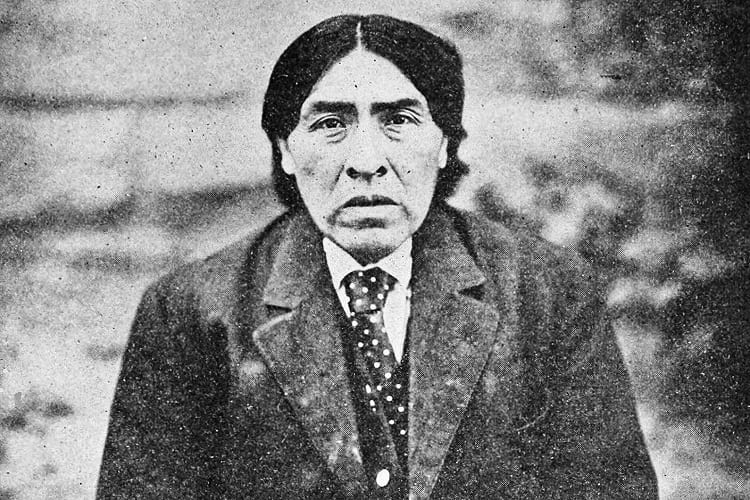
Ishi in 1915. (T.T. Waterman: The last wild tribe of California)
Imagine being hunted by people hellbent on killing you and your family, and, therefore, staying hidden for most of your life. And then, after all that, seeing your family and all your friends driven to their deaths, and finding yourself all alone in a hostile world. This, in a nutshell, is the story of Ishi, the Native American who is widely considered to be the last surviving member of the Yahi Tribe.
Ishi, the Native American of the Yahi Tribe
He was born sometime in 1860 or perhaps earlier. There is no exact record of his birth, but the first official record of him is from 1865. Settlers, who claimed that the Yahi were responsible for stealing cattle and killing some settlers at Lower Concow Creek near Oroville, described a young boy that was part of the group.
Shortly afterwards, 16 or 17 so-called Indian fighters attacked the Yahi camp and killed around 40 people in what became known as the Three Knolls Massacre. Some 33 Yahi managed to escape, but half of them were killed later and most of the others shortly thereafter. Ishi and his immediate family, which consisted of his mother, his sister, and his uncle managed to get away.
The background of the Yahi Tribe
The Yahi tribe was an offshoot of the Yana tribe, and, prior to the arrival of the white man, had lived for centuries on their traditional lands near the foothills of Mount Lassen. They were never numerous to begin with. There were around 400 Yahi people and 3000 Yana people before the California Gold Rush.
They moved around the thick forests, hunting deer, fishing for salmon, and foraging for wild vegetables. It wasn’t exactly an idyllic existence though. They had enmities with other native American tribes such as the Wintu, the Nomlaki, and the Maidu. These tribes portrayed them to the white settlers as ferocious and warlike people.
The destruction of the Yahi Tribe
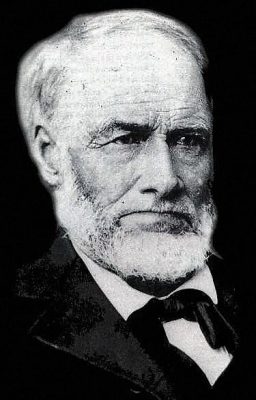
James W. Marshall. (Wikimedia Commons)
In 1848, James W. Marshall first discovered gold in California and that set off the California Gold Rush. By 1849, the area was flooded with prospectors and people of different stripes, all determined to make a fortune. They were a hardened lot, caring only for money and profit. It would not have even occurred to them to have any concern for the native population. When most of the easily found gold had been mined by 1855, the avaricious crowd moved to the hills to look for more.
Their intensive gold mining activities poisoned the streams and depleted the salmon and frightened off the deer. The miners and settlers laid claim on the traditional Yahi lands and began threatening the inhabitants. Their aggression resulted in the California Indian Wars that lasted from 1850 to 1880. Armed with only primitive weapons, the Yahi warriors did not stand a chance against the gun-toting miners and settlers.
Considering the Yahi to be no better than vermin, the newcomers embarked on a killing mission. They hunted them down and slaughtered them.
In this way, the entire Yahi tribe was decimated. Ishi and his family, as mentioned earlier, somehow escaped and hid deep within the forest for the next 40 years.
The plight of Ishi and his Family
Towards the end of 1908, a group of surveyors stumbled upon the little, makeshift village in which Ishi’s family had been living. Ishi was not there then – although, one of the surveyors had seen him fishing the day before and had reported it to the group; they had refused to believe him – but the others, his uncle, sister, and mother were. The uncle and sister ran off to hide in the forest, after covering the mother with skins to hide her; since she was ill and bedridden, it wasn’t possible for her to flee.
The surveyors found her there, trembling with fear. They left her alone but stole everything they could lay their hands on. This included the food and tools that the Yahi needed for their survival. It was a callous act that effectively sentenced the survivors to death. One member of the group later claimed that he had tried to persuade the other to not take these things and to take the ill woman to a hospital, but they had ignored him.
Ishi returned after the surveyors departed and took his mother away, but the shock must have been too much for her—she had already seen white attackers murder her extended family before—and she died shortly afterwards. Ishi never found out what happened to his sister and his uncle. He tried to track them but was unsuccessful. It is probable that they too did not survive.
For the next three years, Ishi lived by himself in the forest in total isolation.
Ishi enters the modern world
On 29 August 1911, the butchers in a slaughterhouse in Oroville, a town near the foothills of Lassen Peak in Northern California, were aroused by the barking and snarling of the dogs outside. Going to check on the commotion, they found that the dogs had cornered a strange, emaciated, middle-aged man. He had burnt hair and was completely naked, except for a worn-out sheet of wagon canvas that was wrapped about his shoulders.
It was Ishi, who, after years of seclusion, had finally been forced by starvation to emerge from the wilderness to forage for food.
There was nothing threatening about him, but, taking him to be a madman, the butchers called the sheriff. The man thus ended up in the local jail. Unable to communicate with him, the sheriff summoned other Native Americans, but they couldn’t talk to him either.
The news of the ‘wild man’ spread around and reached Thomas Waterman, an anthropologist at the University of California, Berkeley. Intrigued, he took a train to Oroville and persuaded the sheriff to release the stranger into his custody. He then brought him back to San Francisco.
Ishi at the University of California
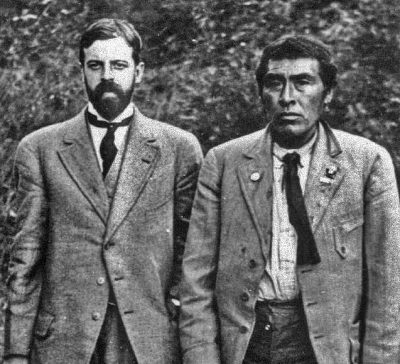
Ishi with anthropologist Alfred L. Kroeber. (Wikimedia Commons)
Thomas Waterman arranged for Ishi to live in an apartment at the University’s Museum of Anthropology. He and his fellow anthropologist, Alfred Kroeber, studied Ishi for the next five years. To enable Ishi to continue to remain at the University, they gave him a post as a janitor and taught him English.
The anthropologists learned much from him regarding the Yahi lifestyle, social relationships, ceremonies, traditions, implements, language, and more. Edward Sapir, a linguist who had studied the dialects of the northern tribes, recorded him for posterity. Regretfully though, as Ishi was growing up, most of the elders had either died or been killed, and so he only had limited knowledge of his own culture.
However, he knew enough to refuse to speak about certain things that were considered taboo in his culture. For instance, he couldn’t speak about the dead. Which was frustrating for the anthropologists as it prevented him from talking in detail about his tribal members and family.
He also could not tell the researchers his real name. In Yahi culture, your name was private information that you couldn’t divulge to strangers. Only another Yahi could tell another person your name. Since all the Yahi were now dead, there was no way for Ishi to tell anyone his name.
The researchers, therefore, called him Ishi for convenience. It means ‘man’ in the Yahi language.
During his five years at the University of California, Yahi contributed a lot to the general understanding of the Yahi culture. He also demonstrated his fire-making and implement-making skills to visitors. Furthermore—although, reluctantly—he took the researchers on a tour of his family’s traditional hunting grounds and showed them the places where they had camped as well as the places where they had died.
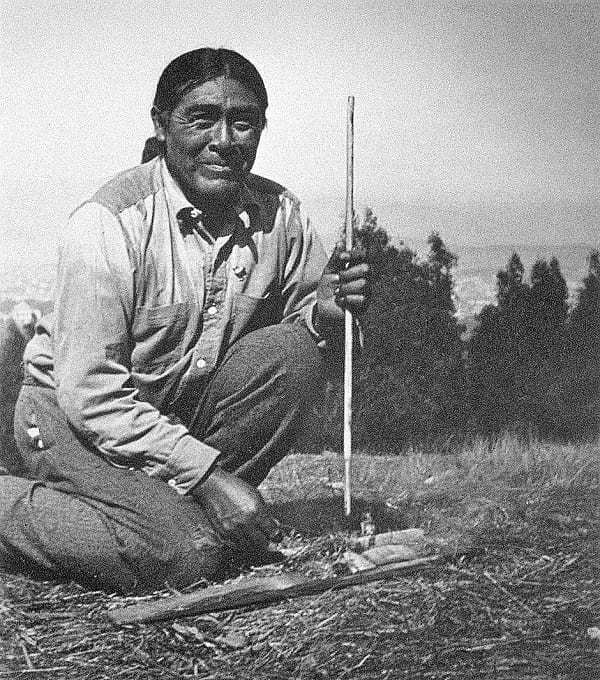
Ishi demonstrating his fire making skills. (Saxton T. Pope)
The death of Ishi
Ishi lived for only five more years after he walked down from the mountain into modern civilization. Having lived in isolation for most of his life, he did not have any immunity against the white man’s diseases. He was frequently ill while at the University, and was often in the care of Dr. Saxton T. Pope. He died of tuberculosis, which was then incurable on 25 March 1916.
Aftermath
Despite the fact that Yahi tradition forbade any tampering with the body and before Thomas Waterman could intervene—Alfred Kroeber was away in Europe at the time—the doctors at the University’s medical school carried out an autopsy. Ishi’s brain was removed for preservation and was later discovered to be in the collection of the Smithsonian Museum.
The brain and his ashes were returned to the Yana tribe at the Redding Rancheria – his closest kin – for a proper burial in 2000.
His life has been the subjects of many films and books, including the 1961 ‘Ishi in Two Worlds’ by Alfred Kroeber’s wife, Theodora Kroeber.
More current research suggests that Ishi probably was of mixed-blood origin and certainly not the last of the Yahi as has been widely claimed. Whether that is the case or not, it doesn’t detract from the series of tragedies that marked his entire life.
Enjoyed this article? Also, check out “North Sentinel Island: Home to an Uncontacted, Hostile and Primitive Tribe“.
Recommended Read:
Ishi in Two Worlds | By Theodora Kroeber
Fact Analysis:
STSTW Media strives to deliver accurate information through careful research. However, things can go wrong. If you find the above article inaccurate or biased, please let us know at [email protected].
RELATED
The post Life of Ishi: The Last Surviving Member of the Yahi Tribe appeared first on .
]]>The post Hyderabad State: When Nizams Held Control of an Indian Kingdom During Its Golden Period appeared first on .
]]>
Hyderabad state in 1909. (John George Bartholomew / Imperial Gazetteer of India, 1909)
The first thing that strikes us when we think of the Princely state of Hyderabad is wealth and opulence. At the time of his death, the Seventh Nizam was reported to have been the fifth wealthiest person in the world.
However, there is much more to the Asaf Jahi Nizams than mere wealth and opulence. The Asaf Jahis were one of the bravest warriors and excellent swordsmen of their time.
1655: Ancestors of the Nizams of Hyderabad
One thing, though, is very interesting. Did you know that the ancestors of the Nizams of Hyderabad state originally belonged to the Turkic dynasty from around Samarkand in today’s Uzbekistan? Turkic happens to be a subgroup of the Altaic family of languages that are spoken in the western and central parts of Asia.
The grandfather of the First Nizam was a person named Khwaja Abid who hailed from a village called Aliabad, which was close to Samarkand. In those days the region fell under the kingdom of Bukhara. Khwaja Abid was said to be a learned man, who was well-versed in the warfare techniques.
As per records of that era, Khwaja Abid is believed to have visited the Mughal India in 1655 AD. Shortly after that, he is said to have presented himself before Emperor Shah Jahan. Impressed with his skill sets, the emperor granted him favours and a position in the Imperial service.
Thus began the connection between the Mughals and the later Nizams. This association continued till the end of the Mughal rule.
1657: Nawab Khwaja Abid Siddiqi governor of Ajmer
Later in 1657, Khwaja Abid entered into the Imperial service under Aurangzeb, who was at that time the Viceroy of the Deccan. At that time, Aurangzeb was getting ready to wage a war of succession against his brothers and half brothers.
At such a crucial time, Aurangzeb appointed Khwaja Abid to an important position in the Moghul army. After Aurangzeb became the Mughal Emperor, he gave the governorship of Ajmer. Subsequently, he was made the governor of Multan and was also given the title Kilich Khan.
Khwaja Abid, a.k.a Kilich Khan is believed to have died in 1687 during the siege of Golconda, which was under the control of Qutub Shahi kings. At this stage, Kilich Khan had a grandson named Qamaruddin.
After Aurangzeb’s death in 1707 in Ahmednagar, the Mughal dynasty weakened and limped on for another 150 years. In the backdrop of a weak empire and unsettling political environment, rose the Asaf Jahi dynasty. Not willing to be subedars of a bigger kingdom, the Asaf Jahis made Hyderabad their own.
The Nizam of Hyderabad (1724-1948)
Khaja Abid’s grandson Qamaruddin
It all started with Kilich Khan’s grandson Qamaruddin. During Aurangzeb’s time, at the tender age of just 19, Qamaruddin earned his name as a skilful warrior. At that young age, he was even given the title Chin Qilich Khan or Boy Swordsman.
In 1713, Aurangzeb’s grandson emperor Farrukhsiyar gave the title of Nizam-ul-Mulk Fateh Jung to Qamaruddin. He was then appointed as the subedar of six provinces apart from the Faujdar of Karnatak.
Palace intrigues
Qamaruddin was troubled with palace intrigues thanks to the Sayyid brothers, who were powerful generals in the Mughal Empire. The two generals, alarmed by his rise, conspired against Qamaruddin. After the death of the Sayyads, Qamaruddin, by now fed up with palace intrigues, decided to become the viceroy of the Deccan region.
In a decisive battle with the then Subedar of the Deccan Mubrez Khan, Qamarruddin established his supremacy on the region. He immediately started to strengthen Deccan’s administration and finances.
The 1st Nizam: Mir Qamar-ud-din Khan, Asaf Jah I (1724-1748)

A posthumous portrait of Mir Qamaruddin Khan. (Unknown)
Qamarruddin conferred the title of Asaf Jah
Mughal emperor Muhammed Shah then invited Qamarruddin to Delhi. The emperor then extended an olive leaf and gave the title of Asaf Jah on Qamarruddin. Asaf Jah means equal to Asaf. The Grand Vizier of King Solomon’s court was named Asaf.
Asaf Jahi dynasty ruled Hyderabad from 1724
Though viewed as a subject of the Mughal Empire, in reality, Qamaruddin turned out to be an independent ruler. Thus, the Asaf Jahi dynasty ruled Hyderabad from 1724 till September 1948.
According to legend, before leaving Delhi, Qamaruddin is said to have called on a secret Saint and told him of his wish to leave Delhi and go to Deccan. The Saint is said to have blessed him and asked him to take some bread before embarking on the long journey.
Obeying the Saint’s suggestion, Qamaruddin is said to have taken seven pieces of the blessed bread. What happened next is unclear. However, the Saint is said to have indicated that the Asaf Jah dynasty will continue for seven generations.
Nizam-ul-Mulk Asaf Jah I’s rule
Qamaruddin or Nizam-ul-Mulk Asaf Jah I ruled over Hyderabad state for the next 24 years from 1724. Of course, his major achievement was to lay the foundation of Hyderabad, the princely state. As the head of the judicial, executive and defence department, the Nizam I drafted his own laws and set up his own armies. He also created a new flag for Hyderabad state.

The Asafia flag of Hyderabad state. The script on the top reads Al Azmatulillah meaning “All greatness is for God”. The writing in the middle reads “Nizam-ul-Mulk Asif Jah”. The bottom script reads Ya Uthman which translates to “Oh Uthman”. (Yenemus / Wikimedia Commons)
As part of his other initiatives to strengthen the revenues of the Hyderabad state, he split his state into three parts. This system laid the foundation for the growth of the Muslim nobles as jagirdars, zamindars and Deshmukhs. One of the important noble families was the Paigahs. This system remained unchanged until 1950.
During his 24 years of reign, Nizam I, except for the one year war with the Marathas in 1727, the Nizam I hardly waged a war or a battle. Therefore, the Nizam I is known to have laid a firm foundation for an important Muslim state outside West Asia. At that time, the Hyderabad state was estimated to be as large as France.
At the time of his death in 1748, the Nizam was 76 years old. He was buried at the mazaar of Shaikh Burhan-ud-din Gharib Chisti, Khuldabad. Aurangzeb is also said to have been buried close by.
The 2nd, 3rd & 4th rulers(1748-1762) are not counted among the Asafjahi Nizams by the historians although they were recognised by the Mughal emperors in Delhi.
After the death of Mir Qamarruddin, a power struggle ensued between the sons and grandsons of the Nizam I, British, Marathas and the French. During this unsettling period, three members of the Jung family held the kingdom intact for a period of 14 years.
The 2nd Nizam: Mir Nizam Ali Khan, Asaf Jah II (1762-1803)

Portrait of Mir Nizam Ali Khan. (Unknown)
Mir Ali Khan was coroneted as the Nizam II
In 1762, however, the fourth son of the Nizam, Mir Ali Khan was coroneted as the Nizam II. He came to be known as Nizam Ali Khan Asaf Jah II and went on to rule for the next 42 years till 1803. He was 28 years old when he assumed the title.
His reign was very important because he could not only save his dynasty from threats but also improved the state’s administration. He bought peace with the Marathas. He tied up with France and the British with alliances.
Most importantly, he shifted the capital to the more centrally located Hyderabad from Aurangabad in 1763. This shift proved to be crucial for the benefit of the Asaf Jahi rule. Nizam Ali Khan died in 1803. He was 69.
The 3rd Nizam: Mir Akbar Ali Khan, Asaf Jah III (1803-1829)
Mir Akbar Ali Khan Sikander Jah Asaf Jah III
The next Nizam was Mir Akbar Ali Khan Sikander Jah Asaf Jah III. He ruled from 1803 to 1829. Sikandar Jah can be credited for the new era in the progress of Hyderabad. The city expanded to the north in 1806. The expanded city was named Secunderabad after Sikander Jah. Till then, Secunderabad was known as Lashkar, meaning cantonment. After his death in May 1829, his eldest son named Nawab Farkhunda Ali Khan was coroneted.
The 4th Nizam: Mir Farqunda Ali Khan, Asaf Jah IV (1829-1857)
Mir Farkhunda Ali Khan Nasirud-Daula Asaf Jah IV
Mir Farkhunda Ali Khan Nasirud-Daula Asaf Jah IV ruled from 1829 till 1857. The Hyderabad state was in deep financial turmoil at the time of his coronation. The first act Nizam IV did was to tackle the mounting debt. For this, he ceded several border districts including Berar to the British.
Financial turmoil
To further overcome the financial turmoil, a new model of just revenue administration was introduced. He removed the systems of jagirs, zamindari and deshmukh and introduced the concept of taluqdar.
He divided Hyderabad state into 16 districts. Each district had a taluqdar. This system brought in improved transparency in administration. In this way, Nizam IV safely steered the Hyderabad state through a critical phase. During his reign, Hyderabad prospered with schools, business centres and bridges.
Nizam banned the practice of Sati
One year before his death in May 1857, the Nizam banned the practice of Sati in the kingdom. Thus, Hyderabad became the first princely state in India to do so.
The 5th Nizam: Mir Tahniyath Ali Khan, Asaf Jah V (1857-1869)
Mir Tahniyath Khan Afzal-ud-Daula Asaf Jah V
Sikandar Jah’s son, Mir Tahniyath Khan Afzal-ud-Daula Asaf Jah V, took over the reins from him in 1857 and ruled for just 12 years till 1869. Afzal-ul-Daula can be credited for giving land for the Bombay- Madras railway line, building the Afzalgunj Bridge, mosque and bazaar.
He died at the young age of 42. He was succeeded by his son Nawab Mir Mahbub Ali Khan. The VI Nizam was just about three years old at that time.
The 6th Nizam: Mir Mahbub Ali Khan, Asaf Jah VI (1869-1911)
Mir Mahbub Ali Khan Bahadur Asaf Jah VI

Nizam Mahboob Ali Khan. (Royal Collection Trust)
He became Mir Mahboob Ali Khan Bahadur Asaf Jah VI in 1869 and went on to rule for the next 42 years till 1911.
Till he attained the age of 17 in 1885, the youngest Asaf Jahi ruler’s co-regents Nawab Rasheeduddin Khan, Mir Turab Ali Khan, Sir Salar Jung I and Shams-ul-Umara III oversaw the administration.
Rapid development witnessed
After he assumed his sovereign rights, Nizam VI made rapid development in the fields of railways, revenue system and establishment of silk and cotton mills. Other fields that came under his spotlight include education, judiciary, police, excise, forest and health.
It was during this period, the Nizam’s brother-in-law (Viqar-ul-Umara) is said to have constructed the Falaknuma Palace and gifted it to the Nizam. However, sadly, during his short stay at the palace, the Nizam fell, suffered a paralytic stroke and died at the age of 46.

Falaknuma Palace, 1900. (Collection of Horatio Kitchener)
The 7th Nizam: Mir Osman Ali Khan, Asaf Jah VII (1911-1948)
Mir Osman Ali Khan Bahadur Asaf Jah VII

Mir Osman Ali Khan. (unknown)
On September 12, 1911, the world-famous Mir Osman Ali Khan Bahadur Asaf Jah VII got coroneted as Nizam VII. He was born in 1886. His first act as the Nizam was to abolish capital punishment for civilians. During World War I, he extended military, financial and material support to the British. He established the Osmania University in Hyderabad in 1917.

Osmania University students wearing Deccani sherwani and caps, circa 1939. (Cecil Beaton / Imperial War Museums)
He then separated the executive from the judiciary in 1921. In the rest of India, this was done in 1974. Several public buildings that are functional today were built by him.
Generously donated money to educational institutions
He generously donated money to educational institutions like Aligarh Muslim University, Benaras Hindu University, and Santiniketan. He then gifted away 14,000 acres of land for the Bhoodan Movement in Pochampally near Hyderabad city.
Last Nizam refused to merge Hyderabad state with India
In 1947, India became an independent nation and asked all the princely states to merge with the Union of India. However, the last Nizam Mir Osman Ali Khan refused to merge Hyderabad state with India. He desired to retain Hyderabad as an independent sovereignty.
However, India’s first Home Minister Sardar Vallabhbhai Patel, in no uncertain terms, told the Nizam that India will not tolerate this. After several negotiations, the Indian government signed a standstill agreement with the Nizam in November 1947. India hoped the Nizam will set up a representative government in Hyderabad which will then help in the merger process.
Three crucial developments
But, Mir Osman Ali Khan had different views. With a view to negotiating with the Indian government on his behalf, he engaged British lawyer Sir Walter Monckton. He wanted to buy time through negotiations in order to build up his armed forces to clash with India. In this connection, the Nizam was believed to have been in talks with the Portuguese administration in Goa and also Pakistan.
In June 1948, the last Governor General of India Lord Mountbatten proposed a deal called the Heads of Agreement. As per the deal, Hyderabad was to get the status of an autonomous dominion nation under India. Though India agreed to sign the deal, the Nizam is said to have refused it. On August 27, 1947, the Nizam actually declared he wanted complete independence. Or else, he wanted a dominion status under the British Commonwealth of Nations.
The Nizam is said to have issued a firman that Hyderabad would remain independent. It would not join the Constituent Assembly. Soon after the declaration, Kasim Razvi unfurled the Asafia Flag and exhorted Hyderabadis to defend the state to the last.

Kasim Razvi, the leader of Razakars a private militia that supported the rule of Nizam Osman Ali Khan. (Unknown)
In connection with the issue of joining the Indian Union, Mir Osman Ali Khan is believed to have rejected the advice of his constitutional advisors like Walter Monckton. Walter was a close friend of Lord Louis Mountbatten, who wanted to ensure that Hyderabad held a high status in the Union of India.
Meantime, three crucial developments took place in Hyderabad state. First, Muslim communal organization named Ittihad ul Muslimeen and its paramilitary wing, the Razakars grew by leaps and bounds.

The Razakars of Hyderabad state undergoing military training. (Unknown)
At the same time, The Hyderabad State Congress launched a mass struggle against the Nizam on August 7, 1947. Finally, the peaceful agitation of the Congress against the Nizam turned violent. Meantime, however, a parallel struggle took place. The communist-led peasant movement turned into an armed struggle in the Hyderabad state from 1946 onwards.
This chaos and the unclear negotiations failed to go down well with the Indian Government.
While referring to the idea of an independent Hyderabad state, Sardar Patel reportedly said an ulcer in the heart of India should be surgically removed. This was when he decided to annex Hyderabad. One person who also played a key role in the annexation of Hyderabad was Rao Bahadur Vappala Pangunni Menon, CSI, CIE. This Indian civil servant was simply known as VP Menon.
Operation Polo launched
With no hope of solving the Hyderabad problem until June 1948, an annoyed Patel launched Operation Polo on September 13, 1948. The operation, which was named after the 17 polo fields in the then Hyderabad state, was also referred to as “Operation Caterpillar”. The operation was also referred to as Police Action.
Major General Chaudhuri led 36,000 Indian troops into Hyderabad state in the early hours of September 13 of 1948. Operation Polo was a two-pronged advance. The main force marched along the Sholapur-Hyderabad road, while a smaller diversion marched along the Bezwada-Hyderabad road. Unable to counter the might of the Indian army, the Nizam’s Army surrendered on September 17.
Records show that roughly 32 Indian soldiers were killed and 97 were injured. Meanwhile, 1373 Razakars and 50,000 civilians were killed with some reports suggesting much higher in the five-day “Operation Polo”. Meanwhile, as the Indian government was apprehensive on how the rest of India would react, a state of Emergency was declared. At the time of the formal surrender of Hyderabad, the state had a population of about 1.60 crores.
In November 1948, the last Nizam formally acceded to the Indian Union, thus, bringing the Asaf Jahi dynasty’s rule in Hyderabad to an end after 225 years.
Enjoyed this article? Also, check out “Bibi ka Maqbara: The Taj of Deccan, Which Like the Original, Tells the Tale of Eternal Love“.
Fact Analysis:
STSTW Media strives to deliver accurate information through careful research. However, things can go wrong. If you find the above article inaccurate or biased, please let us know at [email protected].
RELATED
The post Hyderabad State: When Nizams Held Control of an Indian Kingdom During Its Golden Period appeared first on .
]]>The post First Snow Goggles Date Back to the Prehistoric Inuits appeared first on .
]]>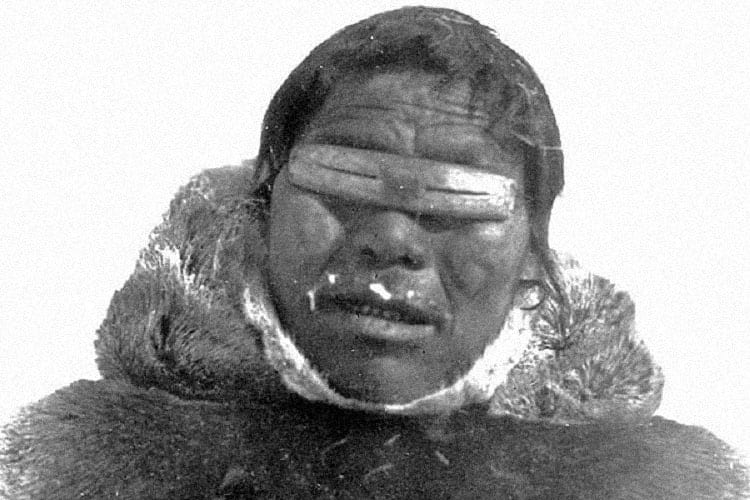
An Inuit wearing native snow goggles. ( 2L.T. Burwash / Library and Archives Canada / PA-099362)
Generations of snow-bound Arctic Circle people, including the Inuit, have been protecting their eyes from snow blindness for over 4,000 years with snow goggles. Snow blindness is scientifically known as photokeratitis.
These snow goggles’ protect the eyes from the harmful ultraviolet light that gets amplified after getting reflected off the whiteness of the snowy landscape within the Arctic Circle. Just as bright and sunny days could damage a person’s eyes, even the diffuse light on cloudy days can be equally dangerous.
Photokeratitis problem
Such a condition can cause intense pain. It could take days for the person to recovery. Also, people travelling through white landscapes could face similar serious eye problems.
To overcome this problem, the Inuit people invented the snow goggles solution. The Inuit snow goggles permit people to travel through snow-bound landscapes without facing the photokeratitis problem.
Hand-carved snow goggles
Most of the time, Eskimo hunters were the ones using these hand-carved snow goggles when they stepped out to bring food. They used the snow goggles as they couldn’t take the risk of becoming snow-blind.
Yupik, Inuit, Aleut and various other groups of the Alaskan native people generally wear these snow goggles.
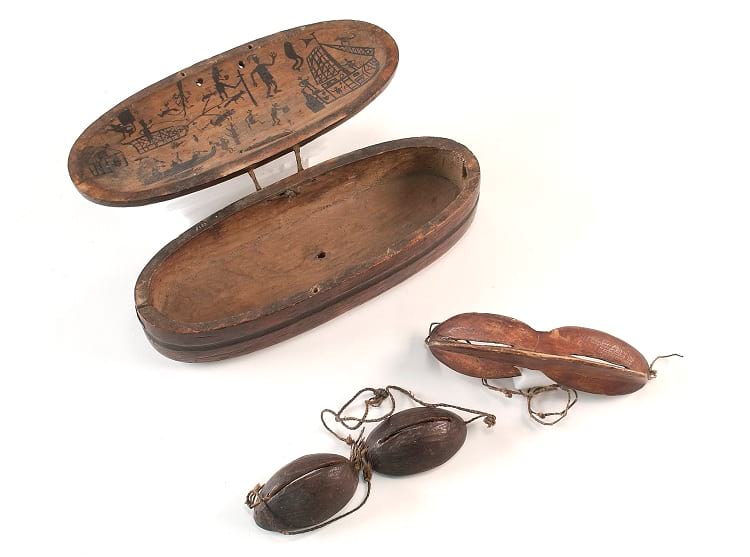
Inuit snow goggles and wooden case. (Wellcome Collection)
According to Danish ophthalmologist Prof. Mogens Norn the Inuit snow goggles do not mist or get ice over like normal goggles or shades do in polar conditions. While assessing the usefulness of the Inuit snow goggles, Prof Norn appreciated their simplicity and stability of use.
The ophthalmologist, however, pointed out that the snow goggles restrict the visual field of the wearer. Also, there was the danger of stumbling, as the person wearing the snow goggles fails to see any depressions in the ground.
Initial snow goggles made of walrus ivory
According to an artist and a craftsman Timo Granzotti the Inuit snow goggles were being made of walrus ivory, caribou antler, bone, or even seashore grass in the past. However, in the late 19th century onwards, material like driftwood was being used to carve out the snow goggles.
An Inuit person generally carves the material to fit his face. He then makes either one or two narrow but horizontal slits on the front side of the material.
The snow goggle is made to tightly fit against the person’s face with the help of a string in order to let only light through the slits. The strings were in the form of braided sinew straps. Sometimes, the Inuit people apply soot to the inside of the goggle to minimize the glare of the light.
Inuit people also rub gunpowder mixed with oil to cut down the outside glare even more.
The narrow slits are basically to reduce the amount of light hitting the eyes and also to maximise visual acuity. The view gets larger with the wider width of the slits.
In different dialects of the Inuit language, the snow goggles are referred to as inukhuk, inuksuk, ilgaak and also iggaak. The last two words are also used for sunglasses. In the Central Yup’ik language snow goggles are known as nigaugek and in Siberian Yupik language, the word for snow goggles is iyegaatek.
Not for fashionable use
These primitive snow goggles or sunglasses were not for fashionable use in the prehistoric times. And, it was not until modern times that Eskimos started to wear fashionable anti-UV rays’ sunglasses.
The Eskimo or the Inuit people should be credited for the first sunglasses in the world. Apparently, legend says, the first snow goggles dated back to a culture called the Old Bering Sea. People of this culture lived somewhere on the west coast of Alaska. They were the ancestors of today’s Inuit people.
Relics of snow goggles at the Canadian Museum of Civilization
Sometime about 800 years ago, the Inuit people of the Thule culture brought these snow goggles to Canada. A relic of the snow goggles from the Thule people era now finds a place in the collection of the Canadian Museum of Civilization. It was crafted out of walrus ivory. It dates back to 1200 AD, according to the museum located in Quebec.
Contrary to popular belief that the Inuit snow goggles are rare, museums across the world believe that they are available in large numbers. The National Museum in Copenhagen, for example, has hundreds of these goggles on display and also in the warehouse.
Enjoyed this article? Also, check out “Andrée’s Arctic Balloon Expedition of 1897: A Peek into the Doomed North Pole Flight“.
Recommended Visit:
Canadian Museum of Civilization | Canada
Fact Analysis:
STSTW Media strives to deliver accurate information through careful research. However, things can go wrong. If you find the above article inaccurate or biased, please let us know at [email protected].
RELATED
The post First Snow Goggles Date Back to the Prehistoric Inuits appeared first on .
]]>The post Ayahs’ Home In London: Where Abandoned Indian Nannies Were Sent to Live Out the Rest of Their Days appeared first on .
]]>
Ayahs’ Home at 26 King Edward Road, UK. (London City Mission magazine)
We heard of a home for the aged or even orphans. But, a home for the ayahs’ of India and that too in London! 194 years back a group of English women formed a committee of women and established a shelter in London. They named it Ayahs’ Home. The basic idea was to extend shelter to the thousands of stranded ayahs from India in England.
Ayahs’ Home established in 1825
Mrs Rogers was believed to have been behind the establishment of the Ayahs’ Home sometime in 1825 in Aldgate, London. This was two years before the beginning of the Victorian Era.
It means, even before the Victorian Era, British merchants, traders and the East India Company officials used to travel to India along with their families. These British families used to have luxurious lives. They were hiring Indian women or girls to care for their children as ayahs, nannies or nursemaids. When Queen Victoria ascended to the British throne, ayahs became a common feature in the English households in India.

Ayahs taking care of young children. (Wikimedia Commons)
1857 sepoy mutiny
After the 1857 sepoy mutiny, came the era of the British civil servants and their wives. In those days, these British wives were addressed as memsahibs. The term ‘mem’ derived from ma’am. The term ‘sahib’ refers to the male form of Sir.
Memsahibs were those who were born in Britain and then shifted to India after marriage. After they had children in India, these memsahibs needed help in the household work. They also needed ayahs to care for their newborn children.
Most of the time, the ayahs were older. At times, widowed. However, they were experienced as they already had children. They knew how to deal with young British kids.
Also, whenever the British families returned to England, these ayahs were picturesque and a common sight on board the ships. Their only job was to entertain and care for their charges during the long and arduous sea journeys.
The era of the travelling ayahs
The ayahs took up these sea journeys in spite of the societal stigma against those travelling overseas. As they were poor and nothing else to lose, they endured the stigma.
So, why did Indian ayahs agree to travel at all? Perhaps, one reason could have been an economic necessity. Another reason may have been the ayah’s devotion to a particular family or a child. Perhaps, some of the ayahs had a sense of adventure in them. Or, maybe even a desire to visit and see Britain.
It is interesting to note that one travelling ayah named Mrs Antony Pareira is believed to have travelled to Britain at least 54 times.
Before Queen Victoria’s reign, ship travel used to take four to six months to Britain from India. Later from 1869 onwards, however, the travel time dropped to three weeks as ships could pass through the Suez Canal.
During these journeys, some British families used to take their own ayahs along with them. While others used to hire ayahs especially for the ship journeys. Therefore, they expected the ayahs to have good sea legs and be trustworthy. Thus began the era of the travelling ayahs.
Travelling ayahs were paid higher wages
Such travelling ayahs were paid higher wages when compared to those ayahs who preferred to stay back in India. The travelling ayahs were also paid extra money to buy warm clothes. After completing their daily chores, the ayahs went ‘on deck’ to sleep during the ship journeys.
After the three-week sailing, when the ships docked in Britain, some British families took their ayahs along with them on their visits. Some other ayahs were sent to the Ayahs’ Home. There, these ayahs waited for their turn to be taken back home by another British family.
Some British families used to abandon ayahs
However, there were several instances where British families used to either abandon or terminate the services of an ayah after returning to England. In quite a few instances, these hapless ayahs were stranded in a strange land without money for a passage back to India.
In 1908, there was one instance when a British employer abandoned an ayah. He had left her at London’s King’s Cross Station with just one Pound Sterling note in her hand.
According to the Ayahs’ Home matron of that time, Mrs Dunn, a British woman brought the ayah from Bombay to England. She released the ayah to Thomas Cook and Son so that the ayah’s employment could be transferred.
The Drummond family of Edinburgh is then said to have employed the ayah and had pledged to take her back to India. However, after two weeks of employment, the Drummond family abandoned the ayah.
The hapless ayah then landed at the office of the Thomas Cook, who sent her to the Ayahs’ Home. On coming to know of this case, Mrs Dunn had succeeded in obtaining compensation from the India Office for the ayah.
The case of ayah Minnie Green
Earlier in September 1892, an ayah from Bangalore named Minnie Green took her British employer and his wife to a British court and won. Minnie Green was her anglicized. In those days, it was the habit of the British to anglicize the names of their servants.
Her journey from Bangalore to London was a traumatic one. During the journey, Minnie Green’s employers were violent and disrespectful towards her, according to the Lloyds Weekly Newspaper. Her employers, Harold and Grace Denton, were coffee planters in India at that time.
By and large, those ayahs whose services were terminated were because they had no formal contract of employment.
Role of British women in extending shelter to ayahs
This is where one should appreciate the role of British women like Mrs Rogers who took it upon themselves to extend shelter to ayahs stranded in England. The Ayahs’ Home also helped the stranded ayahs in finding an alternative employer to return home.
“Symbol of the British Empire”
The Ayahs’ Home thus acted as a transit home as well as an employment agency with the assistance of the India Office in London. It was also considered to be the “Symbol of the British Empire” and a home away from home.
Usually, though, a British employer used to provide a return ticket to the ayah even before reaching England. The employer generally used to surrender the return ticket of the ayah to the Home.
The matron of the Home used to sell the ticket to another British family needing the ayah’s services. Meanwhile, the Home used to spend the money generated from the ticket sale to cover the expenses of the ayah’s board and lodging.
In 1900, the London City Mission (LCM) took charge of the management of the Home with the active support of the Christian Missionaries. And naturally, the Home moved from Aldgate to King Edward’s Road in Hackney, London.

Ayahs’ Home, Hackney. (Wikimedia Commons)
Later in 1921, the Home shifted into more spacious premises on the same road in London. Lady Chelmsford, the wife of the former Viceroy of India had inaugurated the Home at the bigger premises.
According to a research paper titled “Ayahs’ Home”, there were instances when missionaries made attempts to convert the ayahs to Christianity. In this connection, a committee of the LCM frequently held “Foreigners’ Fetes” for the benefit of the transiting ayahs.
On average, the Ayahs’ Home used to take care of 90 to 140 ayahs a year. This information was conveyed to the India Office by a matron named Mrs Dunn in 1910.
Nursemaids from countries like China
Interestingly, some of the transit residents of the Ayahs’ Home included nurse maids from British-dominant countries like China. They too were brought to Britain for similar reasons, i.e. child care during sea journey. They too needed assistance in returning to their homeland.
Generally, the travelling season was between March and November. During this season, the Home was bursting to the seams. However, between November and March, the Home was more or less empty. Also, there were not many ayahs at the Home during World War I as women were denied permission to travel by sea.
“Madrassi ayahs” were highly prized
Till 1947, one set of ayahs were highly prized and they were the highly skilled and sophisticated ayahs from South India. They were generally called as “Madrassi ayahs”. Such ayahs were seasoned travellers. They even advertised their services in newspapers of those days. They were generally clean, honest and capable nurses. They were also very good sailors.
These “Madrassi ayahs” too found shelter at the Ayahs’ Home like any other ayah. Though there are hardly any testimonies from the ayahs, life at the Home happened to be a mix of eastern and western traditions.
Indian food was served and the ayahs were passing their time by either playing pachis or were busy with their embroidery work. Some of them even went on a sightseeing tour around London.
Ayahs’ Home’s income
In addition to earning money through the sale of the return ticket of an ayah to a new employer, the Ayahs’ Home also earned money through public donations and fundraising events. Between November and March, the Home was almost empty and with no funds to keep it alive. During such hard times, the Home’s administrator used to apply to the India Office in London for financial help.
From such busy times of the 1800s and the 1900s, very few know as to what happened to the Ayahs’ Home after 1947. Very few know about the Home today even though it still stands in the heart of London.
The Home’s building in Hackney today is just another number on the street.
Enjoyed this article? Also, check out “The History of Breast Tax and the Revolt of Low Cast Women in 19th Century Travancore“.
Fact Analysis:
STSTW Media strives to deliver accurate information through careful research. However, things can go wrong. If you find the above article inaccurate or biased, please let us know at [email protected].
RELATED
The post Ayahs’ Home In London: Where Abandoned Indian Nannies Were Sent to Live Out the Rest of Their Days appeared first on .
]]>The post Man-lifting Kites: Ancient China to Modern Adventure Sports appeared first on .
]]>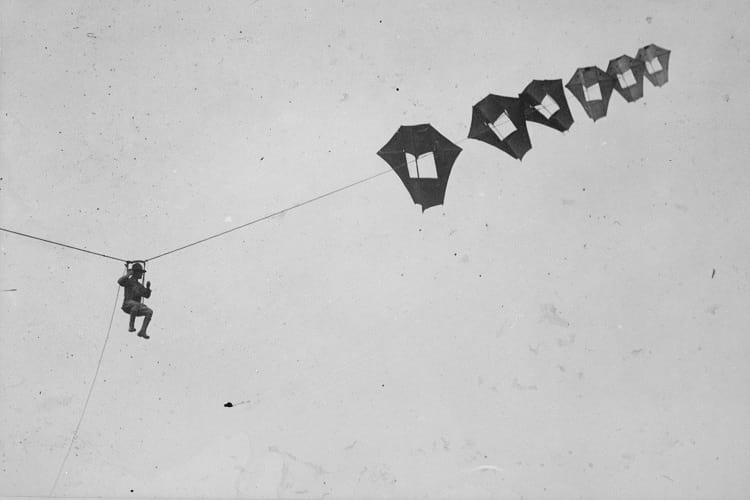
A lieutenant being lifted up in the sky by giant Perkins man-carrying kite. (U.S. National Archives and Records Administration)
Man-lifting kites are, as the name suggests, specially designed kites that can lift humans. Back in the day, when aeroplanes and helicopters were merely the stuff of high-fantasy, these man-lifting kites were the closest that humans could get to their dream of flying. The kites were either used for pleasure and entertainment or more functionally for fast aerial reconnaissance in a battlefield. The man-lifting kites had undergone various stages of development in the past, at the hands of various eminent figures. The 20th-century advent of powered flight, however, put a halt on innovations to these kites.
Man-lifting Kites: An ancient technology
Charting the history of the man-lifting kite takes us back to 6th century China. The records in the Book of Sui tell us of the tyrannical Emperor Wenxuan of Northern Qi. According to the book, he had his prisoners executed by making them attempt to ‘fly’ using bamboo mats while throwing them off a tower. These instances of the man-lifting kite’s use were almost always fatal, except in the case of a prince Yuan Huangtou, as recorded in the Zizhi Tongjian. The prince managed to fly almost 2.5 kilometres from the 33m Golden Phoenix Tower to the Purple Way, where he finally fell.
Another record from the far-east tells us about Ishikawa Goemon, a Japanese thief in the 16th century. He had successfully used the man-lifting kite to steal the golden scales from an ornamental image atop the Nagoya Castle. He had mounted a trapeze attached to the tail of a giant kite, which his accomplices manoeuvred from the ground. In the 17th century, Kawamura Zuiken, a Japanese architect, made use of man-lifting kites to lift his workers during construction.
The most seminal innovation for the man-lifting kite was by George Pocock in 1822. He had initially developed a method of using these kites to lift men to distant hill-tops. In 1822 he revolutionized the arena with his big invention: the kite-drawn buggy. This innovation kindled the interest in further developments to the man-lifting kites and its various utilitarian applications that came about in the 19th century.
Modern development
Baden-Powell’s levitor
Captain B.F.S Baden-Powell, in the early 1890s, designed a hexagonal man-lifting kite, which he named the ‘Levitor’. This was meant for military use for aerial observation, or to lift wireless antenna and other such heavy loads. After George Pocock, the first record of successful use of the man-lifting kite was in 1894, using the Levitor. Baden-Powell had lifted a man 50 feet off the ground using these kites. Since this instance, the Levitor was regularly used to lift men, even up to 100 feet off the ground. It was so successful, that the Levitors were to be used in the Boer War. However, due to the delay in its delivery to South Africa, Baden-Powell’s kites could not be put to use.
Lawrence Hargrave’s box kite
Even before Baden-Powell invented his hexagonal kites, Lawrence Hargrave designed a box-kite in 1885. However, he used this contraption for the first time on 12th November 1894, after Baden-Powell’s revolutionary success. He lifted himself using this kite around 16 feet off the ground from a beach in New South Wales’ Stanwell Park. The entire rig consisted of four box kites that were attached to the ground using piano wires.
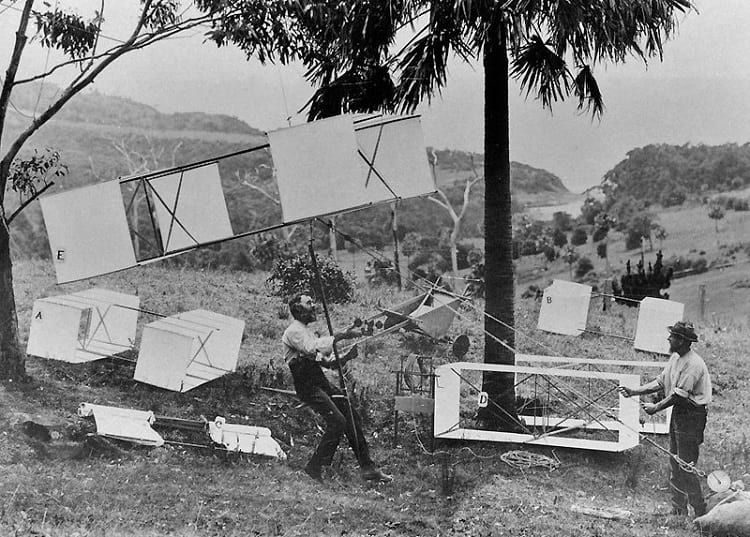
Lawrence Hargrave (left) and his associate demonstrating their box kite, 1894. (Wikimedia Commons)
The Bat
In the vein of Baden-Powell’s Levitor, Samuel Cody invented a man-lifting kite for military use. He intended his contraption to be used to observe the enemy forces during the war and named it The Bat. Cody had mounted himself on an early model of the Bat and crossed the English Channel. This garnered much interest from the War Office and he was commissioned to conduct trials through 1904-05. Subsequently, he could lift a test-subject to a record 1.219 metres. The Bat was deployed officially in 1906 and acted as a precursor to the entry of aircraft into the domain. These war-kites would ascend as any other kite would. The descent, however, was in the form of a glider, making it more suitable to violent war-zones. Samuel Cody later modified the Bat into an 8.9kW engine-powered untethered kite.
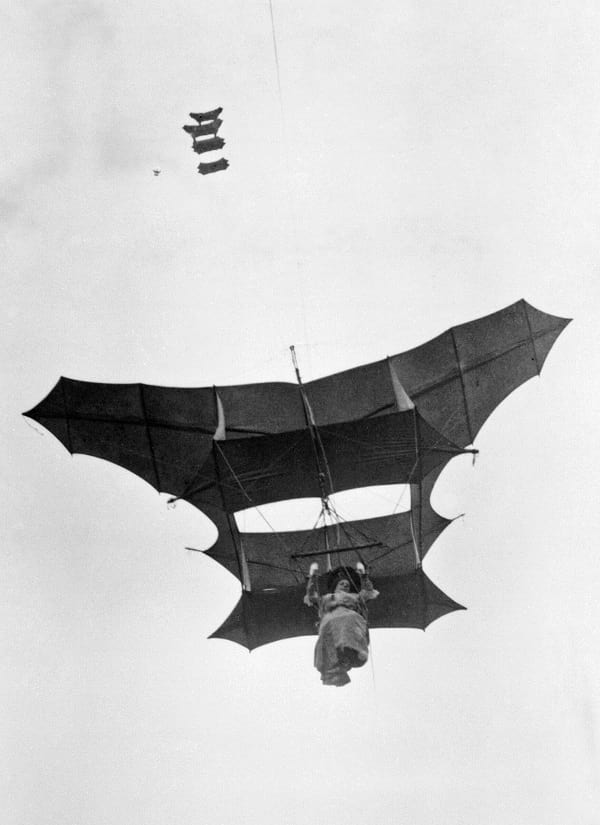
A passenger flying Man-lifter War Kite designed by Samuel Franklin Cody. (Royal Engineers official photographer)
The Hafner Rotachute
The Hafner H.8 Rotachute was designed by Australian engineer Raoul Hafner in the 1940s as an experimental single-place strap-on rotor kite. The Rotachute was intended to be an alternative to conventional parachutes and theoretically, could deploy a soldier accurately in warzones. When hand-launched, these kites tested successful, but there were several issues when dispatched from aircraft, as it ideally would be.

Hafner Rotachute. (Airborne Forces Experimental Establishment)
The Hafner Rotachute underwent up to ten evolutions (till the M.10) in March 1941. The initial Mark 1 had a tubular steel structure, rubber-mounted motor hub, and had a single seat. The Mark 3 version incorporated metal rotor blades. The successfully air-launched M. 10 was a sophisticated design incorporating mass-balanced rotors made of wood, with a rotor-span of 10ft. Despite being a practical design on paper, an occasion to put the Hafner Rotachute to use never came to pass. Around eight of these man-lifting rotor kites were constructed, and they were mostly used to test for future projects, namely the Hafner Rotabuggy.
Hafner Rotabuggy
The Hafner Rotabuggy was developed out of the pre-existing single-seater rotor kite called the Hafner Rotachute, both designed by Raoul Hafner. The Hafner Rotabuggy is also known as the M.L. 10/42 Flying Jeep, or Malcolm Rotaplane. It was originally manufactured as an experimental aeroplane that combines the key features of a Willy MB and a rotor kite. The Rotabuggy was intended to air-drop off-road vehicles.

Hafner Rotabuggy. (Aeroplane and Armament Experimental Establishment)
On November 16, 1942, the Rotabuggy was tested for the first time. However, the Diamond T lorry that was towing the unit was unable to pick up enough speed to launch the Rotabuggy into the air. The lorry was later switched for a supercharged Bentley vehicle, and on November 27, the Rotabuggy finally had a successful takeoff. The Rotabuggy also went through many stages of evolution, just like its predecessor. Stabilizing any vibrations, increasing the highest attainable speed, changing up the towing vehicles, and so on, resulting in a fully functional model. The machine was at its peak when launched by Whitley Haydrian and Airspeed Horsa, and flew at 400 ft-65 mph for over 10 minutes. It all went downhill when the Rotabuggy could not maintain its popularity with the onslaught of gliders in the 21st century. The gliders could transport entire vehicles with ease, and the need for the Rotabuggy had passed. No further models of this hybrid man-lifting kite were created. A duplicate model of the Rotabuggy can still be seen in the Museum of Army Flying in Middle Wallop.
The Rogallo Kite and its significance
Francis Rogallo, an aerospace engineer invented the Rogallo Wing which was developed with the help of wind tunnel testing. These Rogallo Wings were later integrated into man-lifting kites by NASA. These kites were generally propelled by ground or (later) aero vehicles. Similar to Cody’s design, the Rogallo kite also released the passenger into a controlled gliding descent.

Rogallo’s flexible wing. (NASA)
The hang-gliders, developed subsequently, were actually versions of man-lifting kites. They were evolved from the gliding descent employed by the Rogallo Kite and the Bat. While Barry Hill Palmer’s hang gliders (using Rogallo Wings) were thriving, so were other versions made by John Worth, Mike Burns, and James Hobson. Almost all of these versions were in use parallelly in the ’60s till it was standardized later.
John Dickenson used a version of the Rogallo Kite, to tow himself while on a boat in September 1963. These Ski Wing water ski kites also had elements of the Ryan Aeronautical flex-wing aircraft. The stability of this design actually helped popularise the watersport in the ’60s and ’70s.
Alexander Graham Bell’s contribution
Alexander Graham Bell, amongst the plethora of ground-breaking work that he did, also created a tetrahedral man-lifting kite. His design employed sticks arranged into triangular ‘cells’, the overall appearance akin to a honeycomb. Bell’s model soon evolved from a one-cell design to the “Cygnet” model of the early 1900s comprising 3,393 cells. This gigantic kite was used to successfully lift a man 186 ft above sea-level. The success of the Cygnet led to speculation about using it for observation in the Arctic. However, the relevant trials were yielded unsatisfactory results and the plan was shelved.
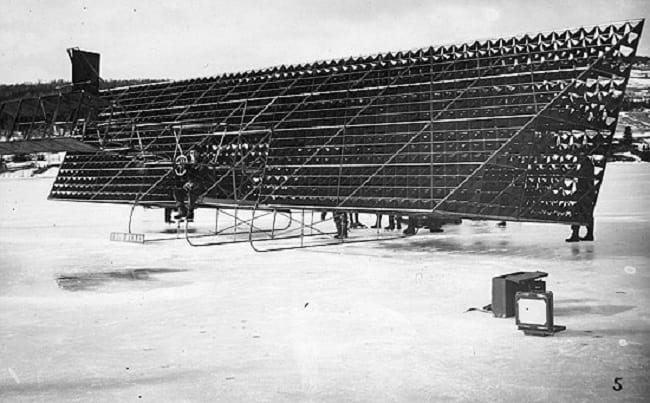
The Cygnet II, designed by Alexander Graham Bell. (SDASM Archives / Flickr)
The decline of the man-lifting kite
The decline of the man-lifting kite started with the advent of powered flight. The contraption still remained in the mainstream for a while, with the design modified to lift heavy weights. However, the Wright Brothers’ first flight in 1903, was a step ahead in the development of cutting-edge aerial transportation. The need for man-lifting kites soon took a backseat. The man-lifting kites that allow un-tethered flight still survive today in the form of hang-gliders and paragliders used for adventure sports.
Enjoyed this article? Also, check out “Franz Reichelt: Dressmaker Who Jumped off the Eiffel Tower Experimenting with Self-Designed Parachute-Suit“.
Fact Analysis:
STSTW Media strives to deliver accurate information through careful research. However, things can go wrong. If you find the above article inaccurate or biased, please let us know at [email protected].
RELATED
The post Man-lifting Kites: Ancient China to Modern Adventure Sports appeared first on .
]]>The post Byblos, Lebanon: A World Heritage Site and the Oldest Continuously Inhabited City in the World appeared first on .
]]>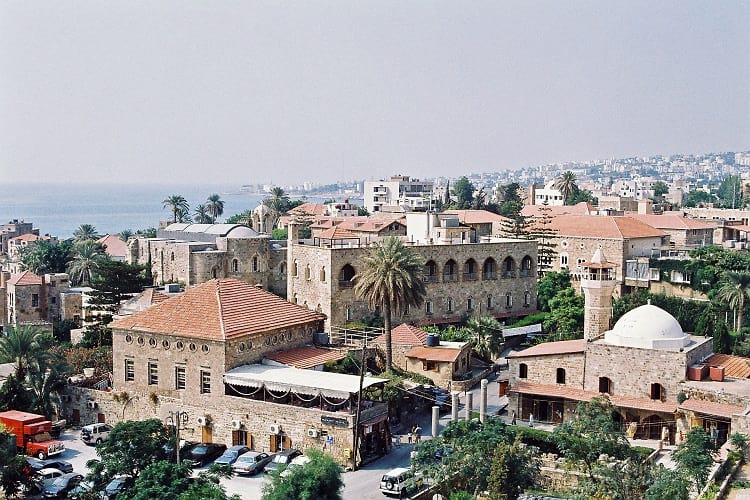
Byblos, Lebanon. (Selbst fotografiert / Wikimedia Commons)
Formed in the Levant (Western Asia), the ancient Phoenician civilisation – known internally as Canaan – is one of the foundations of modern civilisation. Despite being extinct, their innovative influence resonates today in all corners of the world. Lisbon and Barcelona are among some of the major cities said to have begun as Phonetician settlements but most certainly they created a civilisation in Carthage, North Africa who would become their descendants.
The Carthaginian Empire expanded across Northern Africa into the Iberian Peninsula of modern Spain. They ventured as far north as the island of Corsica, which brought them into direct contact with the Greek and Roman Empires. Naturally, the diffusion of cultures occurred. The Carthaginians most famously fought a series of wars with the sprawling Roman Empire. These conflicts were called the Punic wars, a Latin term which derived from their word for Phoenician. Carthage and Phoenicia will be familiar to hear but perhaps their history will be less known.
Phoenicians lived in a Thalassocracy – a nation dependent on sea-power – meaning they had a vast navy and very seldom inhabited land areas. For this reason, they brought about huge developments in boat building, nomadic lifestyle and sea warfare. They rose in the Levant, near modern-day Lebanon when the Fertile Crescent was still lush yet soon stretched to Turkey, Israel and Syria. They spoke an ancient Semitic language which became one of the basses for many modern languages today. Basically, they invented the alphabet system used now in most Indo-European countries. In actual fact, the font was first discovered in Byblos, inscribed on a tomb of a Phoenician King called Ahiram. It is called Cuneiform and consisted of 22 letters, which greatly influenced the Greek alphabet that in turn developed Latin and Cyrillic (used in Russia and many Slavic countries).
An example; Christ in Greek, Russian, English script.
Χριστός, Христос, Christ
Prehistory of Byblos
Byblos is located 42km north of Beirut, the capital of Lebanon. There is enough archaeological evidence to suggest that it has been continuously inhabited since early in the Neolithic Age, 7-9,000 years ago depending on which source one draws from. This ranks as one of the highest in the known world. And while other towns are thought to have been continuously inhabited for longer – such as Annaba in Algeria (occupied since the 14th century BCE) – none are historically as important as Byblos. To emphasize this, Byblos has been found in Hieroglyphics within Egyptian writings (notably in the myth of Gods Isis and Osiris) meaning it was a key region during the time of the Pharaohs and the Nile River Valley civilisations. An Egyptian Goddess – Baalat (the Mistress) – is also immortalized in a temple which has stood the test of time. In terms of Phoenician Gods, Baal and Yamm – the gods of the Sky and Sea – played out an epic battle in Byblos. The Akkadian Empire from Mesopotamia also had one of its dialects found in the town, that of Assyrian Cuneiform (the other being Babylonian).
Alexander’s Hellenism, the reach of Rome and the decline of Phoenicia
The Akkadian Empire split into two factions: Assyria and Babylon believed to be due to changing climates and the decay of rain-fed agriculture. It forced the Assyrians to become the dominant force in Phoenicia however they favoured another famous city named Tyre – residents of Tyre would begin the Carthaginian colonies by creating Carthage in modern Tunisia. A number of great Emperors have influenced the control of Byblos including Alexander the Great in his campaign with the Macedon Empire – a Greek state. In the 4th Century BCE, he implemented a Hellenistic period, promoting Greek culture and language after taking over the city. Alexander was notorious as a leader who allowed cultures, languages and religions of the former civilisations to remain and flourish also. Alas, he had an untameable ruthless side also, and that side destroyed much of the city of Tyre and its people in 332 BCE.
Another empire and war general would approach in the Roman conquest during the afore-mentioned Punic Wars. This was in the form of Pompey the Great. By 64 BCE all of Byblos, Tyre and Carthage had been conquered by the Romans. Many historians now agree that the Romans completely wiped out the Carthaginian civilisation after their victory. So extremely so that it has been labelled the Roman Holocaust with tens of thousands being exterminated.
“After sacking the city, the Romans burned it to the ground, leaving not one stone on top of another.”
The Phoenician Empire slowly disintegrated after having so many of its prized assets imperialised. Its remaining lands were given to the legendary Cleopatra of Egypt. To make this even more confusing, even though Cleopatra ruled an Egyptian Empire it was the Ptolemaic Dynasty she inherited which was a Hellenistic (Greek) state. Long after the time of the Pharaohs. This state was set up by a follower of Alexander the Great, a commander called Ptolemy who Cleopatra was a descendant of. Furthermore, Cleopatra had relationships with the Roman Emperors Julius Caesar and Mark Anthony. With her death, Egypt became a province of Rome.
A revolving door of legends
They would do as Romans do following these events to everywhere they ruled, creating straight roads, baths and aqueduct systems among others. When the Roman Empire split into two, the Byzantine Empire (Eastern Roman Empire) controlled the region until the Early Muslim Conquests under another legendary prophet Muhammad, took back Byblos in the 7th Century ACE. During the Crusades, Byblos bounced between the Christians and Muslims. The European Christians built one of the most famous structures – St. John the Baptist Church in the 12th Century to command dominance which still stands today. Another famous leader captured Byblos in 1189. Saladin or An-Nasir Salah ad-Din Yusuf ibn Ayyub to give his full name was part of the Ayyubid dynasty of Egypt (once the Arabs took it back from Rome). An-Nasir Salah ad-Din was gifted to him meaning ‘Mighty defender, the righteousness of faith’. Again Byblos was not used as a major hub mainly because Saladin’s dynasty, as with other Arab factions preferred to use cities more inland.

Saint John Church, Byblos. (Serge Melki / Flickr)

Obelisk Temple, one of the earliest temple in Byblos. (Heretiq / Wikimedia Commons)
There were no more events as significant as these when Byblos passed through the Ottoman Empire, and then the French Mandate following World War I. Its people finally lived in relative peace which was briefly disturbed by the Lebanon War in 2006. French Archaeologists and Egyptologists discovered the site in 1921.
From these waves of occupation, the history of Byblos can be seen from its archaeology: Crusader forts, Roman ruins, Phoenician temples and a Greek necropolis to name a few. Even Neolithic settlement evidence remains. Byblos understandably became a UNESCO World Heritage site in 1984 continues to thrive as a tourist town.

Byblos Port, the oldest port in the world. (Elias zaghrini / Wikimedia Commons)
When was the first civilisation?
There is the famous maxim that the more we find out the less we know. As soon as we believe we have uncovered the roots of civilisation more are exposed. It is commonly agreed that the oldest civilisations began as early as 7,000 BCE (Neolithic) but theories of organised societies have been argued as much as 200,000 years ago. Evidence of this was discovered in Annaba (present-day Algeria), another once Phoenician town.

Byblos Castle. (Peripitus / Wikimedia Commons)
With the timeline of modern human evolution as far back as 1.7 million years ago (at this point in time) is it possible that there were empires as far back as that. Many argue that they had the same brain power so why not? Some even argue that our ancestors, the various genera before modern humans such as the Denisovans had similar brain power so who is to say that before the Homo genus (or outside the Homo genus) there were no civilisations?
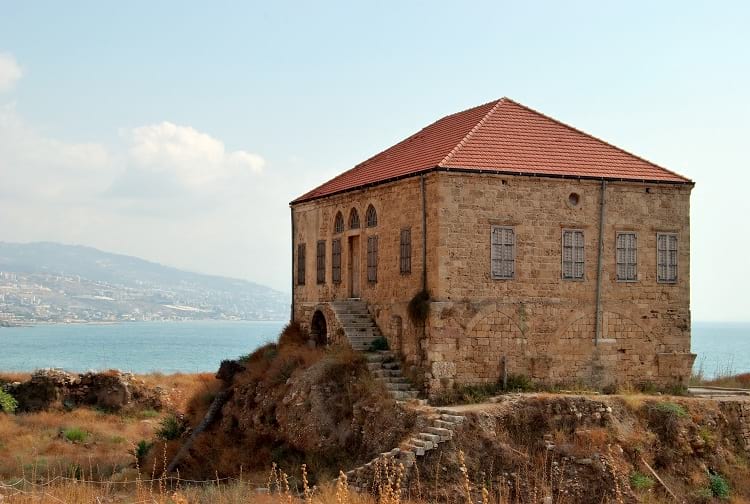
A traditional Lebanese house from the 19th century. (Peripitus / Wikimedia Commons)
It is very much possible that those empires have disappeared after time much in the same way that the Phoenician Empire almost did. Or the Indus Valley, Jiahu or Mayans to name a few others. How far are we into the timeline of human civilisation? How long will our empires last? Will evidence remain after we are gone? And for how long?
Enjoyed this article? Also, check out “Yemen’s Ancient Town of Shibam is Also Known As ‘Chicago of the Desert’“.
Fact Analysis:
STSTW Media strives to deliver accurate information through careful research. However, things can go wrong. If you find the above article inaccurate or biased, please let us know at [email protected].
RELATED
The post Byblos, Lebanon: A World Heritage Site and the Oldest Continuously Inhabited City in the World appeared first on .
]]>The post Old Penn Station: A Colossal Railway Terminal That Was Once a Crown Jewel of New York’s Heritage appeared first on .
]]>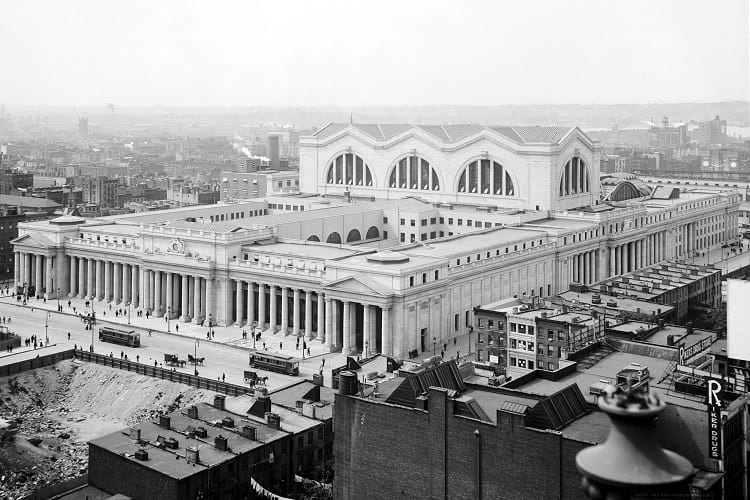
Bird’s eye view of the old Penn Station. (Detroit Publishing Company / LOC)
When the world first got to know that there would be vehicles that would carry a thousand commuters together at one time and that these vehicles would run on tracks instead of roads, it went into a tizzy. Almost every nation followed suit and the world was connected with railroad networks in no time. Soon enough each developed nation (of those times) tried to outdo the other by building railway terminals that would be better than the others. But when Pennsylvania Station in New York City in the United States of America was built between the years 1904 and 1910, it was not just a beautiful monument but it became a moment in history for everyone to hold on to.
History of Penn Station
Earlier until the twentieth century, the railway network of Pennsylvania Railroad, also known as PRR, ended on the western side of the Hudson River and commuters who had to travel further over to Manhattan had to take ferries to cross the Hudson. So PRR decided to construct a railway bridge across the river to ease the commute. But since the project had to be a joint venture between the railroad networks of the states of New York and New Jersey (since it connected both), the latter did not consider the option seriously. The PRR then looked to build a railway tunnel under the river instead, but the stringent laws of the state of New York did not allow steam engines to ply in enclosed spaces for fear of pollution and so the idea did not materialize sooner.
It was only in the year 1903 when the then PRR president Alexander Johnston Cassatt finalized the construction of the Parisian-style electric engine railroad approach to expand the railway network that a green signal was given to the project. Finally, in the year 1904, work on the new railroad expansion project took form and the railway terminal, which would go on to become a feat of engineering started taking shape. Designed by McKim, Mead and White, one of the highest-flying architectural firms in the US during that time, the Pennsylvania Station was built on a sprawling eight-acre piece of land and covered more territory than any other building ever constructed in the world then.
It covered the 31st and 33rd streets of Manhattan and was constructed in less than six years time. It followed the Roman and Greek Doric style of architecture and the entire length of the building was approximately 788 feet, which allowed for sidewalks on both sides of the street. The Pennsylvania Railroad bounded the Seventh and Eighth Avenues completely and its facades were built in a way that it patterned after the grand Caracalla baths and temples of ancient Roman civilization.

The waiting room inside the station. (Library of Congress)

Photo of the waiting room from another angle. (Library of Congress)
Alexander Cassatt, who found inspiration in the Gare d’Orsay station on his visit to the French capital of Paris, wanted his New York Penn Station to be even bigger than the Beaux-Arts styled Parisian building. Working closely with Charles McKim of the McKim, Mead and White firm, Cassatt planned a huge building that would house three floors, have twenty-five tracks for trains and would measure a whopping 1,500 feet in length and 500 feet in width. PRR also proposed for a post office to be constructed across the railway station, which the US government considered with a positive outcome. Lands were purchased and work on one of the biggest railway stations began with excavations and construction starting in full swing.
Although the tunnel project began facing initial hiccups, with many laborers dying, working in extreme conditions and some physical damage to the tunnel, construction on the station building went on without halts. Finally, after all the efforts were put in, work on the enormous Pennsylvania Station was officially finished in August 1910 with all underground tunnels in place.
Two weeks later, on September 8, 1910, a part of the station was opened to the public on an experimental basis and in November the same year, the entire station was declared open and fully operational. Commuters, eager to take the new railroad, turned up in the thousands to try out the new railway network that would finally take them all the way across the Hudson in no time.

The interior of the old Pennsylvania Station. (Library of Congress)

Main Concourse interior. (Cervin Robinson)
Description of the Penn Station
When work on the New York Pennsylvania Station was at its peak in 1908, it was considered a masterpiece that the city would look up to and talk about. The huge, arched glass windows, pink granite and marble columns adorned the building that was set to become one of the largest public spaces ever to be built. An engineering sensation, the Pennsylvania Station was constructed using roughly seventeen million bricks, 27,000 tonnes of steel, 83,000 square feet of skylights to allow daylight inside through the roof windows and some 500,000 cubic feet of coloured granite.
A part of the ceiling of the building was made using glass and wrought-iron and a 150-foot high waiting room could fit nearly three thousand people together at one time. Despite the glass roof, the waiting rooms underneath it were always brightly lit but never sunny. There were electronic ticket counters, a large information booth, small stores and restaurants packed in corners, murals decked the walls, cola vending machines were installed at regular intervals (which also led to free publicity), billboards and a few shopping arcades too were crammed inside some parts of the structure.

Platform hall of the historic reception building, 1911. (Cervin Robinson)
Demolition of the New York Penn Station
The Old Penn Station Terminal not only served the commoners but also the privileged alike once it was fully functionally and running. While there was a surge in the flow of passengers to and fro from Penn Station after World War I ended, it sadly saw a decline after the Second World War came to a close and airplanes started to take to the skies.
By the year 1947, the numbers went down drastically and it became difficult to maintain the grand building, which was already running into financial losses. Add to the woes, the Pennsylvania Railroad gave away the air rights to real estate developers. It was then decided to tear down the great building.

Pennsylvania Station, east facade. (Library of Congress)
In 1962, Irving Felt of the Graham-Paige automobile company purchased the air rights and planned to construct the present-day Madison Square Garden and Penn Plaza at the very place Penn Station once stood overlooking the busy streets. However, the railway network underneath the surface along with the tunnels beneath them were agreed to be left functional and operational. There were large public opposition rallies, international outrage and protests from all walks of life to save the building that became a part of the American heritage, but it was to no avail. Finally, in October 1963, when the first wrecking ball hit the building hard, it was clear that the structure would be taken down eventually.
Even though the New York Penn Station was demolished to make way for the multi-purpose indoor sports arena and the hotels and offices of Penn Plaza, it largely helped in preventing other heritage buildings from biting the dust. The Grand Central Terminal was also about to fall as there was a proposal to demolish it too, but the timely passing of the landmark preservation act – New York City Landmarks Preservation Commission of 1965 – helped other buildings see the future. The commission had come at a great cost but it was too late; and one of the most beautiful train terminals from the past had already ceased to exist by then.
All a part of history now, only the photographs of the mighty Penn Station remain that still adorn the walls of the train tunnels. The New York Pennsylvania Station was once a work of art, a stunning engineering marvel that also made its way into movies and people cherished it for five decades and always felt important while riding the railways beneath it.
Enjoyed this article? Also, check out “Now Forgotten Medical Histories ‒ Railway Surgeries“.
Fact Analysis:
STSTW Media strives to deliver accurate information through careful research. However, things can go wrong. If you find the above article inaccurate or biased, please let us know at [email protected].
RELATED
The post Old Penn Station: A Colossal Railway Terminal That Was Once a Crown Jewel of New York’s Heritage appeared first on .
]]>The post The Great Emu War: When Thousands of Emus Evaded Australian Armed Forces and Won the War appeared first on .
]]>Beginning of the Emu War after World War-I
When World War-I had started to gather momentum, a lot of common, working-class Australian men were sent off to fight for their country on the battlefield. These men, who had previously been farmers, goatherds, shepherds, industry workers and the like, returned home after the war ended and tried to lead a normal life. But the government found it difficult to support these soldiers, who had come back in the thousands. So it was decided that these five thousand odd war veterans would each be offered money and allotted a piece of land to cultivate wheat on and raise cattle as part of the soldier settlement scheme.
As it is, most parts of Australia were already facing a drought-like situation with westerners being the worst affected. Add to the misery, these allocated lands in Perth were either not arable or were in such bad shape that it couldn’t be used for wheat cultivation. To make situations even more difficult, The Great Depression of 1929 hit hard on the world and the Australian soldiers-turned-farmers, who were greatly affected, sunk further into financial crises. Wheat prices fell drastically and even the promised but failed government subsidies did not help them in any way. But just when things were beginning to look a wee bit sunny in the year 1932, emus began to migrate in large numbers from central Australia towards the west, in search of water and a better habitat. The flock of these large, flightless birds, which had no less than twenty thousand emus, was ready to run amok and ravage the farmlands as it moved west.
The immediate action plan
Emus, which are the second largest species of flightless birds in the world native to Australia, with a height that can reach up to 1.75 metres on an average, was a preserved species in Australia up until the year 1922. Things took an ugly turn on the 2nd of November 1932, when these migrating emus started destroying standing crops and eating away the newly cultivated wheat, thus forcing farmers, many of whom were former military men, to shoot down these birds. But the number of emus only kept increasing each time and the farmers had to finally request government intervention and military support.
Some war veterans, who had turned to farming, were taken to see the then Australian Defence Minister Sir George Pearce in Canberra, where they relayed their distressing situation to him in person. He agreed to send troops, armed with machine guns to shoot down the marauding birds, hoping it would all end well for the farmers. Major G. P. W. Meredith, of the Seventh Heavy Battery of the Royal Australian Artillery, who was the commanding officer of the Emu War, descended on Campion, a West Australian town close to Perth to fight off the nuisance. But there was more to it than met the eye.
War on the emus

Soldiers using Lewis Machine Gun during the Emu War. (Wazee Digital / Wikimedia Commons)
With two Lewis guns and some ten thousand bullets, soldiers began firing rounds at the emus, which created an almost stampede-like situation in the area on the first day. Out of the fifty birds that were sighted, only some of them could be killed. Major Meredith and his men were unsuccessful on their first day. A handful of birds were killed at the commanding officer’s orders but that was not all. Despite their tight tactical firing, the emus, which had clearly outnumbered the troops, managed to scatter in all directions and there were very few bird casualties. A couple of days later, when more flocks entered the area, soldiers, who staged an ambush this time, opened fire on the giant birds. But the emus outwitted the onslaught of bullets and escaped unhurt even on the carefully planned military attempt. Out of the thousands that were spotted, only a dozen birds were gunned down. The operation, which was already delayed due to rainfall and jammed guns, bore no fruits again.
As the military was involved in the killing of emus in large numbers, the entire operation had garnered quite a lot of media attention. But with poor results and low outcome, there was more negative press coverage, which forced the Australian government to withdraw their troops to Canberra eventually and put an end to the procedure on November 8, 1932. The emus had won their first battle.
Second attempt at killing emus
After the forces retreated, emus continued to return in large flocks to pillage the wheat crops all over again for a couple more days. So on November 13th farmers requested military support yet again, and this time it took the government a little longer than usual to respond. Finally, when the military arrived, with Major G. P. W. Meredith in command once again, they were able to take down approximately fifty birds in their first attempt than they did previously. Over a hundred emus were killed every week, but the sly and quick-on-their-feet birds still dodged the bullets. It reportedly took ten rounds of ammunition on an average to kill one bird at a time, which later the government thought, was a mere waste of time and energy. Although around five hundred emus were shot down when the military returned to Campion, the entire effort was not worth it and the forces were recalled for good this time. And so on December 2, 1932, just a month after it all began, the great Emus had won the war again.

A deceased emu during the war. (Wikimedia Commons)
The aftermath of the War
Although the government provided the locals with limited ammunition to gun down the birds on sight, not many emus were killed during the operation either. Though the emu population had gone down due to the shortage of food and water, this was due to a natural cause. Farmers requested military aid many times again in the years that followed but it was declined by the government every time. Instead, a bounty system had been initiated, wherein more than fifty thousand bounties were claimed in six months in the year 1934 alone.
As word spread across the globe about the killing of the flightless birds in such large numbers, protests to preserve the rare bird species began and the bounty system, too, had to be done away with gradually. Then on, locals began making use of emu-proof barrier fences to keep the birds away from their lands, which is still a very popular method of pest (emus in this case) control in the Australian farms.

Emu Fence. (WA Government)
Despite the Australian government trying to bring down the rare bird species in order to keep a check on them, the emus won both the wars that were waged against them. A failed wildlife management on part of humans was the main reason these wild birds continued to wreak havoc on farms at every seized opportunity. While emus continue to be an integral part of Australia till date, there was once a time in history, when these birds were tough adversaries for humans that stood tall, dodged bullets and came up trumps too.
Enjoyed this article? Also, check out “The Story of The Most Inspiring Football Match in History: Christmas Truce of World War I“.
Fact Analysis:
STSTW Media strives to deliver accurate information through careful research. However, things can go wrong. If you find the above article inaccurate or biased, please let us know at [email protected].
RELATED
The post The Great Emu War: When Thousands of Emus Evaded Australian Armed Forces and Won the War appeared first on .
]]>The post The Extraordinary Journey of the Stone of Scone and the Imperial Coronation Chair appeared first on .
]]>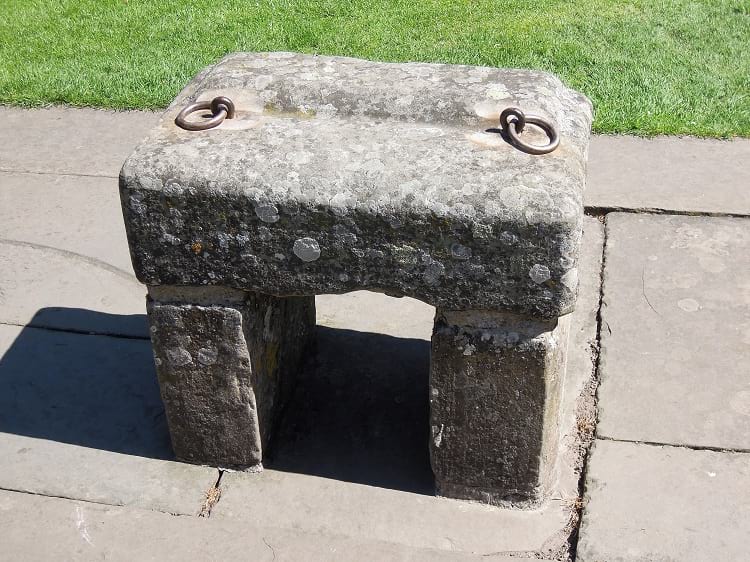
Replica of the Stone of Scone. (Aaron Bradley / Flickr)
There are several coronation thrones/chairs across the world. Two of the imperial chairs, i.e. the Sun Throne and the Naderi Throne, belong to Persia (Iran) of the late 18th century. But, the most famous imperial coronation chair, Stone of Scone, belonged to the English kingdoms for over 700 years.
The ancient chair was used during Coronation ceremonies of kings and queens of the English since the beginning of the 14th century.
Placed in St George’s Chapel at Westminster Abbey in London, the Coronation Chair is a beautiful piece of furniture. King Edward I got the imperial oak chair made in 1300 for the purpose of putting the Stone of Scone under it.
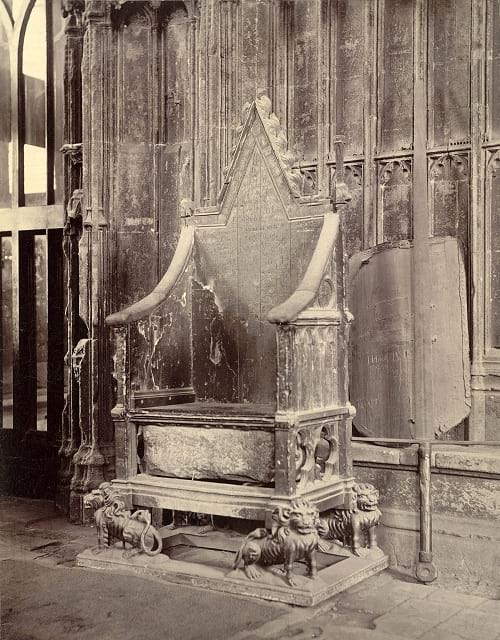
Coronation chair with Stone of Scone. (Cornell University Library / Flickr)
Stone of Scone weighs 152 kg
The king is believed to have plundered Scotland and brought the Stone of Scone in 1296 to England. He told the Abbot of Westminster to ensure full care for the stone. The stone weighing 152 kg is believed to be composed of sandstone.
The magnificent imperial chair was decorated with patterns of animals, foliage and birds. The king’s figure, either that of Edward I or Edward the Confessor, was painted on the chair’s back. The Stone of Scone was placed under the seat.
If some opinions are to be believed, the almost 7 feet tall chair was used in the coronation ceremony of Henry IV in 1399. As per records, it was used in at least 38 coronation ceremonies of reigning British monarchs at the Abbey. Of the 38, 14 ceremonies were for queen consorts.

Coronation of Queen Elizabeth II, 1953. (Biblio Archives / Library Archives from Canada)
Some of those who were coroneted on the chair include William III and Mary II (1689), Oliver Cromwell, and Queen Victoria in 1887.
Read more: The Strange Case of Emperor Norton, the Self-Anointed Monarch of the United States
Protection during World War II
To protect the ancient treasures from heavy bombing during World War II, the chair was shifted to Gloucester Cathedral, while the stone was buried secretly inside the Abbey.
For several centuries, the ancient chair was placed inside the Chapel of St Edward the Confessor. But when the chapel was shut down in 1997, it was shifted and placed on a modern pedestal close to Henry V’s tomb.
During 2010, important conservation work was carried out on the chair with the help of the Hamilton Kerr Institute. However, if rumours are to be believed, the original coronation chair went missing in the 18th century itself.
Legends of the Stone of Scone
According to one legend, Jacob rested his head on the stone at Bethel. There is a reference to the stone in the Genesis. In chapter 28 and verse 18, Jacob used the stone as a pillow.
Another legend says the sons of Jacob took the stone to Egypt. From there, it was believed to have passed on to Spain’s King Gathelus. At about 700 BC, the stone was found in Ireland, where it was kept on a sacred place called Hill of Tara.
The Celtic named the stone as “Lia-Fail”, meaning the “stone of destiny” or the “fatal” stone. Legend says during coronation ceremonies when the Irish kings sat on it the stone released a loud creaking sound.
Founder of the Scottish monarchy
The founder of the Scottish monarchy, Fergus Mor MacEirc received the coronation stone. He was of the royal blood of Ireland. Another king of Scotland, Kenneth MacAlpin is believed to have shifted the stone to the monastery of Scone in Perthshire. All these Scottish rulers were known as the kings of Dalriada.
Therefore, for Scottish people, the stone is an object of veneration. As such, it remained the coronation stone since late 5th century till 1292 AD. All Scottish kings were enthroned on the Stone of Scone atop Moot Hill palace located in a place called Perthshire.
There are no carvings on the megalith stone. It is an oblong block of red sandstone. It measures 400 mm in width and 650 mm in length and is 27 mm depth. There are some chisel marks on it.
Scottish nationalists stole the Stone
On December 25, 1950, Scottish Nationalists are said to have stolen the Stone of Scone. However, in April the following year, authorities recovered it and safely deposited it a vault. Since then the coronation chair and the stone existed separately.
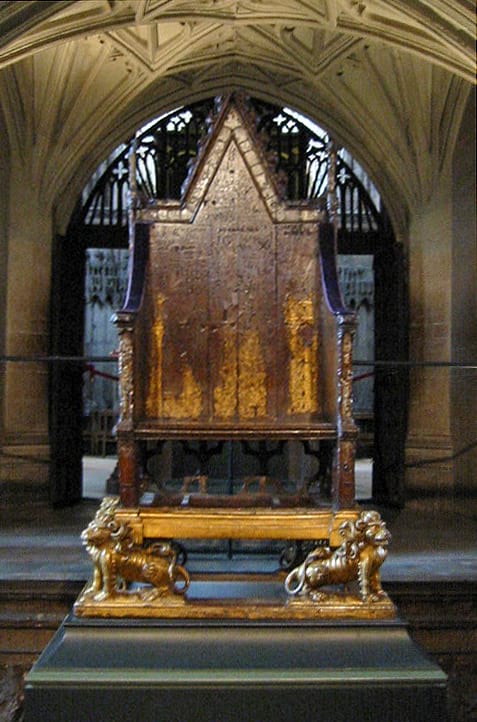
The coronation chair without the stone of scone. (Kjetil Bjørnsrud / Wikimedia Commons)
The UK returns Stone of Scone to Scotland
In a surprise announcement on July 3 of 1996, British Prime Minister John Major declared the Stone of Scone will return to Scotland by that year-end. As promised the stone was handed over to representatives of Historic Scotland on November 13, 1996.
The Stone of Scone was placed in the Edinburgh Castle. With the result, the Coronation Chair today survives without the stone.
According to a legend, when King Edward I of England hammered the Scots in 1296, the monks of Scone had hidden the original stone. The king is believed to have taken a duplicate stone to London.
On display at Edinburgh Castle
A recent myth says the 700-year-old belief that the English monarchs sat on a chair beneath which there was the stone during the coronation is false. In fact, the oak wood seat came much later.
From what we understand till now is that the stone is currently on display at the Edinburgh Castle and it is the pride of Scotland.
Enjoyed this article? Also, check out “The Strange Case of Emperor Norton, the Self-Anointed Monarch of the United States“.
Fact Analysis:
STSTW Media strives to deliver accurate information through careful research. However, things can go wrong. If you find the above article inaccurate or biased, please let us know at [email protected].
RELATED
The post The Extraordinary Journey of the Stone of Scone and the Imperial Coronation Chair appeared first on .
]]>The post Eugen Sandow: The Child Who Became the Father of Bodybuilding appeared first on .
]]>
Eugen Sandow. (Library Of Congress)
Oscar Wilde famously said there were 2 tragedies in a man’s life. One, getting what one wants. Two, not getting what one wants. Eugen Sandow, the charming health coach of the 19th century, suffered both tragedies. He desired a muscular and shapely body, as carved out in Greek and Roman Sculptures. He got it. What he didn’t get was peace in family life. He died prematurely at 58 and was buried anonymously. A fan and an admirer, 77 years later, redeemed him as ‘The Father of Bodybuilding’.
Inspired early in life to have a strong and enviable physique
Eugen Sandow was born in Konigsberg, Prussia (today’s Kaliningrad, Russia) in 1867, as Friederich Wilhelm Mueller. In 1885, he moved out of Prussia to avoid the state enforced military recruitment. He changed his name to Eugen Sandow and became a circus athlete, showing his muscles and physical strength to earn a living. By the age of 19 (year 1886), he was famous for his hair-raising stunts like breaking a chain tied to the chest, backflips, one finger pull-up, etc. That was what he wanted to be, since his childhood. As a child, he had gone to Italy on a trip and he was overawed with Sculptures of Greek and Roman heroes. The superhuman body frames impressed him no end. He even took measurements of the body muscles carved in the marble stone. The measurement served as benchmarks for his own muscle-development. And, he went on to become the first athlete in the world to have his body built to a plan.

Eugen Sandow posing. (Wellcome Collection)
Mesmerized Europe and America with his stunning power feats
Sandow turned his passion for bodybuilding into gainful employment. In 1889, he won a strength competition at London and toured Europe extensively. His muscular profile and physical strength took Europe by storm. He travelled to America in 1893 and staged a memorable performance at the World Columbian Exposition in Chicago. He stood in a black box, body smeared in white powder, looking like a statue in marble. There, he met another strength performer, Milo Steinborn, who could lift an elephant on his back. He liked meeting people of his league and exchanged knowledge on health and vitality. Interrupting his tour of America, he had flown to Europe to marry his lady love. Thereafter, he flew back to America to complete his pending work.

Eugen Sandow being compared to Hercules. (Wellcome Collection)
Appeared in films as well
In 1894, the 27-year-old Sandow starred in a film series produced by Edison Studios. The same year he acted in a commercial film titled ‘Sandow’ which dwelt on his passion for bodybuilding.
More than power play, his posturing and muscle stretch ticked with masses
His stage shows were primarily aimed at displaying the prowess of well-developed muscles. But he noted that it was not the strength quotient alone which appealed to spectators. What amused audience more was the sight of his muscles quiver to his command. Therefore, a demo of muscle flexing by body postures became the highlight of his shows which were called ‘Muscle Display Performances’. This paved the way for posturing and muscle flexing as practiced by the present day bodybuilders.

Eugen Sandow flexing his triceps (left) and biceps (right). (Wellcome Collection)
A rare combination of brawn and brain
He was an author, creator of training instruments and body-building systems, and a keen businessman. A physical culture studio in London, Sandow cigars, Sandow health magazine and health drink, testifies to his business acumen. The first ever bodybuilding contest of the world was organized by him on 14th September 1901. Titled ‘Great Competition’, the event was held at Royal Albert Hall, London, UK. The jury, apart from Eugen Sandow himself, included the famous sculptor sportsman Sir Charles Lewes, and the Scottish writer, Sir Arthur Conan Doyal.
His extramarital affairs proved to be his nemesis
Eugen was not just a body-beauty, but also a well-dressed socialite with a pleasing personality and keen sense humour. His manners were enticing and his friends’ list read like who’s who of the rich and famous. Married to Blanche Brooks Sandow, and proud father of 2 daughters, his popularity, in the long last, did him in. His women fans weren’t content with looking at him on stage, from distance. They wanted to touch him, feel his muscles, in a one-on-one after the stage show. And, of course, pay him well for this extra favour. He was romantically linked even to a male musician, a member of his entourage. His wife, naturally, resented his romantic affairs.
Eugen Sandow
In 1909, Sandow tied up as a fitness guide for the English army. Subsequently, in 1911, he became health advisor to King George V. It was indeed a great going for him all the way till his death on October 14, 1925. Rumour mill worked overtime to explain his death. Local media said it was brain stroke. Some said it was a fall out of Syphilis, a sexually transmitted disease that he was suffering from. His extramarital affairs and marital discord were well known. This came clear in his wife’s request that her husband be laid to rest incognito. Keeping that in mind, his grave wasn’t given any identity reference.
His contribution to the world of bodybuilding was finally acknowledged
Thankfully, an admirer, Thomas manly, put up a tablet on Sandow’s grave in 2002. The tablet carried his name, life span (1867-1925) and a metaphor that would become his identity for all times to come – The Father of Body Building. Indeed, a fitting tribute to a man who made health and strength fashionable, and bodybuilding a popular way to look good and feel good.

Eugen Sandow gravestone. (Reteprenrut / geograph.org.uk)
Enjoyed this article? Also, check out “Robert Wadlow: Trials and Tribulations of the World’s Tallest Man“.
Fact Analysis:
STSTW Media strives to deliver accurate information through careful research. However, things can go wrong. If you find the above article inaccurate or biased, please let us know at [email protected].
RELATED
The post Eugen Sandow: The Child Who Became the Father of Bodybuilding appeared first on .
]]>The post How Air India Carried Out the World’s Largest Civilian Evacuation in 1990 appeared first on .
]]>
File photo of Air India. (Caribb / Flickr)
When Iraq invaded Kuwait on 2 August 1990, the Indian expatriates in the latter country were left without the means to leave from the war zone. The Indian government sprang into action to rescue their citizens. Over a period of two months, between 14 August 1990 and 11 October 1990, Air India evacuated over 170,000 civilians from Kuwait and Iraq. It was the world’s largest civilian evacuation in history.
Iraq’s invasion of Kuwait
There were several reasons for Iraq’s invasion of neighbouring Kuwait. Iraq believed that Kuwait was purposely keeping its petroleum production at high levels to lower Iraq’s petroleum revenues. Further, Iraq was convinced that Kuwait was stealing its petroleum to the tune of $2.4 billion through slant-drilling across the international border into Iraq’s Rumaila oil field.
Kuwait, on its part, was unwilling to forgive the $15 billion loan it had given Iraq to finance its war with Iran between 1982 and 1988.
As a result, diplomatic relations between the two countries grew strained, and Iraq’s solution to the problem was to annex Kuwait. The Kuwaiti armed forces were unable to counter the Iraqi army’s assault, and, within two days, Iraq was able to proclaim Kuwait to be the 19th province of Iraq.
The Indian expatriates in Kuwait
The high-income economies of the Persian Gulf countries, particularly Kuwait and Iraq, had long attracted highly-qualified Indian professionals. Engineers, management consultants, and retail traders, as well as labourers, flocked to these countries to work in the booming construction industry. Most of these people were from the southern Indian state of Kerala. By 1990, the Indian expatriates constituted a significant community in Kuwait, and many of them had lived there for more than a decade, some even for several generations.
They did not at first comprehend that the impact of the Iraqi invasion would unsettle their lives. The Iraqis had traditionally had friendly relations with Indians, and so the presence of the Iraqi army did not pose a threat to the lives of the Indians in Kuwait. However, the breakdown of the Kuwaiti civilian government left the people at the mercy of thieves and armed looters. Soon, there was food scarcity everywhere in the country and water and electricity were also in short supply. These factors put an end to the illusion of normalcy.
As the Iraqi occupation continued, the Iraqis began to indiscriminate against and harass non-Kuwaitis. They jailed them for not getting Iraqi residence permits and Iraqi registration for their cars. By the time the realisation dawned on the Indian expatriates that it was no longer safe for them to continue living in Kuwait, it was too late to make a planned exit with all their possessions. They had to flee, some with only the clothes they were wearing, leaving their homes, their belongings, and everything else that they had worked so hard for over the years. For some people, even leaving with nothing became problematic as their employers had their identity documents, and, in the reigning chaos, they could not find or contact them.
The Indian Government assumes responsibility
The governing Kuwaiti royal family had fled to Saudi Arabia at the beginning of the Iraqi invasion, and there was now an Iraqi-appointed government in Kuwait. Since the government of India took it upon itself to bring its citizens safely back home, it had to negotiate with Iraq for their transfer.

Inder Kumar Gujral, the then Minister of External Affairs. (Biswarup Ganguly / Flickr)
The government sent I.K Gujral, the then Minister of External Affairs, to Baghdad to assure the Iraqi authorities that India’s only concern in the conflict was the safety of its citizens. Mr. Gujral met with Saddam Hussein, the Iraqi President, to discuss the situation as well as to discuss the bilateral trade relations between India and Iraq in the backdrop of the blockade by Western countries.
Getting the necessary air space clearances to use military aircraft to transport a large number of people was a cumbersome process, so civilian aircraft were the only option. It was, however, not possible to use the airports in Kuwait and Iraq as the Iraqi government had banned all incoming and outgoing flights.
Eventually, the Jordanian authorities agreed to allow India to operate flights out of Amman for the evacuation, and India’s national airlines Air India and its domestic counterpart Indian Airlines headed for Amman.
The task of organizing the entire operation fell upon M P Mascarenhas, who was Air India’s regional director in the Gulf & Middle East. He and his Air India team conducted the operation from a small hotel room in Amman. The Indian Embassy and the Ministry of External Affairs called for emergency assistance from its officers in India, Lebanon, and Bahrain to process the passports of the evacuees and to issue travel documents to those who needed them. The local Jordanian authorities helped the Indians in the evacuation operation with customs officials resolving the identity problems that cropped up at the border crossing.
Largest civilian evacuation
After the Indian embassy announced the government’s decision to undertake the evacuation, an exodus began towards Amman. Those who had vehicles and could get fuel started on the road to Amman. Every day, over the next two months, thousands of Indian nationals crossed Iraq to reach Al Ruwishied, the solitary outpost on the border between Iraq and Jordan.
When Iraq issued a directive to all diplomats to leave Kuwait, forcing the Indian embassy staff to relocate to Basra in Iraq, some Kuwait-based Indian businessmen, like the Malayali entrepreneur Mathunny Mathews and the architect Harbhajan Singh Vedi, formed the Indian Citizens Committee to coordinate the evacuation operation.
Shaji John Verghese, an electronics engineer, helped to set up a clandestine ham radio in the Indian school in Salmiya, a middle-class suburb in Kuwait. Through the ham radio, the Citizens Committee was able to communicate with the Ministry of External Affairs in Delhi and the Indian ambassador in Baghdad. They got approval from the Iraqi authorities and transporters to use buses to transport people from Kuwait via Basra and Baghdad to Amman in Jordan. The problem was the limited number of available buses, far too few to fit the entire gathered mass of desperate people.
Many of the evacuees that arrived in Amman crowded into the compound of the Indian embassy there. They waited on the embassy lawns, rolling out rugs and mattresses and even erecting makeshift tents. Others camped in the airport and the more fortunate found rooms in the local hotels. Tempers were frayed all around from the anxiety of their ordeal, from the lack of proper sleep, food, and water, and from not knowing exactly when they would be able to secure flights back to India.
In the end though, despite all the problems, the Indian government managed the whole operation with resounding success. It took around two months and 488 flights to transport over 100,000 people from Amman to Bombay. No other country had ever attempted a civilian evacuation of this magnitude before and Air India made it into the Guinness Book of World Records as the only civil airlines to have evacuated so many people.
As unrest erupted further in the Middle-East in the coming years, India was to undertake a few more mass evacuations to bring Indian nationals out of strife-ridden regions.
Enjoyed this article? Also, check out “Battle of Saragarhi: When 21 Valiant Indian Soldiers Held Their Ground, Fiercely Fighting Against Thousands of Afghans“.
Fact Analysis:
STSTW Media strives to deliver accurate information through careful research. However, things can go wrong. If you find the above article inaccurate or biased, please let us know at [email protected]
RELATED
The post How Air India Carried Out the World’s Largest Civilian Evacuation in 1990 appeared first on .
]]>The post From Textiles to Mercedes, Tata Motors Have Come a Long Way appeared first on .
]]>
Tata Mercedes Benz buses. (Tata Motors / Sajha Yatayat)
Imagine a workplace where ethics and enterprise go hand in hand. Where, moving with the time, even ahead of time, is the norm. Where core competence is forever growing and reaching out to the untouched and the unexplored frontiers. Where hearts and minds work in harmony for the welfare of people at large. The place is Tata Motors.
Expansion from one business vertical to another was smooth
The long journey of the Tata Group in Automobile segment began with the first truck rolling out in 1954. It carried the Mercedes logo as TELCO then had technical collaboration with Daimler Benz (brand name Mercedes Benz), a German Manufacturer. The trade name was switched to ‘T’ for Tata in 1969. Tata 407, launched in 1986, and called just 407 in general reference, was a game-changer. An indigenously built light commercial vehicle, it outdid Indo-Japanese models like Eischer-Mitsubishi, DCM Toyota, Swaraj Mazda and Allwyn-Nissan. Tata Sumo, the first multi-utility vehicle with 8 and 10 seat variant was launched in 1994. Then came the Mercedes Benz car E220 in 1995. Tata Indica, the first fully India made passenger car hit the road in 1998. The much awaited and talked about people’s car, Nano, costing just a lakh rupees, was launched in January 2008. A new range of World standard trucks was rolled out in May 2009, and India’s first Sports car – Racemo in 2017.
Tata Motors today
As of now over 4 million Tata vehicles of diverse utility are running on Indian Roads. Company’s manufacturing, sale and after-sale service has pan India presence. Following listing on the New York Stock Exchange in September 2004, Tata Motors became an International Automobile Company. It is operating in the UK, South Korea, Thailand and Spain through subsidiaries and associate companies. In 2005, Tata Motors entered into a collaboration with Hispano, a reputed bus and coach manufacturer of Spain.
Hand in hand with defence forces
A sanguine partner to the Indian Armed Forces, Tata Motors has supplied over 1.5 lakh vehicles, including fully armoured combat vehicles to the Indian army, paramilitary and the police. World-class trucks like Prima, Ultra, Signa and Tata Ace (mini-truck), India’s first CNG bus, a Hydrogen fuel cell bus, and a wide range of Electric and Hybrid locomotives are hallmarks of Tata Motors.The Company’s commercial and passenger vehicles are being exported to several countries in Europe, Africa, Middle East, South East Asia, South Asia and South America.
Corporate Social Responsibility (CSR) executed with the utmost sincerity
Story of Tata Motors is incomplete without an appraisal of its Corporate Social Responsibility (CSR) package. Tata subscribes to nation building through sustainable development, inclusive growth and social equity. Empowerment of women and SC/ST community through agriculture and allied activities, vocational training in marketable trades, and engagement with all levels of formal education is the keynote of CSR. Tata Motors is a signatory to United Nations Global Compact and is committed to community development and rural uplift as enshrined in the principles of the Global Compact.
Humble to the core
A string of milestones, sterling achievements and Awards apart, the downright humility of Group leaves you spellbound. Group’s advertisements are unique and relate to a common man in simple words. These end with modest one-liners like: and we also make steel. …We also make tomorrow…. Value abled – Values stronger than steel.
Indeed, values say it all. Miracles happen when plans and policies are value driven. When innovation is the watchword and concern for the environment is paramount. Steeled by values, Tata Motors is all braced up with vision and technology, to move into the future.
Enjoyed this article? Also, check out “Maharajas’ Express: An Ultra-Luxury Indian Train That Redefines the Experience of Travelling“.
Fact Analysis:
STSTW Media strives to deliver accurate information through careful research. However, things can go wrong. If you find the above article inaccurate or biased, please let us know at [email protected].
RELATED
The post From Textiles to Mercedes, Tata Motors Have Come a Long Way appeared first on .
]]>The post Yellow Concrete Arrows Are the Last Reminders of Transcontinental Airway System appeared first on .
]]>
A former Transcontinental Air Mail Route Beacon in St. George, Utah, U.S.A. (Dppowell / Wikimedia Commons)
Today, if any history aficionado walks about places like Albuquerque in New Mexico or Cheyenne in Wyoming, United States, they can find some puzzling concrete arrows. Each one of them would be pointing in a particular direction.
Just about 99 years ago, the 70-ft long concrete arrows played a significant role in the history of Transcontinental Airway System. They also played a major role in delivering mail across the continent between New York and San Francisco covering a distance of 4,139 km.
At the peak of the air postal service, there were 1,500 concrete arrows across the country. To know what these concrete arrows are and what their purpose was, we need to take a peek into the past.
Background
Due to the absence of law in the land, the coast-to-coast overland mail delivery system was nonexistent in North America. The need for such a system arose after the discovery of gold in 1848 in California. This resulted in what is now known as the Gold Rush from the east to west.
The trip across the North American continent was dangerous and arduous and usually taking up to six weeks at a time. There was a growing need to speed up the process of transporting mail from one end of the continent to the other.
Given this background, two forms of transporting mail sprung up in the United States.
The first was the stagecoach mail service. It was operational mostly in the 1850s.
Pony Express
Those familiar with the great western and cowboy movies would know about them. The movies show the stagecoaches travelling on long, lonely and sometimes dangerous routes. They were given 30 days to travel coast to coast.
As danger involved in transporting mail and people on stagecoaches was high, the services were grounded and replaced by the Pony Express service. That too was a failed experiment.
The second was the famous Pony Express. Founded on April 3, 1860, the purpose of the Pony Express mail service was to deliver mail, newspapers and messages to people across the continent.
Though Pony Express cut down travel time between New York and San Francisco to 10 days, it brought financial losses to founders like Alexander Majors. The service ceased its operations after just 18 months on October 26, 1861.
Transcontinental Airway System
After the Wright brothers invented the first flying aircraft of the world in 1903, global attention turned towards it. Between then and 1918, there were several efforts to introduce airmail services across the world.
However, on August 20, 1920, an American transcontinental airmail route was established. Interestingly, 60 years after the Pony Express died in infancy, the US saw the return of the rapid mail delivery service.
In the early days of the Transcontinental Airway System, good aviation charts were not available. Pilots used to fly the aircraft with the help of some landmarks scattered across the landscape.
Bright yellow concrete arrows
As a result, pilots could fly only during the daytime and not during nights or in bad weather. The US Postal Service came up with a solution to the problem.
The solution was to lay bright yellow concrete arrows in the flight path to help the pilots to navigate during the day time. For this purpose, the US Department of Commerce approved and the US Congress released the funds. In the next couple of years, 1,500 bright yellow concrete arrows were built along the 4,139 km route between New York and San Francisco.

1924 map showing the first Transcontinental Air Mail route between San Francisco and New York. (U.S. Post Office Department)
With the result, pilots could see a bright yellow concrete arrow from 16 km away. Thus, the US Postal Service gave a solution to the first ground-based civilian navigation system in the world.
This way, the speed at which mail was delivered got reduced from 30 days to 10 days to just 30 hours. By 1929, the bright yellow concrete arrows spanned the continent, becoming the envy of postal systems across the world.
Transcontinental Airway beacon. (Mark Wagner / Wikimedia Commons)
Beacon tower system
However, there was only one problem with the bright yellow concrete arrows. Pilots could fly only during the daytime and not during nights or even during days of bad weather.
This problem too was solved with the lighting of a series of beacons mounted on 51-feet high steel towers. The rotating beacons were lit by a million-candlepower.
However, work on the lighted airway began in 1923, when the US Congress funded the project that was proposed by NACA. The Department of Commerce deployed it, but the Bureau of Standards Aeronautical Branch managed it.
Lighted emergency airfields
The lighted beacons were built in such a way that it enabled an aircraft to depart from one coast during the daytime and reach the brightly lit airway by night.
There was a provision for an emergency. As part of the project, the government constructed lighted emergency airfields every 30 km along the route.
Interestingly, the first airmail flight during night took off on July 1, 1924.

Airmail hanger of US Air Mail Station, 1920. (Smithsonian Institution / Flickr)
In all, by June 1925 there were 284 beacons in service of the Transcontinental Airway System. By 1933, the number jumped to 1500 beacons.
In this way, more than 100 years ago, the US Postal Service created its own trusted long distance navigation system as there was no GPS then.
However, the big bright yellow concrete arrows became obsolete with newer advances in navigation and communication technology.
Arrows and beacons decommissioned
Soon enough, the US Department of Commerce decommissioned the arrows and also the beacons after WWII broke out. The 51 feet beacon towers were torn down and used to manufacture war machines.

Former concrete arrow of the Transcontinental Airway System in Walnut Creek, California. (Pi.1415926535 / Wikimedia Commons)
In spite of removing hundreds of bright yellow concrete arrows, hundreds more remain even today. In some, the yellow paint is gone. In some more, there are cracks in the concrete due to winter frost.
Nobody crosses their path today, except for an occasional hiker, a backpacker or a coyote, thus ending the story of the Transcontinental Airway System.
Enjoyed this article? Also, check out “With Alternative Systems in the Pipeline, Global Positioning System, GPS is Here to Stay“.
Interesting titbits
Officially the last lighted beacon was removed in 1973.
The Montana Department of Transportation Aeronautics Division still operates 19 updated beacons.
Fact Analysis:
STSTW Media strives to deliver accurate information through careful research. However, things can go wrong. If you find the above article inaccurate or biased, please let us know at [email protected].
RELATED
The post Yellow Concrete Arrows Are the Last Reminders of Transcontinental Airway System appeared first on .
]]>The post Atlantropa: The Ambitious Idea of Uniting Europe and Africa by Draining the Mediterranean appeared first on .
]]>
An artistic impression of how Atlantropa might have looked. (Ittiz / Wikimedia Commons)
Every one of us inspires a variety of ideas during our lifespan, alas very few of us have ideas that would be considered revolutionary. Even less, revolutionary ideas in terms of helping the world on a grand scale. This can be an ambiguous line of thinking of course because some ideas are idolised by some, and criticised by others. One which exemplifies this wonderfully is the brainchild of Bavarian-born Germany architect Herman Sörgel. His plan was to create a zone called Atlantropa by draining the Mediterranean Sea. It would link Europe and Africa into a supercontinent.
The Atlantropa project

Herman Sörgel. (Süddeutsche Sonntagspost)
Herman Sörgel was born in Regensburg, within the forest region of Bavaria, Germany in the year 1885. Many of his family were architects so the seed was already planted for a life of orchestrating grand designs. But, not even his parents would have envisioned that their child would devise something as grandiose as this. After studying at the Technical University of Munich for four years he was ready to unleash his titanic scheme.
Atlantropa certainly sounds more outlandish now than it did at the time of conception. The reason for this is that Europe was naturally in dire straits after World War One and so the architect looked for a way to ease this by creating more land. That was the main point of wanting to drain the Mediterranean; It would make available over half a million square kilometers of land (576,000 Km2 to be precise and 1/5 of the total landmass in the Med.) Far from an easy process, this would take approximately 150 years to complete.
Sörgel’s Dams were to be positioned at various points of the Mediterranean Sea. The primary dam and power station would be across the Strait of Gibraltar in the south of Spain. The second would be the distance between Sicily and Tunisia to lower the water level. Finally, the third would be on the Sea of Marmara – a hydroelectric dam – separating Turkey and Greece. Other alterations would be an extension of the Suez Canal which would connect Venice to the sea.
Benefits of Atlantropa
Sörgel and those impressed by the plan spoke of the plentiful benefits of Atlantropa. A major incentive being the amount of hydroelectric energy said dams would produce. This type of power was fairly unknown at the time with fossil fuels dominating and nuclear power blossoming as a newer and more trusted idea. Yet, these days we can see the potential of kinetic energy through hydroelectric power.
With the sea levels lowered it would unearth vast swaths of new land, much of which would be implemented into farmland. In turn, the basin of Lake Chad would increase, meaning the Sahara desert would be irrigated, bringing much needed clean water to the region. Also, shipping routes to and through the basin would make Sub-Saharan Africa more accessible and open up migration routes for those needing to travel. And of course, the scale of the project would open up thousands of new jobs for a century and a half at least.
An evocative and seemingly just prospect of the dam system was for it to be administered by an independent, nation-less body. While the main solution behind it was to improve the economic situation after the Great War by creating land and energy it also looked to stem any future wars in Europe. Sörgel recommended that the body of power in charge would cut off any hydroelectric power to a country (based on the Mediterranean) that looked to start a new war. A shrewd punishment.
Reception
The reason that the plan also known as Panropa received and retains any sort of credence is that Herman Sörgel dedicated his whole life to glorifying the idea. His first book was written in 1929 and the architect was far from coy with the title, The Panropa Project, Lowering the Mediterranean, Irrigating the Sahara. It would later be changed to Atlantropa once more of the public become aware of the enterprise. The German architect-come-writer would eventually pen a total of four books to defend his revelation while presenting thousands of articles and lectures culminating in a multitude of followers. There is even an archive in Munich devoted to his work, at the Deutsches Museum.
Death of an idea?
Following the First World War and the Weimar Republic, the NAZI party took power. As heads of the country, they were shown the plan of Atlantropa but were not interested in pursuing the idea further. If the scale alone did not disparage them then one of the goals of the Nazi regime – a European German Empire or Lebensraum – certainly did.
The same was to be said for the Allied Powers including Britain, France and Russia. There were many reasons for this, one of which is that nuclear power became prominent in Europe and negated the need for the supposedly less powerful hydroelectrical energy.
Although the Atlantropa Institute – a society created and maintained with the supporters of Sörgel’s work – existed until 1960, Herman Sörgel met his end in 1952. A tragic finale would come to the visionary and while some would say he could see into the future he could not foresee a road accident before his 68th birthday. While cycling to a lecture in Munich an anonymous car struck him. With it being on a straight road and no drivers admitting to the accident some have claimed it to be a conspiracy to murder.
Effectiveness
With many of the problems in Europe and Africa increasing as the population of the world rises Atlantropa seems an idea that would relieve many of these issues. That is from the forefront however and looking beyond the surface, many more problems would surely arise because of the nature and sheer scale of the project. This is perhaps through a mortal’s eyes and maybe a mastermind such as Herman Sörgelhad solutions for any given circumstance. To promote such an idea he must have believed that his invention would cure more evils than not after all.
With the trouble in the Middle-East in recent times, this would be an example to hypothetically or theoretically test the proposal. Mass migrations from the Levant to Europe would certainly be helped in a system like this in terms of access. At the same time, there are those who believe that free-roaming migrations such as these are not beneficial especially in the current climate.
Atlantropa began as an ambiguous project in terms of whether a good idea or not and will continue like that forever more it looks. It is hard for many people to grasp the pros and cons of such a massive undertaking, especially within a constantly changing world. It really depends on a person’s thoughts politically and socioeconomically if Atlantropa would help or hinder Africa and Europe. In terms of supplying power and water to both continents, it would definitely have benefits but the potential katzenjammers are endless…
Enjoyed this article? Also, check out “Rejected for Paris, Project Plan Voisin is Accepted Part of World Architecture“.
Recommended Visit:
Deutsches Museum | Munich, Germany
Fact Analysis:
STSTW Media strives to deliver accurate information through careful research. However, things can go wrong. If you find the above article inaccurate or biased, please let us know at [email protected].
RELATED
The post Atlantropa: The Ambitious Idea of Uniting Europe and Africa by Draining the Mediterranean appeared first on .
]]>The post Fort Montgomery: When North America Made a ‘Monumental’ Mistake on the Other Side of the Border appeared first on .
]]>
Fort Montgomery. (Mfwills / Wikimedia Commons)
A fort is a living example of human history, which speaks of the great times it has seen over all the years. Yet there is one such military structure that was built in the year 1816, which not only brings embarrassment to a great nation like The United States of America but also brings back haunting memories of the goof up that the country had committed in constructing this structure. Fort Montgomery, also more famously known as Fort Blunder was built by North America, but a little on the other side of the border in Canada.
A brief history of two American wars significant to Fort Blunder
When the British began colonising the countries of the world to gain supreme control, they conquered the Thirteen Colonies along the north Atlantic coast and ruled over them for a very long time. It was only in the year 1776 that the Thirteen British Colonies declared independence from colonial rule and formed the United States of America as a single country. This American Revolutionary War was momentous in the nation’s history and the country was prepared to face its aftermath.
In the year 1812, Great Britain got into a major conflict with an infant United States and its allies again; this time due to America’s desire to expand its trade and territories much further. During this War of 1812, with the help of British Canada, the colonizers got into the heart of the United States that led to the Battle of Plattsburgh in 1814. The lakeside town of Plattsburgh, situated on the border between the states of New York and Vermont was one of the easiest passageways that led the British into the country, via Canada.
Fort blunder
Although the United States managed to win the Battle of Plattsburgh in a way, which went on for two years, Lake Champlain (by which the modern city of Plattsburgh sits) had become a site of war, through which the British had gained direct access into North America once. So this time, the Americans were not willing to let the British through their waters easily.
Immediately after the invasion, a structure was ordered to be built on Lake Champlain by the James Madison administration. In case an attack from the British Canadian border came in again, American forces would be ready to face them head on. A narrow strip of sandy land, north of New York called Island Point was chosen, where an imposing structure was to be constructed. This would fortify the shores of America from future invasions along its northern borders.
Construction work on an octagonal-shaped fort quickly began. It boasted 3000 square metres of land, walls as high as thirty feet and armed with a hundred and twenty-five cannons, until a glaring loophole in the geography was pointed out.
When the blunder came to the fore
In the July of 1817, a year after construction work on the stronghold began; the then President of USA, James Monroe resurveyed the area north of Rouses Point and found out that the fortification was mistakenly being built on the other side of United States. The anti-Canada fort was actually on the Canadian soil itself. As soon as the miscalculation was noticed, construction work came to a sudden halt and the unnamed military structure was abandoned, which spelled good luck for commoners residing in nearby areas. In the years that followed, locals began pilfering construction and building material from the fort and carried them away for use in erecting personal and public buildings for themselves. That is when the North American citadel without an official name (although Fort Montgomery is a misnomer) came to be known as Fort Blunder.
When Fort Blunder became Fort Montgomery
The fort lay abandoned and in shambles for a very long time until in 1842 when hopes to renew construction on the very site of Lake Champlain rekindled. After the Webster-Ashburton Treaty was signed between the USA and British-held Canada, it resolved the border issues between the two neighbouring nations. It was decided that the geographical border be shifted a bit towards the north. Fort Blunder would finally fall into North American territory and an accidentally-built stronghold would be back in the country where it originally belonged. So in the year 1844, construction work re-began on the fort, picking up momentum in the year 1848. It was rechristened Fort Montgomery in fond memory of the Revolutionary War hero General Richard Montgomery, who was killed in the Battle of Quebec.
Fort Montgomery during the American Civil War
While the work on the fort was still underway, another major war broke out between the northern and southern parts of United States of America between the years 1861 and 1865. Fort Montgomery played a crucial role during this American Civil War. Fort Montgomery held the American defense inside the garrison, in case Britain joined forces with the American slave-holding states.
Construction work on Fort Montgomery was finally completed in the year 1870, and despite the fort never being fully garrisoned at any point of time, its guns and cannons were scrapped off during the years 1900 and 1910. The land where the fort was built, which once bent boundaries, was put up for auction in the year 1926.
The years of Fort Montgomery after the Civil War
Finally complete with forty-eight feet high walls contrary to the original thirty feet, Fort Montgomery was armed with guns and cannons, ready to attack the northern border if ever a situation arose. But nothing of that sort ever happened afterwards and the ammo at the military stronghold became far too obsolete to be used in modern warfare. Once again, locals scavenged the wood, bricks and fixtures from Fort Montgomery for their own use and left it in a mess. Some years later, a large part of the fort was demolished and its stones were used in laying the foundation of a bridge across Lake Champlain. Finally, with nothing much left of the fort that once stood the test of time, was put up for sale.
A private shipping container tycoon from Montreal, who is also the current owner of Fort Montgomery, purchased the piece of history in 2006 and put up the ruins from the past on auction once again. Although nobody has come forward to close a bid ever since he made the purchase, the erroneous fort, which moved margins on the map, still sits on the land that marks the monumental mistake United States of America once made while constructing nothing short of a military memorial.
Enjoyed this article? Also, check out “Kumbhalgarh Fort: Not Only China But India Too Has Its Own ‘Great Wall’ Built Centuries Ago“.
For Purchase:
Inquire Now
Fact Analysis:
STSTW Media strives to deliver accurate information through careful research. However, things can go wrong. If you find the above article inaccurate or biased, please let us know at [email protected].
RELATED
The post Fort Montgomery: When North America Made a ‘Monumental’ Mistake on the Other Side of the Border appeared first on .
]]>The post Watkin’s Tower: London’s Failed Eiffel Tower appeared first on .
]]>Sir Edward Watkin: The man, himself

Sir Edward Watkin. (Illustrated London News)
An extremely rich individual would be an understatement to a man who was chairman of nine railway companies including the New York, Lake Erie and Western Railroad in the United States of America. Edward was born in 1819 in Salford, Greater Manchester and was given a head start in life as his father Absalom Watkin ran a successful cotton mill. After becoming a joint venture in the cotton industry once he reached the age, Edward later co-founded a newspaper – The Manchester Examiner. His ambition and subsequent wealth brought about many projects such as a channel tunnel connecting England to France as well as the MR (Metropolitan Railway) – a transport idea which would evolve into the modern day London Underground Metro System. The first and the oldest metro system in the world.
Construction of the Watkin’s Tower
Watkin purchased Wembley Park with the aim of turning it into an amusement park. A big reason was believed to be a carrot-on-a-stick for travelers, many of whom on trips from the capital. His first job was to install a subway station for easy access to the Watkin’s Tower, the biggest attraction, which would gift visitors a panoramic view of the lands around London Town. To create a replica of the Eiffel tower, then who better to enlist than the architect who designed it. Gustave Eiffel was approached and offered a healthy sum but instantly declined as he was worried what the French people would think of him if he built a similar design in England.
Instead, an open design competition was staged with 68 unique designs submitted. Some of which ranged from the ridiculous to the sublime.
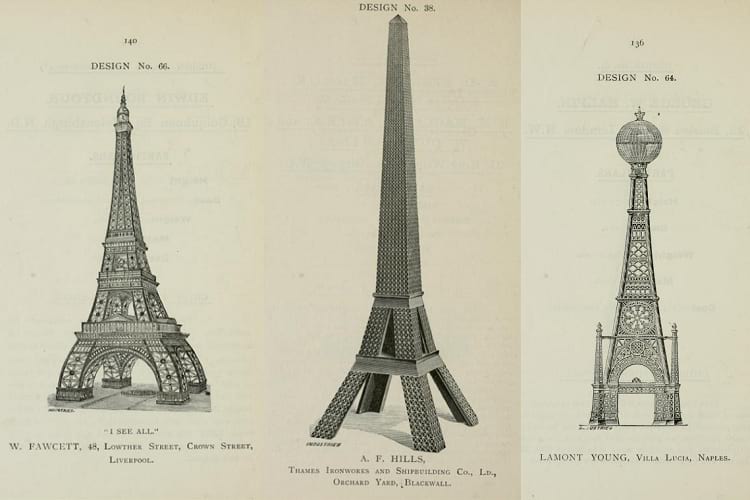
Three proposed designs for The Great Tower for London (1890) among the 68 entries. (The Getty / Lynde, Fred. C.)
“One tower, twice the height of Eiffel’s and costing a projected £1m, was modelled on the Tower of Pisa, without the leaning. One involved “a captive parachute (to hold four persons)”, another had a spiral railway winding round its shell. One was a vertical village, containing flats, offices, pubs, courts and a library. Another, incorporating a temple and a 1/12th-scale model of the Great Pyramid of Giza, was conceived as a colony of aerial vegetarians, who would grow their own food in hanging gardens.”
The suggested names mirrored the ambitious nature of the creation,
“Circumferentially, Radially and Diagonally Bound Tower, another the Muniment of Hieroglyphics Emblematical of British History During Queen Victoria’s Reign Tower. Both were soon eliminated, perhaps on the grounds of being unspeakable.”
Three men from London won the competition: Stewart, MacLaren and Dunn who devised an eight-legged beast double the amount of the Eiffel Tower. To assist in bringing their construction to life, Watkins formed the International Tower Construction Company. Benjamin Baker was at the head – an engineer with an impressive portfolio – one of the brains behind the famous Forth Road Bridge in Scotland and the Aswan Dam in Egypt which protects the Nile River from flooding.

Watkin’s Tower winning design by Stewart, MacLaren and Dunn. (A.D. Stewart, J.M. MacLaren, W. Dunn)
Inside Watkin’s Tower
In 1891, construction started and the plans were in the place for a tower packed with lavish amenities. It would have an extra floor compared to the Eiffel tower.
“It encompassed restaurants, shops, promenades, Turkish baths, a theatre, a meteorological office, a sanatorium, a science lab and, on top, an observatory, “because freedom from mists at that altitude would mean the stars could be clearly photographed”. The park would have a boating lake and a waterfall.”
Problems arise
The park became a powerful attraction and droves of crowds started to appear even before the tower had been finished. After the first stage took shape however there was already sinking signs of subsidence. This was due to cutbacks, bringing the tower down from eight legs to four for example to save some money. This was brought about by Watkins retiring due to ill health and public funding, which was needed for the tower. Watkins had hoped to receive funding from the government but was denied. Subsequently, the company went into liquidation in 1899, Edward Watkins passed away two years later and the remnants of his masterpiece were completely destroyed by 1904.

Watkin’s tower under construction. (Unbekannter Fotograf)
Legacy
Wembley Park still flourished after these events mainly due to the various amount of sports clubs within its grounds. The International Tower Construction Company became the Wembley Park Estate Company as they turned their attentions to residential projects to improve their fortunes and recoup their losses. Ultimately, Wembley Park became one of the most famous areas in Britain and its primary attraction known the world over. This is the British Empire Exhibition Stadium – the company who bought the land from Metropolitan Rail – or rather, what would later become Wembley Stadium. At its conception, the venue built on the foundations of Watkin’s Folly held 125,000 people. It has since hosted the 1948 and 2012 Olympics with the underground station introduced by Watkin still proving to be a much used and integral hub.
His legacy was initially remembered by a local bar and restaurant – quite literally – named Watkin’s Folly. Although perhaps apt to the name also is the fact that the amenity was closed down in 2018 to reflect the fate of the tower.
Even if his own failed, Watkin led the way for other towers to be built such as Blackpool Tower in 1894. It is the beacon of a place many consider to be the Las Vegas of England.

Blackpool Tower. (Nathanemmison / Wikimedia Commons)
Watkin was a pioneer for these grand-scale creations which have taken the world forward in a technological sense. A truly ambitious man, growing up with wealth was simply a catalyst for a lifetime of amazing achievement.
Enjoyed this article? Also, check out “Lake Reschen: Italy’s Submerged Lake Reschen“.
Recommended Visit:
Blackpool Tower, England
Fact Analysis:
STSTW Media strives to deliver accurate information through careful research. However, things can go wrong. If you find the above article inaccurate or biased, please let us know at [email protected].
RELATED
The post Watkin’s Tower: London’s Failed Eiffel Tower appeared first on .
]]>The post Andrée’s Arctic Balloon Expedition of 1897: A Peek into the Doomed North Pole Flight appeared first on .
]]>
Photo of the fallen balloon taken by a member of the ill-fated expedition. (Nils Strindberg / Wikimedia Commons)
Is it feasible to fly over the North Pole? Yes, says Quark Expeditions, which has been specializing in hot air balloon expeditions to the Arctic and the Antarctic for over 25 years.
But, that was not possible in the 19th-century. During the second half of that century, Arctic exploration was considered to be gruesome. Sheets of floating ice had throttled several creaky ships; men simply vanished into the silence of the white wilderness.
Author of Ice Balloon, Alec Wilkinson, wrote in the book that of the 1,000 people, who attempted to go to the North Pole after the 1850s, at least 751 died.
The elusive North Pole

American explorer Rear Admiral Robert Edwin Peary Sr. (Robert Peary / Wikimedia Commons)
In spite of this grave situation, the race to reach the North Pole was still open in the 1890s. Some of the explorers who attempted but failed to reach the pole include Rear Admiral Robert Edwin Peary Sr of Pennsylvania, United States.
Another person was Sir John Franklin of Lincolnshire, UK. Sadly, an international row erupted after relics from the doomed Sir Franklin’s expedition were taken without any permission from Canada’s Inuit people.
The third person was Fridtjof Nansen, a Norwegian explorer and a Nobel Peace Prize laureate. However, not one of them ever thought of travelling to the pole on a hot air balloon.
This kept the North Pole elusive for several decades. So much so, people of that era did not know whether the pole lay on sea or land.
Inspired
It was then that a Swedish aeronaut named Salomon August Andrée had a brilliant idea. He thought as attempts to reach the North Pole by ship and sledge failed, why not fly over the pole? He further got inspired by the hot air balloon idea after a discussion with explorer A. E. Nordenskiöd sometime in 1894.
History

Salomon August Andrée. (Wikimedia Sverige)
In 1854, Andrée was born in Gränna, a small town 483 km southwest of Stockholm. He did his engineering course at the Royal Institute of Technology in Stockholm. During his student days, he conducted experiments in aero-electricity in the Arctic and geomagnetism. Later, he got a job in the Swedish Patent Office.
Andrée was a wiry, but intense Swede. Being constantly supercharged with energy, he was only 22 when he had his first encounter with balloons at the Philadelphia World’s Fair. Thus, began Andrée’s journey in the study of aeronautics.
In 1897, Andree enlisted the services of two persons as crewmen. They were Nils Strindberg and Knut Hjalmar Ferdinand Frænkel. Strindberg, a Swedish photographer and he were enlisted to make a photographic aerial record of the expedition and arctic region. And, Frænkel was the author of Andrée’s story.
The preparation
Author Wilkinson wrote that the explorer’s ability to study the weather perhaps encouraged him to reach the North Pole within 2 and half days. Wilkinson further wrote that Andree aimed to descend in San Francisco after flying over the pole in the hot air balloon.
During the late 1800s, balloons were being used for years. At that time, balloons could stay afloat for about 15 days in a stretch. However, Andrée desired to double that feat. For this, he invented newer contraptions that could permit his hydrogen balloon ship to travel “at cross purposes” to the wind.
Layers of varnished silk were used to make Andrée’s hydrogen balloon, which was made in Paris. The balloon measured 100 ft high and weighed over a tonne.
The flight
With the support of King of Sweden and Alfred Nobel, Andree took off on July 11, 1897, in the balloon. The lift-off was from one of the islands within the Spitsbergen archipelago. This was his second attempt to fly after his first attempt failed some months back.

Andrée and his crew, moments before take-off. (Wikimedia Commons)
The North Pole was approximately about 965.606 km from the island.
Soon after the balloon lifted off, Andree lost the heavy ropes that got tangled. With the result, Andree got stuck in the balloon that he no longer had any control on.
As soon as Andree’s craft flew into the yonder, he and his teammates became the first people to be ever lost during a flight.
Mystery solved
Thirty-three years later, a group of sealers surprisingly discovered the frozen bodies of Andree and his men at their last camp. Along with the frozen bodies, the sealers also found diaries and unexposed films that solved the mystery of what happened to the three adventurers.
The diaries revealed details of the death march across the ice. Professor John Hertzberg was the person who managed to develop the film from Nils Strindberg’s camera. After being developed, the films gave a vivid description of the expedition and brought the explorers back to life.
What really happened?
The diaries revealed that Andree and his team did not reach the North Pole. Actually, they flew for three days and ran into trouble due to fog. The fog cooled the hot air gas balloon forcing the craft to descend on to the icy wilderness. As a result, from being excited explorers they became forced adventurers overnight.
Forced by unexpected circumstances, the three adventurers embarked on a punishing journey on a drifting polar ice pack. For two months, they camped on an ice floe, which is a sheet of floating ice that is smaller than an ice field.
The three survived on food supplies that lasted for several weeks. When their rations ran out, they survived on ivory gulls, polar bears and seals.

Members of the expedition with a freshly killed polar bear. (Wikimedia Commons)
For the first time since landing on the ice floe, they sighted land in the form of Kvitøya (White Island). The adventurers used the three sledges and a boat they had to cross over to White Island. There, they planned to build a stronger camp to face the winter. The idea was to wait until springtime and continue their journey.
Death
It continues to be a mystery as to when Andree and his men died. However, it appears that they died within a few days of landing on Kvitøya. From information gathered from the tragic site, it is clear that they did gather materials to build a strong shelter for themselves. They, however, never used the material. In fact, they did not even unpack the boat and the sledges.

Members of the expedition being brought back after their discovery. (Wikimedia Commons)
Funeral
The Swedish finally rejoiced that one of the greatest mysteries of the Arctic region was solved.
The mortal remains of the three explorers-turned-adventurers were finally brought to Stockholm on October 5, 1930. The Swedish nation mourned as the funeral took place in a solemn manner.
Thus, came to an end the endless love of discovery and human drama.
Enjoyed this article? Also, check out “1959: What Really Happened at Dyatlov Pass?“.
Fact Analysis:
STSTW Media strives to deliver accurate information through careful research. However, things can go wrong. If you find the above article inaccurate or biased, please let us know at [email protected].
RELATED
The post Andrée’s Arctic Balloon Expedition of 1897: A Peek into the Doomed North Pole Flight appeared first on .
]]>The post The Tragedy of Jallianwala Bagh appeared first on .
]]>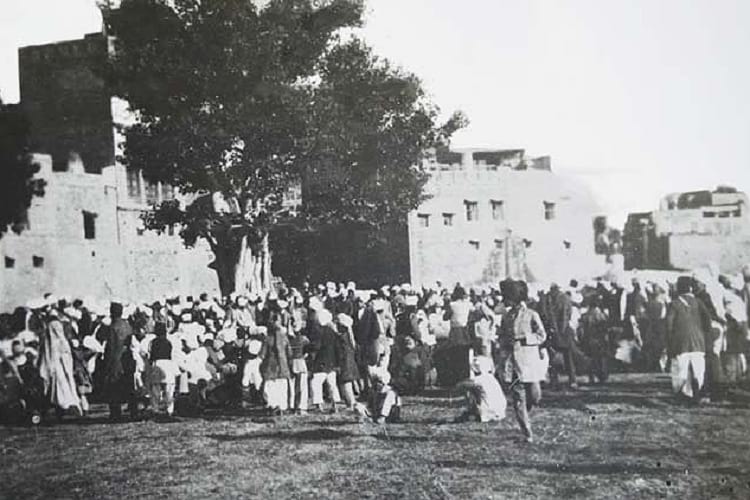
A crowd gathered at Jallianwala Bagh during Motilal Nehru and Pandit Madan Mohan Malaviya’s visit in the late summer of 1919. The meeting is taking place at the same spot as the platform was located on 13 April. (© Penguin Random House India)
The British ruled India for 89 years, from 1858 to 1947, and, while they did have their civilized moments, their rule was marked by wholesale pillage of the once vibrant Indian economy and a callous disregard for the lives of the people they had subjugated. Mr Wagner’s book focuses on an incident that stands out starkly for its sheer brutality in this dark period of Indian history – the massacre that took place in Jallianwala Bagh in Amritsar, Punjab, on 13 April 1919.
On Colonel Reginald Dyer’s orders, the troops from the 59th Sind Rifles, the 54th Sikhs, and the 2-9th Gurkhas entered through the main entrance of Jallianwala Bagh and, taking up position on a high earth bank, fired at point-blank range on their own countrymen. The people gathered in Jallianwala Bagh did not stand a chance, enclosed as they were in the walled Bagh and targeted with indiscriminate firing from guns with .303 ammunition.
“The wounds inflicted by the .303 ammunition had been devastating – at a distance of less than 600 feet, and what was at first practically point-blank range…”

The entrance to Jallianwala Bagh through which Dyer and his troops entered. The photograph shows the southern end of the Bagh, and the small shrine with its onion dome is visible on the left, while the part of the wall to the right is still to be seen at the memorial. Amritsar. (© Penguin Random House India)
The bullets ricocheted from the walls, pierced through people to hit the ones behind them, fragmented to injure all those close by, and even wounded and killed people living in the upper levels of the houses around the area. Many in the neighbourhood initially mistook the firing for fireworks. Of course, the pockmarks appearing on their houses soon wised them to the situation.

Locals inspecting bullet-holes in the southern wall, behind the shrine, in late 1919. This part of the wall no longer exists but would have been just to the left of the palm tree visible in other images. (© Penguin Random House India)
Nobody knows exactly how many people died on that horrendous day. The British afterwards gave out a rather low figure of 379 dead and 1,100 wounded, but the truth of the matter is they never bothered to make a serious count. According to eyewitnesses and the enquiry carried out by Madan Mohan Malviya and Motilal Nehru in the summer of 1919, the number was 1,000 dead and 1,500 wounded. In addition to those killed in the Bagh itself and its outskirts, many more succumbed later to their injuries, and many others suffered life-long from the injuries and the trauma of that day.
‘Jallianwala Bagh: An Empire of Fear and the Making of the Amritsar Massacre’ by Kim. A. Wagner, published by Penguin Random House India Private Limited, is concerned with the shooting and its aftermath, as recounted by those that lived through these events.
The Survivors of Jallianwala Bagh
When the troops finally withdrew from the Bagh, they left behind piles of dead bodies and scores that were dying or wounded. The dead included children as young as three. The Bagh was strewn with people’s belongings.
“After the soldiers had left, I looked round [. . .] There must have been more than a thousand corpses there. The whole place was strewn with them. At some places, 7 or 8 corpses were piled, one over another. In addition to the dead, there must have been about a thousand wounded persons lying there.”
It looked like a devastated battlefield, according to Lala Karam Chand, who survived by hiding in the Hansli drain.
Another survivor, Sardar Partap Singh, went to the drain to get water for a dying man and found dead bodies floating in the drain.
As dusk fell and the news of the shooting spread around the city, the local people hurried to Jalianwala Bagh to search for missing relatives and friends. It was a difficult, painful task that required them to turn over the dead and disturb the dying to find their loved ones. The bullet-ridden bodies had horrific injuries, with eyes and noses shot off, faces smashed, heads split open, chests and backs gaping open, and limbs blown off. It was here, in such a state, that Lala Gian Chand found his 17-year-old nephew Ram Labhaya.
Giridhari Lal, who went looking for his friend Hakim Singh and some young neighbourhood boys, recounted seeing an equally gruesome spectacle. To him, there appeared to be over 1000 dead bodies spread out around the Bagh.
It was getting close to the 8 p.m. curfew and people, afraid of being subjected to another shooting, began hurrying back to the relative safety of their homes. The dead and many of the wounded were left behind, and even though the people in the neighbourhood could hear the wounded moaning in agony and crying for water throughout the night, they didn’t dare to go out to help them.
“While the British authorities in Amritsar and Lahore had been busy throughout the night, the dead remained abandoned and exposed inside Jallianwala Bagh.”
Few of the shell-shocked people had the courage to ignore the curfew and one of them was Ratan Devi. She had spent the evening searching for her husband and it was dark by the time she finally found his body amongst a pile of other bodies. As all the other people in the Bagh had already left by then, she knocked on nearby doors and asked the people living there to help her move her husband’s body. When they all refused, she returned to the Bagh and spent the night at her dead husband’s side, weeping, chasing away dogs with a bamboo stick, and trying to comfort a dying 12-year-old boy.
A City in Mourning
“‘There was nobody present there, to register the number of the dead persons. Within one hour of our arrival in Durgiana, about 70 more dead bodies came for cremation, and others were following.’”
The following day, 14 April, was the day of the traditional Baisakhi Fair. A day to celebrate the harvest. Instead of celebrations, the people of Amritsar held cremations and burials. From dawn until dusk, at the Hindu Durgiana temple near the Lohgarh Gate and at the Muslim burial ground outside the Sultanwind Gate, the processions of the dead continued.

The north-eastern side of the Bagh, with the main entrance on the far left. The people in the photograph are standing on the earth bank from which Dyer’s troops fired. (© Penguin Random House India)
It will be 100 years this April since the Jallianwala Bagh Massacre, but Mr Wagner’s matter-of-fact writing brings the deeply disturbing events alive as though it might have been yesterday. It is still difficult to make sense of the tragedy. While Rudyard Kipling did later claim that Colonel Reginald Dyer ‘did his duty as he saw it’, it seems a quite a worthless duty that calls upon anyone to murder their fellow human beings in cold blood and destroy so many scores of families.
For more details, read the book:

Jallianwala Bagh: An Empire of Fear and the Making of the Amritsar Massacre | By Kim A. Wagner
RELATED
The post The Tragedy of Jallianwala Bagh appeared first on .
]]>The post Ugly Law: When the US Banned Unsightly Individuals from Coming Out in Public appeared first on .
]]>
Artwork of three ugly men. (Wellcome Collection)
Laws are meant to protect the society from crimes and misdemeanours, but believe it or not there were certain laws back in history, just created to deprecate the disabled and the underprivileged people in the US and elsewhere.
History has records of some of the strangest laws implemented to denigrate the lower sections of the society, known as the “Ugly Laws”. Unfortunately, some societies have gone beyond their limits to create some stringent laws to maintain the norms of society.
From the mid-1700s to the 1970s some of the well-known cities of the world had prevalent public laws meant to subjugate the underprivileged class who were rendered pariah and considered “useless” for the society.
In 1881 Chicago alderman James Peevey declared one of these ridiculous laws, in which the diseased, blind, maimed, blind and mutilated were prohibited from making any public appearances. Since the late 19th century to the 20th century physically impaired people were restricted from begging on streets as they were believed to bring upon “shame to the society”. Similar laws were also prevalent in the Philippines and the United Kingdom when disabled people were restricted from making public appearances.
Term ugly law
The term “Ugly laws” was first ever coined by disability activists and authors Maria (MARCIA) Pearce Burgdorf and Robert Burgdorf. These ugly laws depict the harsh reality of the deeply rooted evils of the society which existed in earlier days.
In a book written by Professor Susan M. Schweik, we get a glimpse of how these bizarre laws depicted the conditions of disability and how the cultural influx from different nations put pressure on the existing communities and followed by lack of resources and infrastructure to support the new residents.
This left the new members impoverished as they were forced to share space and resources with the erstwhile residents and thus relegated to the status of “unwanted people” whose presence in public was considered inappropriate.
Responding to the abrupt increase in the population poor people the local officials, ministers, charitable organizations and city planners across the US were compelled to draft ugly laws to control these downtrodden people.
Effect of ugly laws
These queer ordinances imposed the strict adherence to unwanted exposure of disabled, distorted, amputated or unsightly parts of the body.
Chicago is said to be the origin of the ugly laws, though San Francisco later earned the dubious distinction to first promulgate the ugly laws in America. Inspired by this action these laws were later implemented in different parts of the country.
Citing the Ugly law clauses, Chicago alderman James Peevy was quoted in the Chicago Tribune of May 19th, 1881 as saying, “Its object is to abolish all street obstructions.”
New Orleans, Louisiana first enforced its ugly law in the year 1883, whereas Portland Oregon enacted its ugly law in 1881. Similar laws were enacted in Ohio, Pennsylvania, Nebraska which identified groups of people in public deemed as “unsightly” and “undesirable”.
Interestingly an attempt to introduce ugly laws failed in New York in the year 1895.
Ugly law enforcement
People condemned by ugly law were either sent to jail or were charged a fine until they could be employed in a poorhouse or work farm.
The Chicago ordinance passed in 1881 elucidates the ugly law as follows: Any person who is diseased, deformed or mutilated in any way, making an unsightly public appearance in streets, highways or thoroughfares will be charged with a fine ranging from $1 to $50 and could even be incarcerated under severe cases.
In an analysis of the Ugly Laws, Susan Shweik points out how individuals are discriminated on basis of their work status and physical characteristics and how a disabled person is subject to character assassination, easily tagged as a fraudster, bankrupt, diseased and socially unacceptable.
One of the most ghastly incidents of the Ugly Law saga goes back to 1902 when the Chicago Police department declared war on its “beggar fraternity” by pouring acid on them leading to permanent damage so they eventually diminished from the public.
Around the entire 19th century an ongoing debate gripped the nation on who was worthy of the charity. It was a clear contest between widows-orphans and able-bodied paupers. Some felt that the disabled beggars didn’t deserve state assistance.
End of the ugly war
It was by the end of the 1st World War that the outlook towards the disabled started to change. As people returned from battles with their limbs broken and minds scarred, a more holistic approach was adopted towards the limbless unfortunates. New rules were established for the recovery and rehabilitation of war veterans. Bans on jobs for the physically impaired was lifted.
By 1950s arrests and public humiliation of disabled people was banned. The 1960s and 1970s witnessed the ordinance drafted for the protection of rights disabled and more accessible to cities. A ray of hope emerged in 1990 when finally the federal American with Disabilities Act was enacted.
Enjoyed this article? Also, check out “Development of the Eugenics Movement in the United States“.
Fact Analysis:
STSTW Media strives to deliver accurate information through careful research. However, things can go wrong. If you find the above article inaccurate or biased, please let us know at [email protected].
RELATED
The post Ugly Law: When the US Banned Unsightly Individuals from Coming Out in Public appeared first on .
]]>The post History of Pinewood Hospital: The Sanatorium for Treating Tuberculosis in the United Kingdom appeared first on .
]]>
Pinewood Hospital. (Unknown)
Pinewood Hospital was a hospital in Berkshire in England that started as a sanatorium for tuberculosis patients in 1901. During the two World Wars, it also treated injured soldiers. In the 1950s, with tuberculosis becoming less prevalent in the UK, the hospital began taking in patients with cardio-thoracic problems. It closed doors in the 1960s.
The scourge of tuberculosis
One of the earliest mentions of tuberculosis was in the Huang TiNei-Ching, a Chinese medical text from the third millennium BCE, but the disease has existed since more ancient times. Researchers have discovered traces of the disease in Neolithic bones.
From antiquity to the present day, it has remained a widespread and dreaded disease.
In the 17th to 19th centuries in the United Kingdom, the public knew it more commonly as consumption and the doctors considered it both an inherited and communicable disease. Another common term for it was the white plague on account of the pallor it cast on patients and literary figures like Percy Bysshe Shelley, Lord Byron, John Keats, Emily Bronte, and Robert Louis Stevenson gave it an unwarranted and nonsensical air of romanticism. These people actually thought there was something “ethereal” and attractive about looking pale, wasting away, and coughing up blood.
Until the discovery of antibiotics, there was no cure for tuberculosis and doctors attempted to treat it with isolation, rest, and time spent in the fresh air.
This was something the rich patients could afford to try. For the poor folks, there was no other course than to suffer in utter wretchedness until death finally relieved them.
Origin of pinewood hospital
The idea of creating a sanatorium for ordinary English citizens came about in 1898 when the Prince of Wales met with the National Association for the Prevention of Consumption at Marlborough House.
On 22 July 1901, the National Association for the Prevention of Consumption opened the London Open Air Sanatorium to treat tuberculosis patients in Pinewood, an area near Crowthorne in Berkshire in England. Pinewood was an 82-acre area with an abundance of pine trees, and these pine trees were the main reason that the association members chose the land when they were looking for a suitable site for a tuberculosis sanatorium. At the time, many medical experts believed that breathing in pine-scented air was beneficial to the lungs and would help in curing tuberculosis.

The pinewood sanatorium. (unknown)
The London partners of the firm of Messrs. Wernher, Beit and Co. financed the sanatorium project for 40,000 pounds in return for an annual interest of two and a half percent, and the sanatorium committee decided to charge the patients three guineas for a week at the sanatorium.
The buildings of the London Open Air Sanatorium
The red-brick, red-tiled sanatorium buildings consisted of isolated and south-facing, two-storey bedroom blocks for the patients that were on either side of a central administration building. The independent dining block for the patients, doctors, and the other staff was behind the administration building and behind it were the kitchen and the quarters for the sanatorium’s servants. Behind that was the isolated laundry with a disinfectant system to sterilize all the sanatorium’s washing.
The two separate bedroom wings had 16 rooms on each floor, making a total of 64 rooms. The first 64 patients that came to the sanatorium were all male and presumably well-off enough to be able to afford the three guineas per week charge for living there and receiving treatment from the sanatorium’s experienced doctors. The rooms had large windows to let in plenty of light and air. The building designers took particular care in rendering the building’s woodwork and stairs in a very plain fashion in order to prevent any dust accumulation.
All the buildings had electricity.

The pinewood sanatorium, 1910. (unknown)
Pinewood sanatorium
In 1913, the British parliament passed the Public Health Act and authorized the Metropolitan Asylums Board to treat London’s poor and others who were suffering from tuberculosis. Towards this end, in 1919, the Metropolitan Asylums Board took over the London Open Air Sanatorium and renamed it Pinewood Sanatorium. They increased its capacity from 64 beds to 160 beds by building prefabricated dormitories on the sanatorium’s grounds.
They encouraged patients to spend as much time as possible in the open air under the pines, and they urged patients, who appeared to be recovering, to participate in more active pastimes like tending to vegetables in the garden and sweeping the garden paths.
Pinewood sanatorium during the World Wars
During the First World War, Pinewood Sanatorium opened its doors to also treat ill and injured soldiers from the war front. They took particular care of the soldiers that had survived gas attacks in the trenches.
After the Second World War broke out, the hospital once again treated sick and injured soldiers. The Canadian Red Cross set up its base at the hospital and built several wooden huts to accommodate the increasing stream of war-injured patients.
Pinewood Hospital in the after-war years
In 1954, Norah Henriette Schuster, the first female doctor to receive a hospital appointment in the UK, came to work at Pinewood Hospital and set up a pathology lab in one of the still-standing wartime wooden huts. It was Pinewood Hospital’s first pathology lab. By this time, the hospital was taking in fewer and fewer cases of tuberculosis patients as the use of antibiotics since 1944 had done a remarkable job of nearly obliterating the disease from the UK. That being the case, the hospital now saw more cases of people with thoracic diseases, aspergillosis, bronchitis, and other similar problems.
By 1960, Pinewood Hospital was treating more bronchitis patients and even had a 230-bed ward for them and specialist doctors at hand to treat them.
Closure of pinewood hospital
Pinewood Hospital closed in 1966. The sanatorium buildings no longer stand on the site, although some of the wooden huts are apparently still there.
Resurgence of tuberculosis
When medical researchers discovered that antibiotics were effective against tuberculosis, few people could have imagined that the dreaded disease would make a comeback and in a more malignant form. It rebounded in the 1980s with drug-resistant strains and, by 1993, its reach extended rapidly enough around the world for the World Health Organization to consider it a matter of global health emergency. Researchers estimate that there are around 500,000 cases of drug-resistant tuberculosis around the world every year and the numbers are steadily increasing.
Enjoyed this article? Also, check out “The Rise and Fall of the Victorian Era Creepy Therapeutic Treatment Called Electric Bath“.
Fact Analysis:
STSTW Media strives to deliver accurate information through careful research. However, things can go wrong. If you find the above article inaccurate or biased, please let us know at [email protected].
RELATED
The post History of Pinewood Hospital: The Sanatorium for Treating Tuberculosis in the United Kingdom appeared first on .
]]>The post Project Riese: Hitler’s Shadowy Incomplete Underground Complex that Remains a Mystery appeared first on .
]]>
Project Riese: Unfinished tunnel in Owl mountain range. (chained / Wikimedia Commons)
Project Riese refers to a mammoth network of unfinished underground tunnels in Lower Silesia region of Germany (now under the modern day territory of Poland). The construction work was flagged off on Hitler’s order in the month of April 1943.
The underground structures lie eighty kilometers towards the south of Wroclaw in mountainous ranges of Poland’s Owl Mountains. There are many unanswered questions and myths associated with the series of tunnels concerning the reason behind the construction, the manpower behind it, the engineering expertise and why it was left unfinished in 1945.
Project Riese: A giant venture
‘Riese’ is a German word for giant – the name itself suggest the magnanimous stature of the world famous construction project. Project Riese comprises – a series of fortified tunnels spread over 5.5 miles (9 km) close to the Walbrzych, a town in Poland built inside the Owl Mountains.
The tunnel has seven large underground structures located in the hard rocky landscape of Owl Mountains among which Ksiaz Castle was supposed to be one of the prime headquarters of the Nazi supremo.

Książ Castle. (Jar.ciurus / Wikimedia Commons)
The tunnel network was probably built to move armaments, important offices and official documents to underground places safe from the sudden aerial attacks of the Allied Forces. Documentations have been lost or destroyed to justify this intention.
Who spearheaded the project?
The secret venture was assigned to the efficient leadership of Albert Speer, the Nazi Minister of Armaments and War Production. A new company called the Silesian Industrial Company was created to carry forward the project that comprised of the 7 bunker complexes:
• Książ Castle
• Complex Wlodarz
• Complex Sobon
• Complex Osowka
• Complex Sokelec
• Complex Rezeczka
• Complex Jugowice

Albert Speer showing the project to Adolf Hitler. (German Federal Archives)
Out of all the tunnels, Complex Wlodarz has the highest number of tunnels bored underneath. Few have a concrete finish but most of them have been left abandoned in its natural state. The longest and the most fascinating complexes available for tourist’s viewing is in Osowka. The plan was to convert Osowka into a city that could house more than 20,000 Nazi troop members and workers. Out of the 7, only 3 are open for public viewing – they include Osowka, Wlodarz and Rezeczka.

Map of the tunnel. (Les7007 / Planiglobe)
The accounts of the workers at underground shelter construction sites
Project Riese took the lives of many– the workers were forced to work in wretched condition. Prisoners of war (POWs) from Italy, Russia and Poland, prisoners of Auschwitz concentration camps and also children were forced to work as labourers.
There were 13,000 labourers appointed to do the digging job and the tasks of building roads and air ventilation systems. Many succumbed to death due to exhaustion, malnutrition and typhus endemic disease. The death count was 5000 and 14 were executed since they made an attempt to escape.
The construction work was highly exhausting because the Owl Mountains is made of impenetrable, hard rock gneiss.
So what exactly have researchers found?
Seven underground sites is not an easy task to excavate. In fact, only 1,00,000 cubic meters of the total 2,13,000 cubic meter space of Project Riese has been found so far. Some of what was found has been left open for public display for tourists in Walim-Rzeczka, Włodarz and Osówka.

Complex Rzeczka. (Przykuta / Wikimedia Commons)

Complex Włodarz. (Dariusz Cierpiał)

Complex Osówka. (Chmee2 / Wikimedia Commons)
Amongst the many things, archaeologists found an abandoned painted gate that was supposed to trick people, a gun, and a giant hall with a construction track. To top that an old winch, munitions carts, a paint inscription that read “Riese”, solid arches, barracks and other wrecks in a basement.
This is just a gist of the number of things that have been dug out. A structure known as the Fly Try was also found in an external above ground area. The existence of this structure has also been backed by a number of theories. The one theory that received a lot of limelight was that it was meant to produce an anti-gravity state.
Abandoned places now turned a museum
The charm of the abandoned places attracts adventure lovers. The primitive paint, although showing signs of peeling out, camouflages the entrance of the bunkers. The design of the underground bunkers preserves the unfinished look and feel. The guns and munitions carts on primitive, narrow gauge railways tracks are kept as it is, giving the place an eerie feel. The old pipes and ventilators are still there. People are amazed to witness such measures that prepared Nazi men to safeguard themselves against possible poison gas attacks by the Allied enemies.

Tourist at Complex Osówka. (Chmee2 / Wikimedia Commons)
The changes have been kept nominal with the addition of health and safety measures for the tourists who come to visit once-a-tunnel-complex-turned-museum. But, not all bunkers are accessible; only a few of them have been concretized, proof of the fact that the project came to an abrupt halt in the month of May 1945 due to the approach of the Red Army. Interestingly, Adolf Hitler died the month before by committing suicide. The death of the commander drove the nail in the coffin.
The 73-year-old underground bunker complexes of Riese seem to hold within itself some of the top, secretive stories of one of the largest, secret construction projects of the Nazi.
Enjoyed this article? Also, check out “Schwerer Gustav: Why the Largest Artillery Gun Turned Out to Be a Flop During World War II?“.
Recommended Visit:
Underground City Osówka | Poland
Fact Analysis:
STSTW Media strives to deliver accurate information through careful research. However, things can go wrong. If you find the above article inaccurate or biased, please let us know at [email protected].
RELATED
The post Project Riese: Hitler’s Shadowy Incomplete Underground Complex that Remains a Mystery appeared first on .
]]>The post Children of Llullaillaco: Where Young Children Were Sacrificed to the Gods appeared first on .
]]>
The extremely well-preserved body of La Doncella and her ornaments. (Photo: Dr. Johan Reinhard / Used With Permission)
The continent of South America is home to one of the greatest indigenous civilizations in human history. The Incas of Peru, who gave the modern world one of the new seven wonders – Machu Picchu – have perhaps been the most inexplicable people to ever walk the earth. Their ways of living, their age-old practices and the monuments they built during their reign, have all been subjects of great intrigue among commoners. And as archaeologists and researchers keep delving deeper into the olden civilization, which existed between the 1200s and 1500s, the more mysteries keep tumbling out of their closets as days pass. One such oddity was the religious sacrifices of children that were carried out during the Inca Empire.

La Doncella or “The Maiden” being examined by researchers after her discovery. (Grooverpedro / Flickr)
Discovering the mummies of children
In a startling discovery made in 1999, Dr. Johan Reinhard and his team of archaeologists stumbled upon ancient, well-preserved mummified bodies of three children, which dated back to more than five centuries ago. At the peak of Mount Llullaillaco, a dormant volcano bordering Chile and Argentina, inside a tomb-like structure, the mummies of Children of Llullaillaco, as they have been named, were found, thus bringing a spine-chilling Inca ritual to the fore.

Left: Dr Johan and his team (in the background) after discovering the Mummies of Llullaillaco, 1999. (Johan Reinhard / Wikimedia Commons) Right: The site where the mummies were found. (Christian Glass / Wikimedia Commons)
As per the disturbing religious custom, commonly known as capacocha, young individuals from Cuzco, the capital city of the Incan Empire, were chosen as gifts for the Sun God Inti. Little girls and boys, probably the best among the lot, in terms of looks, statuses and health were handpicked, well-fed and taken good care of, weeks or even years before it was time for them to ascend the volcano hundreds of kilometers away, where superior priests made the supreme sacrifice.
As the chosen day drew closer, the children, as young as six years of age and a maximum of 16, were dressed in their best attires, adorned in fine jewellery and along with a hundred other offerings like gold, silver and various miscellaneous items, left near the summit of the titular volcano to be sacrificed. This ritual was undertaken during ceremonies like the passing away of the emperor or with a purpose to curb natural calamities or even please the gods.
As per Incan beliefs, it was an act of great honour to be chosen for the sacrifice, where after the children died; they would join their ancestors in the afterlife and look over the village as angels, keeping their kin from harm. Surprisingly, the sacrifices were ordered by the Emperor himself. Before the children began their journey towards their extreme end, they were presented before the monarch, who held a feast in their honour, as the chosen ones would be given up to the gods.
How were the dead bodies preserved?
Owing to the freezing conditions near the summit of the Llullaillaco volcano, the three excavated mummies of the children in question have been found very well-preserved. Not just their bodies, but their internal organs, too, were found to have been well-conserved, along with frozen blood in their hearts and lungs. With their hair intact and still braided and dresses as good as new, complete with fancy feathered headgears, their slightly shrivelled skin, which showed signs of some deterioration, were brought out for more scientific study and for a peep inside the Inca customs. The three mummies were named – La Doncella or The Maiden, El Nino or The Boy and La Nina or The Lightning Girl.

El Nino also known as “the boy” among the three children discovered. (Joseph Castro / Wikimedia Commons)
Children of Llullaillaco: Research and findings
As the study progressed further, scientists found telling evidence. The presence of alcohol and leaves of coca (from which cocaine is derived) in the mummies proved that the children were drugged before they were left out to die in the freezing temperatures near the summit of the volcano, while it also served as a substance that put them in a stupor, as they met their unsettling end. Researchers working on The Maiden used radiological data, X-Rays and CT scans, which revealed more information about the diet during the children’s final days.
During their last few months before the deadly ritual was executed, the children’s diet was slightly modified. A more high-fibre and protein-rich diet was fed to them, which consisted of vegetables and llama meat along with cobs of corn. This fattened them up, which helped them ascend the high altitude of the volcanic mountain without getting exhausted. Alcohol in the form of maize-beer was also given to them, which put them in a dazed state so that they lost consciousness during their last moments. Researchers also believe that some children were murdered by force if they resisted the sacrifice, as evident from traces of blood on El Nino’s clothes and his bundled up state. As per the scientists, there were no special efforts undertaken to preserve the bodies; the cold, thin and dry air near the volcanic peak worked its way on the three children.

Summit of Llullaillaco Volcano. (Lion Hirth / Wikimedia Commons)
While the eldest child among the three named La Doncella was 15-years old at the time of sacrifice, it appears that she froze to death while still in her sleep and her mummified body remains to tell her tale. Sitting cross-legged with a tightly-wrapped shawl around her coffee brown dress and striped sandals, the Maiden’s hair were woven into countless braids when she was found. In a new research in 2012, The Maiden was found to have contracted a virus, which caused a rare lung disorder in her. This fascinating discovery will also lead the scientists to study more about ancient diseases and extinct pathogens that caused illnesses among people that once lived. As per Dr. Reinhard, The Maiden’s body has been the best-preserved mummy, which is now put on public display at The High Country Archaeological Museum in Salta, Argentina. Researches and analyses are still being conducted on the other two mummies of the younger ones.

La doncella (the maiden) on display at Museum of High Altitude Archaeology. (Grooverpedro / Flickr)
While an agreement has been made between researchers and the local tribals to not dig up any more graves, as many as 40 ancient burial sites were discovered in various regions, which could otherwise have given a deeper insight into the fantasy world of the Incan Empire, where religious sacrificing of children was more an honour than anything else.
More Photos: Llullaillaco Mummies by Dr Johan Reinhard
Enjoyed this article? Also, check out “Rosalia Lombardo: The 8,000 Skeletons, 1,252 Mummies and a Fallen Angel Who Rest Within the Catacombs of Capuchin“.
Recommended Read:
Inca Rituals and Sacred Mountains: A Study of the World’s Highest Archaeological Sites (Monographs) | By Maria Constanza Ceruti & Johan Reinhard
Recommended Visit:
Museum of High Altitude Archaeology | Argentina
Fact Analysis:
STSTW Media strives to deliver accurate information through careful research. However, things can go wrong. If you find the above article inaccurate or biased, please let us know at [email protected].
RELATED
The post Children of Llullaillaco: Where Young Children Were Sacrificed to the Gods appeared first on .
]]>The post Whipping Boy: When Young Slave Boys Took a Beating for the Mistakes their Masters Had Committed appeared first on .
]]>
An illustration of a whipping boy. (Walter S. Stacey / Wikimedia Commons)
What can be the best way of showing loyalty and commitment to one’s master? Maybe to give one’s life in the line of duty. But could it also be taking the punishment for the fault of Master? That too not as a matter of exigency, but as a consistent and bounden duty? Seems strange and even disgusting. But that was the way of the Royal families of England during the 16th and 17th Century. The whipping boy’s story is that of a slave who suffered punishment on behalf of his master.
Proxy boys were close friends of the children in the royal family
The Tudor and Stuart Monarchs of England had a custom of keeping ‘whipping boy’, who, as the name suggests, took the beating if the Crown Prince committed any mistake. Whipping boys were no innocents picked up for this seeming injustice. They were buddies of the Royal Princes who lived with them and shared their noble privileges. As for punishing them on behalf of the Prince, the explanation given was that the Prince would suffer mental agony in the knowledge that his friend suffered for his (Prince’s) mistake. This searing thought would mend the Prince for future and reform his behaviour.
Proxy punishment was not tentative and baseless
What lay at the root of such indirect punishment? It was of the assumption that kings were the agents of God on the Earth. This was said in clear terms by James I in his Parliamentary speech in 1609. Hence, royal blood couldn’t be punished by ordinary mortals. The only person who could punish the Prince was the King himself but he was generally too busy to attend to family.
Who all patronized ‘whipping boy’?
The practice probably originated in the 16th century when Edward VI became king at the age of 10 years. The corporal punishment to the King was unthinkable even if he was an immature growing lad. So the practice may have begun as a safety valve for a boy monarch who couldn’t be punished but nevertheless had to be trained and sensitised to his mistakes. King Edward is said to have had two whipping boys. One Barnaby Fitzpatrick, an Irish. Another English boy named Edward Browne. But the contemporary information in support of this claim is lacking. William Murray is said to have served as whipping boy for Charles I in the 16th century and was profusely rewarded for his services. Louis XV of France too had a whipping boy in his childhood.
Conrad, King of Jerusalem and later of Italy (1228-1254), says history, was extremely mindful of his conduct as a growing child. Reason being he had a pack of 12 companions (whipping boys) who would suffer bodily punishment for any demeanour unbecoming of him. Richard Croke, mentor for Henry Fitz, 1st Duke of Richmond and Somerset (1519-1536) had complained against another tutor, George Cotton. The complaint, made in 1527, was that Cotton had withdrawn whipping boys engaged for the royal kid, saying it was inappropriate for Croke to punish them in Henry’s presence.
Idea of proxy physical punishment finds a place in literature too. The play ‘When You See Me You Know Me’ by Samuel Rowley describes the pain of a proxy of the future Edward VI. In one of his sermons, in 1628, John Donne preached that proxy punishment was good, but a sick or ailing proxy shouldn’t be punished. Malagrowther, a fictional character in Walter Scott’s Fortunes of Nigel (1822) is shown as the whipping boy of James VI of Scotland.
English origin of the custom doubted
David Norman Beach (1943-1999), the English historian was chary of accepting that such a custom ever existed. He wondered if it was a canard cooked up in Queen Victoria’s time (1837 to 1901) to defame their ancestors. He felt that the idea came from Stuart dynasty which succeeded Tudor dynasty (one of the best known in history) and thrived from 1603 to 1714 amid lots of tumult and turmoil. It is also likely that the idea of whipping boy (or something similar) came from dictatorial eastern monarchies (Persia, China, Egypt etc.) in ancient or medieval times. There are stories about children of pharaohs watching their playmate fed to crocodiles. The prince had not done his homework, hence his ‘whipping boy’ was thrown to crocodiles as a punishment.
The idea has a parallel in Bible stories
The 1530 Bible translated by William Tyndale talks of the Day of Atonement. On this day a goat was chosen to carry symbolic sin-load of the people. The priest laid his hands on the head of the goat and then it was let loose into the wilderness. It was believed that the sins of people got cast away along with the goat that walked into the wilderness. The word ‘scapegoat’ has originated from this background.
Idea ticks in spite of inadequate evidence
There is no clinching evidence to suggest that ‘whipping boys of the early English Period’ were an accepted and established norm. Yet, scattered references to it, or something similar, pop up in history and mythology. And these references are hard to ignore.
Enjoyed this article? Also, check out “Ota Benga: Tragic Story of the Last Known Human Exhibit at the New York Zoo“.
Fact Analysis:
STSTW Media strives to deliver accurate information through careful research. However, things can go wrong. If you find the above article inaccurate or biased, please let us know at [email protected].
RELATED
The post Whipping Boy: When Young Slave Boys Took a Beating for the Mistakes their Masters Had Committed appeared first on .
]]>The post The Seven Wonders of the Ancient World and the History Behind It appeared first on .
]]>The list was debatable and at least one of the listed place (Hanging Gardens of Babylon) was deemed imaginary and non-existent. The envy of man and fury of nature decimated all these ancient wonders except one – the Great Pyramid of Giza, Egypt.
In 20th century A.D., Swiss entrepreneurs Bernard proposed updating the ‘Seven Wonders’. With a hundred million votes gathered from the world over, the ‘Wonders’, announced on 7th July 2007 superseded the list of the ‘Seven Wonders of the Ancient World’ with the new official ‘Seven Wonders of the World’. Described below are the places/monuments included under these 2 headings respectively.
SEVEN WONDERS OF THE ANCIENT WORLD
The Great Pyramid of Giza

Great Pyramid of Giza. (Nina Aldin Thune / Wikimedia Commons)
The only existing monument from the ancient wonders, it was built between 2700 BC and 2500 BC. Actually, there are 3 pyramids located in Giza. These are: Khufu (Cheops), Khafra (Chephren) and Menkaura (Mycerimus). Khufu is the most colossal and magnificent of the three. It is made of 2 million stone blocks, each weighing 2 to 30 tons. Khufu was also deemed to be the tallest building of the world until the 19th century. The symmetry of the monument is astonishing considering archaic tools of those times. Log rollers and sledges were used to move massive stones.
Pyramids were tombs built for the royalty. Pharos and their queens used to be buried here along with provisions. It was believed that they would need those provisions in the after-life. Great hidden treasures have been unearthed by archaeologists from these pyramids. Most of this concealed wealth was also stolen and looted in course of time.
Hanging Gardens of Babylon

Hanging Gardens of Babylon. (Maarten van Heemskerck / Wikimedia Commons)
Ancient Greek poets described it as terrace plantation done by the Babylonian king Nebuchadnezzar II in 600 BC so that his lover Amytis doesn’t miss her home in Media (present day Iran). There being no first-hand account of it in Greek and Roman literature, the story missing in the written script of that time and no cogent explanation on how these gardens could be irrigated at such height put a question mark existence of hanging gardens. Most scholars believe that the Hanging Gardens were figments of poetic imagination and didn’t exist in the real world.
Statue of Zeus at Olympia
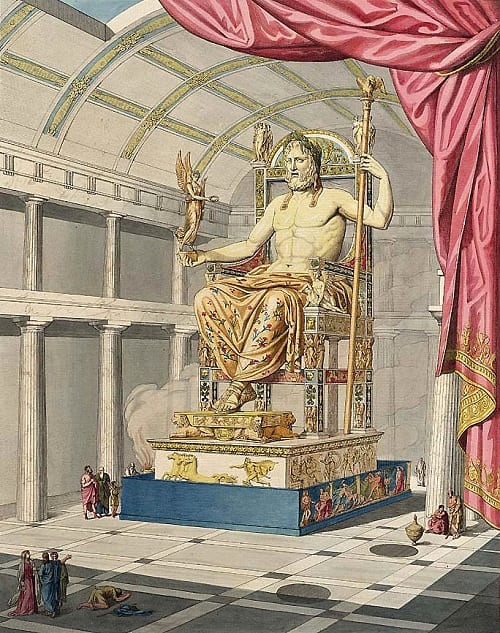
Statue of Zeus at Olympia. (Quatremère de Quincy / Wikimedia Commons)
Built by Athenian sculpture Phidis, this statue was installed in the temple of Zeus at Olympia (the ancient Olympic site) in 5th century BC. Richly embellished with gold and ivory, it shows god of thunder seated on a wooden throne. On his sides are sphinxes, the mythical creatures with head and chest of a woman, body of lion and wings of a bird. At forty feet tall, the statue nearly touched the temple roof. It remained in shape for more than eight centuries. In 4th century AD, Christian priests got it shifted to a temple in Constantinople, where it was destroyed in a fire in the 5th century A.D.
Temple of Artemis at Ephesus
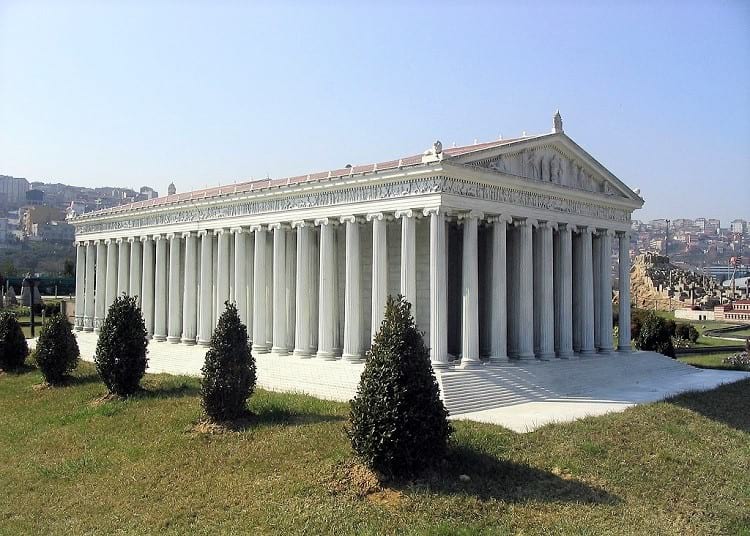
Replica of Temple of Artemis at Miniatürk Park, Istanbul, Turkey. (Zee Prime / Wikimedia Commons)
Artemis was worshipped as the goddess of the hunt, wilderness, wild animals and chastity in ancient Greece. A chain of alters and temples were built and rebuilt on her name at Ephesus (present-day Turkey). Two marble temples, first built in 550 B.C. and second in 350 B.C. were the best of the lot. The first temple caught fire on July 21, 356 B.C. It is believed the fire was coincident with the birth of Alexander the Great. The ravaged temple was replaced with new, only to be destroyed yet again by Ostrogoths in 262 A.D.
Mausoleum at Halicarnassus

Mausoleum at Halicarnassus. (Ferdinand Knab / Wikimedia Commons)
It was built by Artemisia, the Greek queen, for her husband Mausolus – who died in 353 B.C. Mausolus was also her brother. The grief-stricken queen is said to have drunk his ashes mixed with water and ordered the construction of the Mausoleum (grave). Made in pure white marble, it was a mixture of Lycian, Greek and Egyptian architecture. The grave, believed to be 135 feet high, was destroyed in a 13th-Century earthquake. The 1846 collection of the mausoleum ruins is kept on display in London’s British Museum.
Colossus of Rhodes

Colossus of Rhodes. (Nathan Hughes Hamilton / Flickr)
Built in the 3rd century B.C, it was a towering bronze statue of the Sun god Helios built by the inhabitants of Rhodes – a Greek Island. It took more than 12 years in the making and was erected in 280 B.C. For 60 years it stood as the tallest 100 feet effigy before an earthquake razed it to ground. A century later Arabs invaded Rhodes and sold off the remains of the ravaged statue.
Lighthouse of Alexandria
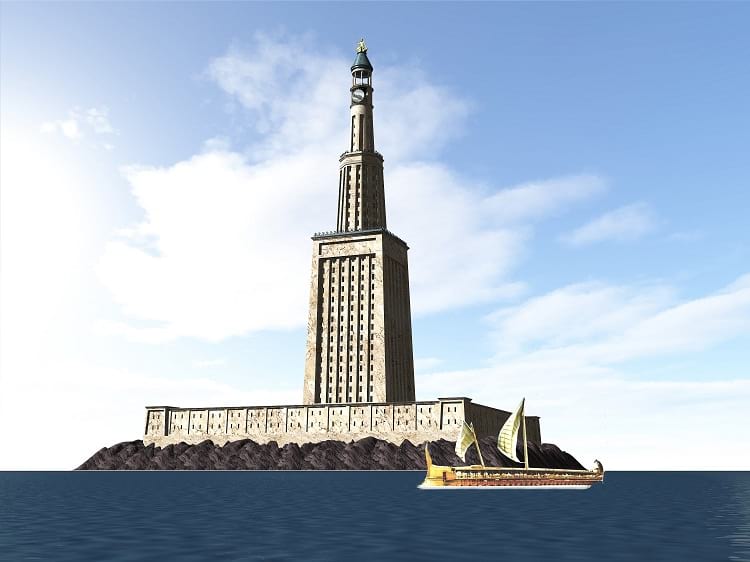
Lighthouse of Alexandria. (Emad Victor SHENOUDA / Wikimedia Commons)
About 380 feet high, this lighthouse guided ships in the Nile River. Built in 270 B.C., it was situated at Pharos Island close to the city of Alexandria in Egypt. The building, as reflected in pictures of it on ancient coins, had 3 tiers. It was square at bottom, octagonal in middle and cylindrical at the top. The top of building carried a 16-foot statue of Ptolemy II or perhaps Alexander the Great. Some remains of this lighthouse have been discovered at the bottom of the river Nile.
NEW OFFICIAL SEVEN WONDERS OF THE WORLD
The Pyramid at Chichén Itzá Yucatan Peninsula, Mexico
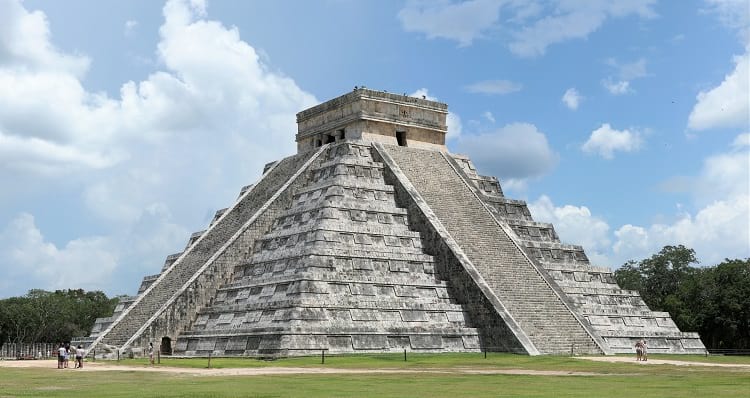
Chichen Itza. (Daniel Schwen / Wikimedia Commons)
It is a remnant of the Maya Civilization (1800 B.C. to 900 B.C.). The name Chichen Itza implies a large sinkhole or sacred cavern into which offerings ranging from precious stones and metals to human lives were dropped as an appeasement to God. Also called Temple of Kukulcan (warriors), it also served as an astronomical observatory, the temple of the serpent God, playing field (in which the loser was beheaded) and much more. Built between 9th and 12th century over base measuring 181 ft. across, the monument is 99 ft. high. As sunlight shifts during the day, the shadows depict a snake in motion. Imageries on monument reveal expertise of Mayans in agriculture, pottery, hieroglyph writing, calendar-making and mathematics. Numeral zero was being used and their calendar had 365 days in a year. The number of steps had a total count of 91 in each staircase on 4 sides of the structure. Thus the total number of steps added to 364. To this, if we add the step to the topmost podium, it becomes 365, the total number of days in a calendar year.
Christ the Redeemer (1931) Rio de Janeiro, Brazil

Christ the Redeemer. (Nico Kaiser / Flickr)
Located in the National Forest of Tijuca Park on top of Corcovado Mountain, the statue is the largest art deco (architectural style of applied decoration) in the world. It took French Sculptor Paul Landowski 5 years to make this 38 metres statue of Jesus Christ overlooking the city of Rio de Janeiro. Inaugurated on 12th October 1931, it symbolises compassion of the Brazilians. Open arms of Jesus are a welcome gesture for all the visitors coming to Brazil.
The Roman Colosseum, Rome, Italy

Colosseum. (Diliff / Wikimedia Commons)
Emperor Nero is said to have played the fiddle while Rome burnt. But after the great fire of Rome died down, he decided to build a huge villa in the area destroyed by fire. The same area, 8 years later came alive with an engineering and architectural marvel, the Roman Colosseum. It was an elliptical Amphitheatre built by Flavius (the family name of the emperor and his sons who built this monument). 88 meters long and 156 metres wide, the Amphitheatre could accommodate 55,000 spectators. The seating arrangement was based on the social standing of spectators and some cadres and classes were not permitted to enter the Colosseum.
Starting with 1st century A.D., Colosseum hosted gladiator and wild animal fights, executions, dramas and exhibitions. It remained a nodal centre of mass entertainment for as long as 523 A.D. In the early 16th century it served as castle, cemetery and workshop before being taken over by the Catholic Church. Today the monument is principal tourist attraction of Rome.
The Taj Mahal (1630 A.D.) Agra, India

Taj Mahal. (Yann / Wikimedia Commons)
A mausoleum, Taj Mahal was built by the Mughal Emperor Shah Jahan in the memory of Mumtaz Mahal, his beloved wife who died in A.D.1630. The construction of the monument began in 1632 and completed in 1648. A new settlement, named Mumtazabad (present-day Taj Ganj) was created for the huge workforce of 20 thousand labours working on site. Designed by the Persian architect, Ustad Isa, domed by Ismail Khan Afridi of Turkey, calligraphed by Amanat Khan Shirzi, versed by Poet Ghiyasuddin, and imbued with the immense love of a king for his queen, Taj Mahal was destined to be a symbol of eternal love all over the world.
Mumtaz, in 19 years of her wedded life, bore 14 children to Shah Jahan. The birth of her last baby, a daughter, claimed her life. Honouring the last wish of dying Mumtaz, for creating a monument to immortalize their love, Shah Jahan went all out to redeem it. Ravindra Nath Tagore has rightly described Taj as a teardrop on the cheek of time.
Situated on banks of river Yamuna, Taj Mahal is sheer poetry in marble. It looks all the more enticing when seen in full moonlight. To the left and right of Taj are 2 mosques for offering prayers. The exterior of Taj has 4 minarets, 41.6 meters high and slanting outwards lest they fall on the tomb in the event of an earthquake. The main gate, 30 meters high, leads to a 300×300 meters garden (Chargbagh) on both sides of the pathway.
Interior of Taj carries tombstone of the Royal couple. One signage pays homage to Shah Jahan, and another to Mumtaz Mahal. Graves are studded with precious stones and surrounded by latticework in marble. A vintage lamp burns non-stop above the tombs, a verisimilitude of the undying love that the couple shared.
The Great Wall of China (220 B.C and 1368-1644 A.D)

Great Wall of China. (Severin.stalder / Wikimedia Commons)
The period, 476 to 221 BCE in Chinese history is described as the ‘Warring States Period’. During this period different regions of China fought with each other to impose their overall supremacy. The state of Quin (pronounced as ‘Chin’ and hence the name ‘China’) won this battle. The victorious General Quin Shi Huangdi demolished border wall of all vanquished states and commandeered construction of a great single wall along the northern border to guard against nomadic Xiongnu of Mongolia. Significant additions were made to the wall in Ming Dynasty (1368-1664).
The Great Wall of China is actually a merger of numerous walls built over a period of 2000 year across Northern China and southern Mongolia. Many walls run parallel to each other. The best part of it runs for some 8,850 kms. About one-fourth of the wall is in the form of natural barriers like river and mountain ridges. Rest of the wall, nearly 70% of entire length, is the actually constructed wall. Ditches and moats too constitute some stretch of the wall.
It was not until 1980 A.D. that Chinese govt. made a dedicated attempt to project the great wall as a tourist attraction. In 1987, the wall was declared a UNESCO World Heritage Site.
Over 4 million people visiting the Great Wall every year testifies to the curiosity this 21,196 km long wall commands world over.
Machu Picchu (1460-1470), Peru

Machu Picchu. (Martin St-Amant / Wikimedia Commons)
A city of Inca Empire (pre-Columbian America), Machu Pichchu (meaning Old Mountain) is a historical Latin American site located 8000 feet above sea level. Built on a mountain top in the 15th century, it remained unknown to the outside world till 1911. It is also called the `lost city’ as it wasn’t seen even by the Spanish who conquered Inca in the 16th century. The city had thrived hardly for 100 years when an outbreak of smallpox forced people to flee it.
Machu Picchu was first discovered by an American Professor, Hiram Bingham. It is spread in an area of 32,500 hectares with cliffs on 3 sides, a high mountain on fourth and a river flowing 1400 feet down below. Buildings are made of stones without any cementing material between them. Yet the walls are impenetrable and earthquake resistant. The little flexibility that un-cemented stones permit enables the wall to withstand tremors and remain in shape.
The site is notable for 3 structures. One, the temple of the 3 windows with great architecture. Second, the temple of the sun and third, a hilltop stone which was probably used as a calendar or an astronomical clock.
Petra (9 B.C. – 40 A.D), Jordan

Petra. (Maxpixel)
Discovered by a Swiss explorer, Johann Ludwig Burckhardt in 1812, Petra was the capital city of Nabataeans (Arab people who inhabited Northern Arabia and south-east of Palestine). Surrounded by mountains, and sandstone hills, the approach to Petra isn’t easy. This is why it was chosen as the capital of Nabateans. It is also called rose city because of rose coloured sandstone hills. Multi-coloured stones create an awesome colour spectacle at sunrise and sunset which are the best times for tourists to visit this place.
Word Petra means ‘rock’. Caves and monument are carved out of rocks. The main entrance of Petra is 200 meters high. A total of 800 structures including buildings, toms, baths, funeral corridors, temples, theatres, pharaoh’s treasure mausoleum, gateways and leeways through sandstone bear testimony to technical and artistic acumen of the Nabataeans. To reach Petra, one must cross a 1 km long deep gorge.
The ground at the site is extremely uneven hence, automobiles are not permitted. Draught animals are the only means of transport at Petra is extremely scenic and geographically protected. No wonder Smithson Magazine selected it as one of the 28 places one must see before it’s time to die.
Fact Analysis:
STSTW Media strives to deliver accurate information through careful research. However, things can go wrong. If you find the above article inaccurate or biased, please let us know at [email protected].
RELATED
The post The Seven Wonders of the Ancient World and the History Behind It appeared first on .
]]>The post Battle of Saragarhi: When 21 Valiant Indian Soldiers Held Their Ground, Fiercely Fighting Against Thousands of Afghans appeared first on .
]]>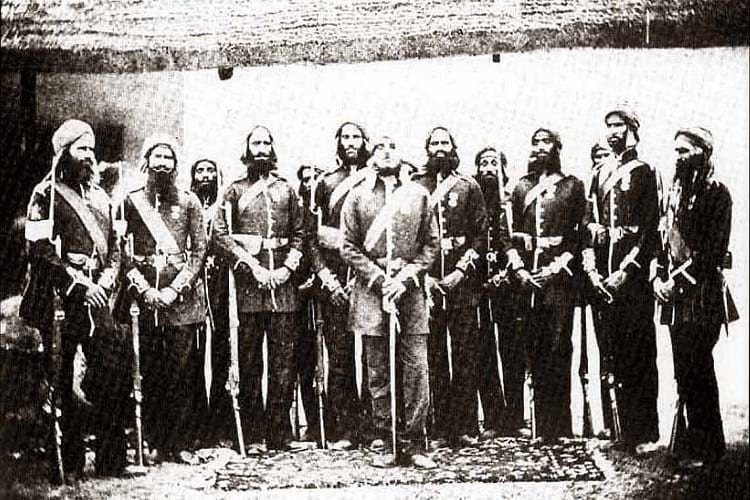
Battle of Saragarhi: Members of the 11th Sikh Regiment of the British Indian Army. (Profitoftruth85 / Wikimedia Commons)
India is an independent nation and also the largest democracy in the world. But before she became a sovereign state, a lot of battles have been fought on her soil to achieve freedom. One such heroic saga of undaunted bravery and unmatched courage dates back to the year 1897. The Battle of Saragarhi, named after the village of Saragarhi, was an epic act of valour in the history of India that fills every Indian with a deep sense of veneration and great pride.
When Afridis rose in rebellion at Tirah Campaign
Between the years 1897-1898, India was under the British rule and Pakistan had yet to become a separate state. The government of British India had given the Afridi tribe (of Pakistan) subsidy to safeguard the Khyber Pass – a mountainous pass, which borders between Pakistan and Afghanistan. The government had also assigned the local Afridis occupation of the Pass to defend the nation when the time came. However, as misfortune had it, they rose in rebellion together with their tribesmen, along with the Pashtun Orakzais (basically from Afghanistan) and intruded Tirah Expedition. But the bloodbath at the Battle of Saragarhi was only the precursor to the Tirah Campaign, fought at the North-West Frontier Province, which is now officially occupied by tribal Pakistanis.

Afridi tribe, 1866. (Library of Congress)
Saragarhi and the 36th Sikhs of the British Indian Army
Just a month before the Afridis and Orakzais infiltrated the Tirah Campaign, in September, 1897, the Pashtun Orakzais waged war with the British Indian Army, leaving a bloody trail in its wake. In the North-West Frontier Province, modern-day Pakistani Province, more than 10,000 Afghani tribesmen fought with only twenty-one Sikh soldiers, who did not leave the battlefield, despite knowing that their fates were already sealed. The 36th Regiment of the British Indian Army, also known as the 36th Sikhs (now known as the 4th Battalion of Sikh Regiment of the Indian Army), were posted at Saragarhi, who did not know what destiny had in store for them, early in the morning of September 12.
Part of British India back then, Saragarhi was an outpost located between Fort Lockhart and Fort Cavagnari. It acted as a communication outpost that relayed messages between the two British forts by means of heliography. On 12th of September, Havildar Ishar Singh and Gurmukh Singh observed that the Pashtun Orakzai tribesmen were heading towards Saragarhi in the thousands, to make way ahead to Fort Lockhart. Gurmukh Singh, who was the signalman, immediately sent a message to the commanding officer Lieutenant Colonel John Haughton at Lockhart. Not prepared for a siege, they expected help to come in from all corners. But Lt. Col. Haughton requested them to hold their positions until reinforcement could be summoned. Havildar Ishar Singh and his men complied with the orders and prepared for what lay ahead.
The Battle of Saragarhi
As the Pathans marched forward towards Saragarhi, the twenty-one men at the outpost, who only acted as messengers, knew the time had come for them to rise to the occasion. They held the ground and tried to delay the enemy from infiltrating further towards the next outpost, but it was obvious they had been clearly outnumbered. The enemy came in the thousands. Not sure exactly how many Pashtun Orakzais were in the enemy camp, but records state there could have been approximately between ten to fourteen to even twenty thousands of them. And these Afghani men were challenged by only a handful of gallant Sikh soldiers of the British Indian Army.
By now it was clear that one Sikh soldier had to take on at least 500 Afghanis, but there was another hitch. Each soldier had 400 rounds of ammo for their 4.5 kg Martini-Henry, which meant they couldn’t just rely on firepower alone. They tried to fight off the over ten thousand Afghani enemies for hours but were heavily under assault. As the Orakzais attacked, they received stiff competition from the 36th Sikhs and as many as sixty of their men were killed. They launched a second attack, but it was thwarted again by the Sikh soldiers. By noon, one British Indian soldier had died fighting and another left wounded. Gurmukh Singh forwarded the message to the Lockhart Fort but Lt. Col. Haughton’s back up had yet to come.
Defeated the second round too, the Pathans then set the nearby bushes ablaze hoping to ambush the Sikh soldiers inside, by camouflaging themselves, but the defenders had not admitted defeat yet. Another Sikh soldier was charred to death, trying to protect the guard door. It was only when the enemy had begun getting inside that Havildar Ishar Singh decided to engage in a hand-to-hand combat instead of wasting precious ammunition. But then it had been too late.
The Pathans had breached the Saragarhi outpost and there was very little that Havildar Ishar Singh or anybody else could do. Gurmukh Singh, who had requested to get into action instead of only relaying messages, also died fighting. Ishar Singh fought till the very end, mortally wounded at that time. However, the twenty-one brave Sikh soldiers did not let down their lives for nothing. Despite no backup in sight, they decided to take on the enemy in the thousands and heroically took down more than six hundred of them. Historians are still of the opinion that Havildar Ishar Singh’s brave act of heroic courage in the face of adversity, is one of history’s most supreme military last-stands.
The delay tactic had worked in the martyrs’ favour and Lt. Col. Haughton could buy enough time to muster reinforcement in the next two days, which finally worked at Lockhart. All the 21 brave soldiers with unprecedented courage were posthumously awarded the Indian Order of Merit, which in today’s times, is equivalent to the Param Vir Chakra. Also, September 12 is observed as Saragarhi Day in memory of the bravehearts with unflinching guts who stood their ground.
Not part of folklore or fiction, the Battle of Saragarhi was truly an act of valiance that 21 mighty Sikh soldiers put up in defence And to pay homage, literary works and pop culture have narrations of this gallantry in great detail. Karan Johar’s Dharma Productions is all set to produce an upcoming movie titled ‘Kesari’, which will be directed by Anurag Singh. Featuring Akshay Kumar in the lead as Havildar Ishar Singh, the movie will be a fictionalized account of the factual Battle of Saragarhi, which is truly the greatest example of rare Indian heroism.
Enjoyed this article? Also, check out “The Tragedy of Jallianwala Bagh“.
Fact Analysis:
STSTW Media strives to deliver accurate information through careful research. However, things can go wrong. If you find the above article inaccurate or biased, please let us know at [email protected].
RELATED
The post Battle of Saragarhi: When 21 Valiant Indian Soldiers Held Their Ground, Fiercely Fighting Against Thousands of Afghans appeared first on .
]]>The post Nemi Ships, the Floating Palace, and the Lynching of Fanatic Dictators appeared first on .
]]>
The larger Nemi ship. (Unknown)
Nemi ships are the first ever luxury cruise ships built by a debauch Roman emperor, Caligula, in 1st century AD. The ships sank in the lake in the 1st century AD and were salvaged to a museum in the 19th century, interestingly by another eccentric ruler, Mussolini.
Dimensions and layout

Decoration on Nemi ship. (Historical photographic archive of the L. da Vinci Museum of science and technology)
The ships, two in number, were made of cedar wood. Measuring 230 feet x 66 feet and 240 feet x 79 feet, these covered a large area of the Lake Nemi’s water surface (1.67 square Kilometres). With plush interiors and classy built, these ships were clearly ahead of their time in terms of architecture and engineering. The larger ship was called ‘Floating Palace’ while the other smaller ship was a temple dedicated to goddess Diana.
The front portion of the ships (barges) was studded with jewels. Doors and windows were made of bronze. Ball bearing of lead was used to minimise friction in furniture and fixtures. The floor was made of glass and marble. Symmetrically arranged bronze sculptures and upholstery of precious metal gave royal ambience to the living space. Hot and cold water ran through the lead pipes inscribed with the emperor’s full name, Gaius Caesar Augustus Germanicus. Piston pumps ensured the flow of water in pipes. Hot water was used for bath and cold for drinking and running of fountains. Barges built by Hellenistic (323BC-31BC) rulers of Syracuse, Sicily, and Ptolemaic rulers of Egypt seem to have inspired Caligula to make Nemi ships. He, it seems, went all out to prove that Rome could make better ships compared to those made in Sicily and Egypt.

Recovered Nemi Ship supported by iron cart. (Historical photographic archive of the L. da Vinci Museum of science and technology.)
The man behind Nemi Ships
Caligula, the delinquent third emperor of Rome spent lavishly on the construction projects. Not content with living in land villas, as Roman kings did, he went in for villas on water, the floating palace, the Nemi ships. These were rudderless ships and could move on water only by pulling of chains tied across the lake. Sails, made of purple silk, were just ornamental. Their splendour and novelty attracted a large number of visitors from Rome as well as from outside.
According to Historians, these luxury boats were used by the depraved ruler, Caligula for sinister and salacious objectives. That was in tune with his maverick and errant character. He punished high ranking senators for no rhyme or reason, womanised recklessly and was in an incestuous relationship with his sisters. He was so whimsical that once he proposed enrolment of his favourite horse as a member of the Senate.

Hull of the second Nemi Ship. (Historical photographic archive of the L. da Vinci Museum of science and technology)
Thin and sickly with unkempt overgrown hair, he lived like there was no tomorrow. Far from moderating his ugly looks, he accentuated it all the more by villainy in facial expressions and wearing weird clothes. He called himself God and made a game of torturing his enemies to death. Floating palaces were an ideal hideout for Caligula to indulge in vile activities of all shades and description.
A benign view on subject holds that the smaller of the two ships was the temple of Diana – the goddess of the hunt, the moon and nature in Roman mythology. Nemi is Latin word for ‘grove’. Surrounded by Alban Hills, the lake is a great scenic beauty. The ancient name for the lake area was Speculum Dianae or ‘the mirror of Diana’. According to Roman author and administrator, Pliny the young, lake Nemi was a sacred lake and Roman law prohibited any ship sailing in its water. An exception though was made for Caligula to launch Nemi ships.

The first Nemi Ship with people in foreground. (Unknown)
Why were the two floating palaces allowed to sink?
One view is that they sank following a severe storm or an earthquake. The other is that these were forcibly drowned by the emperor himself in one of his drunken orgies. Recovery of Nemi ships without loss of architectural details even after 1900 years of burial in the lake is historically significant as it sheds light on architecture and construction techniques of that period. Plumbing technology of Nemi ships isn’t seen anywhere else in that time period. It is only much later on, in the middle ages (5th to 15th century), that the art and craft of plumbing were rediscovered.
Interestingly, the fact of Nemi ships’ burial in lake water was known since the very beginning. Some attempts were made to dig them out too, damaging their body structure. In 1446, leaders Cardinal Prospero Colonna and Leon Battitsa Alberti tried to pull ships out of lake water with ropes but failed. In 1827, Annesio Fusconi built a floating platform for same, but couldn’t succeed. Finally, it was left to the Fascist government of Benito Mussolini to excavate the ships from their watery grave in 5 years of dedicated attempt (Oct 1928 to Oct 1932). Siding with Germans in World War II, Mussolini was deposed in 1944 as the tide of the war turned in favour of allies. On May 31, 1944, Lake Nemi Museum was hit by shells fired by the allied forces and the remains of Nemi ships preserved there were charred to ashes.
Caligula sat on the throne in 37 AD and was assassinated in AD 41 by his own bodyguards. Dictator Mussolini too died violently, killed by his own countrymen in 1945. The man who conceived the idea of Nemi ships and the man, who excavated them for public view, both met a grisly end.
Enjoyed this article? Also, check out “MS The World: Life on Board the World’s Largest Residential Cruise Ship“.
Fact Analysis:
STSTW Media strives to deliver accurate information through careful research. However, things can go wrong. If you find the above article inaccurate or biased, please let us know at [email protected].
RELATED
The post Nemi Ships, the Floating Palace, and the Lynching of Fanatic Dictators appeared first on .
]]>The post Starfish Prime Nuclear Test – How the United States Detonated Nuclear Weapons at High Altitudes appeared first on .
]]>
Before, during and after the high-altitude nuclear test. (Wikimedia Commons)
From 1958 to 1962, the USA conducted a series of high-altitude nuclear tests over the South Atlantic Ocean, the Pacific Ocean, and the Nevada National Security Site. The purpose was both to understand the effects of high-altitude nuclear explosions and to counter Soviet nuclear testing. Previously, both the USA and the Soviet Union had agreed to stop conducting nuclear tests, but, after a hiatus of three years, the Soviets resumed their testing. The USA, in retaliation, carried out a series of nuclear test operations codenamed Hardtack I, Argus, Hardtack II, Nougat, Sunbeam, and Dominic.
The entire program took place in cooperation between the Defense Atomic Support Agency and the US Atomic Energy Commission. Experts from the Explorer 4 Space Mission and the Lockheed Aircraft Corporation also participated in the operations.
Starfish Prime
Operation Dominic carried out 31 nuclear tests and included amongst these were five nuclear tests collectively grouped under the codename Operation Fishbowl. The Starfish Prime high-altitude nuclear test was one of these.
There were only three tests planned, to begin with – Bluegill, Starfish, and Urraca. The first test, Bluegill, failed and so they tried it unsuccessfully on two more occasions, renaming it Bluegill Prime and Bluegill Double Prime. The first Starfish trial also failed, so the researchers set up another attempt and called it the Starfish Prime nuclear test. If that had failed as well, they would have named the third attempt Starfish Double Prime.
These failures, by the way, were not without consequences. The resulting debris and radioactive materials from the warheads caused widespread contamination in the area that persists after so many years.
The Starfish Prime test came next and it worked. The Thor Missile launcher successfully dispatched the nuclear warhead into the sky on 9 July 1962 from Johnston Island in the Pacific Ocean. The war detonated at an altitude of 400 kilometres to the southwest of Johnston Island. From the data collected in the aftermath of this detonation, US American researchers were able to compile a pretty clear and grim picture of the outcome of using nuclear weapons.
The outcome of the Starfish Prime test
The two immediate outcomes of the Starfish Prime were the generation of an immense electromagnetic pulse (EMP) and the appearance of spectacular auroras both in the northern hemisphere where the detonation happened and across the equator in the region around the Samoan Islands in the southern hemisphere.
Another outcome, which the researchers discovered afterwards, was the formation of artificial radiation belts around the earth.

The sky after the Starfish Prime high-altitude nuclear test. (US Gov)
The electromagnetic pulse (EMP)
The resulting electromagnetic pulse (EMP) from the Starfish Prime detonation caused damage in the environs of Johnston Island and proved to be so far-reaching that it even affected areas several thousand kilometres away in Hawaii. The EMP knocked out streetlights, made electronic instruments unusable, caused electronic equipment to malfunction, and damaged a telephone microwave link, severing phone connections in Hawaii.
Bright auroras
The Starfish Prime nuclear detonation did not produce any audible sound, but, instead, lit up the sky in the northern and southern hemispheres with a spectacular light show. The sky glowed with bright orange, red, yellow, and white auroras, and the light was so intense that it, apparently, even provided sufficient illumination for the New Zealand Airforce to conduct the anti-submarine manoeuvres that they were at the time carrying out. The auroras remained visible in the evenings for several days.

Photo of the aurora taken from an aircraft after the test. (U.S. Air Force)
The researchers had expected this phenomenon to occur, going by the results of the previous high-altitude nuclear tests that they had carried out, and the word had leaked out to the public in advance. Many hotels in the area had already opportunistically advertised ‘rainbow bomb rooftop parties’ in the local papers to lure in guests to come to view the sky show.
What exactly caused these auroras though?
When the detonation happened, it released high-energy beta particles and heavier debris ions that scattered in all directions. The charged beta particles and ions encountered hydrogen and oxygen atoms in the earth’s atmosphere, and they transferred their charges to these atoms, causing the now-charged atoms to glow in a variety of colours and give rise to the aurora phenomenon. The red light of the auroras came from charged beta particles encountering a high concentration of oxygen atoms, altering to a green light as the oxygen atoms disperse. Encounters with high concentrations of nitrogen atoms produced blue light.
Some of the charged beta particles travelled at high velocities along the earth’s magnetic field lines, following the arched trajectory of these lines to reach the southern hemisphere. Due to this, the auroras were visible in both the northern and the southern hemisphere at around the same time. The debris ions were comparatively slow travelling along the magnetic lines and led to delayed auroras.
Naturally occurring aurora borealis, incidentally, occur due to the effects of solar wind radiations.
Artificial radiation belts
Some of the high-energy beta particles and debris ions remained trapped in the atmosphere along the earth’s magnetic lines and gave rise to artificial radiation belts around the earth. This radiation persisted in the atmosphere for a long time and, in the months following the detonation, caused the destruction of several communication satellites belonging to the United State, the United Kingdom, and the Soviet Union.
Aftermath
The Starfish Prime detonation produced a detonation yield of around 1.45 megatons. This was a hundred times greater than the detonation yield of the Hiroshima bomb; that was a mere 13 kilotons. The testers assumed that the debris from the detonation would remain in space for a few months, but, as a matter of fact, it lasted for several years.
Purpose of the testing
The main purpose of the US nuclear tests was to counter Soviet testing and stay ahead in the nuclear armaments race between the two countries. Another purpose was to see if, by using nuclear warheads, the US military could disrupt the Van Allen belts. These are strong radiation belts that occur naturally in the inner region of the earth’s magnetosphere. They protect the earth from buffeting solar winds that would otherwise decimate all life on the planet. The US American scientist, James Van Allen, discovered these natural radiation belts in 1958.
Soon after this discovery, the Greek scientist, Nicholas Christofilos, came up with the idea of conducting high-altitude nuclear tests to create artificial radiation belts that, like the Van Allen belts, would surround the earth. This experiment wasn’t out of mere curiosity, but to find out if, by such high-altitude nuclear detonations, it would be possible to direct and deploy both the natural radiation of the Van Allen belts and the artificial radiation against any country on earth that the USA considered a threat to their hegemony. It was a barmy idea, but both the US military and James Van Allen endorsed it with great enthusiasm and, of course, no regard for any potential damage to the environment and human life. When it comes to cooking up Mad Hatter schemes of destruction and annihilation, the US military’s thinkers and planners and their supporters are second to none. James Van Allen called it the “greatest geophysical experiment” in the history of humankind.
Enjoyed this article? Also, check out “The Manhattan Project: The Making of the First Atomic Bomb“.
Fact Analysis:
STSTW Media strives to deliver accurate information through careful research. However, things can go wrong. If you find the above article inaccurate or biased, please let us know at [email protected].
RELATED
The post Starfish Prime Nuclear Test – How the United States Detonated Nuclear Weapons at High Altitudes appeared first on .
]]>The post Captain Jack Bonavita: The One-armed Lion Whisperer appeared first on .
]]>
Captain Jack Bonavita with his pride. (Internet Archive Book Images / Flickr)
Dreamland was an amusement park that opened at Coney Island in Brooklyn, New York on May 15, 1904. It was counted as one of the three most iconic amusement parks built on Coney Island. Famous animal trainer and owner of his own circus, Frank Bostock was hired by the park management to stage his circus acts in an indoor arena. Several animal trainers, each with their own acts, were associated with Bostock’s circus. One of the major attractions of the circus was the renowned lion tamer, Captain Jack Bonavita. He was known to be the only man to appear in the arena with as many as 27 lions. His control over the big cats drew crowds to the park.
Unfortunately, in 1904, Bonavita had to have his right arm amputated, which got infected after a lion named Baltimore clawed him in an adverse encounter. Baltimore was an untrained wild beast. The captain was trying to train him and get him to perform his first stunt. It is said that the cat attacked Bonavita when he took his eyes off the beast briefly. Bonavita resisted amputation for eight months after which, following further deterioration, he agreed to it in February 1905. However, as a one-armed lion tamer, he attracted more and more people to his performances with the cats.

Dreamland amusement park at Coney Island, New York City (1904-1911). (Detroit Publishing Company photograph collection / Library of Congress)
Captain Jack Bonavita: The man, the legend
The real name of Captain Jack Bonavita was Johann Friedrich Gentner. He was born on December 15, 1866, and brought up in Philadelphia, Pennsylvania in the USA. He started his career as a circus acrobat but went on to become a world-famous animal trainer. Bonavita was known over the world as the lion whisperer, simply due to the fact that the cats obeyed his commands. What led to his fame was his majestic demeanour. Always dressed in military apparel and boots, his muscular frame attracted many female admirers. To add to this was his complete fearlessness while working with the big jungle cats.
His most famous act was called ‘The Arm-Chair’ which had Bonavita sitting on a chair surrounded by 13 calm and composed lions. The captain made his debut at Moulin Rouge in Paris on July 31 in 1904 wherein his opening act he was attacked by the lion, Baltimore. Also, the Princess of Montglyon, Rosalie F. Mercy d’Argenteau had come to see the act of the great American lion tamer with his beasts. It is said that not only did she rush to the stage when the incident took place but also went with Bonavita in the ambulance, to the hospital. She stayed with him throughout his recovery and they finally got married on April 26, 1905, in Paris. However, two years later, the two parted ways and were divorced.

The arm-chair act by Captain Jack Bonavita. (thecircusblog.com)
The film career and the end
The amusement park, Dreamland was completely ruined in an accidental fire in May 1911. On May 27 in 1911 at about 1.30 am a fire broke out due to an electrical malfunction, which consumed everything that came in its way, turning the park into ashes. Bonavita rushed to save the animals but 60 perished in the fire. One of the lions, Black Prince ran out on the road and was shot dead by policemen. Dreamland was lost forever.
Bonavita went on to pursue films from 1913 to 1917. He worked as a stuntman, an actor, and a director. His first film as an actor, a silent black and white movie ‘The Wizard of the Jungle‘, released on April 5, 1913. He directed and acted in another silent black and white film ‘The Woman, the Lion and the Man‘ which released on September 23, 1915. Another famous film that he directed and acted in, ‘The Winning of Jess‘, released on December 23, 1915. His films always featured wild animals and also some of the trainers that he had worked with. Bonavita also continued his stints with Bostock’s Circus, training animals at Frank Bostock’s farm in Los Angeles, California.
On March 19 in 1917, Bonavita was training a polar bear, while going through a routine, the animal unexpectedly attacked him. A policeman nearby shot six bullets into the bear, killing it. Bonavita, on the other hand, had been mauled aggressively, suffered a fractured jaw and multiple deep lacerations. Unable to recover from the attack, Captain Jack Bonavita succumbed to his injuries, later that night.
Enjoyed this article? You would also love “The Time When Men Fought Bears“.
Fact Analysis:
STSTW Media strives to deliver accurate information through careful research. However, things can go wrong. If you find the above article inaccurate or biased, please let us know at [email protected].
RELATED
The post Captain Jack Bonavita: The One-armed Lion Whisperer appeared first on .
]]>The post The Strange Case of Emperor Norton, the Self-Anointed Monarch of the United States appeared first on .
]]>
His Imperial Majesty Emperor Norton I. (Wikimedia Commons)
Some men seize the crown, some have it thrust upon them, and some crown themselves. Emperor Norton I of the United States was of the latter category. He acquired his royal stature by peaceful personal effort, and, if you think about it, this is no small achievement. It’s difficult to become royalty unless you have thuggish ancestors who steal other people’s lands and properties and call it legitimate conquest, or unless you marry someone with the thuggish ancestors.
Emperor Norton I of the United States

Portrait of Edward Norton. (Wikimedia Commons)
The citizens of the United States first heard they had a self-declared emperor when he published his first decree through the medium of the San Francisco Bulletin on 17 September 1859. He announced that he was proclaiming himself Emperor Norton I and he was going to alter the country’s laws to rid them of all their current evils.
It is incredible that the San Francisco Bulletin printed this decree, especially given that the new emperor had no riches to pay them for the publication. Newspaper spaces must have either a monetary or a newsworthy value, and so the Bulletin’s pro bono acceptance of an eccentric vagrant’s decree remains an odd thing. There were, however, more odd things to come.
The citizens of San Francisco, far from laughing off the pretender, endorsed him wholeheartedly. The general attitude was, if he wants to be an emperor, let him be an emperor. For the next twenty plus years, the farce continued.
The uniformed Emperor Norton I took daily strolls around ‘his’ city to inspect sidewalks, public properties, and public servants, and make sure everything was fine. He read in libraries and played chess. His citizens greeted him with salutes, free meals, free theatre tickets, free train tickets, free ferry tickets, and much more.

Emperor Norton posing in his uniform. (Wikimedia Commons)
They listened to his impromptu philosophical lectures and some of them even paid him a voluntary tax, so he could live in relative comfort in a rented apartment. A few army men presented him with a new uniform, in striking blue with gold epaulettes, when they saw that his old one was getting tattered. He added a beaver hat with a feather and a cane to make himself regaler. The San Francisco Board of Supervisors scooped into public funds to pay the city dressmakers to make more new uniforms for him. When he decided he wanted to issue his own currency, the city printers even printed it for free. And, of course, the city newspapers continued publishing his numerous decrees.

Currency issued by the Imperial Government of Norton I. (Wells Fargo History Museum)
Emperor Norton I became one of the most well-known personalities in San Francisco. Tourists asked to take photographs with him in his imperial uniform and bought his imperial currency for souvenirs. The tourist shops sold Emperor Norton I dolls and some of the local restaurants drew in visitors by prominently displaying the imperial seal of approval: “By Appointment to His Imperial Majesty, Norton I.”
The man who became emperor of the United States
Emperor Norton I was born as Joshua Abraham Norton in humble circumstances in the United Kingdom in 1819. When he was one or two years old, his family moved to South Africa, and his father started a machine repair shop in Algoa Bay, Cape of Good Hope. The family appears to have done quite well for a while. In his early twenties, Joshua Norton started a business, failed, and returned to the family fold to work for his father. Shortly afterwards, tragedy struck and he lost his parents and brothers and was left alone with the $40,000 he inherited from his father’s estate. Deciding to make a new start, he set sail for the United States in 1849 to try his luck in the San Francisco Gold Rush.
In the United States, he prospered at the onset. The businesses he invested in did well and he became a millionaire and was well-known and well-respected in San Francisco. Then things went south.
In 1853, anticipating a rice shortage in San Francisco, he invested in Peruvian rice. With no other rice shipments coming in, he hoped to sell the rice at a high price and make a fortune. It turned out though that he had been duped. There was not going to be any rice shortage. Ships bearing Peruvian rice docked at San Francisco the very next day and with an abundance of rice in the market, the price of rice plummeted. Far from making a killing, Joshua Norton discovered that he was going to have to kill himself to repay the debts he had incurred with this transaction. He went to court and spent two years in fruitless litigation and ended up losing his entire new-found wealth. Ruined, he declared bankruptcy and then disappeared from San Francisco and was not seen for quite a while.
When he turned up next in September 1859, it was with the grand delusion of being Norton I, the Emperor of the United States. Had he really lost his mind? Or was this simply a clever ploy to become San Francisco’s most famous welfare-recipient? It’s hard to say, but he certainly managed to keep up his end royally.
The Reign of Emperor Norton I
Emperor Norton I showed himself to be a benevolent and prescient ruler. He called for women’s emancipation (liberation) and stood his ground once to protect Chinese workers from rioters.
His 1870s decrees called for building a bridge from San Francisco to Oakland and also an underwater tunnel. These projects were later built, but, despite an intensive lobbying by the fans of Emperor Norton I, the Bay Bridge, built in 1936, hasn’t been renamed in his honour.
To get rid of fraud and corruption in the public sphere, he called first for the abolishment of the US Congress on 12 October 1859 and then ordered General Winfield Scott to head for Washington to arrest the legislators. During the US American Civil War, he informed the concerned public that he had dissolved the US Congress and they could now look forward to him managing the country’s affair from his imperial helm. To reassure the Mexicans when the French attacked them, he declared himself as Protector of Mexico.

Emperor Norton riding a cycle. (Wikimedia Commons)
In 1872, he said he was going to fine people $25 if they dared to mar San Francisco’s beautiful name with shortened version ‘Frisco’. That, according to him, was an intolerable abomination.
When Emperor Pedro II of Brazil visited San Francisco, the citizens made sure he had a meeting with their Emperor Norton I. The two royals had tea together, but their conversation doesn’t appear to have been recorded for posterity.
He was a familiar sight on the streets of San Francisco, resplendent in his uniform, accompanied by two stray dogs, Bummer and Lazarus. A local cartoonist, Edward Jump, caricatured the Emperor and his dogs and tall tales sprang up about the animals. Contrary to what everyone grew to believe, Emperor Norton I did not own these dogs. He simply fed them when he ate at the free meal counters.

Illustration by Edward Jump of Emperor Norton I with Bummer and Lazarus. (Edward Jump / sfgate.com)
In 1867, Armand Barbier, a private security guard with a local auxiliary force, had the temerity to arrest Emperor Norton I for vagrancy and wanted to dispatch him to a mental institution. The public reacted with outrage and the newspapers mirrored this. The Daily Alta declared that there was no cause to arrest him, since he had not unlike some of the public figures, harmed anybody. He was quickly released and showed himself magnanimous enough to issue a royal pardon for Armand Barbier. Thereafter, the city’s policemen left him unmolested and even saluted when they met him in the streets.
Emperor Norton I also came to the notice of the leading literary figures of the day, Mark Twain and Robert Louis Stevenson, and they both immortalized him as characters in their novels ‘The Adventures of Huckleberry Finn’ and ‘The Wrecker,’ respectively.
Death of Emperor Norton I
On 8 January 1880, while on his way to lecture at the California Academy of Sciences, Emperor Norton I suffered a heart attack and collapsed on the street. A policeman came to his aid and summoned a carriage to take him to the hospital. It was too late to save him, however. He was pronounced dead at the hospital.
His death made headline news in many US American newspapers. The San Francisco Chronicle declared ‘Le Roi Est Mort’ and all the newspapers agreed that he would be deeply missed.
Upon his death, the many rumours that had circulated over the years about his being an eccentric and secretly wealthy man were laid to rest. It was discovered that he had, in fact, been very impoverished and did not have much by way of personal belongings. There was not even enough money to pay for his funeral. He would have had a pauper’s burial, except for the businessmen of San Francisco’s Pacific Club, who contributed money for a funeral befitting an emperor. Large numbers of the city’s residents turned up to pay their last respects to Emperor Norton I and he was buried in San Francisco’s Masonic Cemetery.

Grave of his Imperial Majesty Emperor Norton I. (Kai Schreiber / Flickr)
It was a fine testament to the kindness and generosity of the people of San Francisco.
Enjoyed this article? Also, check out “Mansa Musa: The ‘Golden’ Emperor of Mali Who Was Reputedly the Richest Man Ever“.
Fact Analysis:
STSTW Media strives to deliver accurate information through careful research. However, things can go wrong. If you find the above article inaccurate or biased, please let us know at [email protected].
RELATED
The post The Strange Case of Emperor Norton, the Self-Anointed Monarch of the United States appeared first on .
]]>The post Futurama – Unveiling the City of the Future at the 1939 New York World’s Fair appeared first on .
]]>
General Motors building at 1939 NY World’s fair. (Richard / Flickr)
The 1939 New York World’s Fair was an event in which many countries and corporations participated to display their cultural and trade specialities. The main purpose of the Fair was to increase international trade relations between the participants and to boost US business worldwide. Amongst the Fair’s many exhibits, was General Motors’ Futurama, a diorama showing a utopian city of the future.
The 1939 New York World’s Fair
While most of the western world was still in the grip of the Great Depression and more troubles lay ahead, the New York World’s Fair opened to the public with exhibits on the promising theme of ‘The World of Tomorrow’. To lend the New York World’s Fair a certain gravitas, it opened on 30 April 1939, which was the 150th anniversary of George Washington’s first term inaugural as US President. Over 200,000 people attended to hear the then-current President Roosevelt’s speech at the Fair’s grand opening ceremony.
President Roosevelt’s high-minded rhetoric was in line with the World’s Fair’s mission to cast a shining light on US American economic accomplishments and to set the USA up as an example of an enlightened, democratic land that rewarded anyone willing to work hard to get ahead. He also made the usual sounds about peaceful trade and co-existence between the different nations of the world, and the public dutifully applauded. Whether they really believed him is another matter. The nations of Europe, at that point, were already on the brink of the coming conflict, and Germany, significantly, had not participated in the World’s Fair because of the volatile situation on the European continent, although they cited budget issues as the main reason.
The New York’s World Fair remained open for 19 months, and several million people attended it in this duration, including King George VI and his wife Elizabeth of the United Kingdom. The Fair that had begun with such gusto began its second year with the yet more laudatory theme of ‘For Peace and Freedom’, but, as war had already broken out in war, the public wasn’t in the mood anymore for innovative fun and redundant platitudes and the show fizzled out on 27 October 1940.

H.M. King George VI and Queen Elizabeth meeting visitors at the NY World’s fair, 1939. (FDR Presidential Library & Museum / Flickr)
Flushing Meadows, Corona Park, Queens
The venue of the Fair was Flushing Meadows, Corona Park, Queens. This area was formerly a large ash and garbage dump that, in the months prior to the Fair, had received a rigorous clearing and levelling to prepare the ground for the upcoming Fair exhibits. Teams of workers toiled round the clock in shifts to get the work completed on time, and their accomplishment – turning a waste dump into a beautiful 1,202 acres park – was the first, not greatly acknowledged success story for the utopian vision of the future.
World’s Fair participants
Sixty countries participated in the 1939 New York World’s Fair and set up pavilions at the venue. The focus was on displaying their cultural prowess for the enlightenment of the US American public, and most of them succeeded very well in this. The displays that really stood out were by the Italians, the Japanese, the Greeks, the Poles, and the Russians.
The Italians erected a 200-foot waterfall to give the public a taste of Roman splendour, the Greeks aired their ever-popular ancient history with murals and collages, and the Poles didn’t stint in displaying a surfeit of Polish artworks, furniture, costumes, weaponry, and even King Casimir IV’s carpet. The Japanese showcased a Shinto shrine with a traditional Japanese garden and, best of all, a mural that sought ‘eternal peace and friendship’ with the USA. The USSR, on the other hand, was more intent on promoting the mighty projects that they had undertaken and achieved back home, and they were very successful in that. The Soviet designer, Alexey Dushkin, won the New York World’s Fair’s Grand Prize for his brilliant, life-sized recreation of Moscow’s Mayakovskaya metro station.

Postcard photo of the Italian Pavilion at the fair. (Joe Haupt / Flickr)

Moscow’s Mayakovskaya metro station. (Hadi Karimi / Wikimedia Commons)
Futurama, the city of the future
The most popular exhibit at the World’s Fair turned out to be General Motors’ Futurama, the model city of 1960 with skyscrapers and flyovers; it drew well over 25 million visitors. Norman Bel Geddes, who was a theatrical and industrial designer, came up with the concept, and when General Motors heard it, they ditched the plans they were formerly going with and gave him the green signal and their wholehearted support.

General Motors’ Futurama model. (Norman Bell Geddes / Wikimedia Commons)
They had a vested interest, of course, in promoting a future city in which there would be wide highways and flyovers to manage increased levels of traffic. An increase in traffic pointed to more people owning cars and, hopefully, cars that came from General Motors’ manufacturing line-up.
Geddes, on the other hand, had a hardcore utopian view of the future. He imagined that with proper city planning everything else would fall in place and public life would move along smoothly and conflicts would become a thing of the past. Idealistic planners always seem to leave the sheer unpredictability and perverseness of human nature out of their calculations. They seem to assume that if all conditions are right, human beings will behave in an expected fashion and this will lead to expected results. They fail to consider that some human beings may have an aversion towards getting herded into skyscrapers, nor may they want to be limited to driving within lanes.
Far from being utopian, such city planning has a rather authoritarian feel to it, forcing people to abide by plans in which they have had no say at all. It can only lead to festering resentment and discontent and further problems down the highway, excuse the pun.
In any case, we have skyscrapers and flyovers in the present age, and even helipads on top of buildings, so Geddes’s vision has come true to a point. The part about reducing conflict, as expected, remains unfulfilled.
The Futurama diorama
Apart from being the most popular exhibit and one that left Ford, General Motor’s main rival, biting the dust, the Futurama diorama was also the largest one in the New York World’s Fair. Located in the Transportation Zone, it spread across seven acres and showed a futuristic city with skyscrapers for the city population, highways and flyovers for the overwhelming traffic, sky walkways for pedestrians to go directly from one skyscraper to another, and landing pads for the flying vehicles of the future. The highways and flyovers had multiple lanes to allow for more traffic.

Skyscrapers and roads diorama. (Richard Garrison / Wikimedia Commons)
Geddes and his team spared no pains in designing the smallest details of the futuristic city, and their creation entranced the public. They lined up to get into moving chairs that would take them through the exhibit to give them a personal feel of what it would be like to live in such a city, and most of them gave it a high approval rating. They didn’t see it as a city that would limit their movements and keep them well-monitored, but rather as a place that was, well, utopian. Well, that is what limited knowledge and belief in government authorities and corporations do to you.

Aerial photo of 1964 New York’s World Fair. (Joe Haupt / Flickr)
In 1964, New York had the good fortune to host a second World’s Fair at the same, and General Motors attempted to reclaim their popularity with a Futurama II diorama. The fine colours of utopia had run off by now, as had subtlety and restraint. General Motors revealed their grand ambition to populate the entire planet with their cars. They meant to ‘develop’ every part of the earth for this purpose. They were not going to leave anything undeveloped, not the oceans, not the rain-forests, not the regular forests, not the deserts, not the Arctic and the Antarctic regions. And leading the development would be a machine, powered by atomic energy, that would charge through all barriers and fell trees left and right with laser beams. A factory machine would follow it and grind up all the tree remains and lay a four-lane highway in its wake. Humans, claimed General Motors, no longer needed to constrain themselves in their home choice by terrain or the terrain’s distance from major urban hubs.

GM displaying their futuristic concept car at 1964 NY World’s Fair. (Don O’Brien / Flickr)
Even in 1964, when the public wasn’t half as environmentally aware as our current generation, this picture of the future must have rung some alarm bells. It did not quite enjoy the same popularity as the first Futurama.
More photos: By Richard
Enjoyed this article? Also, check out “The Fascinating ‘Amber Room’: The Fabled ‘Eighth Wonder’ of the World“.
Fact Analysis:
STSTW Media strives to deliver accurate information through careful research. However, things can go wrong. If you find the above article inaccurate or biased, please let us know at [email protected].
RELATED
The post Futurama – Unveiling the City of the Future at the 1939 New York World’s Fair appeared first on .
]]>The post 1896 Olympics – Taking a Trip Down The Memory Lane appeared first on .
]]>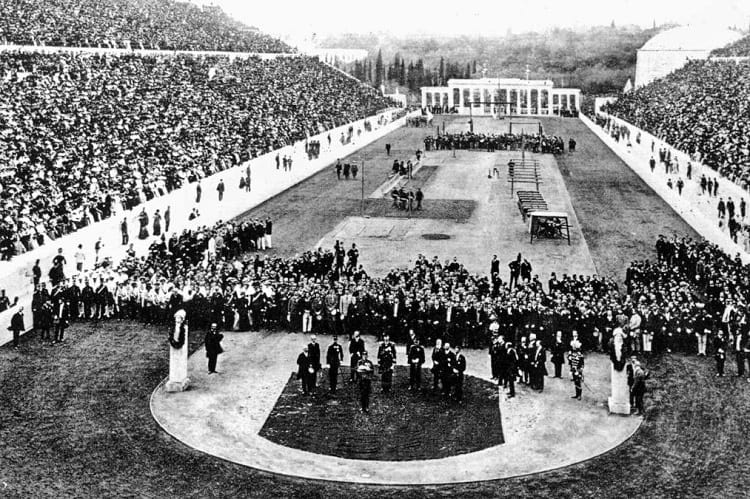
1896 Summer Olympic opening ceremony. (Wikimedia Commons)
The first Olympics, the quintessential sports and athletics carnival was held between 6th April and 15th April in Athens, Greece, in the year 1896.

Pierre de Coubertin, also known as the father of modern Olympics. (Dutch National Archives / Wikimedia Commons)
The extravagant event was organised by the International Olympic Committee (IOC), whose founder was Pierre de Coubertin. Although the first Olympic event was a pretty modest affair, today the events are all but multibillion-dollar propositions that entail years of meticulous planning and shrewd politicking.
As many as 241 male athletes from 14 nations participated in the inaugural games. Some of the biggest delegations came from Greece, France, Germany and Great Britain. There were in all 43 events that encompassed sports such as track and field athletics, swimming, cycling, wrestling, weightlifting, tennis, shooting, gymnastics and fencing. Amid an all-pervasive celebratory and high-spirited ambience, the foreign athletes were ushered in with numerous parades and banquet parties.
Earlier anecdotes about Olympics
A high-level meeting was held in Paris by the IOC where they zeroed in on Athens as the venue for the modern and maiden Olympiad. The genesis of the Olympics dates back to 776 B.C. where a place called Olympia in Greece hosted the ancient games at the Panathenaic Stadium. It was built originally sometime around 330 BCE. In this time-honoured spectacle, the athletes participated in only one event and that was a foot race.
With the passage of time, other playdowns like chariot racing, wrestling, boxing and pentathlon were included in the Games programme. All the participants were young men in good physical shape with well-developed muscles from various cities and colonies of Greece who regularly fought it out as a means to salute the human body. The winners of each competition were awarded olive branches. The final ancient Olympics are conjectured to have occurred in A.D. 393.
The revival of the modern Olympic Games in 1896
During the 1800s, many European nations used to host a good number of festivals that were coined after the Olympics and upheld the legacy of the Games. After some time, the organizers of these festivals teamed up with an aim to take the lead in creating a unified platform for various games influenced by the same sense of honour as the archetypal Ancient Olympics. They envisaged a forum comprising of several nations that would federate and compete. In this way, the panel laid the foundation of the IOC and the subsequent inception of the 1896 Summer Olympics.

Dr William Penny Brookes. (Wikimedia Commons)
Sometime in the 1850s, Wenlock, a nondescript village in Shropshire took to presenting its own local Olympics annually. The concept which was formulated by a native doctor William Penny Brookes is even hosted in the current times. It was Coubertin who paid a visit to the town during the flow of the event in 1890 and was immensely motivated while looking at the enthusiasm of the townspeople who were participating in the Games. This inspirational discovery persuaded him to form the IOC and contribute towards conceiving a novel form of the Olympic Games at gaps of every four years.
How were the date and the city chosen?
Pierre de Coubertin assembled a group of sports enthusiasts on 18th June 1894 at Sorbonne, in Paris. His prime intent was to illuminate his plans to the sports society representatives from 11 countries. Once his comprehensive proposal was accepted by the conglomerate, a date for the commencement of the first modern Olympic Games was required to be fixed.
Coubertin wanted the Games to converge with the Universal Exposition of Paris slated in 1900. However, the members instead pitched on 1896 apprehending the possibility of a rapid dwindling of public interest with a six-year gap.
Once the date was frozen, the debate then turned to select the host city. Since the ancient Olympics had its birth in Greece, Athens became the most favoured choice to host the inaugural modern Games. Demetrius Vikelas a Greek businessman was the maiden president of the newly formed IOC.

The International Olympic Committee of 1896 summer Olympic with Vikelas seated in the centre. (Albert Meyer / Bulgarian Archives State Agency)
The opening ceremony
A massive crowd of more than 80000 spectators were present in the opening ceremony of the Athens Olympiad that was held at the Panathenaic Stadium. The royal family of Greece, King George I, his wife Olga, their sons and other associated members played a significant part in organizing and managing the Games. In addition, they were regular attendees at various gatherings over the 10-day span of the Olympics.
The majority of the contenders were grouped by their respective nations and aligned in a well-ordered array on the infield. Following an introductory speech by the president of IOC, Crown Prince Constantine officially announced the beginning of the Olympic Games with a proclamation spoken in Greek words.

The first day of the 1896 Summer Olympic. (History of the Greek Nation)
Later, a group of musicians comprising of 150 choir singers and nine bands performed by belting out an Olympic Hymn that was composed by Spyridon Samaras with lyrics by poet Kostis Palamas.
From there on, an assortment of melodious renditions offered the inaugurations for each of the Opening Ceremonies until 1960. Since then the composition of Samaras and Palamas has turned into the official Olympic Anthem, a decision brought into existence by the IOC in the year 1958.
Only Hungary could put together a national team. Most of the non-native athletes were either college students from affluent and well-to-do families or members from sundry athletic clubs who were enamoured by the newness and the creativity which the Olympics had set forth.
Panathenaic Stadium
The track-and-field competitions for both athletics and cycling had taken place at the Panathenaic Stadium. The primaeval stadium that was originally put up in 330 BCE had been dug out. Yet it was not reconstructed for the once proposed 1870 Greek Olympics.
It lay untouched until the 1896 Olympics when the renovation work with marble was completed under the supervision and capital funding by a wealthy Egyptian Greek Georgios Averoff. The old track was exceptionally elongated with very sharp turns which often were deterrents to the runners as they had to appreciably slow down to stay around in their lanes.

Men’s high jump at the 1896 Summer Olympic. (Wikimedia Commons)
The track-and-field events were completely overpowered by the athletes from the United States. Out of the 12 contests, they won 9. The Bay of Zea hosted the swimming competition. Out of the four swimming races, ace Hungarian swimmer Alfréd Hajos won the silver in the 100m and 1200m events.

Alfréd Hajós won medals in two categories; sport and art competitions. (Wikimedia Commons)
The longer swimming races were conducted by transporting the swimmers out to the mid sea by boat and allowing them to swim back the earmarked distance to the shore. French cyclist Paul Masson bagged the silver for three cycling races. On the opening day itself, James Connolly from the United States won the triple jump and created a record of sorts over the past 1500 years. He performed exceedingly well earning the second and third in other high jump and long jump events respectively.
The countries that boasted of the largest number of teams were Greece, Germany, France and Great Britain. Nonetheless, it was the United States that came to the forefront by picking off the highest number of first-place finishes with 11 medallions. Greece with 10 medallions and Germany with 6 medallions finished off in the second and third places respectively.

100-meter race. (Benaki Museum of Greek Civilization)
The first marathon
One of the major highlights of the 1896 Olympics was the first marathon. The then unique race was the brainchild of a Frenchman Michel Bréal. The marathon followed the mythical unending route of Pheidippides. As the legend prevails, an adept runner, who was sent as a messenger from the Marathon plains to Athens, Pheidippides declared the vanquishment of a Persian army who attempted to invade Greece in 490 BCE.
Because of its incredible historical significance, the race garnered the prominence of being the most outstanding feature of the first Olympic Games. Spyridon Louis, a Greek triumphed in the race by a lead of over 7 minutes which gained him an ever-lasting adulation among the nationals. He was also awarded a commemorative cup by Michel Bréal for his tour de force.
The medals
Unlike the present times, there was no concept of gold medals. The winners of the first-place were awarded silver medals, an olive branch and a diploma. The winners of the second-place received copper medals, a twig of laurel and a diploma.

1896 Olympic medal. (Wikimedia Commons)
The front side of the medal had the engraving of the face of Zeus with his hand clasping a globe having a winged triumph emblem on it, with an inscription in Greek that read “Olympia”. The back side featured the miniature view of the Acropolis site with the inscription in Greek that read “Worldwide Olympic Games in Athens in 1896.”
1896 Olympicsclosing ceremony
On 12th April 1896, a banquet was arranged for the officials and athletes by King George. He was categorical in his address speech about his intent to hold the Olympic Games permanently in Athens. The official closing ceremony was held on 15th April. The royal family was in full attendance.
A short time later, the king gave away the prizes to the winners. A procession by all the medal holders was also orchestrated, spearheaded by Spyridon Louis much to the ecstasy of the hometown crowd. The king officially announced the culmination of the first Olympiad amid the playing of the Olympic Hymn as the crowd cheered in sheer revelry.
The elaborate and spectacular extravaganza drew to a close with Greece’s national anthem being played followed by a lyrical poem composed in classical Greek by a British scholar and athlete George S. Robertson.

Panathenaic stadium today. (bk / Flickr)
Enjoyed this article? Also, check out “What Happens to the Olympic Venues in the Host Countries After the Olympic Games End?“.
Recommended Visit:
Panathenaic Stadium | Athens, Greece
Fact Analysis:
STSTW Media strives to deliver accurate information through careful research. However, things can go wrong. If you find the above article inaccurate or biased, please let us know at [email protected].
RELATED
The post 1896 Olympics – Taking a Trip Down The Memory Lane appeared first on .
]]>The post The Tale of Topsy the Elephant That was Electrocuted, Poisoned and Strangulated appeared first on .
]]>
Topsy the elephant being electrocuted in Luna Park. (www.timetoast.com / Wikimedia Commons)
Topsy was an elephant that belonged to the herd of performers in the Forepaugh Circus for a major part of her life. The tragic story of Topsy began sometimes around 1875. The elephant traders in Southeast Asia seized the baby elephant weighing 200 pounds. She was later smuggled into America by Adam Forepaugh, the owner of Forepaugh and Sells Circus, who dishonestly used to bill her as the first elephant born in America.
Historical accounts of Topsy’s errant behaviour
In those days, like other circus animals, Topsy was a victim of human-inflicted brutality and abuse. She used to be tormented no ends during the course of her training and performances. It was because of this stocked up pain and agony she became infamous as a rogue elephant.
She had developed a penchant for rampaging circus resources, frequently going berserk and smacking against people, especially the cruel circus handlers when they tried to hurt or cage her up.
As indicated by different sources, she supposedly killed by trampling two circus workers in Texas. In 1902, she killed James Fielding Blount, a spectator from Brooklyn, in utter anguish, who instigated to extremely trouble her by throwing a lit cigar into her mouth.
After this much-hyped incident, Topsy was disposed of Coney Island’s Sea Lion Park. A year later, when the park was distressed with bankruptcy, its proprietor Paul Boyton leased it out to Frederic Thompson and Elmer Dundy who were then developing the Luna Park. Naturally, Topsy was turned over to her new owners.
Life became worse for Topsy after her entry to Luna Park. For whatever was left of her short-lived and pitiful life, she continued pulling massive building materials for construction and development. Frederic and Elmer termed it as her atonement pursuit for being so audacious and belligerent.
Topsy the elephant, here as well, was embroiled in several widely reported error incidents, mainly attributed to the inhuman actions meted out by either her unruly drunken handler or the park’s public attention-grabbing owners.
Topsy the elephant’s electrocution
Luna Park originally had plans to hang Topsy for her disruptive behaviour. However, the Society for the Prevention of Cruelty to Animals (SPCA) stepped in and quickly squashed that idea citing reasons that hanging was unpardonably spiteful.
Based on information from prior instances of electrocutions of animals using alternating current, Luna Park officials decided on electrocution as the preferred and more humane alternative to killing Topsy the elephant.
On December 13, 1902, a press release from Luna Park issued a statement in newspapers that Topsy would be euthanized within a few days through electrocution.
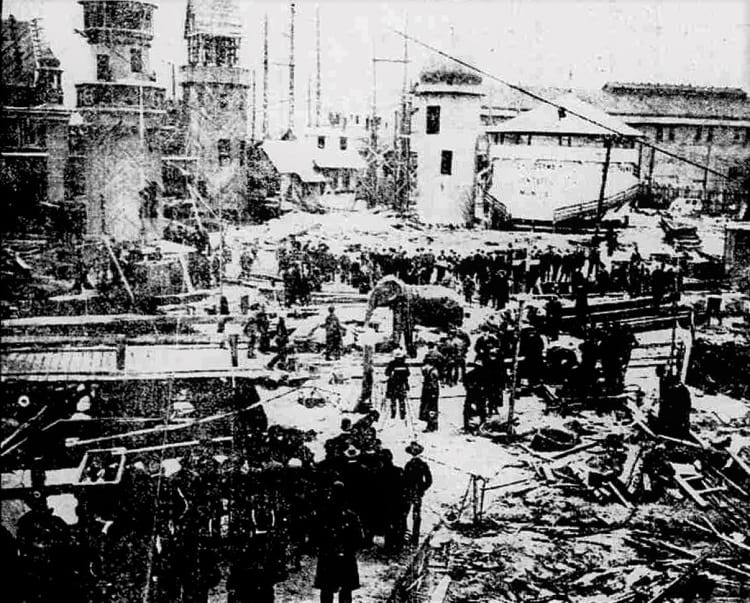
Topsy being escorted to cross the bridge for her execution. (Louis Republic article / Wikimedia Commons)
Finally, the elephant was executed on January 4, 1903, at the Luna Park construction area in Coney Island. Since such an incident of electrocution of an elephant was never attempted before, a sizeable crowd drew in to watch the event at the recently opened park.
As the electrocution of an elephant was hitherto unknown, Topsy’s executioners made sure to complete the act successfully through a technique that combined all; electrocution, poisoning and strangulation. Topsy was fed poisoned carrots with her feet being strapped into copper sandals to apply the electric shock.
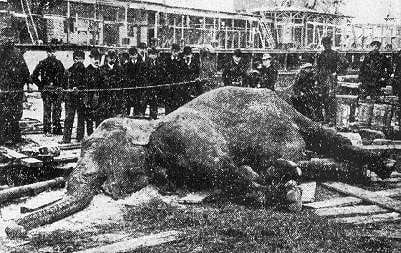
Dead Topsy. (www.metrolic.com / Wikimedia Commons)
Hugh Thomas, who was the chief electrician of Luna Park, performed the electrocution. It sent shivers of 6,600 volts through Topsy’s body. The current application was switched off after 10 seconds.
There was a huge blaze of fire and stench of burning flesh. Her body violently underwent a tremor before tumbling to the ground. And, if she was really a ferocious, unmanageable beast, Topsy unquestionably didn’t demonstrate it on her last day.
The Thomas Edison angle behind Topsy’s death
Many people trust that Topsy was a casualty of the purported “War of the Currents” the scientific battle that was fought between Thomas Edison and Nikola Tesla over the concepts and viability of alternating and direct currents.
Fred and Elmer swung into action with Thomas Edison. He was then in strong contention with the alternating current strategy of Nikola Tesla. He was trying hard to uphold the direct current theory in the United States as the ideal standard of electricity provision.
In his endeavours to prevent and dissuade the general public from using AC owing to its increased potential dangers, Edison had been orchestrating numerous public demonstrations by electrocuting stray animals. Apparently, he couldn’t forgo the opportunity to electrocute Topsy and prove the heightened perils of AC once more.
The identity of a certain individual who apparently filmed the electrocution and consequent death of Topsy the elephant could not be revealed. The SPCA and Edison Electric Co. are surmised to have both contributed towards the planning and execution of the electrocution method. According to a rumour, an entire part of the persistent propaganda to devalue AC and foster Edison’s own predilection, direct current.
Numerous reports and sites allege that Thomas Edison not only recorded the entire event but also masterminded the killing. Sources like Rutgers University are of the impression that a film crew which represented the Edison Electric Illuminating Co shot the video in all likelihood.
The film was believed to be an opportunity for Edison to bespeak the pernicious nature of the abhorrent alternate current on a mammoth animal. It was a great man’s frustration and wrath at being confronted with getting an upper hand over and showing off his real worth as the true boss. But it hardly made any impact. Edison eventually lost the War of the Currents to his opponent Nikola Tesla.
Lack of evidence in Thomas Edison’s involvement
However, there is a lack of corroboration in this matter and contemporary historians have put this information away as a grossly fallacious one. According to them, Edison’s involvement is mostly dubious with newspaper accounts having no mention of it. There is also no evidence that Thomas Edison was in attendance during the course of the action.
The fact that any of the extant correspondence of Edison doesn’t mention about Topsy or an electrocution incident of an elephant at Luna Park is also worth noting.
Some people deviate, stating that Topsy, in many ways, was doomed to die. Edison’s electrocution was simply observed as a conducive and compassionate way to accomplish her death. And even, the War of the Currents drew to a close in the 1890s, while Topsy’s execution came much later. It has been conjectured that Topsy the elephant was not a pawn of the war of the currents, but of the “elephant wars” among the circus proprietors.
And for Topsy, who was a member of a species with profound intelligence and emotions, kept in bondage for such an extended period of her life, the feud between Edison and Tesla couldn’t have made much of a difference.
A few assessments report that nearly 1,500 onlookers and 100 photographers attended Topsy’s electrocution. Around then, an occasion like this generated a lot of buzz and curiosity among the general public. The execution, since then has been the subject matter of various books, articles and television documentaries.
Topsy’s electrocution being a massive disservice to animal welfare
Today, in any case, people introspect and consider this event as an absolutely deplorable and unforgivable moment that went down the chronicles as an extreme act of heinous crime and outrage against animal well-being.
With American society becoming increasingly sensitive to the affliction towards animals, Topsy’s execution has been portrayed as a quintessential example of indescribable cruelty to animals.
Topsy’s passing away ended up being stale news decently not long after the episode, however, on the grounds that a video documentation of her demise still exists today, she has returned into the public appearance as an exemplary image of how to show care and respect to animals.
A century later, at the Coney Island Museum, a memorial was unveiled, not only to commemorate the life and death of Topsy the elephant but also pay heartfelt tribute to a soul that contributed significantly to the scientific advancements in that period.
Enjoyed this article? Also, check out “Anti Tank Dog: The Soviet ‘Masterplan’ that Backfired to Disastrous Effects“.
Fact Analysis:
STSTW Media strives to deliver accurate information through careful research. However, things can go wrong. If you find the above article inaccurate or biased, please let us know at [email protected].
RELATED
The post The Tale of Topsy the Elephant That was Electrocuted, Poisoned and Strangulated appeared first on .
]]>The post The Horrors of Hiroshima Bombing: Human Shadow Permanently Etched in Stone appeared first on .
]]>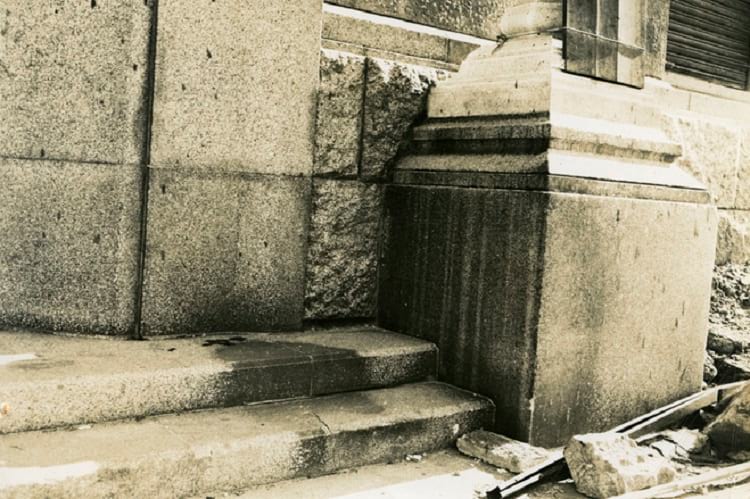
Shadow of a man on the steps of Sumitomo Bank in Hiroshima. (U.S. Army)
The bombings of Hiroshima not only left the city in shambles but also left the shadow of victims that were burnt without leaving their traces behind. When Enola Gay dropped bombs on two Japanese cities during the War, little did people, who survived them, know what they had endured.
During the year 1945, when the Second World War was almost nearing its end, the United States of America dropped two nuclear bombs on the Japanese cities of Hiroshima and Nagasaki. The cities were instantly reduced to a pile of dust within minutes but that was only the beginning of larger problems that Japan was about to face.
The after effects of the atomic bomb dropped on Hiroshima are still visible in some form or the other in the generations of people that lived the traumatic times.
The main event
On the morning of August 6th 1945, at approximately 8:15 AM Japanese time, the first ever nuclear bomb used in warfare – Little Boy – came crashing down on Hiroshima, destroying everything in its wake. It was a day of usual business at the Sumitomo Bank in Kamiya-Cho, when the employees were making their way towards their workplace. At the entrance of the bank – approximately 250 metres away from ground zero – a person sat on its stoned steps, waiting for the bank to start its operations for the day.
As soon as the bomb went off on touchdown, within seconds, the said person, supposedly a 40-year-old woman, was incinerated in such a way that only the outline of her body or her shadow remained on the steps. The eerie silhouette was so vivid that one could also guess the way she sat on those stoned stairs before the bomb disintegrated her body completely. More than eighty thousand people in the entire city lost their lives at the same time as a result of the massive blast.
With temperatures from the bomb flare reaching approximately 1000 to 5000 degrees centigrade, it was very obvious that anything the heat touched would have either melted or turned to ash leaving no trace. The fireball that spread over three kilometers created a mega heat and firestorm that is said to have lasted more than six hours.
Everything in its path was completely destroyed, including humans that were surprisingly wiped off from the surface of the earth within a fraction of seconds. Tens of thousands of lives were lost during one of the worst crimes against humanity in 1945 and the “Human Shadow of Death” still reminds people of the greatest tragedy.

Photograph from Australian War Memorial. (Yoshito, Matsugige Matsushige Mio)
The Human Shadow of Death also known as Human Shadow Etched in Stone is a living example of the level of destruction the two American bombs had done during WW-II. They claimed innocent lives, rendering millions homeless with radiation-exposure disorders that continue to haunt the Japanese to this day.
Other similar distressing shadows left due to the bombings were that of a bicycle on the floor, a permanent whitish shadow of a bridge on the tarred roads, which had melted down, a figure with a walking stick and an outline of a person holding a ladder to name a few.
Though most of the others have faded out with time, the Human Shadow of Death remains more than intact. Years after the War, wind and sun began working their way on the “shadow”, which is dubbed Hito Kage No Ishii in Japanese. Authorities tried to preserve it by placing it in a glass case, fencing it entirely, but that did not work. And so the part of the stone bearing the shadow is now cut off and enclosed in a glass case, well preserved by the Hiroshima Peace Memorial Museum.
The debate over the shadows of Hiroshima
Years after the shadow was discovered at its site, scientists argued that the woman, who they thought could have been a certain Mitsuno Ochi, was vapourised, since nothing but her outline was left behind. They disputed that is not normal for a human body to vanish into the air without leaving its trace or at least remains, even if the bomb had the potential to raze an entire city.
Renowned radiologist at the Hiroshima University, Professor Masaharu Hoshi, has been studying the effects of radiation on atomic bomb survivors for thirty years now. He stressed that complete vapourisation of a human body, when exposed directly to such high temperatures, in the absence of any barrier between the two, is possible. Medical experts brushed aside his evaporation theory, stating that despite ground temperatures exceeding more than 1000 degrees centigrade, bone fragments or carbonized organ remains could be left behind. The heat did not have the capability of evaporating an entire individual and leaving nothing but shadows.
Although his theory has now been shot down, a long list of questions remains as to what could have happened to the person, who left behind such a haunting image that the world just couldn’t find answers to even after seventy-three years of the catastrophe.
Enjoyed this article? Also, check out “Unit 731: Gruesome Human-Experimentation To Test Biological And Chemical Warfare In Japan During WWII“.
Fact Analysis:
STSTW Media strives to deliver accurate information through careful research. However, things can go wrong. If you find the above article inaccurate or biased, please let us know at [email protected].
RELATED
The post The Horrors of Hiroshima Bombing: Human Shadow Permanently Etched in Stone appeared first on .
]]>The post Dole Air Race: The Daring and Pioneering Conquest Across the Pacific Ending in a Tragedy appeared first on .
]]>
NX913 Lockheed Vega 1 flying at Dole Air Race. (SDASM Archives / Flickr)
1927: In their quest for US$35,000 prize money and some chunk of popularity, fifteen single-engine aeroplanes registered for a chance to be the champion of flying from Oakland to Hawaii. That too, only a couple of months after Charles Lindbergh’s successful flight from New York to Paris. Eleven contenders qualified for the final race. And then the spate of direful mishaps broke loose as planes started crashing in rapid succession.
Eventually, eight out of the eleven qualified aeroplanes participated in the race. Two crashed during take-off and two went missing. Another developed snags and returned for a repair. It later again took off to search for the untraceable flights only to never come back again. Only two could ultimately touch the finishing point.

Line-up of aircraft before the race. (SDASM Archives / Flickr)
The Dole Air Race or the Dole Derby, a flight competition across the Pacific Ocean was mired in unfathomable tragedy and misfortune. The inspiring feat of a successful trans-Atlantic flight by Charles Lindbergh motivated pineapple business tycoon James D. Dole to announce the race to fly 3,870 kilometres from Oakland to Hawaii.
He offered cash prizes of US$25,000 and US$10,000 for the first and the second winning teams. The air race transpired on the 16th of August in 1927.
Obviously, flying a plane in 1927 called for a certain flavour of insanity. The sundry planes that assembled to participate in the race were progressively a testament of the grit and mettle of the flight crews than the front line innovation. Shocking as it may sound, the planes, in those days were bereft of any real safety gear and lacked efficient navigational equipment.
Pre-race disasters
The race was tangled up in mishaps even before it started. Firstly, it was Lieutenants Covell and Waggener, who in their pursuit to win money, fame and reshape history embarked on the journey from San Diego to Oakland for participating in the race. Fifteen minutes after they took off, their plane veered into dense fog and slammed over a cliff by the ocean.

Crash site of Tremaine Humming Bird flown by Lieutenants Covell and Waggener. (SDASM Archives / Flickr)
The second tragedy struck when pilot Captain Arthur Rogers undertook a test endeavour. While landing, the aircraft plunged from a height of 125 feet and crashed resulting in his death. The reason for the crash is still unknown.
In a third disaster, another Dole participant crashed en route to the racing point and tumbled 100 feet into the water. Surprisingly both the pilot and the navigator survived.
Thus, by the time the Dole Race did not even commence, three lives were already claimed.
The motley assemblage of the final eight participating planes
• Pabco Flyer – a monoplane flown by Livingston Gilson Irving
• Woolaroc – a customized Travel Air 5000 led by Arthur Goebel and navigated by William Davis
• Oklahoma – a modified Travel Air 5000 with Bennett Griffin and Al Henley as the crew
• Aloha – a monoplane piloted by Martin Jensen and manoeuvred by Paul Schluter
• El Encanto – a monoplane with Norman Goddard and Kenneth Hawkins as the crew
• Golden Eagle – a prototype monoplane with Jack Frost as the pilot and Gordon Scott as the navigator
• Miss Doran – a civil utility aircraft that had Auggy Pedlar as the pilot, Vilas Knope as the navigator and Mildred Doran as a passenger.
• Dallas Spirit – a monoplane that was flown by William Erwin and steered by Alvin Eichwaldt
The Dole Air Race
The epoch-making day of 16th August 1927 sprang up with a foggy morning. An estimated 100,000 onlookers had gathered at the Oakland Airport to watch the much-plugged race.
The initial departures were nothing but highly disruptive and troublesome. First, it was Oklahoma that took off around 11 AM. The crew, however, aborted the flight 45 minutes following the take-off. They suspected an overheated engine problem and returned empty handed.
Then it was El Encanto’s turn. The aircraft could not clear the runway. Because of fuel overloading, it swerved, crashed and had to abandon the race.
Pabco Flyer flew only for a few moments and then crashed around 7000 feet away from the airport runway. It had no other option but to withdraw from the field. Fortunately, the crew came out unhurt.
Golden Eagle had a smooth take-off and disappeared into the air. The aircraft along with the crew were misplaced amid the sea and could never be found.
Miss Doran had a successful take-off only to come back after ten minutes with its engine emitting splitting sounds. On its second attempt, it flew out of sight, went lost in the sea, and sank without a trace.

Mildred Doran posing with her aircraft before the race. (SDASM Archives / Flickr)
Dallas Spirit had a failed trip and flew back to Oakland with a damaged fuselage. It was only Aloha and Woolaroc, which took off without any glitch and finally could realize the impossible mission.
In retrospect, it proves beyond doubt that all the aircraft were badly prepared for the dangerous intersection. The crew had minimal knowledge of the flying route and the climate at higher altitudes.
With only four aircraft having a radio transmission equipment and the crew with no survival gear, it was a tribute to all those who attempted this unthinkable and perilous feat, their fearlessness and a lot of good luck.
The finale and winners
Aloha and the Woolaroc were the only two planes that could reach their final destination. Woolaroc flew at an altitude of more than 4000 feet and traversed a great-circle flight path. Davis, who was the navigator, leveraged with smoke bombs and sextants for calculating the course and the wind drift.
When the plane reached Hawaii, the team was warmly greeted and escorted out of Wheeler Field by a Boeing PW-9. Goebel and Davis arrived in a period of in 26 hours and 17 minutes and won the race and the cash prize of US$25,000. The aircraft is currently on display at the Woolaroc Museum located in Oklahoma.

Aloha and the Woolaroc. (SDASM Archives / Flickr)
Aloha, which took 28 hours to clock, came in second and earned Jensen and Schluter, the prize money of US$10,000. Martin Jensen, who was the pilot kept all the money with him. He gave Paul Schluter, his navigator, a paltry amount of $25 much to the latter’s shock and anger.
At long last, only two planes, of the total 15 that registered in the first instance, could make it to Hawaii. By that time, already six planes were totally decimated and the casualty figure rose to 10. Going by these circumstances, the Dole Air Race was found to be less of a competition and more of a horrific event in Chicago.
The two untraceable planes
Nothing was ever heard about Golden Eagle and Miss Doran. An extensive search supported by three submarines USS S-46, USS S-42 and USS R-8 was soon arranged by the US Army and US Navy.
Martin Jensen flew around Hawaii in Aloha to look for the two missing planes. Simultaneously an Army plane crashed resulting in the casualty of two crew members.
Once the repair work of the faulty tail assembly of Dallas Spirit was finished, Alvin Eichwaldt and Bill Erwin also took off in their plane from Oakland for Honolulu in the dig endeavour. Both of them never returned. The last radio message from Dallas Spirit indicated that the flight was under the spell of a vigorous gyration.
The ill-fated Dole Derby ended up taking 12 lives. A sensible introspection of this hefty cost the encounter paid for, triggered widespread reservations on the idiosyncrasy of the wisdom that tried to achieve this gargantuan feat of bridging the oceans by air. In an embittered state of affairs, Charles Dole, the race’s chief sponsor, died on November 27, 1927.

The fate of all participants of 1927 Dole Air Race. (FlugKerl2 / Wikimedia Commons)
The turning point in November 1935
The concluding analysis of the Dole Race demonstrated the very fact that operating transoceanic flights was a critical activity. It needed well-ordered functional arrangements, genuine expertise, sufficient and comprehensive training, robust equipment in equivalence to the magnitude of the undertaking and last but not the least, with the reverence towards the boundless expanse of the ocean, it must be absolutely equipped with the ability to conquer the challenges.
Furthermore, it was not very long before others responded to the transoceanic dare. In the following year, Charles Kingsford-Smith from Australia flew from the same Oakland air terminal and jetted the distance back with stopovers at Hawaii and Fiji. After seven years a massive flight of the U.S. Navy patrol aircraft accomplished the trip.
Be that as it may, the real defining moment finally arrived in November 1935. Equipped with the aggregate involvement and experience of the individuals who had set the scene before, coupled with their expertise in acing the operations of transoceanic journeys, Pan American Airways, at last, addressed the concern revolving around flying over the Pacific Ocean as a feasible and consistent proposition. This year will mark their eighty-third anniversary and since then, they have never looked back.
More photos by SDASM Archives
Enjoyed this article? Also, check out “Andrée’s Arctic Balloon Expedition of 1897: A Peek into the Doomed North Pole Flight“.
Recommended Read:
Race to Hawaii: The 1927 Dole Air Derby and the Thrilling First Flights That Opened the Pacific | by Jason Ryan
Fact Analysis:
STSTW Media strives to deliver accurate information through careful research. However, things can go wrong. If you find the above article inaccurate or biased, please let us know at [email protected].
RELATED
The post Dole Air Race: The Daring and Pioneering Conquest Across the Pacific Ending in a Tragedy appeared first on .
]]>The post Now Forgotten Medical Histories of Railway Surgery appeared first on .
]]>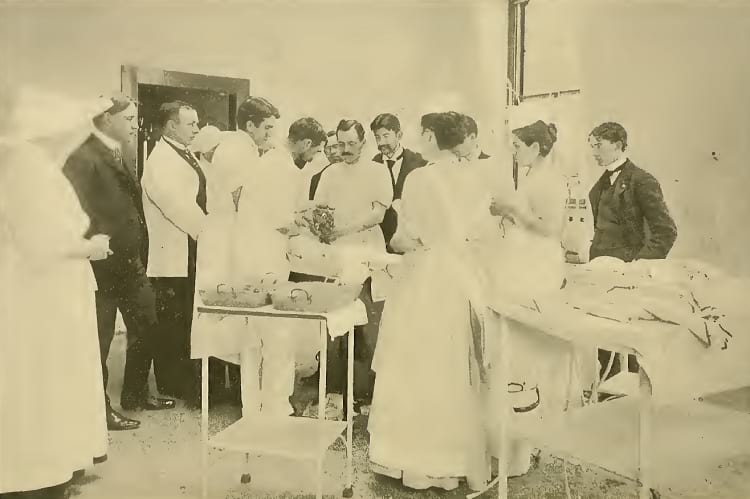
Railway surgery in progress. (Clinton B. Herrick, Railway Surgery, New York)
In the 19th century, with the advent of the railway in various part of the world, a special branch of medical practice sprang up that became known as railway surgery. The purpose of railway surgery was to tend to the injuries and other health concerns that inevitably occurred amongst railway workers and railway passengers. It wasn’t an altruistic enterprise, but one that arose out of hard-nosed necessity.
Development of railway surgery
Railways in the 19th century and even into the 20th century were as dangerous as they were useful. They connected large tracts of land and made travel more feasible, particularly across the huge land mass of the United States, but, at the same time, they were notorious for collisions, derailments, and explosions. These accidents took a massive toll on workers and passengers, many of whom died as a result or suffered amputations, crushed limbs and fingers, fractures, burns, and other serious injuries.
While filing for injury claims was not as common back then as it is now, nor were these claims always paid, they did create a sufficient amount of stir to make the railway companies take notice, become concerned about reparations, and take measures to ameliorate the problems and install preventive measures. Railway companies appointed medical surgeons to treat the injured and the sick, set up hospitals along the railway tracks in remote locations, and organized hospital vans to ferry patients from accident sites.
Railway surgery soon developed as a special medical branch and the railway surgeons became very skilled at performing quick surgeries in the aftermath of accidents.
The AMA (American Medical Association), however, refused to recognize railways surgeons and accept them as members, since the organization felt that there was an ethical conflict of interest between serving as medical men and serving the railway company. In event of disputes with workers and passengers, the railway companies often summoned the railway surgeons to give evidence on company behalf. The AMA felt that, given that the railway company was paying the railway surgeons, it was not possible for them to take an objective stance in such conflicts and that this contravened medical ethics. There were certainly several cases where railway surgeons proudly boasted about how their testimony in court had saved the railway company from paying the high monetary compensation they would otherwise have had to pay to railway victims.
On the whole, though, the railway surgeons insisted they could remain objective and there were certainly many high-minded men amongst them that put medicine first. Even so, they never got the respect and recognition they desired from the AMA.
The railway surgeons then formed their own professional organizations and published their medical papers in their own medical journals, most of which make for fascinating if not gruesome reading about the surgical procedures they performed. Railway surgeons had to perform all kinds of surgeries and often in the direst circumstances and surroundings and they quickly came up with many innovative methods to make the best of their situations and save as many lives as possible. They were the first trauma surgeons in the medical world.

Operation room inside the train. (Clinton B. Herrick, Railway Surgery, New York)
It is commonplace nowadays for many companies to have their own medical facilities in which their workers can receive first treatment before being moved to a larger hospital. In the 19th century, the railway companies and some mining companies were possibly the only employers that provided this service. As mentioned though, it wasn’t altruistic. It wasn’t so much for the benefit of the workers as it was to stave off potential financial troubles for the companies.
As it was, the companies did have to confront a good deal of trouble even with the railway surgeries in place. There was no shortage of tricksters, shysters, and fraudsters in the 19th century than there is in the present age. People came up with all sorts of made-up medical claims to extort money from the railway companies.
Railway spine
One of the most well-known and most decried medical claims against the railways was a condition that became known as the Railway Spine. This condition laid a good many people prostrate and they all claimed that travelling in trains was what had brought on their suffering. The problem was that the condition didn’t manifest into any physically observable symptoms.
Careful examinations revealed no injuries, external or internal. Medical practitioners and journalists wrote reams about the Railway Spine, and many railway surgeons voiced their opinions that the sufferers either had psychological issues or were outright frauds. The Railway Spine hysteria vanished around the turn of the century as, with the march towards the First World War, people encountered more real and more serious troubles.
Before that happened though, newly minted compensation laws forced railway companies in the USA, the UK, and Europe to pay several million in compensation to the folks suffering from Railway Spine.
Railway surgeries in the USA
It was in the USA that railway surgeries really grew into prominence. American railways were the most dangerous railways of that time period. In their haste to connect the entire country with railways and as inexpensively as possible, the railway companies often compromised on materials as well as on construction. They did not take adequate care with securing railway tracks on the ground and set up very few railway signals. There was no fencing either to keep people and animals from the railway tracks. Crashes and collisions were extremely commonplace. Injuries and deaths amongst railway workers were very high.
Newspapers of the time regularly reported on workers getting crushed between railway wagons, getting run over by trains as they worked on the tracks, getting burned in fires, getting their fingers crushed while coupling or decoupling wagons, getting injured when trains collided with people and animals crossing the tracks, and so on. Yet, despite the many amputations and life-threatening injuries, the railways never lacked for workers and some of the injured workers even went right back to work after being treated. There are news stories about workers returning to work after getting their kneecaps replaced or after getting wooden peg legs fitted.
Railway surgeries in the UK and Europe
British and European railways employed medical personnel too, but the local infrastructure was far more well-developed in these countries and there was never a concern about where to take the injured in the event of accidents. There were train derailments and other accidents, of course, but not on the same scale as in the USA.
The railway tracks in the UK and in Europe were more precisely installed and the companies did not cut corners to keep the railway budget down. They didn’t have to save on materials in order to bring more land under the railway track. This meant there were comparatively fewer accidents due to railway negligence.
Railway surgeries in India
In India, the development of the railway was somewhat similar to that in the USA. The railway connected far off places and more often than not there were no proper facilities of any kind in between. When accidents occurred, there were no hospitals or treatment centres to take the injured to, and people often died from not being treated on time. As in the USA, railway companies began appointing surgeons on the railways and began establishing medical facilities along the railway lines. Indian railways still maintain their own hospitals and doctors.
The legacy of railway surgeries
In addition to treating accident injuries, railway surgeons also engaged in vaccinating people, in treating infectious and non-infectious diseases, carrying out blood tests, in taking measures to prevent malaria, overseeing proper sanitation, checking that the water supply was clean, and in educating the general public on important health issues.
Railway surgeons also had to screen prospective railway employees to make sure they were healthy, were able to hear properly, were not colour-blind (as it was extremely important for railway employees to be able to discern the colours of railway signals), and did not have any pre-existing health issues that they might later blame the company for.
Making First Aid kits available on trains and training railway personnel in First Aid was one of the many progressive steps taken by the railway companies. Charles Dickson, a Canadian of the St. John Ambulance Association, was the principal force behind this change. There was some amount of consternation regarding this development amongst the railway surgeons, as some of them felt that it would undermine their profession. It turned out to the contrary. Having First Aid kits and trained first responders in railways made treating people easier for the railway surgeons. The percentage of lives saved went up.
As railway safety standards grew, incidents of railway accidents decreased and it became unnecessary to have a separate railway industry specific medical branch. Railway surgeries soon merged into the newer discipline of trauma care.
The New York Academy of Medicine has a collection of railway surgery journals and interested parties can access and read these here or at various online sources. These journals offer a fascinating insight into the complex and, quite frankly, terrifying medical situations that the railway surgeons had to cope with. That they rose magnificently to the challenges and introduced innovations that advanced medical science is one of their most enduring and under-appreciated legacies.
Enjoyed this article? Also, check out “Old Penn Station: A Colossal Railway Terminal That Was Once a Crown Jewel of New York’s Heritage“.
Fact Analysis:
STSTW Media strives to deliver accurate information through careful research. However, things can go wrong. If you find the above article inaccurate or biased, please let us know at [email protected].
RELATED
The post Now Forgotten Medical Histories of Railway Surgery appeared first on .
]]>The post Great Stink of 1858: When London Crumbled Under an Obsolete Sewage System appeared first on .
]]>
Print of horrified woman after discovering microbes in her tea made from river Thames. (William Heath / Wellcome Collection)
London came to a complete halt in the summer of 1858 due to the infamous Great Stink. As surprising as it may sound, the city of London once suffered from the problem of an inefficient sewer system.
London boasted of brick sewers that had existed since the dawn of the 17th century. The 18th century saw the evolution of the sewage system in London when over 100 sewers were constructed.
The city had approximately 2,00,000 underground sealed tanks for a temporary collection of sewage and 360 sewers. It wasn’t until the early 19th century that the city’s water supply underwent repairs. By 1858, the age-old in-use wooden water pipes started getting replaced with iron pipes.
By this time, urbanisation had set in with the rich adapting to a flush toilet. The population of the city was on a rise, increasing to 3 million from a little below 1 million. The result was the increase of flushed water and effluent into the sewers.
With the increase of industrialisation, the sewage system of the city was under strain, trying to grapple with the heavy influx of waste from all areas. The antique sewage system of the city was designed to be emptied into the river Thames which led to its over contamination. This unhygienic river was also a source of drinking water.
As London grew in strength, so did the amount of human, animal and industrial waste. All the sewage was drained or overflowed into the river Thames. In the 17th century, it was realised that the primary water source of the city was getting polluted. Due to the lack of an understanding to mend the state of affairs, the river continued to stew in waste.
The cholera outbreak
Meanwhile, in the 19th century, there was a pandemic of deadly Cholera in Europe. Cholera, an infectious disease was on the rise and in 1831; London had its first fatal Cholera epidemic with 6,536 victims.
The second outbreak in 1848-49 claimed 14,137 victims. During this outbreak, London physician, John Snow, studied those areas, where drinking water was supplied from the Thames. Based on his extensive study and concentrated reports on his research on cholera, Snow published a book, ‘On the Mode of Communication of Cholera‘ in 1849 in London. The book hypothesized the theory that cholera was a water-borne disease, contrary to the belief that it resulted from the foul air emitted from the Thames.

Dr. John Snow, British physician (Rsabbatini / Wikimedia Commons)
August 31st, 1854, saw a severe outbreak of cholera in the Soho District of the City of Westminster in London concurrent with the eruption of the disease everywhere. The next 3 days saw the death of 127 people in the Broad Street area of Soho District. 500 people were dead by September 10.
John Snow narrowed down on a public water pump on Broad Street and could convince the authorities of the St. James parish to disable the well pump for use by the public. The handle of the pump was removed to prevent the usage and the mortality rate came down soon after.
Much later, it was discovered that the water of the well had been contaminated by a leaking sewer nearby. Snow published the second edition to his previous publication in 1885, with detailed study and proof of the effect of contaminated water. Snow’s research that impure water contributed to the rapid spread of cholera helped to understand epidemics and their prevention. Today, he is considered “Father of modern epidemiology”.
Surmounting the after effects
Pathologist John Simon was the appointed Medical Officer of Health for London in 1848. Fearing the spread of cholera through foul sewage air, Simon had instructed for the sewers to be flushed on a regular basis. Unaware of the actual problem, this only led to further contamination of the Thames.

Pathologist John Simon. (G. Jerrard / Wikimedia Commons)
Meanwhile, in August 1849, civil engineer Joseph William Bazalgette was appointed as the assistant surveyor in the Metropolitan Commission of Sewers. Along with the Chief Engineer Frank Foster, Bazalgette started to design an effective plan for the city’s sewage system.
Following Foster’s death in 1852, Bazalgette was promoted to his position. He continued to modify his plans based on rejections and suggestions of Sir Benjamin Hall, the First Commissioner of Works and Public Buildings.
In July 1855, the deplorable condition of the Thames compelled eminent scientist Michael Faraday to write to the British daily, The Times, stating, “Near the bridges, the feculence rolled up in clouds so dense that they were visible at the surface..” and that the nauseating smell from the river was the same that emanated from the sewers in the city. According to Faraday, the Thames had turned into a big sewer.
In December 1856, Hall discussed Bazalgette’s plans with a group of consultant engineers who proposed changes that increased the cost of implementation by more than £3 million. In 1857, the stench from the river was so appalling that the government arranged for chalk lime, chloride of lime and carbolic acid to be poured into the waterways to mitigate the disgusting odour.
The Great Stink of 1858
February 1858 saw a change of government and the coming months only led to further deterioration of the Thames. Charles Dickens, in his novel ‘Little Dorrit’ which was published in serial form between 1855 and 1857, described that the Thames as, “a deadly sewer … in the place of a fine, fresh river“.

Chief engineer Joseph Bazalgette. (Lock & Whitfield / National Portrait Gallery)
By June 1858, London summer reported a rise in temperature to 48°C. The dry hot weather resulted in receding water levels of the Thames, leaving the sewage on the banks to rot in the heat. The media started calling this “The Great Stink“. The magazine, The Illustrated London News talked about how Great Britain could build colonies, conquering nations etc but was incapable of cleaning the river Thames.
The stench from the river disrupted the functioning of the Parliament. The curtains were being treated with lime chloride to overpower the smell from the Thames. In peak summer, nearly 200 to 250 tonnes of lime were poured into sewers to get rid of the smell, but to no avail.
On June 15, a bill was proposed in the Parliament to clean the Thames. The terms of the bill drawn turned out to be in favour of Bazalgette’s original plans, overruling Hall’s objections. The bill, debated in late July, became a law on August 2. Bazalgette’s plan to construct a network of underground main sewers 82 miles long and a network of street sewers 1100 miles long; was finally underway.
The man, the saviour, Joseph William Bazalgette
Bazalgette constructed a modern sewer system that to date operates in the city of London with a growing population of over 8 million. He ensured that effluent was not dumped into the Thames, bringing an end to the outbreak of cholera.
English novelist Peter Ackroyd in his books on London and The Great Sink talks about Bazalgette’s contribution to a beautiful, glorious modern day London. He goes on to say that Bazalgette should be considered a hero in a league of his own for his efforts, particularly for constructing the Victoria and Albert Embankment on the north and south of the Thames, respectively.
When Joseph William Bazalgette passed away in March 1891, his obituary in The Illustrated London News said that Bazalgette’s “two great titles to fame are that he beautified London and drained it“.
Civil Engineer Sir John Coode, president of Institution of Civil Engineers at that time, said that Bazalgette’s work “will ever remain as monuments to his skill and professional ability“. The Sir Joseph Bazalgette Memorial, a monument in his memory, was opened on the Victoria Embankment in 1901.

Memorial of Joseph Bazalgette at Thames embankment. (Prioryman / Wikimedia Commons)
Recommended Read:
The Great Stink of London | By Stephen Halliday
Recommended Visit:
River Thames | England
Fact Analysis:
STSTW Media strives to deliver accurate information through careful research. However, things can go wrong. If you find the above article inaccurate or biased, please let us know at [email protected].
RELATED
The post Great Stink of 1858: When London Crumbled Under an Obsolete Sewage System appeared first on .
]]>The post The US Navy Helicopter 66: The Most Iconic Helicopter in History appeared first on .
]]>
Helicopter 66. (NASA / S-69-21723)
The US Navy Sikorsky SH-3D Sea King with the Bureau Number 152711 is a legend by itself. The helicopter was inducted into the US Navy on March 4, 1967, and given to the Helicopter Anti-Submarine Squadron 4 (HS-4) of the Navy in 1968, with the original tail number NT-66/2711.
The Commanding Officer of HS-4, Donald S. Jones, had been handed over the task of developing an astronaut recovery programme by NASA for Project Apollo. The big anti-submarine warfare Helicopter 66, with a twin-engine was spacious and powerful. It seemed to be the perfect safe choice to fly at night and in all weather with versatility.
Helicopter 66 was incorporated with a watertight hull that gave it the advantage of also being able to take off and land on water. It also gave the aircraft the ability to hover over water or float for a long period of time with airbags that were fitted into the sponsons.
Sponsons are short subsidiary wings that help in stabilising a seaplane or in this case, a rotorcraft. The helicopter also had wheels fitted in the sponsons for customary land operations. The twin engines facilitated the heavy, large body of the helicopter and ensured uninterrupted flight in case of a single engine failure.
The Helicopter 66 or Helo 66 as it was commonly called had the ability to accommodate 22 individuals in a search and rescue with 9 stretchers plus ample room for 2 medics. This made it the ideal bird for an astronaut recovery.
The Apollo recoveries
HS-4 by now had become the designated astronaut recovery squadron. Apollo 8 was the first manned flight to orbit the moon and return. When the spacecraft hit the North Pacific Ocean, Helo 66 piloted by Donald S. Jones embarked on the recovery mission. Helo 66 remained involved as the recovery helicopter for the next 4 Apollo missions.
With the Navy adopting a 3 digit number for squadrons, Helo became 740 from 66 very briefly. The number 66 was painted again on Helo due to the popularity it was gaining in the public as Helicopter 66. With all the television footage of the astronauts getting down from the helicopter and several such photographs in the print media, the rotorcraft was nothing short of a celebrity. American space historian Dwayne Allen Day said of Helo 66, that it had attained the status of “one of the most famous, or at least most iconic, helicopters in history“.
Donald S. Jones again piloted Helicopter 66 for the recovery of the astronauts of Apollo 11, who became the first men to land on the moon. To commemorate this success, “Hail, Columbia” was inscribed on the underside of the helicopter. Helo spent all its active years with the HS-4 as the primary astronaut recovery chopper for Apollo 8, 10, 11, 12 and 13 and proudly carried all the five spacecraft symbols on either side of the nose.

Apollo 8 astronauts leaving the aircraft after successful rescue. (NASA)
The modifications for SAR missions
Helo 66 underwent slight modifications to adjust to its new role, Search and Rescue (SAR) of astronauts. The SONAR equipment had to be removed in order to free up space in the cabin for the astronauts and the NASA surgeon. It also provided necessary free space required for any additional medical equipment that was needed for assessing and monitoring the vitals of the astronauts.
During the SAR of Apollo 10, the chopper was loaded with a sling made of half inch thick nylon line attached to the helicopter’s weapons shackle for an upright manoeuvre. This involved overturning of a spacecraft that landed at sea in an upside down position.
Just below the cabin door, a special greeting was inscribed on the belly of Helo 66, welcoming home the astronauts. As the Command Module call sign was Charlie Brown and that of the Lunar Module, Snoopy; the greeting was a big pair of Snoopy eyes with the words, “Hello Dere Charlie Brown” visible to the Apollo 10 astronauts as they looked up after a splashdown.

Helicopter 66 above Apollo 11 capsule. (NASA / S-69-21723)
There was a 35mm still camera and two 70mm motion picture cameras on a mount behind the starboard side. Another camera was pointed down so as to be able to click images of the recovery operation underway.
In 1970, during the SAR of Apollo 13, the cameras on the recovery chopper were capable of a live feed and a live television relay was conducted during the operation.
The last years of Helo 66
By 1973, HS-4 was deployed on USS Kitty Hawk as part of the Carrier Air Wing 11 to help develop the aircraft carrier concept which incorporated the Anti-Submarine Air Group and the Attack Carrier Air Wing into a newly formed Carrier Air Wing. That year, Helicopter 66 was responsible for transporting the Shah of Iran, Mohammad Reza Pahlavi to USS Kitty Hawk for a visit.
On June 4, 1975, Helicopter 66 left the Naval Air Landing Field at Imperial Beach near San Diego, California, at 1900 hours for a scheduled anti-submarine sonar training exercise at the offshore training area, with Lieutenant Leo S. Rolek piloting, co-pilot Lieutenant (Junior Grade) Charles D. Neville, and 2 sonar operators. Reporting their progress every half-hour, the crew continued practising their sonar hover approaches until 21:33.
The helicopter’s hover became unstable with the sonar dome below the water’s surface which started pulling the helicopter into the water. The crew managed to escape as Helo 66 sank underwater. They were rescued by Coast Guard and taken to the San Diego Naval Hospital from where they were discharged in a few days except the pilot who had a ruptured spleen and three weeks later, succumbed to his injuries.
Helicopter 66 had completed 3,245.2 service hours and flown 183.6 hours since it was last serviced.
Tribute to Helicopter 66
The artist Tom O’Hara was commissioned in 1969 to make a painting of Helicopter 66 that was a part of the NASA art initiative. The painting is on display at the National Air and Space Museum of the Smithsonian Institution in Washington, D.C.
The same year, German singer Manuela released a love song referred to as “Helicopter US Navy 66” which starts with the sounds of the helicopter’s engine and blades whirring. In the song, Manuela sings of being rescued from the sea by a man who comes in Helicopter 66. The song went on to become a huge success and was often heard in dance clubs in the 1970s.
In the early 1970s, Dinky Toys paid their tribute to Helicopter 66 by releasing an exact die-cast toy version of the helicopter, complete with a hoisting sling to lift a plastic command module.
Today the legacy of Helicopter 66 can be seen in the replicas of the legend painted in Helicopter 66 colours on display at the USS Hornet Museum, USS Midway Museum and the National Museum of Naval Aviation.

Replica of Helicopter 66 at Evergreen Aviation and Space Museum in McMinnville, Oregon. (Clemens Vasters / Flickr)
Enjoyed this article? Also, check out “Why Were the Apollo 11 Astronauts Quarantined after Returning from the Moon?“.
Recommended Visit:
Evergreen Aviation and Space Museum in McMinnville | McMinnville, Oregon, USA
Fact Analysis:
STSTW Media strives to deliver accurate information through careful research. However, things can go wrong. If you find the above article inaccurate or biased, please let us know at [email protected].
RELATED
The post The US Navy Helicopter 66: The Most Iconic Helicopter in History appeared first on .
]]>The post Dvorak Simplified Keyboard: Is It an Easy Alternative to Speed Typing? appeared first on .
]]>
Artwork of QWERTY keyboard inventor Christopher Latham Sholes. (Fine Art America)
Long before new technology dawned upon us over a century ago, the handwritten material had slowly started to take a backseat. Typewriters, keyboards, keypads all became way too important by the turn of the new century, thus making us dependent on gadgets for doing the writing work for us. But did we ever consider why the keys on our laptops or typewriters were arranged so randomly and unsystematically? Or for that matter, did we even know that there is another keyboard other than the popular QWERTY that claims to simplify the way we type?
Dvorak Simplified Keyboard
An American academician and psychologist Dr. August Dvorak created the layout for a simplified keyboard, along with his brother-in-law William Dealey in the 1930s. Together they patented it under the name “Dvorak Keyboard” in 1936 and claimed that the new interface was easier to use, more efficient and less painful as compared to the standard QWERTY keyboard.
Dr. August was of the opinion that the popular QWERTY layout which a lot of modern operating systems provide in their typing devices today had a lot of issues that needed resolving and hence he came up with his own layout. As per Dr. August, his keyboard layout is a comparatively simpler one, where alphabets are so placed that a user is comfortable typing the most frequently used words on the three rows of the keyboard.

Dvorak Simplified Keyboard. (Wikimedia Commons)
Did he succeed?
Over a period of years, Dr. August began to observe a lot of problems in the standard keyboard, which had come into being way back in the 1870s. He thought that the alphabets were too patchily placed on the layout and were not easy to type into a word. A user would put in enough time and effort to type a common English sentence on a standard layout as compared to his Dvorak keyboard.
He pointed out the flaws in a QWERTY keyboard. He said that the placement of alphabets on a standard keyboard is such that most commonly used words require typing with the left hand only. This made it difficult for right-handed users to get their brain tuned to the standard placement when they first began to learn typewriting.
With his extensive research in language, Dr. August also said that words in the English language needed typing with both hands on a Dvorak layout, thus reducing the pain of using the left hand for most common words. This would automatically reduce the effort and increase the typing speed of an individual, with lesser errors in the process.
In Dvorak Simplified Keyboard the left side of the middle row contains all the vowels, while the right-hand side has common consonants grouped together. The lesser used consonants are on the bottom row and commonly used consonants on the top row, along with mostly used special characters.
A user could also rest his fingers on the middle row, which is not the case with the QWERTY keyboard. This in turn, would be more ergonomically convenient. Dr. August claimed his layout was far superior to the QWERTY layout as it was much easier to learn too. He said it balanced the load between both hands and reduced finger fatigue. He also claimed that the special alphabet placement on his keyboard did not require users to make excess finger and hand movements. The alternate strokes on his layout gave a user’s fingers enough space to play around. Finger movements became more comfortable, making his layout a lot easier to operate. Considering all the advantages of the Dvorak keyboard, Dr. August deemed the QWERTY keyboard a total failure.
The QWERTY layout
The most popular QWERTY keyboard, which was standardized by American National Standards Institute (ANSI) in 1873, was designed and patented by Christopher Latham Sholes, an editor with a Milwaukee newspaper.

Christopher Latham Sholes. (Iles, George (1912). Leading American Inventors. H. Holt and company)
Sholes, who was also a printer and a senator for quite some time, invented the commercially successful typewriter in the year 1868. His first prototype had keys in alphabetical order, which kept jamming on each press, for each word typed. It slowed down the process of typing due to mechanical limitations and so Sholes upgraded his layout and designed the new interface, where keys had a QWERTY arrangement.
This got rid of mechanical constraints and users’ brains became wired to the new layout. But experts in the field argue that Sholes purposely came up with the new arrangement to slow down the typing speed, in order to save the frequent hard taps on the machines. Others counter-argue that to make the machine more efficient, a different typing alternative in the form of QWERTY had to be sought out.
However, in all the QWERTY-versus-Dvorak war, there is no hard evidence, which proves that the latter is a comparatively superior layout. Experts in ergonomics did not find any significant advantage in the Dvorak layout, thus shooting down all of Dr. August’s tall claims. Although the Dvorak layout reduced finger fatigue, it is not easier to learn, since QWERTY had already gained market popularity, quickly making it a hot favourite.
A lot of devices today, allow users to switch between QWERTY and Dvorak, but had Dr. August Dvorak been a bit quick, his simplified layout may have been in use today instead of the favourite QWERTY.
Enjoyed this article? Also, check out “Colossus Computer: A WWII Era Cipher Machine was the First-Ever Programmable Computer“.
Fact Analysis:
STSTW Media strives to deliver accurate information through careful research. However, things can go wrong. If you find the above article inaccurate or biased, please let us know at [email protected].
RELATED
The post Dvorak Simplified Keyboard: Is It an Easy Alternative to Speed Typing? appeared first on .
]]>The post When Default Becomes De facto: Island of California, the Cartographic Mistake Which Became the Gospel Truth appeared first on .
]]>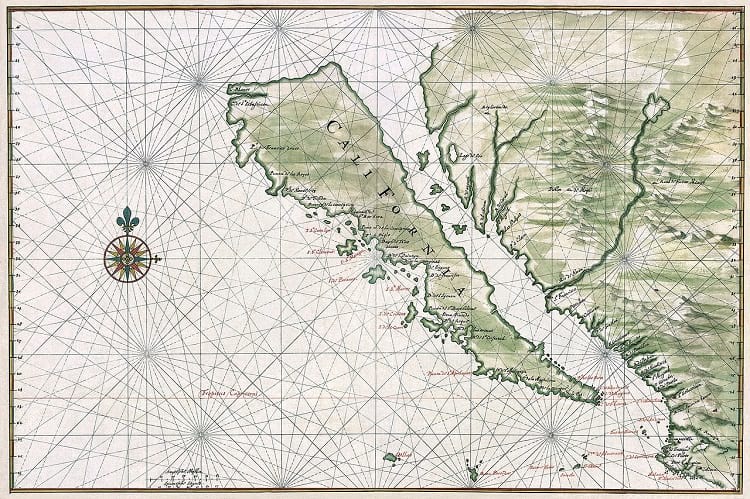
Outdated map representing California as an island. (Johannes Vingboons / Library of Congress)
If a map shows the names as of a river, mountain, desert, city, state or nation; it’s taken at face value. After all, maps are created by professionals and regulatory bodies; no question of doubting their veracity. But what if what is shown on the map is a mismatch with ground reality? What is shown as an island is, in fact, a peninsula? And people go on accepting the mistake as truth, for hundred years, even as there are interjections for course correction time and again. This happened with the state of California, in the Pacific region of the United States.
There is an Urdu couplet which says: moments faulted, and centuries suffered. This almost says how, for so long, Baja California existed on the world map as an island (which it is not), separate from the continent of America. The fault can be attributed to the Spanish novel, `The Adventures of Esplandian’ published in 1510 cast on its readership.
The novel described an imaginary island ‘California’, ruled by a queen named Calafia. So when the novel’s die-hard readers, the Spaniards, explored (today’s) Mexican peninsula of Baja California, they thought it could be no place other than ‘California’, the place they read about in the novel. It could only be an `island’, as narrated by the Author Rodríguezin de Montalvo. Author’s fascinating imagery, so it seems, overwhelmed their judgement. If the author deemed it an Island, it couldn’t be anything else. It couldn’t be peninsula even if the evidence on the ground said so.
A case of literature flowing into real life?
If real life can invade literature, the converse can also happen. And then, as they say: to err is human. Cartographers are humans and can make mistakes. California mapped as Island was a mistake, albeit it lasted long- for more than a century.
Mistakes happen for various reasons. In fact, the working of the human mind is such that what is ‘within’ the mind interacts with what is ‘without’. The result of this interaction decides the status of on-ground facts. Sometimes ‘within’ is so strong that ‘without’ is simply overlooked.
Mistaking a bush for ghost in human form and hearing voices in a silent zone prove that mind within can ignore the mind without, a process called delusion. For long, masses remained in a delusion that California couldn’t be different from its account in ‘The Adventures of Esplandian’. Thus delusion forces mind within on mind without. Next to delusion is another situation called illusion, which, simply speaking, is an error of judgement. A far off cloud on the horizon may look like an island. A village may look like a city. Third error of perception is ‘confusion’. Likewise, a cartographer may position a lake differently than where it actually exists on the ground. A bay may be confused with strait. Collected pieces of evidence seen in the wrong perspective can also lead to confusion.
But why should cartographic errors persist longer than these should?
‘Once geographic myths find a place on the map’, says Henry R. Wagner, ‘these are hard to trash even when hard evidence says these are nothing but imaginary’. It seems that people tend to believe maps blindly and scarcely think these could be wrong or misleading.

Satellite photo of Baja Peninsula. (NASA)
Surprisingly, the earliest North American maps of the 16th century show California as a peninsula. This was based on observation of Francisco de Ulloa who explored Bay of California in 1539. This got corrupted in the early 17th century with Father Antoneo de la Ascession quoting voyage of Sebastian Vizcaino (1602) and claiming that California got separated from the American continent by the ‘Mediterranean sea of California’. This passed California as an island on the world map in 1622.
The myth was carried forward by Abraham Goos’ in 1624 and Henry Brigg’s in 1625. The notion almost became universal till questioned by some Dutch Publishers. They were surprised that in spite of Father Kino proving California’s peninsular status in 1705, it continued to be shown as an island for over 100 years.
Beginning with Desiele’s map of America in 1722, the peninsular status of California was back on maps though many Cartographers continued to persist with its island image. Finally, it would need a state to dictate in 1747 to stop showing California as an island in diagrammatic representations.
According to Paul Kohen, the domino effect of California’s mythical island image began with a double-page map by Henry Briggs (London, 1625). A footnote by Briggs on the lower left corner of this map indicates that the myth of California being an Island originated in Spain. A Spanish ship carrying a map to this effect was captured by the Dutch. When the ship was moved to Amsterdam, European cartographers copied it ‘as such’ and became unwitting conduits to the charade that California was an island.
Myth persisted notwithstanding 16th-century edict to the contrary; call it mental inertia or the influence of a popular story. Only a royal decree passed by Ferdinand VII, the king of Spain would finally put it to rest in 1747.
Fact Analysis:
STSTW Media strives to deliver accurate information through careful research. However, things can go wrong. If you find the above article inaccurate or biased, please let us know at [email protected].
RELATED
The post When Default Becomes De facto: Island of California, the Cartographic Mistake Which Became the Gospel Truth appeared first on .
]]>The post The Uplifting Story About the Life of Paul Anderson – The World’s Strongest Man appeared first on .
]]>
Paul Anderson squatting with a cart wheel. (Andrea787878 / Vecchio giornale di body bulding)
He was there for the country when it needed him. A man with a gifted possession of not just the physical greatness, but also the valiant calibre and constitution of gentleness, kindness and good common sense.
When he appeared, standing tall at five feet ten and weighing around three hundred and seventy-five pounds, it was in the finest heroic tradition. The unmistakable Paul Anderson, an American strongman and weightlifter, barged into the scene virtually overnight. He played a pivotal role in recognizing powerlifting as a combative sport.
Early times
Paul Anderson, who was the only son of Robert Anderson and Ethel Bennett, was born on October 17, 1932, in Toccoa, Georgia. He started his weight training, early in his life, when he was just 14 years old. His uncle was the one who introduced him to weights. The family home’s backyard served as his weight training ground.
Paul had an upbringing that was not particularly noteworthy. He used to play football and displayed striking agility and speed. He took up his exercise regime with the sole intention to build his size and strength to play for the Toccoa High School football team. There he used to play in the back position.
He used to lift homemade weights which his father had made out of concrete and wood. Anderson exhibited exceptional skills as an athlete in high school. Later he attended the Furman University in South Carolina, on a football scholarship for one year.
The family shifted to Elizabethton, Tennessee afterwards. Gradually, Anderson started gravitating towards a group of individuals who also used to enjoy weight training. His mates later introduced Anderson to world-renowned lifter Bob Peeples. He used to write for the standout Iron Game magazine.
He was the one who greatly encouraged and inspired Anderson and introduced him into the then weightlifting arenas. The first reported citation of Paul’s exceptional strength came in the Iron Man magazine’s February 1952 edition where Bob Peeples prefaced Anderson and spoke about him.
Unusual as it may sound, Paul was short of having access to traditional weights at times. He created his own equipment which included drums loaded with concrete and iron wheels. He also put himself through a purposefully planned natural diet that boosted his strength and girth very much.
Paul used to believe that the squat was the foremost strength builder. He formulated his own training techniques and that included squats to a large extent. Methods like Anderson Squats, named after him have now become a regular practice.
Career and achievements
All through his twenties, Paul finished his preliminary strength competitions that included squatting of 605, 635, and 650lbs. he officially quashed a 30-year-old world record in squatting. He went on turning out to be one of America’s topmost competitors in weightlifting.
In 1955, when the Cold War between America and the Soviet Union was at its peak, Anderson travelled to Moscow for an international weightlifting competition. That time, he was the reigning title-holder at the USA’s National Amateur Athletic Union Weightlifting Championship.
There, Anderson performed a 402.5 lb (182.6 kg) press. He eventually broke the previous Olympic record of Alexey Medvedev, the Soviet champion who had earlier created history by lifting a 330.5 lb (149.9 kg) press.
At that juncture when Americans were thoroughly occupied in the Cold War with the Soviet Union, Anderson’s unbelievable power, his extraordinary tank-like image became a relationship revival call to all.
In October 1955, during the World Weightlifting Championships in Munich, Germany, Anderson went ahead clinching two more world records for 407.7 lb (184.9 kg) press. The victory in his weight category proclaimed him the world champion.
When he came back to the United States after winning the titles, he was received and applauded by the then Vice-President Richard Nixon for being such a phenomenal ambassador for amity and goodwill.
In 1956, Anderson picked up another gold medal in a lengthy, tough fight in the Melbourne Australia Olympic Games against Humberto Selvetti from Argentina in the super-heavyweight class.

Paul Anderson displaying his strength by lifting girl scouts in 1957. (Associated Press)
People in his hometown Georgia were too excited and ready to commemorate Anderson’s stupendous accomplishments. The then governor of Georgia declared 5tg July as “Paul Anderson Day”.
Anderson also garnered sundry notable mentions in the US Congress. The U.S. Government favourably deemed his commendable achievements as propaganda of America’s efforts to combat communism.
Paul had stated on a number of occasions as to how on his third and final try at Melbourne, he pulled the record weight up to his chest and realized all of a sudden that he could not lift it any higher. Alone. He told his audience in what way within a split second, he gave his voice to a lifetime affirmation to God.
Anderson could not be made eligible for the 1960 Olympics because he was no longer an amateur and was a declared professional weightlifter. By then, he had been accepting money every year with speaking sessions and strength exhibitions for numerous social services. All this, notwithstanding a persistent congenital kidney ailment he had that ultimately killed him.
His appearances offered him an opportunity to stimulate the audience to engage more in community services and embrace Jesus Christ. Time and again he would end his performance by reciting self-composed spiritual and patriotic poems.
He would execute magnificent stunts like hammering a nail with his bare thumb. He would also raise a platform carrying eight men on his back.
The Guinness Book of World Records in its 1985 edition listed his incredible deed of pulling up 6,270 pounds (2,850 kg) on his back “the greatest weight ever raised by a human being”. This comes to be the foundation for his unsurpassed eminence as the “World’s Strongest Man”.
Paul Anderson Memorial Park
The Paul Anderson Park, located in Toccoa is a chronicled and rousing tribute to the world’s strongest man. It is likewise homage to the humanitarian works he did for the society during his lifetime.
The only time when you do not get to see some blooming plants is during the winter when the fountain in the park remains frozen and assumes the form of a frigid and motionless blooming flower.

Paul Anderson Monument in Toccoa, Georgia. (Alex Cheek / Flickr)
The house of Paul Anderson is situated nearby and a monument stands in front of the yard. The recreation park is a brilliant spot for photo shoots, relaxation and an overall enjoyment site amid the peace-loving community of Toccoa.
Death, funeral, contribution and remembrance
Paul died at the age of 61 on August 15, 1994, because of complications arising from his chronic nephritis. He was a devout Christian and a teetotaler. Paul Anderson’s funeral was an intensely remarkable and unforgettable experience.
It may sound ironical, that the world’s strongest man had lived a life of only sixty-one years. The crowds who thronged his funeral came over not to recollect his Olympic performances or his feats that exhibited his enormous human strength. They came solely to speak about how the big man had changed the lives of several young individuals.
In the wake of attaining an exemplary level of non-professional success, Paul turned professional with an aim to exploit his talents and skills for raising funds to lend a helping hand to the troubled youth of the country.
In exchange of paid performances, he relinquished his amateur position and founded the Paul Anderson Youth Home in 1961 at Vidalia, Georgia along with his wife Glenda.
This decision was especially note-worthy keeping in mind the fact that Anderson could not qualify for the 1960 Olympics as an amateur status was mandatory in those times.
Anderson had also urged the country over to make generous donations for his Youth Home that offered shelter to thousands of distressed and dismayed teenage boys. By the time they left the house most of them had realized Anderson’s true source of power that motivated them to pick up the broken pieces of life and forge ahead.
The Youth Home still exists today and carries on with its mission of coming to the aid and succour of unsettled young men who might otherwise be incarcerated.
Enjoyed this article? Also, check out “Eugen Sandow: The Child Who Became the Father of Bodybuilding“.
Fact Analysis:
STSTW Media strives to deliver accurate information through careful research. However, things can go wrong. If you find the above article inaccurate or biased, please let us know at [email protected].
RELATED
The post The Uplifting Story About the Life of Paul Anderson – The World’s Strongest Man appeared first on .
]]>The post Human Greed for Power was Responsible for the Near Extinction of Bison during 19th Century appeared first on .
]]>
Pile of Bison skull, circa 1892. (Burton Historical Collection, Detroit Public Library)
The first species of the Bison was believed to be the Bison Priscus that existed more than a million years ago. It was found in the mammoth steppe which was a vast region spread across all continents.
The mammoth steppe was dominated by the bison, horse and woolly mammoth. North America boasted a population of 25 to 30 million bison in the 19th century, but sadly, there were less than a hundred by the end of the century. Apparently, the bison was hunted not only for meat but also for the revenue returns that the skin and bones generated, especially from the European market.
The Native American diet
Bison are social animals and are known to move about in herds and often, all gather around a dying one. This behaviour made their hunting easier than any other animal. The fact that the meat from one Bison could feed an entire tribe also made it the preferred source of food.
Bison hunting was primarily, an activity that the Native American tribes engaged in, mainly for food and economy. A herd of Bison would be held in a crude animal enclosure and then forced into a stampede over cliffs, known as Buffalo jumps. Hunting of this method required help and was often a communal activity. The herd would be driven into channels made out of rocks towards a cliff wherein the commotion; the buffalos would run off the cliffs. Tribesmen at the end of the cliff would then kill the ones not dead, with spears and arrows.
The tribes believed in killing an entire herd due to the notion that if one survived, buffalos would then adapt and learn to avoid humans. Such sites have a very important historical value as they help in understanding the life of Native American tribes or Native Indians, as they were more commonly called.
Buffalo jump sites are easily recognised by the pathways made of rocks leading to a cliff. They are an indication of a tribal camp nearby, which are then studied by archaeologists by collecting evidence from the abandoned camps.

American natives hunting for bison by camouflaging themselves with bison hide. (Remington, F., Detroit Publishing Co / LOC)
As mentioned earlier, the bison was an integral part of survival for Indian tribes, each and every part was utilised. The hide was not only used for selling but also for clothing and shelter. The bones were sold and also used for making tools.
Similarly, the sinews were turned into laces and bowstrings, the grinding of hooves formed a glue-like substance, the brains were instrumental in turning the skin into leather, and the preserved fat known as pemmican was an essential part of Native American food.
Kill a bison to get rid of an Indian
In 1830, the Indian Removal Act was passed, which led to the forced removal of Native Indians away from the European American populated areas. The US Army, under the influence of the government, is said to have been instrumental in the extensive slaughter of bison herds.
The main objective of such heinous acts was to deprive the Native Indians of their main source of food and income, thus weakening them into submission. The biggest supporter of this strategy was General William Tecumseh Sherman who, according to an article published on June 26, 1869, in the Army-Navy Journal had mentioned in a conversation, the idea to send soldiers out to the Indian settlements to shoot buffalos till there were none left.

General William Tecumseh Sherman. (Mathew Brady / National Archives)
In 1867, Col. R.I. Dodge, the officer commanding Fort McPherson in Nebraska and responsible for forcing the Indians into settlements is said to have told a British hunter, Sir W.F. Butler to, “Kill every buffalo you can. Every buffalo dead is an Indian gone.” In 1870, General Phil Sheridan went one step ahead when he tried to coax the state legislature in Texas to recognise American buffalo hunters with a medal of honour. He went on to even suggest the design of the medal in bronze with, “a dead buffalo on one side and a discouraged Indian on the other.”
It was quite evident that the over killing of bison was purely to subjugate the Native Indians, and the greed for power was another cause for the near extinction of this species.
Efforts to protect and revive the American bison
An American zoologist and the first director of the New York Zoological Park, William Temple Hornaday, had written “The Extermination of the American Bison” in 1887, predicting the extinction of the bison in 20 years.

American conservationist William Temple Hornaday with a bison calf. (Smithsonian Institution Archives / Image Number 74-12338)
In 1905, the 26th President of the United States, Theodore Roosevelt Jr. supported Hornaday in founding the American Bison Society, for the resurgence of the bison. By 2015, after 110 years of its inception, the society had managed to restore bison in the wild in large parts of Canada and America with an ongoing survey for restoring ecological conditions for the bison in North America.

1902: The last herd of buffaloes, Canada. (Steele and Company / British Library)
American rancher and South Dakota politician James “Scotty” Philip is often remembered as the “Man who saved the Buffalo” due to his efforts to prevent the extinction of bison. In 1901, Philip set up a pasture near the Missouri River, for his herd of 74 bison that he had acquired over time from people who had rescued bison calves. By the time Philip passed away, his herd had grown to nearly a thousand.
Newspapers wrote that as his funeral procession moved towards the family cemetery near the buffalo pasture, some of the bison came down the hills to watch it pass by, “showing their respects to the man who had saved them.”
Fact Analysis:
STSTW Media strives to deliver accurate information through careful research. However, things can go wrong. If you find the above article inaccurate or biased, please let us know at [email protected].
RELATED
The post Human Greed for Power was Responsible for the Near Extinction of Bison during 19th Century appeared first on .
]]>The post Baltic Way: When Two Million People Formed a Human Chain, Demanding Freedom appeared first on .
]]>
Baltic Way: Baltic chain demonstration in Lithuania. (Rimantas Lazdynas / Wikimedia Commons)
Freedom is a relative term. For some it could mean release from oppression; for some it could mean to live their life on their own terms or free will. For many others it could mean freedom from the laws laid down by their country. The latter is precisely the term that led three Baltic countries, namely Estonia, Latvia and Lithuania, which were occupied by the Soviet Union, to rise against the rule and stand as one.
On August 23, 1939, the Soviet Union entered into a secret, non-aggression pact with Nazi-led Germany. Also known as the Molotov-Ribbentrop Pact, it was signed in Moscow between Foreign Affairs Ministers Vyacheslav Molotov and Joachim von Ribbentrop of the Soviet Union and Nazi-Germany respectively.
During World War II, as per the highly secret Pact, countries in Eastern and Northern Europe were to be divided between the Soviet Union and Nazi-Germany. Both the powerful nations hoped for territorial and political rearrangements of the smaller countries.
The Soviets began occupying areas that lay close to the Baltic Sea and kept denying the protocols of the existing secret Pact. Till the mid-80s, the Soviet Union was in denial of the covert Nazi-Soviet Pact and continued to occupy the three Baltic States, asserting that they had joined voluntarily.
The Baltic Way
On the 50th anniversary of the Pact, on August 23, 1989, the three Baltic nations decided to call it quits. Having had enough of the secrecy and the Soviet occupation of their areas, people of Latvia, Estonia and Lithuania demanded the Soviet Union to go public and come clean on the confidentiality of the Molotov-Ribbentrop Treaty.
They also demanded restitution and independence from the Soviet rule. And so, at around 7 p.m. local time, as a mark of protest, as many as two million people from Estonia, Latvia and Lithuania joined hands together to form a human chain that spanned approximately 670 kilometers.
The citizens of the three Balkan nations came together for a peaceful political demonstration that began in Tallinn – the capital city of Estonia – and made their way through Riga in Latvia to Vilnius, the capital of Lithuania.

Baltic way peaceful demonstration. (Kusurija / Wikimedia Commons)
Known as The Baltic Way or The Chain of Freedom, the peaceful protest was a unique method of expressing public dissent. It united people from three different nations that wanted freedom from one Soviet rule.
Organised by the national movements of the three countries – Latvian Popular Front of Latvia, Rahvarinne of Estonia and the Sajudis of Lithuania – the living chain was a message to the USSR that its five-decade-long illegal occupation in their nations was about to come to an end.
Not only men but women and children, too, from every nook and cranny of the three countries made their way towards the epicenter of the protest in opposition of the Soviet annexure of their states. Exiled Latvians, Estonians and Lithuanians in the cities of Berlin, Melbourne, Stockholm, Toronto, Leningrad and Moscow also stood in solidarity with the two million people that had formed a chain in the capital cities of the three Baltic countries.

Protest in Šiauliai on the same day, with three coffins decorated with national flags placed under Soviet and Nazi flags. (Rimantas Lazdynas / Wikimedia Commons)
The after-effect
The peaceful display of disagreement by such a large number of people from different countries made international news and also gave rise to the term “Singing Revolution”. It was where people of the three Baltic countries (started by the Estonians) held hands and sang patriotic songs all night long in objection.
This unlikely unity pieced together a chain of events that led to the total independence of the three Baltic States in the year 1991. The Chain of Freedom later also helped in Moscow owning up their crimes and rendering the Nazi-Soviet Pact invalid. This helped in freeing the three countries from the Soviet rule two years later. The Baltic Way also served as a precursor to the fall of the Berlin Wall on November 9, 1989, uniting Germany as one.

Aerial photo of the Baltic chain. (National Museum of Lithuania)
Today, one does not get to see such peace and harmony among different nations of the world that come together and stand up for a common cause. The Baltic Way was one such rare example of non-violent political demonstration (another oddity in today’s times), which gave the people of Estonia, Latvia and Lithuania the freedom they deserved from the Communist Soviet Union.
Enjoyed this article? Also, check out “Rejected for Paris, Project Plan Voisin is Accepted Part of World Architecture“.
Fact Analysis:
STSTW Media strives to deliver accurate information through careful research. However, things can go wrong. If you find the above article inaccurate or biased, please let us know at [email protected].
RELATED
The post Baltic Way: When Two Million People Formed a Human Chain, Demanding Freedom appeared first on .
]]>The post The Amusing Tale of Sinbad – The Sailor Dog appeared first on .
]]>
Sinbad with his crew on Campbell. (USCG Historian’s Office)
As children, we were often told the stories of Sinbad the Sailor. No matter how amusing they were or are, we all know that they are mere fiction. But there is another story of a ‘real’ Sinbad who also happens to be a sailor full of valour. But this time it’s an incredible tale of a ‘dog’.
Sinbad was the name of a mix breed dog that rose to fame when he became the mascot of the US Coast Guard. Sinbad served an 11-year long period service at the USCGC Campbell, which patrolled the Atlantic waters and helped the Allied army in the Second World War. During his valuable service period at USCGC Campbell, he frequently shuffled between promotion and demotion.

USCGC Campbell. (U.S. Coast Guard)
How did a dog become a sailor?
Sinbad’s journey as a sailor began unintentionally. In 1937, one of the USCGC Campbell’s crew members, A.A. “Blackie” Roth, bought a puppy as a ‘goodbye’ gift for his girlfriend. What he forgot was that his girlfriend’s landlord had a ‘No Pets’ policy so she could do nothing but refuse. After denial from his girlfriend’s side, Roth smuggled the puppy onto the ship in his duffel bag around 8 PM that night. The night passed silently, no one, except few of his mates got to know that there was a puppy onboard.
However, the next morning, while the captain was briefing his crew about the responsibility they had on their shoulders, the puppy managed to make his presence known by barking at the captain. The crew instantly developed a bond with the puppy and pleaded with the captain to let him stay. The captain allowed the puppy to stay onboard, given that he was the responsibility of the crew and would learn the necessary etiquettes.
How did the sailor dog fit in?
The dog was to be named, after intense discussion, everyone settled for ‘Sinbad’, the name was perfect for a sailor. Soon he was formally enlisted with his paw impression. Sinbad was now an official part of the Campbell. He was given his own uniform, bunk, service record and IDs (including Red Cross.)

K9C Sinbad. (US Coast Guard)
Eventually, Sinbad learned the daily routine of the ship. He would wander around in the gallery at the time of mess, aware of the fact that food is on the way. He would often share racks with other sailors, occasionally taking a lick of their coffee.
How important was he to the sailors of Campbell?
He was considered a valuable member of the Campbell during the Second World War as it was commonly believed that the ship was ‘unsinkable’ as long as Sinbad was on board. In February 1943, Campbell was part of the ‘48-ship Convoy ON-166.’
The convoy was attacked by U-boats. Campbell fought with the U-boats but was eventually stranded for 9 days until rescue came. Repairs were required, as a result only necessary personnel were ordered to remain onboard. Sinbad, being the lucky charm, stayed on board.
However, during warfare, Sinbad would hide below a sailor’s bunk, with his paws on his ears to avoid the loud gunfire. But, as soon as peace restored, Sinbad would rush to the deck to celebrate and motivate the fellow sailors.

Sinbad keeping an eye from USCGC Campbell. (26-G-1979 / U.S. Navy)
The Greenlandic controversy
Also, Sinbad almost created an international controversy in 1940. With Nazi occupation of Denmark, USCGC Campbell was sent to Greenland (a Danish territory then) to negotiate and develop diplomatic ties. Being fond of land, Sinbad enjoyed the wide open spaces. However, he was more interested in chasing the sheep that happen to graze there.
Greenland is a country with very limited resources, and as a consequence, herding is an important activity to sustain life. Sinbad’s ‘fun’ game of chase and run with the sheep had a severe impact on sheep. A few sheep died due to exhaustion, others were reluctant to go out grazing.
Locals were really unhappy with this; they demanded the captain to kill Sinbad after he was traced to USCGC Campbell. The captain issued an order banning him from Greenland.
Life away from the sea
After the war ended, Sinbad was promoted to the rank of K9C-Chief Dog for 6 years of remarkable service at the sea. But just a few weeks after he earned the title, he lost it for insubordination. In fact, Sinbad was promoted and demoted several times throughout his career.
Sinbad was awarded a total of five battle stars and six campaign ribbons during his service period. After he retired as Chief Dog (he regained the post) in 1948, he went on live a peaceful life at Barnegat Light Coast Guard station, New Jersey.
Sinbad died on 30 December 1951, at the age of 14. He rests near the flagpole of the light station. The spot is marked by a monument. He is one of two dogs “to be classified as non-commissioned officers rather than property by the US military”.
Enjoyed this article? Also, check out “Pep The Dog, Who Was Sentenced to Life in Prison for a Murder He Didn’t Commit“.
Fact Analysis:
STSTW Media strives to deliver accurate information through careful research. However, things can go wrong. If you find the above article inaccurate or biased, please let us know at [email protected].
RELATED
The post The Amusing Tale of Sinbad – The Sailor Dog appeared first on .
]]>The post Krakatoa Volcano: An Earth-Shattering Explosion That Ruptured the Eardrums of Many appeared first on .
]]>
A lithograph of 1883 eruption of Krakatoa. (Parker & Coward, Britain / Royal Society)
We all know that a volcano is a devastating force of nature, which leaves nothing but a trail of destruction in its wake. But did you know that a 135-year-old volcanic eruption in modern-day Indonesia was so catastrophic that almost half the world heard it in dead silence while the other half was caught in its aftereffects? News of tragedy that accompanied the eruption of Krakatoa volcano spread far and wide, making it one of the world’s deadliest volcanic eruptions, with the loudest sound ever heard in human history.
In May 1883, captain of a German warship named Elizabeth reported seeing black ash clouds arising out of Krakatoa in the Sunda Strait, which lay between the islands of Java and Sumatra in Indonesia. In the days that followed, several other eyewitnesses on commercial and chartered vessels reported hearing loud explosions and seeing incandescent clouds over the island.
Locals are believed to have celebrated the natural spectacle of fireworks, until it all came to a halt on August 27, 1883, when Krakatoa entered into a paroxysmal phase and erupted, producing a boom so loud that it not just claimed around 36,000 lives, but also ruptured the eardrums of many that heard it thousands of kilometers away.
A day prior to the ill-fated date, Perbowatan, one of the three cones of the volcano on Krakatoa, began spewing out ash, pumice and steam, which started to develop vents between Danan and Rakata, the other two cones of the volcano. On August 27, the difference of pressure resulted in four huge blasts, expelling volcanic gas, hot magma and debris from inside and a loud explosion tore through the island, which was heard 4800 km away in Perth in southwest Australia and 4600 km away on Rodriguez Island in Mauritius in the Indian Ocean. The earth-shattering sent shockwaves around the world and the force of the blast was said to be 13000 times greater than the nuclear bomb – Little Boy – dropped on Hiroshima during WW-II.
The aftermath of the explosion
Following the explosion, mountainous tidal waves in the form of tsunamis, as high as 40 meters, began engulfing the 167 coastal villages, quickly killing people that had begun to run towards higher grounds after the volcanic eruption. Ships on voyages near the island were caught in the gigantic waves and eventually sunk to the bottom of the ocean killing many onboard. Thick, black ash clouds blocked out the sun for many weeks and the global temperatures temporarily began to lower as a result. This led to more reddish sunsets while green-blue hues in the sun were observed as far away as in New York.
The volcanic eruption threw ash as far away as 850 kilometers in Singapore and corpses of those that died as a result of tsunamis, floated in the ocean and were discovered as far away as in South Africa. For five days after the explosion, barographs recorded the passage of atmospheric pressure waves bouncing back and forth between Krakatoa and its antipodes as many as seven times. The worldwide devastation that Krakatoa had unleashed became one of the first reported global media events during that time.
Not many know but Norwegian painter Edvard Munch’s famous work of art of 1893 – “The Scream” – is also said to have been inspired by Krakatoa’s tragic events of 1883. Art enthusiasts have debated that the vividly glowing reddish-orange sky above the figure in the foreground describes the artist’s inner angst, astronomers blame it on Krakatoa.
People were largely affected by the volcano almost everywhere in the world, with many hearing its explosions, several others losing their lives and some more seeing its consequences across the globe. The reddish sky in Munch’s painting is also said to be a result of Krakatoa, which was experienced a decade later in Norway too.

Photo of Anak Krakatau taken a week after 2012 eruption. (Buitenzorger / Flickr)
As the islands in Indonesia lie above two tectonic plates, the island nation has witnessed the regular eruption of active volcanoes in the past, but none were as cataclysmic as Krakatoa or Krakatau as local people call it. Almost one-third of the island has been wiped out after the disastrous explosion of 1883 and two-thirds of the island collapsed beneath the sea into an empty magma chamber created after the volcanic activity subsided.
A new island of Anak Krakatoa (dubbed by locals as the Child of Krakatoa) sprung up in 1927 from the caldera that formed after the massive volcano died down, which is also the current site of an active volcano in Indonesia. Though Anak Krakatoa does not pose a threat to the surroundings, it still stands to this day, spewing ash and debris every now and then (last activity recorded in July 2018), reminding us of the horrific events that its predecessor had let loose more than a century ago.
Enjoyed this article? Also, check out “The Great Fire of London: The Blaze That Destroyed 80% of England’s Capital“.
Recommended Visit (caution):
Anak Krakatau | Lampung, Indonesia
Fact Analysis:
STSTW Media strives to deliver accurate information through careful research. However, things can go wrong. If you find the above article inaccurate or biased, please let us know at [email protected].
RELATED
The post Krakatoa Volcano: An Earth-Shattering Explosion That Ruptured the Eardrums of Many appeared first on .
]]>The post The Bizarre Yet Wonderful History of San Francisco’s Cliff House appeared first on .
]]>The first San Francisco’s Cliff House
In the year 1863, Senator John Buckley and C. C. Butler built the first Cliff House. However, certain anecdotal evidence also speaks about Samuel Brannan, a wealthy American businessman as the original builder of Cliff house who constructed it in 1858. In the beginning, because of its disadvantageous location on the craggy, rock-strewn hills of the Lands End that opened out over the Pacific Ocean, it was becoming very expensive to reach there.

The first cliff house. (Lawrence & Houseworth, Publisher. The Cliff House – San Francisco. , 1866)
Owing to the difficult journey Cliff House was kept isolated for a long time. To address this problem a toll road “Point Lobos Avenue” was constructed till the Ocean Beach, which facilitated in bringing visitors from San Francisco with the help of a stagecoach.
Soon Cliff House became the regular exclusive haunt of the super-rich and the affluent like the Stanfords, the Hearsts and sundry well-to-do families who could afford to pay a round-trip fare of $1 and thoroughly enjoy the views, the oysters and the champagne.
After a decade of a prolific successful run amongst the rich and the famous, the resort started failing in business. To attract new patrons, the management permitted intake of alcohol and the practice of gambling. During this time, Golden Gate Park also opened and so did many public roads that lead straight to the beach.

Photo of the first cliff house from another angle, circa 1868. (Carleton E. Watkins / LACMA)
With the influx of new customers, a sizeable number of them being from the working class, the destination gradually started losing its calibre and upmarket lustre. By the end of the 1870s, the once decent and reputable Cliff House was considered to be no longer a respectable destination resort.
Adolph Sutro, a mining engineer and philanthropist, who eventually became the Mayor of San Francisco, bought the Cliff House resort in 1883. With a mission to reinstate its lost glory and admiration of being a family-oriented tourist trap, Sutro embarked upon an ambitious renovation project. He hired a lot of employees and sanctioned a new railroad pathway to augment accessibility.
Unfortunately, Sutro was unable to operate and manage the restaurant himself. Therefore, he leased it out to Sroufe and McCrum, a wholesale liquor company. It was later again rented out to J. M. Wilkins in 1885 with the sole target of bringing the families back.

The renovated and slightly expanded version of the first cliff house. (Ed Bierman / Flickr)
In 1887, the resort met with a severe calamity, when a schooner (sailing ship) called Parallel, loaded heavily with 40 tons of explosive underwent a massive head-on collision with the rocks underneath the restaurant structure which in turn exploded and the north wing of Cliff House was fully destroyed. The devastation was restored and Cliff House was rebuilt. It continued its operation until the Christmas day in 1894 when another cataclysmic chimney fire broke out and engulfed and annihilated the whole building in just 30 minutes.
The second Cliff House
In February 1896, the venue opened again to the public, this time as a replica of a Victorian French Chateau, after a colossal reconstruction work was carried out by Sutro that cost over $75,000. An added attraction, this time was the observation tower that was erected 200 feet above the sea level facing the Pacific Ocean.
The newly revamped resort was a seven-storeyed building hosting a number of restaurants, an art gallery, a studio, a gem exhibition centre, leased out reception rooms, countless exclusive dining rooms and bars. It was also called the “Gingerbread Palace”. The same year ushered in the construction of the famed Sutro Baths on the northern side of the restaurant.

The second Victorian styled cliff house. (U.S. National Archives and Records Administration, Publisher. Cliff House and Seal Rocks)
The widely popularized baths housed six giant indoor swimming pools, a skating rink, a museum and other recreation grounds. Cliff House, one more time, secured its erstwhile acclaimed footing and resumed patronizing the super elite class with the likes of Teddy Roosevelt and William McKinley.
In 1898, when Adolph Sutro died, Cliff House was once more leased to John Tait. Mercifully, Cliff House managed to survive the calamitous San Francisco earthquake in 1906. It was planned to recommence its operation in the September of 1907 when regrettably, it caught fire another time and was totally decimated.

Cliff house on fire, September 1907. (Historic American Buildings Survey / LOC)
The third Cliff House
The property was later taken over by Emma Sutro Merritt, Sutro’s daughter in 1908. She reconstructed the Cliff House with fireproof concrete material and steel. Although the new building was much smaller in size, it anyway intermingled with the neighbouring locale instead of counterpoising the view of the ocean. It opened again in 1909, nonetheless obliging to the wealthy and affluent.
The resort eventually downed its shutters once more in the year 1925, when during the Prohibition, its patronage plummeted sharply. It changed hands and became the property of George and Leo Whitney who then owned a neighbourhood amusement park named Playland-at-the-Beach. Cliff House for the umpteenth time was overhauled and reopened in 1938. It kept on with its steady operations until 1977 when the National Park Service took over its complete ownership rights and the resort became a part of the Golden Gate National Recreation Area.

The third cliff house, circa 1950. (Mike Roberts Color Production / Wikimedia Commons)
The National Park Service later signed a contract for the maintenance and management of the Cliff House with Dan and Mary Hountalas, as the deemed concessionaires. They have been managing and running the resort under the renewed contract name of Peanut Wagon over the past forty years. They were significantly instrumental in the completion of a comprehensive site restoration project in 2003 for the Cliff House when the building was reinstated to its foregoing 1909 appearance after removing a lot of Whitney’s modifications. Now, the official address of Cliff House is 1090 Point Lobos Avenue.
It is superbly designed with ultra-modern skylights. A new two-storeyed wing after the name of Adolph Sutro is also constructed overlooking the wreckage of the Sutro Baths that was completely gutted on June 26, 1966. The major offerings are a handful of party rooms, two major restaurants, a chic and stylish bistro meant for casual dining and the more traditional Sutro’s. The Terrace Room serves an as-much-as-you-can-eat-and-drink Sunday champagne brunch buffet. The Bistro always has a first-come-first-serve policy.

Cliff house photo, taken in 2010. (Brocken Inaglory / Wikimedia Commons)
In the present day, Cliff House has garnered unprecedented popularity among the local natives for countless wedding receptions and holiday parties. It also provides a soul-stirring getaway to relax and unwind by enjoying the breathtakingly beautiful scenery of the Pacific Ocean through the expansive floor-to-ceiling windows of the Sutro’s restaurant.

Cliff house today. (Justmerriam / Wikimedia Commons)
The building also accommodates a gift shop and the momentous “camera obscura” in the Land’s End area on a deck looking on to the ocean.

Camera obscura and holograph gallery at the cliff house. (Robert Bruce Livingston / Wikimedia Commons)
The jinx of the Cliff House and Sutro Baths
Over the years, there have been occurrences of a number of preposterous incidents surrounding the Cliff House and Sutro Baths that have the makings of a perfect horror flick. Mediums believe that the Cliff House area has always been overpowered by an uncanny energy. As the legend goes, a fidgety apparition that wanders tirelessly through the rocks adjoining the Cliff House belongs to Natalie Salina Harrison, who waited all her life, on the shore, for her fiancé to come back from the World War I. Her anticipation and expectation were all in vain and she died a broken-hearted tragic death. Since 1917, rumours of people having encountered her spirit started pouring in.
Even the ruins of the Sutro Baths are claimed to be haunted suggesting the prevalence of sporadic paranormal activities. The “ghosts” of a drowned old man and a woman are said to frequent the spot. Many people have also reported having seen phantoms of Victorian ladies sauntering along the beaches with parasols. It is known that the land around Cliff House used to be the Golden Gate Cemetery. This undeniably has not eased up the spectre of the weird form of energy from that area. These days, the potential risk of getting engulfed and surged over by an aberrant wave is the most critical concern for people visiting Cliff House.
But all these creepy stories of the world cannot deter the place’s burgeoning popularity among the locals and tourists, thanks to its spellbinding panorama and the captivating history. Maybe that is the reason why all those spirits here have stayed around too.
Recommended Visit:
1. Cliff House | San Francisco, USA
2. Sutro Baths (Historical Landmark) | San Francisco, USA
Fact Analysis:
STSTW Media strives to deliver accurate information through careful research. However, things can go wrong. If you find the above article inaccurate or biased, please let us know at [email protected].
RELATED
The post The Bizarre Yet Wonderful History of San Francisco’s Cliff House appeared first on .
]]>The post Seppuku: The Japanese Suicide Ritual, Where Death is Better Than Disgrace appeared first on .
]]>
Staged photo of Seppuku ritual being performed. (Rev. R. B. Peery / The Gist of Japan)
Taking one’s own life or attempting suicide is a criminal offence in many countries; but in the 12th century feudal Japan, in a highly ritualized ceremony, noble military warriors or samurais, as they are known, gave up their lives to protect their honour.
The samurais of Japan are known widely for their agility and their blade-wielding prowess and that is how they committed Seppuku, colloquially known as Hara-kiri – a deadly suicide ritual, which was practised in Japan during the 12th and 18th centuries before it was abolished.
The word Seppuku means cutting of the abdomen, which is borrowed from a mix of Chinese and Japanese terms – setsu and fuku. It was a traditional ritual where a samurai committed suicide by disembowelment.
Back in time, when a noble military man lost in war, he committed Seppuku to avoid the shame that came with the loss and also the torturous execution that could follow, lest he was captured by the enemy.
Honour and loyalty were above all else to Japanese warriors and for the atonement of his defeat, a samurai resorted to the suicide ritual. A warrior committing an act of Seppuku was considered highly honourable, even by warriors in the enemy camp.
The ritual of Seppuku
The fatal practice was carried out in great detail. On the day of the ritual, a samurai was bathed, dressed in spotless, white clothes to prepare for the ritual, before being given a last meal, consisting of his favourite delicacies. A small wooden stool was provided to him, which had a cup of ceremonial drink, some handmade sheaves of paper and writing equipment.
The warrior had to write a poem about death while a kaishakunin, or the assistant (or the wingman in general), prepared his blade to decapitate the samurai, as he embraced death slowly by disembowelling himself. The warrior would then take a sip of the drink and with the help of his sharp tanto (knife), cut his abdomen from left to right, while sitting on his heels with his knees bent. The kaishakunin would then sever the head of the samurai with a single blow of his sword, which would lead the samurai to bleed to death eventually.
It is sometimes said that Seppuku is actually carried out by the kaishakunin, but there have been no facts to corroborate the speculations.

Tanto knife which is used for stomach disembowelment. (Rama / Wikipedia Commons)
As per traditions, Seppuku was also carried out by wives of samurais, who brought disgrace to their kingdom. The women did not employ a kaishakunin; but they would rather tie their knees together and cut off their carotid arteries in a single stroke of a blade, which aided in a quick death and also helped them die way before the enemies came to capture them.
The last true samurai
Saigo Takamori is considered to be one of the greatest warriors in Japanese history and also the last samurai to have ever lived. In 1868, when political revolution dawned upon Japan post the Boshin War, Emperor Meiji took over the reins of the country and Saigo Takamori, despite being a samurai, became his key advisor.
After leading his nation to glory over the years, he settled as a military teacher, training future samurais, until the Battle of Shiroyama required him to fight for his country. With very little left to conquer in the war, Saigo Takamori was injured and that same day, he committed Seppuku, arguably the last true samurai to do so.

Portrait of Saigo Takamori, the last known true samurai. (Edoardo Chiossone / Kinsei Meishi Shashin Vol. 1)
The term Seppuku is also greatly associated with the “Ako Incident” or the suicide of 47 leaderless samurais, the stories of which have become a stuff of legends in Japan. In 1703, a feudal lord named Asano Naganori went to the castle on business. There was a heated argument between Naganori and a senior court official named Kira Yoshinaka over a trivial matter, which led the former to wound the latter in the palace – an act that was considered punishable.
Naganori committed Seppuku and in turn, he had to surrender his lands and at the same time was also deprived of his family. His loyal warriors became ronin or leaderless samurais. To avenge the death of their master and bring back their lost honour, forty-seven of them confronted Yoshinaka, who refused to commit Seppuku. And so, they decapitated him and then committed the ritualistic Seppuku, thus getting immortalized as the 47 ronin.
Although the customary act of Seppuku is completely done away with after feudal system died in Japan, one might still come across curious little incidents of Seppuku, where once in 1970, writer Yukio Mishima, known for his violent novels, performed Seppuku; while in 2001, national Judo gold medalist Isao Inokuma committed the ritualistic suicide after his company ran into major financial losses.
Enjoyed this article? Also, check out “Unit 731: Gruesome Human-Experimentation To Test Biological And Chemical Warfare In Japan During WWII“.
Recommended Read:
Seppuku: A History of Samurai Suicide | By Andrew Rankin
Fact Analysis:
STSTW Media strives to deliver accurate information through careful research. However, things can go wrong. If you find the above article inaccurate or biased, please let us know at [email protected].
RELATED
The post Seppuku: The Japanese Suicide Ritual, Where Death is Better Than Disgrace appeared first on .
]]>The post The Story of The Most Inspiring Football Match in History: Christmas Truce of World War I appeared first on .
]]>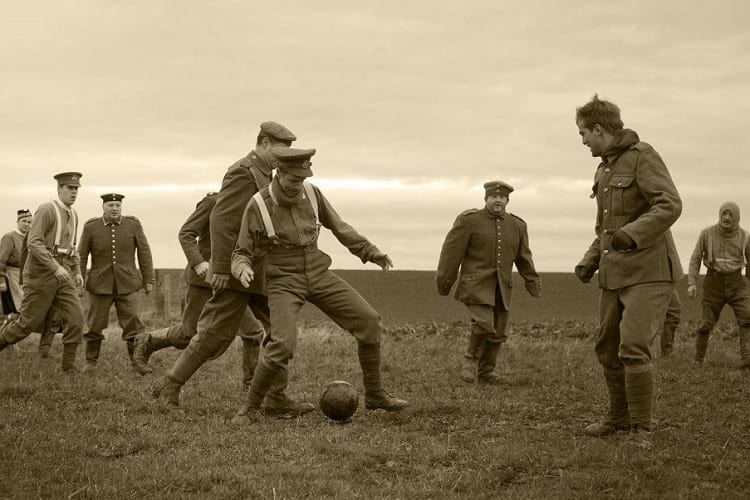
British and German soldiers playing a friendly soccer match in “no man’s land”(reenactment). (Wikimedia Commons)
War is deadly. It brings destruction and despair. It maims the population, slaughters the army and crumbles the government. The New York Times has reported that “Of the past 3,400 years, humans have been entirely at peace for 268 of them, or just 8 percent of recorded history.” According to estimates, throughout the course of human history, war has taken a toll on the life of about 1 billion people. In fact, in the last century itself, a minimum of 108 million people lost their lives due to war.
When we visualise about a war scene, thoughts about bullets, blood, and hatred are the first set of things to enter our mind. But for a minute, imagine two rival armies coming out of their trenches to play football and celebrate Christmas together in the middle of the battlefield. This is the inspiring true story of the Christmas Truce of World War I.
The Christmas truce of World War I
During the winter of 1914, the war was in its early stages. During the war, trenches became the lifeline of the soldiers, they protected the soldiers from artillery and enemy fire. By the November of 1914, a very long network of trenches had been laid. On both sides, the armies took defensive positions. The war had evolved in a tedious manner and it was commonly believed that the war would come to an end by the Christmas and the soldiers would return home.
However, things turned out to be different. It was Christmas Eve and the soldiers were still stuck in muddy trenches, there was no news of a trip to ‘home’. As dusk fell, it started snowing. The sight was magical. The British headquarters received a baffling message around 8:30 P.M., “Germans have illuminated their trenches, are singing songs and wishing us a Happy Xmas. Compliments are being exchanged but am nevertheless taking all military precautions.” As the trenches were often closely located, one side could easily hear the other. Throughout the starry night, both sides continued to entertain each other with Christmas carols. The German “Silent Night” met with the melodious British “The First Noel.” Not a single shot was fired that night.
At the break of dawn, they exchanged greetings however, both sides were still sceptical of the each other. Expecting a treachery, men on both the sides kept their hands glued to their guns. However, eventually, the feeling of betrayal gave way to trust and officers from both sides emerged and crossed the parapet of barbed wires that had been separating them and met in no man’s land. Not sure of what to do, they started to shake hands and exchange greetings.
Soon enough, the area of few yards between the trenches was filled with hundreds of ‘alive’ soldiers shaking hands with the men they were sent to kill. They exchanged small gifts such as uniform buttons, caps and food items. Men from both sides brought mugs and started to drink rum and smoke tobacco, celebrating Christmas. Not only this, they made arrangements to mutually bury their deads. Someone from the British side had received a football as a Christmas gift, soon a match kicked off. It was far from a professional football match, it was more of a bunch of war veterans kicking the ball around.
Mr. Felstead, the last known survivor of the Christmas truce retrospects to tell The Economist, “There could have been 50 on each side for all I know. I played because I really liked football. I don’t know how long it lasted, probably half an hour.” Nevertheless, the Germans have been reported to beat the British by a score of 3-2 in the match that took place that day. The men were exhausted by the humid conditions, still, they played their hearts out. Perhaps they knew that most of them wouldn’t live to recall this beautiful moment. The men seemed to have found a moment of peace and tranquillity amidst of the war that they might not get out alive of.

A colourized photo of British and German troops meeting in the no man’s land. (Cassowary Colorizations / Flickr)
But, soon the harsh realities of war made them return to their trenches and fight the men that they befriend a few moments ago. However, the message of the truce was out and widespread. The authorities from both the sides took stringent measures to make sure that there is no truce. War went on for 3 more years just to claim lives of about 38 million innocent people and soldiers.
Regardless of the fact that the Christmas truce was a mass mobilized event, it was not uniform. The truce was something that took place “scattered along a fairly small area of the front line” says Taff Gillingham. It was not just a single event, rather a series of events along the front line. A few casualties were reported on that day. Soldiers were shot by their enemies who didn’t anticipate a truce. The most reliable record of this recreation is available for the Royal Warwickshire Regiment which was posted in Flanders, near to the French border.
The spot is marked by a wooden cross and makes a popular tourist location. Another ‘Christmas Truce’ memorial was inaugurated on 12 of December 2014 by the Duke of Cambridge. It has been named as the “Football Remembers Memorial.”

A wooden cross now stands in the zone where the Christmas truce took place. (Redvers / Wikimedia Commons)
No one knows everything about the Christmas truce and everything known is mostly from personal records such as diaries, letter, and oral testimonials and cannot be easily accepted without scrutiny. This blurred story continues to remind the world the tryst with peace between Germans and British soldiers during the dark hours of World War I.
Enjoyed this article? Also, check out “Sir Adrian Carton de Wiart: The One-Eyed Invincible Soldier“.
Recommended Read:
Silent Night: The Story of the World War l Christmas Truce | By Mary Higgins Clark
Optional Visit:
Memorial Christmas Truce 1914 | Belgium
Fact Analysis:
STSTW Media strives to deliver accurate information through careful research. However, things can go wrong. If you find the above article inaccurate or biased, please let us know at [email protected].
RELATED
The post The Story of The Most Inspiring Football Match in History: Christmas Truce of World War I appeared first on .
]]>The post Diving Horse: Act of the Twentieth Century that Baffled the Audience appeared first on .
]]>
Diving Horse: A horse diving from a custom-made platform, while spectators watch. (Skeeze / Pixabay)
During the early twentieth century, a show called “The Great Carver Show” became center of attraction at the Atlantic City’s Steel Pier. This queer and bizarre show involved a horse with a young lady in a swimsuit on its back, jumping from a high platform into a pool of water below. The platforms were set as high as 60 ft and the horse had to jump into a tank just 12 ft deep. Just for comparison, professional divers competing in Olympics and other World Championships, dive from a height of 32.8 ft into a 16 feet deep pool.
The show was dangerous yet extremely popular, attracting a multitude of crowd. Perhaps this is ‘what’ was considered entertainment in those days. The act of the show was simple, the horse would walk up a platform raising to a height varying from 30-60 feet. The rider would mount the horse and then the duo will take the leap of faith and dive into a pool of water below.
The inception of the diving horse
The idea of the show was developed by William Doc Carver. He claims that this idea came into being due to a mishap. Carver was once crossing a bridge over Plate River in Nebraska and suddenly, the bridge collapsed. His horse jumped into the water instantaneously. By the time, the horse was paddling towards the shore, Carver used his experience to develop the idea of the act of “Diving Horse” as a means of entertainment.
While Carver had a detailed blueprint of the “Diving Horse” as a commercial show in his mind, he knew that he had no future as a performer. As a result, he convinced his daughter, Lorena, to take up the practice with the horses.
The horses were trained to dive three to four times on performance days. Each horse was unique and had its own style of diving. One of the horse, would stand and watch seagulls pass by and then dive. While there was another horse who would simply rush up to the platform and jump without stopping or waiting for the diver. Once he went too fast and out-jumped the pool, he was retired thereafter.
Rise to popularity
Carver took the show to several tourist cities, where people longed for entertainment.“The Great Carver Show” frequently visited big cities like San Antonio, where people were willing to pay more than 50 cents to watch horse taking a leap from a height of 3 story building. Soon, the show became a sensation. In 1927, when William Carver died and his son Albert promptly took over the administration of the show. The next year, the show took up a permanent spot at Atlantic City’s Steel Pier.

A horse diving at Hanlan’s Point Amusement Park. Circa 1907. (William James / City of Toronto Archives)
Accidents
While the sport was really dangerous for the duo, surprisingly, no casualty was ever reported on the account of the horse. But the riders occasionally suffered from impact and other types of injuries. There were several broken bones and bruises around the year. In fact, on 17th February 1907, a young rider, Oscar Smith lost his life in a dive in San Antonio. Despite the several risks and fatalities involved in the sport, the divers were exceptionally passionate about it.
One such example is Sonora Webster who joined Carver’s show in 1924. At the time of joining, Sonora was 20 years old. She was fascinated by an advertisement in the newspaper for “a girl who could swim, dive and was willing to travel.” She dived for 18 years, 11 of them sightless.
“In 1931, Sonora Carver went blind from detached retinas suffered after one of the horses, Red Lips, went into a steep nosedive during her performance, sending Carver face-first into the water” reports the Los Angeles Times. But, her sightlessness didn’t seem to lower her morale and she went on to set an example by performing with her horse ‘Red Lips’ for 11 more years till 1942. Her inspirational story has been featured in Disney movie “Wild Hearts Can’t Be Broken” which is based on her autobiography “A Girl and Five Brave Horses.”
Animal rights and welfare
The show came to an end in 1978. It had been a very controversial act and had invited severe criticism and protests from the public and the animal rights and welfare groups since the 1970s. The people claimed that the horses were forced to jump using electrical jolts and were ill-treated.

The horses were trained to dive three to four times on performance days. (John Boyd / Archives Of Ontario)
Arnette, sister of Sonora Webster, claimed during an interview that “Wherever we went, the S.P.C.A. (Society for the Prevention of Cruelty to Animals) was always snooping around, trying to find if we were doing anything that was cruel to animals. They never found anything because those horses lived the life of Riley”. When the show was closed, the last two diving horses were acquired by ‘The Funds For Animal. In 2012 an attempt was made to revive the nostalgic times, but it was soon halted after 55,000 people signed an online petition opposing the idea.
The last diving horse
A horse named Lightning still dives in Magic Forest, New York. However, he dives into a 14 feet deep and 30 feet wide pool from a height of safe 9 feet. He dives twice a day during his two-month long season to entertain his audience. He is the world’s only diving horse.

The last diving horse ‘Lightning’ about take a plunge in the pool at Magic Forest amusement park. (Source: thedivinghorse.com)
Enjoyed this article? Also, check out “Clever Hans: The Einstein Horse That Could do Math“.
Recommended Read:
A Girl and Five Brave Horses | By Sonora Carver & Elizabeth Land
Recommended Visit:
Magic Forest | Amusement park in Lake George, New York
Recommended Watch:
Wild Hearts Can’t Be Broken (1991)
Fact Analysis:
STSTW Media strives to deliver accurate information through careful research. However, things can go wrong. If you find the above article inaccurate or biased, please let us know at [email protected].
RELATED
The post Diving Horse: Act of the Twentieth Century that Baffled the Audience appeared first on .
]]>The post Hanns Scharff: The Extraordinary Interrogation Technique of a Nazi Interrogator appeared first on .
]]>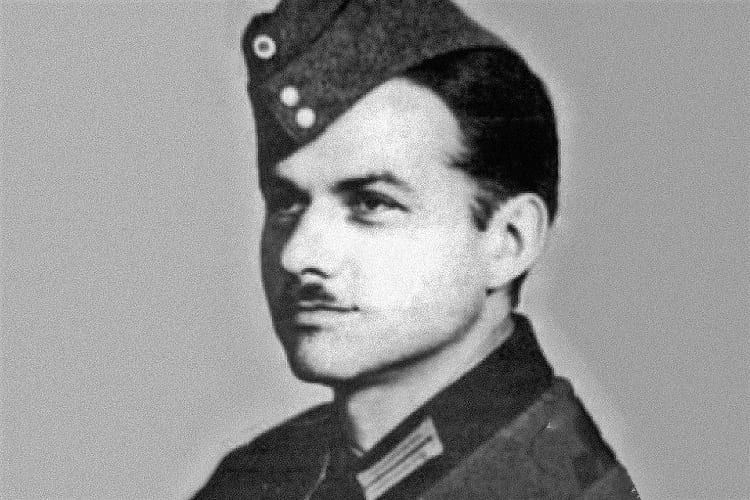
Hanns Scharff. (German Federal Archive)
When thinking of master interrogators, cruel individuals come to mind. Individuals who are able to inflict a great deal of physical or emotional pain on another without feeling empathy. A completely inhuman occupation but in the realms of society, it has always been an essential commodity, especially during times of war.
The same thought applies when thinking about the NAZIs, an idea of evil individuals. While this is untrue for the majority who were simply following a regime, others – many of those at the head of the party – took pride in their policies and practices. So when the two are combined – a NAZI interrogator – the phrase has a very dark connotation.
This particular interrogator worked his way up the ranks and by World War II oversaw prisoner camps known as Dulag Lufts. When enemies of the state were captured they were brought to the attention of the specialist known as Hanns Scharff. Fluent in English he quoted himself as “…the spider sitting on its web…”
From salesperson to interrogator
Scharff was born in 1907, in the East Prussian Empire. He grew up in the town of Leipzig where he studied art and learned the family’s textile business. On reaching adulthood he was sent to South Africa which made him fluent in English. He excelled in the sales division of a company, handling clients who considered him to be a gentleman to do business with.
Hanns married an English lady called Margaret Stokes who happened to be the daughter of a legendary RAF (Royal Air Force) Captain named Claud Stokes. This information would be a coincidence to some extent later in the story. The newly-wed Hanns and Margaret went on holiday to Germany one summer but it would turn into a longer stay than first hoped.
World War II broke out and still a German citizen, Scharff was sent to the Wehrmacht division for military training, destined for the Russian front. He was persistent to stay in Germany however and used his fluency in English to be promoted, becoming a Lance Corporal. The German ended up in Oberursel near Frankfurt, at an Intelligence and Evaluation Center operated by the notorious Luftwaffe Air Force. Their facility was where captured Allied pilots (excluding Soviets) were interrogated. Scharff became an Interrogation Officer.
The new officer was quick to enforce his own methods as he was far from impressed by current techniques. In the Dulag Luft, the captives would mostly come from downed British airplanes whose pilots would have been terrified about being captured by the Nazi regime. Rumours already circulated about the secret police called the Gestapo who were said to administer horrifying torture techniques.
Despite the guidelines of the Geneva Convention, illegal torture persisted. When some US Army pilots were captured, Scharff got his first opportunity. The work started before the meeting as he obtained every piece of information possible about them. He declined to wear a uniform; casual clothes were all he needed to extrapolate information.
I was like the spider sitting on its web, with all the elements I could use at hand, except the brutality.” -Hanns Scharff
Scharff’s interrogating technique
The prisoners would not find a spider but a gentleman. And this is why Hanns Scharff is so special. He was both a Nazi and an interrogator but chose not to do what was expected of him. The history of interrogation has always involved torture but he was brave enough to condemn it. No doubt at first the prisoners and his colleagues alike would have presumed it to be a trick but Scharff was highly successful in using psychology, and never force.
The fact he spoke perfect English meant he gained their trust. He created the illusion that he knew more than he knew, making the pilots feel that any details they gave were already common knowledge. Some even volunteered it due to being treated so well: They were taken on excursions to forests and the zoo with Scharff as their guide. They received medical care and a generous supply of food. Their good experience and treatment is reflected in the camp’s guestbook where the prisoners described the hospitality of the place.
The only devious aspect – a great weapon for the interrogator – was letting the prisoners know that he would give them to the infamous Gestapo if they did not cooperate or try to escape. But in honesty, he never did. Because for the one prisoner who said nothing – famous pilot ‘Gabby’ Gabreski – Hanns did not punish him. Even though Gabby never helped him they stayed friends and met again after the war was over.
Hanns knew that while these captives were his enemy by name, they were humans who did not start the war. He would be remembered and revered for never inflicting pain on another soul despite being expected to.
Influence on FBI and becoming a US citizen
Long after World War II finished, Scharff eventually settled in various countries – but never his – enemy, the US. The Pentagon was aware and persuaded him to work for them. Newspapers and magazines began to publish his methods. He reported for the US air force and would be an influence for many including former FBI agent Ali Soufan who was involved in investigating 9/11 and at Guantanamo Bay.
In retirement, Hanns would become a US citizen and followed his first love – art; designing mosaics at famous monuments such as Cinderella’s Castle at Disneyland. Hanns is an amazing example of standing up for what is right which is extremely heroic considering what took place in Nazi Germany.
He believed that people are people no matter where they are from and he treated the allies with the same respect he did the axis. Even when wars are taking place there are still shining lights like Hanns Scharff who are not just intelligent but brave enough to put it into practice.
Enjoyed this article? Also, check out “Sir Adrian Carton de Wiart: The One-Eyed Invincible Soldier“.
Recommended Read:
The Interrogator: The Story of Hanns Joachim Scharff, Master Interrogator of the Luftwaffe | By Raymond F. Toliver
Fact Analysis:
STSTW Media strives to deliver accurate information through careful research. However, things can go wrong. If you find the above article inaccurate or biased, please let us know at [email protected].
RELATED
The post Hanns Scharff: The Extraordinary Interrogation Technique of a Nazi Interrogator appeared first on .
]]>The post Sir Adrian Carton de Wiart: The One-Eyed Invincible Soldier appeared first on .
]]>
An impressive painting of Sir Adrian Carton de Wiart by Sir William Orpen, 1919. (National Portrait Gallery / Wikimedia Commons)
If you were born into a Belgian aristocratic family how would you spend your life? Would you spend it fighting in three different wars over the span of 50 years, or live a life of luxury? For most of us, the answer to that question would be a life of luxury, unless you are Adrian Carton de Wiart. Sir Adrian Paul Ghislain Carton de Wiart VC, KBE, CB, CMG, DSO was one of the most decorated British Army officers, telling of whose war exploits would require the greats like Tarantino, Scorsese, and Nolan to come together to do any justice to his biopic.
The man had sustained serious injuries a total of 11 times over his military career, losing an arm and an eye in the process. And that doesn’t even start to scratch the surface of his adventurous life.
Joining the army
Born in 1880 in Brussels, to a Belgian father and an Irish mother, Sir Adrian spent most of his youth at a Catholic boarding school in England. He then enrolled at Balliol College, Oxford. For most people war is a way of resolving disputes or just a display of power, but for some it is recreation. Sir Adrian was one of those people. At the age of 19, Sir Adrian joined the army by lying about his age and his name. He claimed to be a 25-year-old drifter named ‘Trooper Carton‘.
Starting his professional life as a soldier in the Second Boer War, he injured his stomach and groin very early on, while fighting in South Africa. Because of his injuries, he was invalided home where he was met by his infuriated father, who was still unaware of his son leaving college to join the army. Sticking to doing what he loved, Sir Adrian went back to South Africa once his wounds had healed.
He was very concerned about his physical fitness, and therefore he regularly ran, jogged and played sports. Among his peers, he was known to be charming, delightful but a foul-mouthed man.
A very well-connected man in Europe, Sir Adrian spent his time away from work travelling extensively. He made friends with quite a few people in high places. Till the beginning of the First World War, like most army officers of imperial England, he was stationed at a number of places including India.
Role during World War
During WWI, he was assigned to the Camel Corps in British Somaliland to establish his control over the followers of Mohammed bin Abdullah. He lost his left eye after being shot in the face when they attacked an enemy fort. But losing an eye did not dampen his spirits because he probably liked how he looked with an eyepatch. He was then given the chance to lead his own infantry battalion into battle in the bloody trenches of the Western Front. Here he lost his left arm after taking some shrapnel. When doctors refused to amputate some infected fingers, he did the deed himself.
Then he was shot in the skull for the second time in the Battle of Somme along with his ankle. But his gallantry there was awarded in the form of the Victoria’s Cross – the highest military honour in England. He was wounded 8 times during the First World War, and six times he injured himself serious enough to be granted mentions in dispatches. While for most of us this feels like a horror of the third kind, he later wrote in his autobiography Happy Odyssey: “Frankly, I enjoyed the war; it had given me many bad moments, lots of good ones, plenty of excitement and with everything found for us”.

Photo of Sir Adrian, when he was lieutenant colonel during the Great War. (Henry Walter Barnett / IWM)
After the First World War, he was sent to Poland as a representative of the British Government. Poland gave him an estate near the borders where he spent most of his time hunting. After the Nazi invasion of Poland, he had to return to England. Even at the age of 60, he led an operation to halt the advancing Nazi invasion of the Norwegian city of Trondheim.
Possibly the most interesting part of his story is when his plane crashed off the coast of Italian-colonized Libya. He swam to the coast where he was captured by the Italian army and sent to a prisoner camp in Italy. He tried to escape the camp five times, once evading and being captured for eight days disguising as a local despite his eyepatch and lack of any knowledge of the Italian language. He was released in 1943 and sent to England with the message of Italian surrender.
Winston Churchill, the prime minister of Britain, had fought beside him and also wrote the foreword to his Autobiography. Churchill sent him to China as a special representative where he befriended Chiang Kai-Shek and helped him fight the Japanese. It is also said that at a dinner party in China he had been very rude to Mao Tse-Tung. He retired from the Army in 1947, after fighting in 3 wars and injuring himself 11 times. He lived on till he was 83 years old, passing away in 1963.

Sir Adrian (at the back row) and other participants of Cairo conference in 1943. (U.S. Government)

1943: Sir Adrian Carton smoking a tobacco pipe in Cairo, Egypt. (Oulds D C (Lt), Royal Navy Official Photographer / Imperial War Museums)
We have talked a lot about his adventurous life as a soldier, but his personal life was not ordinary either. He was married to an Austrian Countess, Countess Friederike Maria Karoline Henriette Rosa Sabina Franziska Fugger von Babenhausen for 41 years, and she didn’t even get a mention in his autobiography. We cannot blame him considering how interesting his life had been, one could easily forget about his Countess wife of 41 years.
Having an unkillable soldier like Sir Adrian on your team would really help an army win a war. We cannot give him the whole credit of winning the World Wars, but a man like him deserves more than just a few medals.
Enjoyed this article? Also, check out “Simo Hayha: World’s Deadliest Sniper with 505 Confirmed Kills“.
Recommended Book:
Happy Odyssey | By Adrian Carton de Wiart
Fact Analysis:
STSTW Media strives to deliver accurate information through careful research. However, things can go wrong. If you find the above article inaccurate or biased, please let us know at [email protected].
RELATED
The post Sir Adrian Carton de Wiart: The One-Eyed Invincible Soldier appeared first on .
]]>The post Kowloon Walled City: A Rare Insight of the Once Most Cramped Place on Earth appeared first on .
]]>
A bird’s-eye view of the Kowloon Walled City, 1989. (Ian Lambot / Wikimedia Commons)
Between two stools a man sits on the ground. Similar woe betides a piece of land falling between 2 states, both indifferent it. The land is Kowloon walled city. A 7 acre stretch of in Hong Kong’s coastal area, used and abused for over a thousand years, yet surviving with astonishing malignancy that has no parallel in the history of human civilization.
Imagine a population of 30,000 housed in 300 high rise buildings in 7-acre land space and you would know the construction couldn’t have been legal and civic. In fact, there was little in the name of law and order at this abominable habitat which began with Song Dynasty ( 960-1280) as an outpost for salt trade. Come 1810 and the place was mutated to a coastal fort.
History of Kowloon
In 1842 Dauguang, the emperor of Quing state ceded Hong Kong island, all sans this coastal fort to Britain. Wary of Britain’s colonial march into her sovereignty, the state of Quing used Kowloon, the coastal fort as a nerve centre to protect her independence. In 1898 some additional parts of Hong Kong were handed over to Britain on a 99-year lease. But Kowloon remained out of this deal. Between Britain on one hand and China on other, Kowloon ostensibly belonged to neither of the two.
China though had a token presence in area conditional to noninterference with the overarching rule of British Hong Kong. With the end of Qing dynasty in 1912, the Kowloon walled city fell into the British basket. But British were chary of accepting walled city as their baby and did little for it, that too by way of Church, not state.
During World War II, 1945, Japan invaded Hong Kong and demolished city’s wall to create space for Kai Tak airport for their wartime exigencies. With the surrender of Japan following Hiroshima and Nagasaki bombing China laid claim to this 7-acre human habitation. This period was marked by the civil war in China which led to thousands of Chinese fleeing to Kowloon for British protection.

Aerial photo of Kowloon Walled City. (Jidanni / Wikimedia Commons)
Leaving Kowloon to its fate
By 1947 the refugee influx swelled to 2000. British made half-hearted attempts to drive them out but relented midway and left Kowloon to its own fate and destiny. Long spells of no-rule and misrule made Kowloon a conundrum for Needy, deprived and homeless charting out their own way. Prostitutes, priests, social workers, drug addicts living in close proximity and yet indifferent to each other.
Children’s playground during the day doubled up for strip shows for the sexually hungry crowd at night time. Yet all was not evil. Sanguinely civil was a significant part of dwellers and they walked their way, choosing not to look at the orgy on their sides and behind their back. A lawless land of crime and drug, it got a semblance of civil society, in 1959 a murder was officially deemed as the jurisdiction of the Hong government.
Earlier the Hong Kong police kept a distance from or had only surface indulgence with the walled city which ran on the proxy rule of organised crime syndicates called triads. Mafia ruled the roost till 1973 when dedicated police raids in the area led to arrest of 2,500 goons and a cache of 1800 kg of drugs. Cooperation of law-abiding gentry in the area helped cops rein crime and establish rule of law in the walled city.

Food preparation in unhygienic condition and tight spaces was a common sight inside the city. (Forgemind Archimedia / Flickr)
But by then much had already gone horribly wrong. In the 1960s, 3000 high rise buildings with ham architecture had 30,000 inmates packed in them like sardines. By 1980 the city was bursting at seams and forced the state to put a cap on construction beyond 13 storeys, primarily to clear so airway to Kai Yak Airport.
Apart from serious noise pollution, residents lived in an eerie ambience deprived of sunlight and civic amenities. Unlicensed doctors and dentists operated with impunity, as also many factories and businesses.

A typical passageway in the city during the night. (Ian Lambot / Wikipedia Commons)
The fall of Kowloon Walled City
A persistent pain in the neck of Chinese administration for long, dedicated attempt was made in 1963 to prune the area of lackadaisical structures and up the status of roads and houses and sanitation. Two decades on state mooted radical surgery. On 14th Jan 1987, both Britain and China decided to demolish the area completely and replace it with a suave public park.

The Kowloon Walled City Park. (CPJoseph / Wikimedia Commons)
A massive compensation of US$350 million was cut out to evacuate people from the area to new locations. Actual demolition of it began in 1993 and concluded in 1994.
So, was Kowloon a bad dream destined to be trashed unsung?
Not really. It was sweet home to thousands who lived in the shadow of the underworld and yet made a life out of it. For outsiders, it remained a quintessential curiosity for a freedom unbridled by state watch and fear that lurked in serpentine lanes and bylanes that permeated the city like a jigsaw puzzle.
No wonder the slums and shanties turned high rise towers, the Kowloon walled city found a place in several Hollywood flicks. Martial arts tournament of ‘Blood Sport’ starring Van Damme was shot in precincts of the walled city. Camera shots of this locale in Jackie Chan starrer ‘Crime Story‘ include real scenes of demolition drive. Many other works of art and literature have given quality treatment to Kowloon walled city which now has a more humane face in the shape of Kowloon City Park.
Enjoyed this article? Also, check out “Kangbashi, Ordos – Ghost City? Economic Ingenuity? Or Both?“.
Recommended Visit:
Kowloon Walled City Park | Kowloon City, Hong Kong
Fact Analysis:
STSTW Media strives to deliver accurate information through careful research. However, things can go wrong. If you find the above article inaccurate or biased, please let us know at [email protected].
RELATED
The post Kowloon Walled City: A Rare Insight of the Once Most Cramped Place on Earth appeared first on .
]]>The post Simo Hayha: World’s Deadliest Sniper with 505 Confirmed Kills appeared first on .
]]>
Simo Hayha posing with his honorary rifle. (Finnish Military Archives / Wikimedia Commons)
Simo Hayha, famously dubbed as “The White Death,” is regarded as one of the greatest marksmen in military history. The Finnish man from Karelia earned more than 500 kills while bravely defending Finland against the mighty Soviet invasion during World War II. His role in the war earned him many medals, and much respect, making him an immortalized national hero.
Simo was born on 17th December 1905, to a Lutheran family who lived in the Karelia region, which is now located in modern-day Russia. Simo was the second youngest among his eight siblings. At the age of 20, he enrolled in the Finnish voluntary militia, where he served for about a year. It was here that he acquired the training that would go on to make him one of the most revered snipers in history. Before the onset of the Winter War, Simo spent most of his day farming and hunting.
The Winter War
In 1938, Europe was in complete disarray. Hitler’s rise to power was greatly threatening the peace and stability of the region. And like most countries, the Soviet Union were extremely wary of this development. Worried about an invasion from the north, in April the same year, the Soviet Union sent representatives to speak with the Finnish government. Here, they expressed great concern over Nazi Germany and a probable invasion of Russia through parts of Finland. The Finnish government, at the time, were officially neutral. While they were not ready to launch an offensive, they assured the representatives that any Nazi incursion on its borders would be met with swift resistance. This didn’t go down well with the Soviets though.
About thirteen years prior, Hitler’s infamous manifesto, Mein Kampf, was published. In it, he clearly mentions the need for Germany to invade Russia. This and the political climate at the time convinced the Soviet Union that an attack was imminent. Rather than wait around for things to reach such a critical stage, the Soviets were determined to make the first move, and blatantly refused any promises from smaller countries. As negotiations began to break down, on November 30, 1939, the Soviet Red Army invaded Finland, marking the beginning of the 105-day long Winter War.
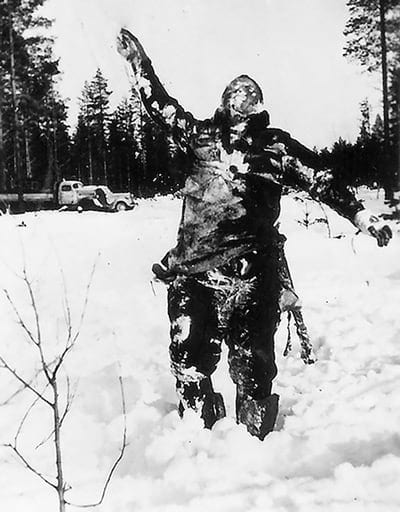
Dead Russian Soldier erected by Finish army as an intimidation to the Russian during the Winter War. (Фотокор / Wikimedia Commons)
Strategies used by Simo Hayha during the war
On hearing this development, Simo Hayha sprang into action. He packed himself some food, put on some plain white camouflage, picked up his rifle, and darted towards the front, which was not too far off from his home. He would make his way through the bush until he found himself a perfect vantage point. Once here, he would take the position and wait for a target. This wait could last anywhere from a few hours to a few days. One must remember that temperatures on the battlefield never rose above zero degrees. Despite the extreme cold, Simo would hideout in the wilderness, completely committed to the cause.
Soon, Simo realized that the Russians were using already established routes to move troops and supplies to the front. This made it easier for the sniper to find suitable spots to lay low. Simo would employ a variety of techniques to ensure that he was never detected. Apart from hiding himself meticulously, Simo, as mentioned previously, would wear a white camouflage that helped him blend into his surroundings. Additionally, he never used a scope on his rifle, fearing that the sun might reflect on the glass and give away his position. All his targets were eliminated from a great distance with unassisted vision. Further, Simo always kept some snow in his mouth to prevent his breath from steaming. Such methods ensured that the Soviets could never figure out his exact location.
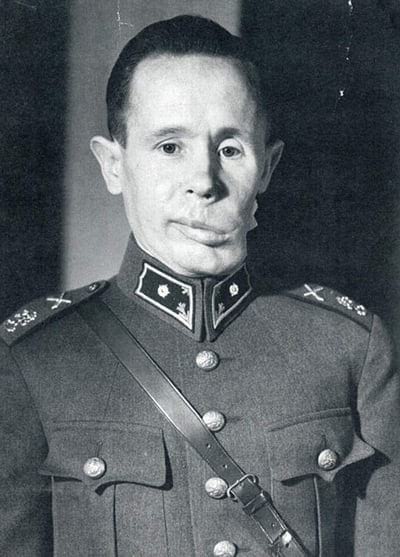
Simo Hayha after facial reconstruction due to an exploding bullet that blew off half his jaw. (Finnish Military Archives / Wikipedia Commons)
As the war progressed, Simo continued to make a dent in the Soviet advance. On average, he was gaining 5.5 kills a day. His highest tally in a day was a remarkable 40 confirmed kills. However, just about a week before the end of the war, on March 1940, Simo was injured severely by an exploding bullet that shattered his jaw. After being admitted to the hospital, Simo was required to undergo facial reconstructive surgery and remained in a coma until the day the war ended on March 13, 1940.
After the end of the war, Simo humbly returned to his prior routine of hunting and farming. In 1970, the war hero moved to Rasila, Ruokolahti, where he lived in a one-bedroom apartment until 2001.

Grave of Simo Hayha now lies in Ruokolahti Church Graveyard, Finland. (Klokster / Wikimedia Commons)
In 2002, Simo breathed his last at a war veteran’s hospital in Hamina at the ripe old age of 96.
Enjoyed this article? Also, check out “Hanns Scharff: The Extraordinary Interrogation Technique of a Nazi Interrogator“.
Recommended Read:
A Frozen Hell: The Russo-Finnish Winter War of 1939-1940 | By William Trotter
Soviet Union vs Finland – The Winter War 1939 | YouTube
Fact Analysis:
STSTW Media strives to deliver accurate information through careful research. However, things can go wrong. If you find the above article inaccurate or biased, please let us know at [email protected].
RELATED
The post Simo Hayha: World’s Deadliest Sniper with 505 Confirmed Kills appeared first on .
]]>The post The ‘Immortal’ cells of Henrietta Lacks that Revolutionised Medical Research appeared first on .
]]>We have an incredible story about one such woman who has been dead for over 68 years but she continues to contribute towards saving the lives of millions. Her name was Henrietta Lacks, a mother of five. She succumbed to cancer at a young age of 31 on 4th of October 1951.
Who was Henrietta Lacks?
She was a homemaker of African-American descent who gave us something very remarkable that has made her immortal in the literal sense of the word. It was at the John Hopkins Hospital in Baltimore where she was detected with the cervical carcinoma, leaving behind first human immortalized cell line, famously known as HeLa cell line.

Photograph of newly divided HeLa cells through the microscope. (National Institutes of Health / Wikimedia Commons)
Henrietta had felt a knot in her womb before finding out she was pregnant with her fifth child and had forgotten about it until after she gave birth. This knot later turned out to be cancerous. A biopsy of the mass of Lack’s cervix was taken by Howard W Jones, her doctor at Johns Hopkins Hospital for laboratory testing. She was misdiagnosed with an epidermoid type of cervical carcinoma instead of being accurately diagnosed with adenocarcinoma, though thankfully the treatment for both was the same at that time. She was being treated using radium tube inserts, a standard treatment for cancer in the 50’s.
Discovering the ‘Immortal’ cells
The doctors at Johns Hopkins Hospital collected two samples of Lacks’ cervix without notifying her or taking her consent. These samples were given to several scientists for the purpose of research including cell biologist George Otto Gey. The researcher while studying Lacks’s carcinogenic cells discovered a unique quality about them. They could reproduce at an unusually rapid rate making it easier to keep them alive long enough to conduct an in-depth examination.
George Otto Gey had unsuccessfully tried to create an immortal cell line with every sample of cancerous cervix cells that had reached his lab. But the amazing HeLa cells were the first to continue living in a lab setting at Johns Hopkins and numerous other labs around the world, making them immortal in a way.
Jonas Salk utilized these same cells when he developed the vaccine for polio. Such application of HeLa cells in medical research has motivated mass production to meet the needs of research facilities around the world. These cells have aided their research in various medical pathologies like AIDS, carcinomas, gene mapping studies, and in studying the effects of toxic substances and radiations among various other scientific pursuits.

Henrietta Lacks passed away at the age of 31 on October 4, 1951. (Oregon State University / Flickr)
Controversies
The first human cells that were cloned also came from Henrietta. But this whole time members of Henrietta’s family were unaware of these developments. In the 1970s, when some HeLa cell cultures became contaminated, doctors and scientist started approaching members of Lacks’ family for blood samples. Henrietta and her family were never consented for using her cells for harvesting. This raised some legal questions when the family learned about how widely these cells were being used, and how most of the genetic information was available for anyone to see.
At the time of Henrietta’s death, it was not required to ask for consent or permission before doctors obtained samples from patients. The legal tussle had ultimately led to an agreement between the National Institutes of Health providing some control over the publication of genetic information that can be gathered from the HeLa cells.
Enjoyed this article? Also, check out “William Beaumont: A Voyageur’s Open Wound That Revolutionised Gastric Physiology“.
Recommended Read:
1. The Immortal Life of Henrietta Lacks | By Rebecca Skloot
2. Medical Apartheid: The Dark History of Medical Experimentation on Black Americans from Colonial Times to the Present | By Harriet A. Washington
Recommended Watch:
The Way of All Flesh | BBC
Fact Analysis:
STSTW Media strives to deliver accurate information through careful research. However, things can go wrong. If you find the above article inaccurate or biased, please let us know at [email protected].
RELATED
The post The ‘Immortal’ cells of Henrietta Lacks that Revolutionised Medical Research appeared first on .
]]>The post The Time When Men Fought Bears appeared first on .
]]>
A man and a bear wrestling. (R. H. Trueman / Library and Archives Canada)
Who in their right mind would like to fight a wrestler standing more than 7 feet and weighing 600lbs? No, I’m not talking about pro wrestlers like Big Show and Mark Henry. Though I’m quite sure nobody in their right mind would ever fight them either. But imagine, what if this wrestler was a grizzly bear? You would definitely run away from it. But to our amazement, there have been men who have fought actual bears in four-cornered rings, not out in the wild and not just for the sake of their survival. And this is not an isolated incident that we are talking about here, but actually, it was in fashion for quite a few decades, probably for more than a century.
The bears which were fought with would undergo gruesome physical modifications, they would be declawed, their teeth would be removed and their mouths would be sealed with a muzzle strap. In some cases, the bears had their leg and arm tendons severed to restrict their mobility. You can probably understand why it’s not a thing anymore. It was a gruesome practice that exploited wild animals for the purpose of entertainment of people.
Men have a history of trying to prove his superiority over other animals, especially the ones that most definitely would kill him out in the wild with absolute ease. This has led to his fighting with alligators, sharks, bears, kangaroos, octopi, and even lions (under conditions favourable to man).

A soldier from the Polish Second Corps play wrestling with a bear named Wojtek while other members of the troops can be seen spectating the event. (Imperial War Museum / Wikimedia Commons)
Let’s come to bears now. Bears are unique in a way. When it comes to boxing or wrestling they stand upright just like we do. When they wish to fight, even among themselves, they do it like “men”. There is a rich history of men fighting bears and its origins can be traced back to 1850s Europe. It eventually showed up in America in 1877. Soon they were everywhere, most circuses featured bears fighting bears or bears fighting men.
Reporters were writing about their performances, sometimes unimpressed by their lack of discipline or their lack of skill as boxers and wrestlers. In 1878 a female fighting bear named Lena killed a fighter by the name of Jean Francis Borne during a “match”. Contrary to what you would think that didn’t really deter people from taking part in this “sport”.
Numerous bears like Terrible Ted, Big Boy, and Gorgeous Gus enjoyed big fame as distinguished fighters. Another famous fighting bear called Battling Bruno was recognised for his achievements by Queen Victoria and was granted the title of knighthood. When he passed away he was stuffed and preserved on her request.
A bear named Victor, probably the most famous and successful fighting bear of all time, appeared on numerous TV shows and most famously he fought Chet Coppock, a sports director with CBS, during the halftime show of an ABA game on April 2, 1975.
Also, boxers like Chuck Wepner, the heavyweight boxer who inspired the character of the famous Rocky tried his hand at bear fighting at the zenith of this “sport” but public’s interest in this “sport” has since waned thanks to the rise of animal rights.
Though there have been reports of a few cases of bears fighting men for fun and entertainment from as late as 1995 when a club in Ohio came under fire for letting drunk college students fight a bear named Ceaser, it is thankfully a dead sport today.
It is different when you have to fight a bear out in the wild to save yourself from being killed. He has all the tools that nature has provided him with for his use and you have all yours. Fortunately, for us, the times are gone when men fought bears.
Fact Analysis:
STSTW Media strives to deliver accurate information through careful research. However, things can go wrong. If you find the above article inaccurate or biased, please let us know at [email protected].
RELATED
The post The Time When Men Fought Bears appeared first on .
]]>The post Rasputin, Faith Healer? Or Lustful Charlatan? appeared first on .
]]>
Rasputin in the center surrounded by his admirers in St. Petersburg, 1914. (Karl Bulla / Wikimedia Commons)
It’s amazing how some parts of history are condensed into tiny, sometimes cryptic and many times wrong examples. Take for instance, Marie Antoinette. Many people will know nothing about her role in the French Revolution, they will only know the quote, “Let them eat cake.” And apparently, there is no record of her ever saying it (it is attributed to a Princess before her time). Even so, whilst untrue it still illustrates why Marie Antoinette is famous, citing the power struggle between peasants and the elite. Other examples include Van Gogh’s ear, Isaac Newton’s Apple, Napoleon’s height and Edison’s lightbulb. While all stories are untrue or exaggerated, they still show that the apple doesn’t fall far from the tree – well, except in Newton’s case where it didn’t fall at all.
Troubled childhood
Born circa 1869, near the town of Tyumen on the cusp of Siberia, Grigori Yefimovich Novykh grew up on a peasant farm. It was treacherous living, so much so that seven of his siblings did not survive through childhood. A theme begins in his early life which dominates throughout his entirety. It is that much of Grigori’s life is clouded with conjecture based on rumours and eye-witness accounts.
Another theme forged is that Grigori had a dark reputation. He was a notorious drinker, womanizer, and a thief but naturally charismatic and handsome, many saw him as a lovable rogue too. Religion and the supernatural were major beliefs back then and Grigori became involved in such mysticism. Villagers believed he could cure horses and speak to God. He married a village girl Prastkovya in 1887, they had four children, the most famous of which would be Maria.

A photo of Rasputin with his three children. (Wikimedia Commons)
Unholy preacher
At 28 he became obsessed with Religion. The belief of the land was Orthodox Christianity but Grigori delved into offshoots too. He embarked on several religious pilgrimages, even venturing as far as Greece on one occasion. His activities made him known among the Orthodox clergy and brought him many followers but also controversies.
Some of his teachings were said to be unholy and illicit. For instance, Grigori was accused of joining the Khlysty, a sect which seceded from Orthodoxy. They were said to indulge in ritualistic orgies and flagellation. It seems obvious that Grigori was involved in such practices as he requested to be renamed ‘Rasputin’ (‘Debauchee’ in Russian). It represented that he believed true salvation must be attained through sin. Despite these suspected indecencies, through various connections, he climbed the holy ladder. Grigori made it to St Petersburg, the then capital of Russia (2.500 KM from Tyumen) where the leader of Russia – Tsar (named for Caesar) Nicolas II – ruled and formed a close connection with the wanderer.
Mystical healer
Preaching Christianity would be a backstory as Rasputin’s rise was mainly due to curing the Tsarevich, the Tsar’s only son and future ruler. The boy Alexei suffered from haemophilia – meaning he was susceptible to abnormal bleeding. Rasputin drove away doctors and consistently improved the boy’s condition meaning his mother, the Tsarina, cried him a miracle healer. The Siberians influence grew, he was given a flat in the center of St. Petersburg and roles within the government.
Rasputin: The unkillable monk
Again, controversy followed Rasputin. Accounts say he was far from coy when taking in prostitutes or even female members of the aristocracy to his flat. He was denounced for devil worshipping, of using the Tsar as a political weapon and of having an affair with the Tsarina. It is said that others including the British accused both him and the German-born Tsarina of being German spies.
This is where Rasputin became infamous as the monk who couldn’t be killed. At this time in Russia, there were many devout Christians as well as political parties vying for power and someone took umbrage. He was first stabbed by a vagrant in the stomach but survived. That assassin’s motives are still unknown.

A photograph of Rasputin from 1916, the year he died. (Wikimedia Commons)
This attempt would be a prelude for when members of the nobility led by a rumoured cross-dresser named Felix Yuposov attempted an assassination. They believed Rasputin had too much power as the Tsar was out of Russia during the break of World War I.
Yuposuv invited him to dinner. He poisoned his cakes and wine, shot him three times including once in the head and finally rolled him in a carpet, throwing him out of the balcony into the sub-zero River Volga. Finally, the Siberian was deceased. His adopted family the Romanovs did not have time to mourn. A political coup meant that they fled east only to be butchered in the basement of a winter palace.

Dead Rasputin with a bullet in his head. (Wikimedia Commons)
His life and motives are impossible to fully comprehend but some light has been shed on his practices. Firstly, the world was a very different place then, where religion and the supernatural were considered truth. And even those who did not believe were forced to follow it for fear of castigation. Rasputin was an extremely charismatic man, mixed with extreme confidence and bravery which of course can get one very far. There are clips online which show famous hypnotists such as Derren Brown showing its power, many believe Rasputin was adept.
As for the healing, historians now have the idea that Grigori’s insistence for doctors to leave Alexei, did actually help. By denying him pain-killing medicines like Aspirin which is said to thin the blood. Then there are more outlandish claims. In the theme of sex sells, Rasputin’s weapon was believed to be below his belt. A thirteen-inch penis which is said to be on display at the Russian Museum of Erotica after being sold among various second parties. The madness didn’t stop even when Grigori died.
Aftermath
His daughter Maria fled Russia after her father’s death and became a lion tamer in the US. If sources are to be believed she named her dogs after the killer Yupusov. But that’s another story, as is that of the Romanov family who also proved extremely tough to kill. To learn more about Rasputin, there are many books available including accounts from his daughter Maria, and killer Felix Yuposov. There is a film starring Alan Rickman, an actor worthy of the role.
Also, the tale of Harbard in The History Channel’s Vikings is a mirror image of the Russian; a wanderer who heals Ivar the Boneless and then seduces his mother, the Princess Aslaug. Stories of holy wanderers are notorious in every religious circles and Rasputin was not the first and certainly won’t be the last.
But perhaps, he was the oddest.
Enjoyed this article? Also, check out “Ivan the Terrible: The First Tsar of Russia and His Reign of Terror“.
Recommended Reads:
1. Nicholas and Alexandra: The Classic Account of the Fall of the Romanov Dynasty | By Robert K. Massie
2. Grigori Rasputin: A life From Beginning to End | By Hourly History
Recommended Watch:
1. Agony (1981)
2. The Real Rasputin (Imperial Russia Documentary) | Timeline
Recommended Visit:
1. Moika Palace | Russia
Fact Analysis:
STSTW Media strives to deliver accurate information through careful research. However, things can go wrong. If you find the above article inaccurate or biased, please let us know at [email protected].
RELATED
The post Rasputin, Faith Healer? Or Lustful Charlatan? appeared first on .
]]>